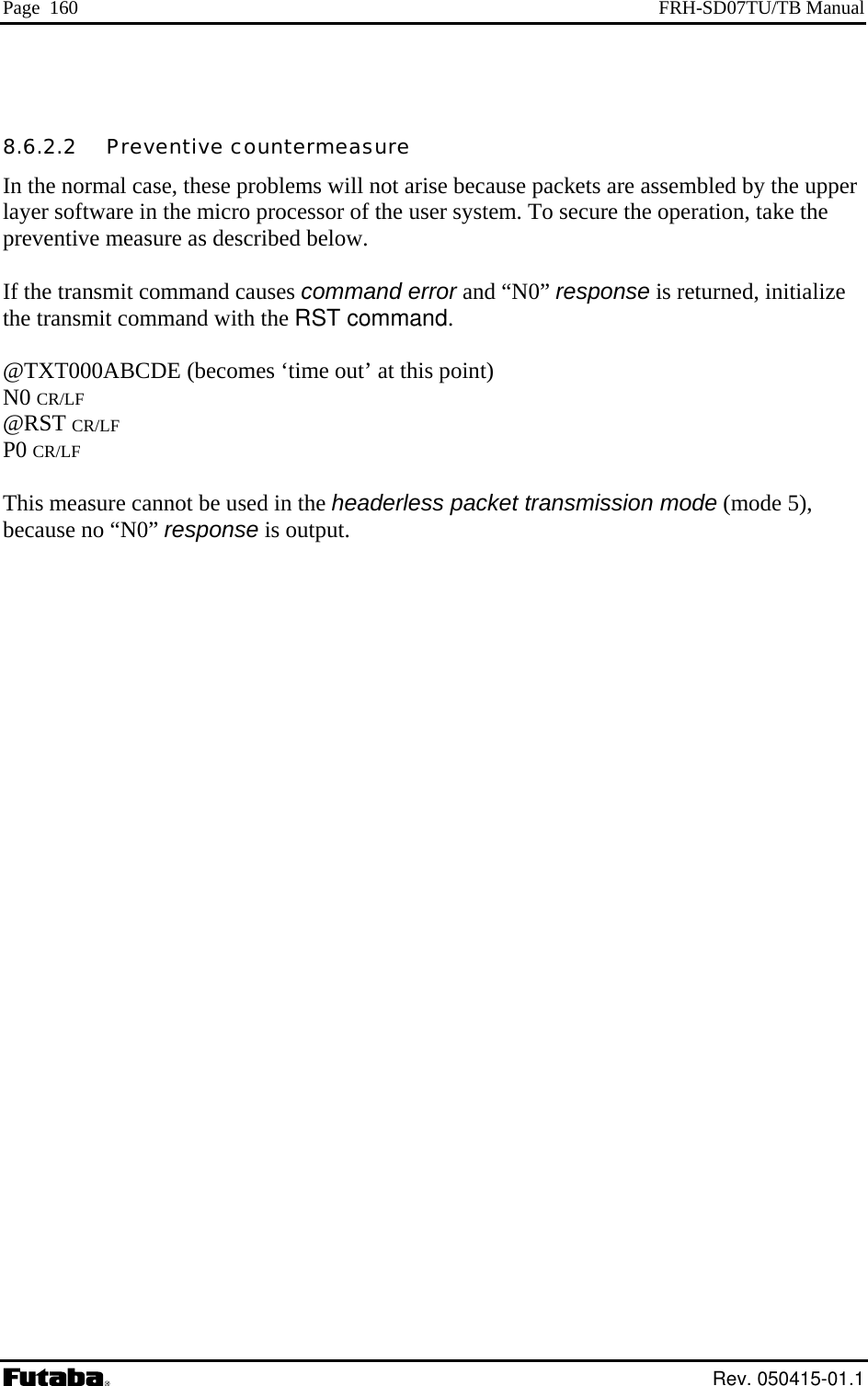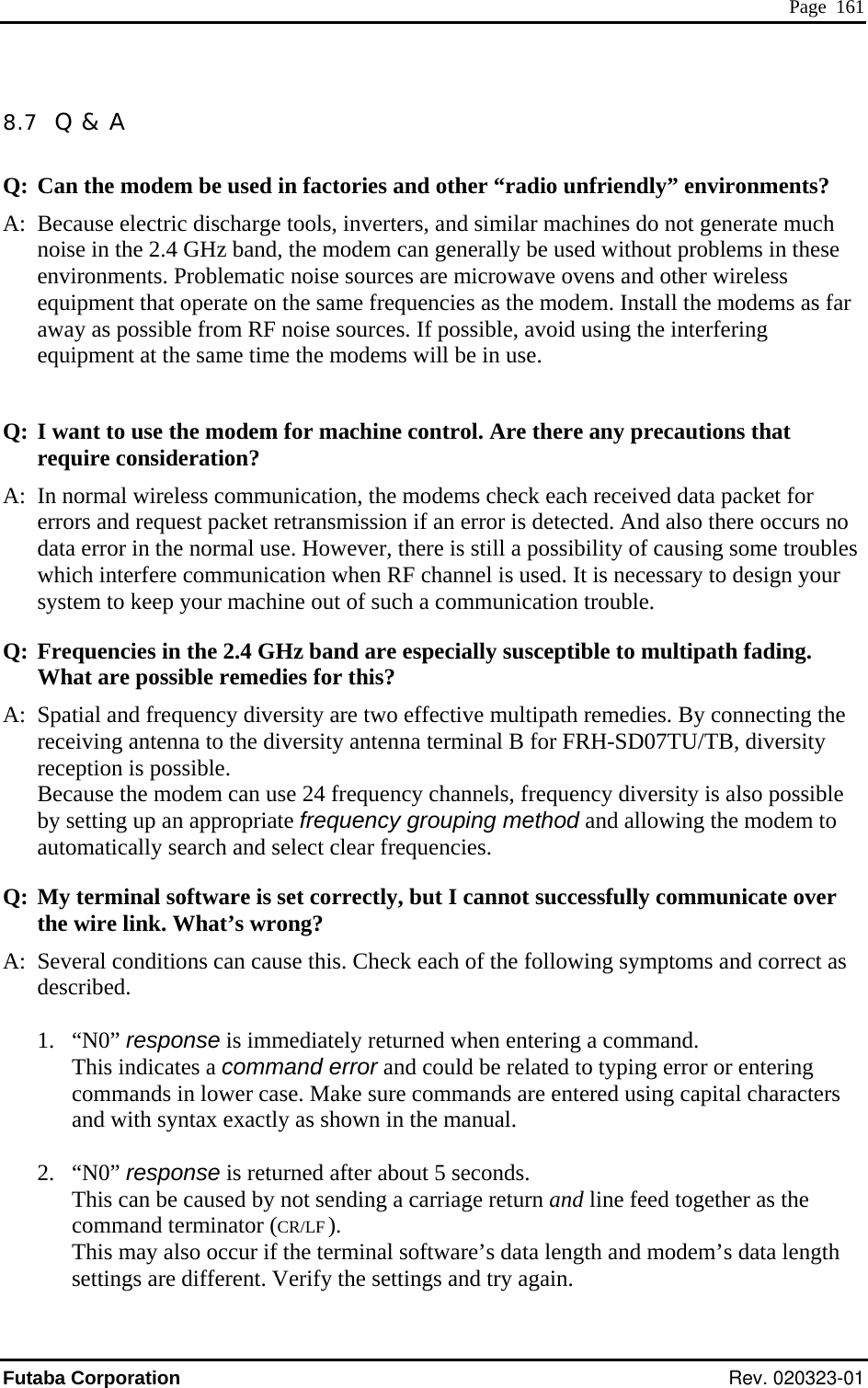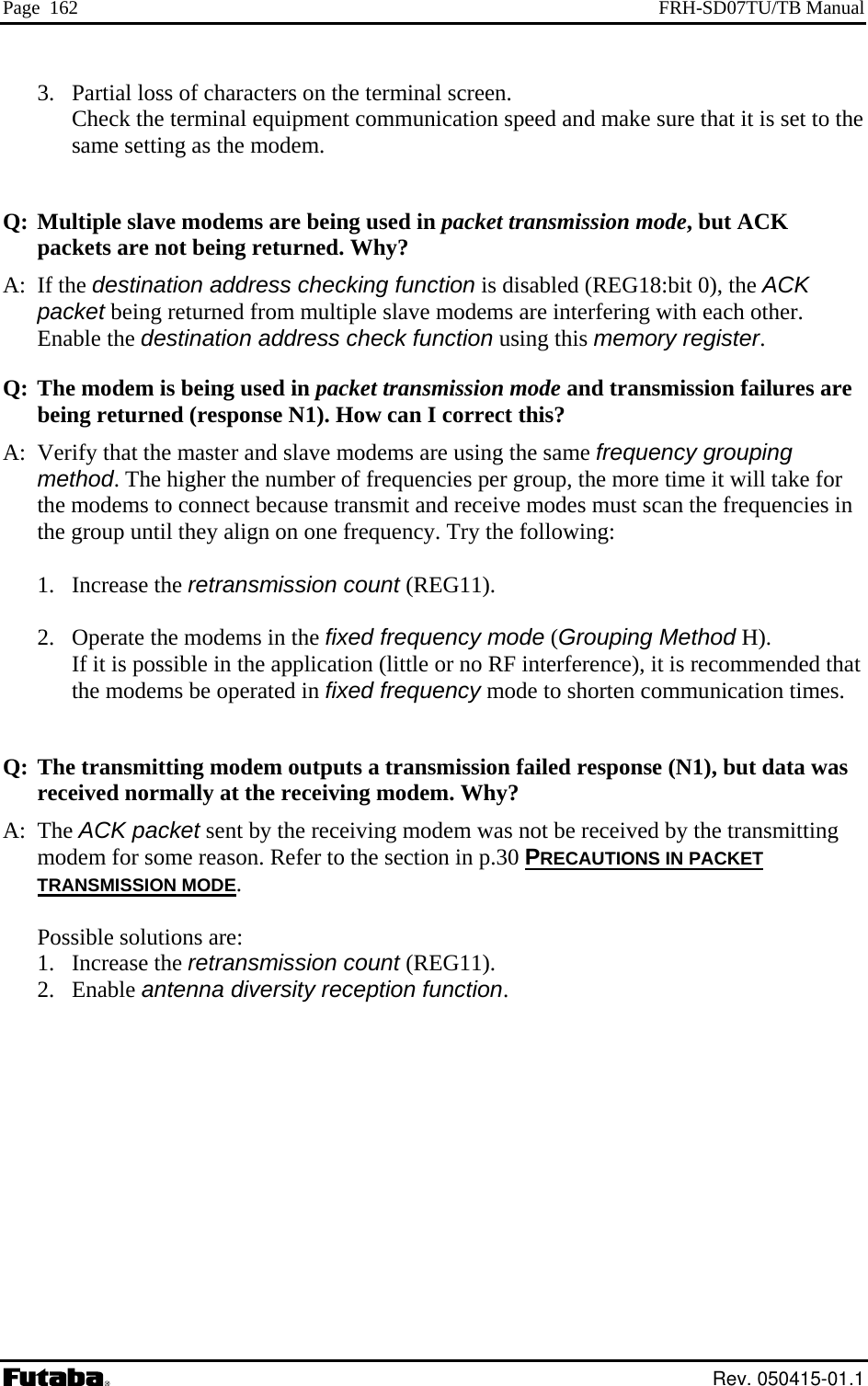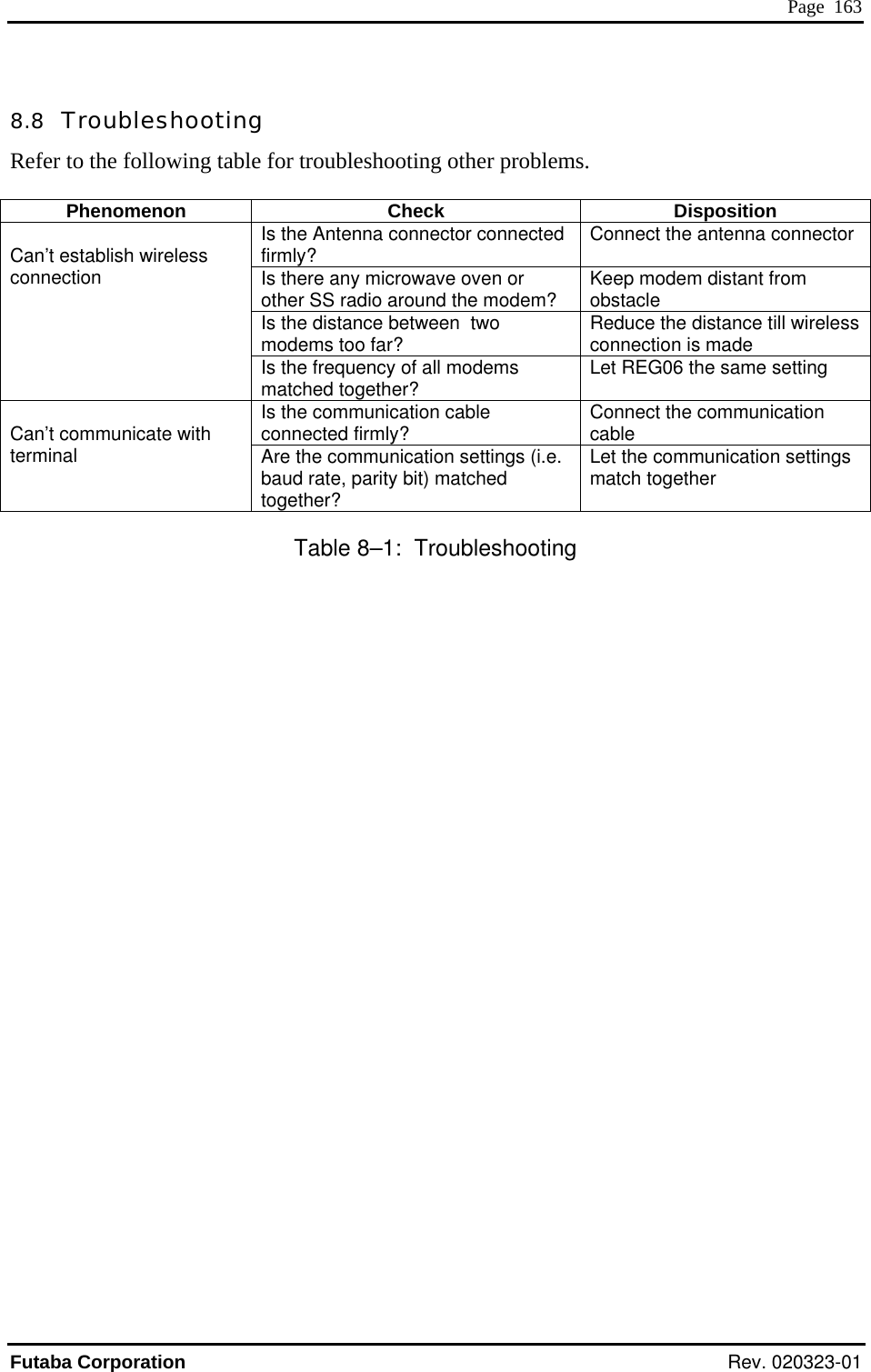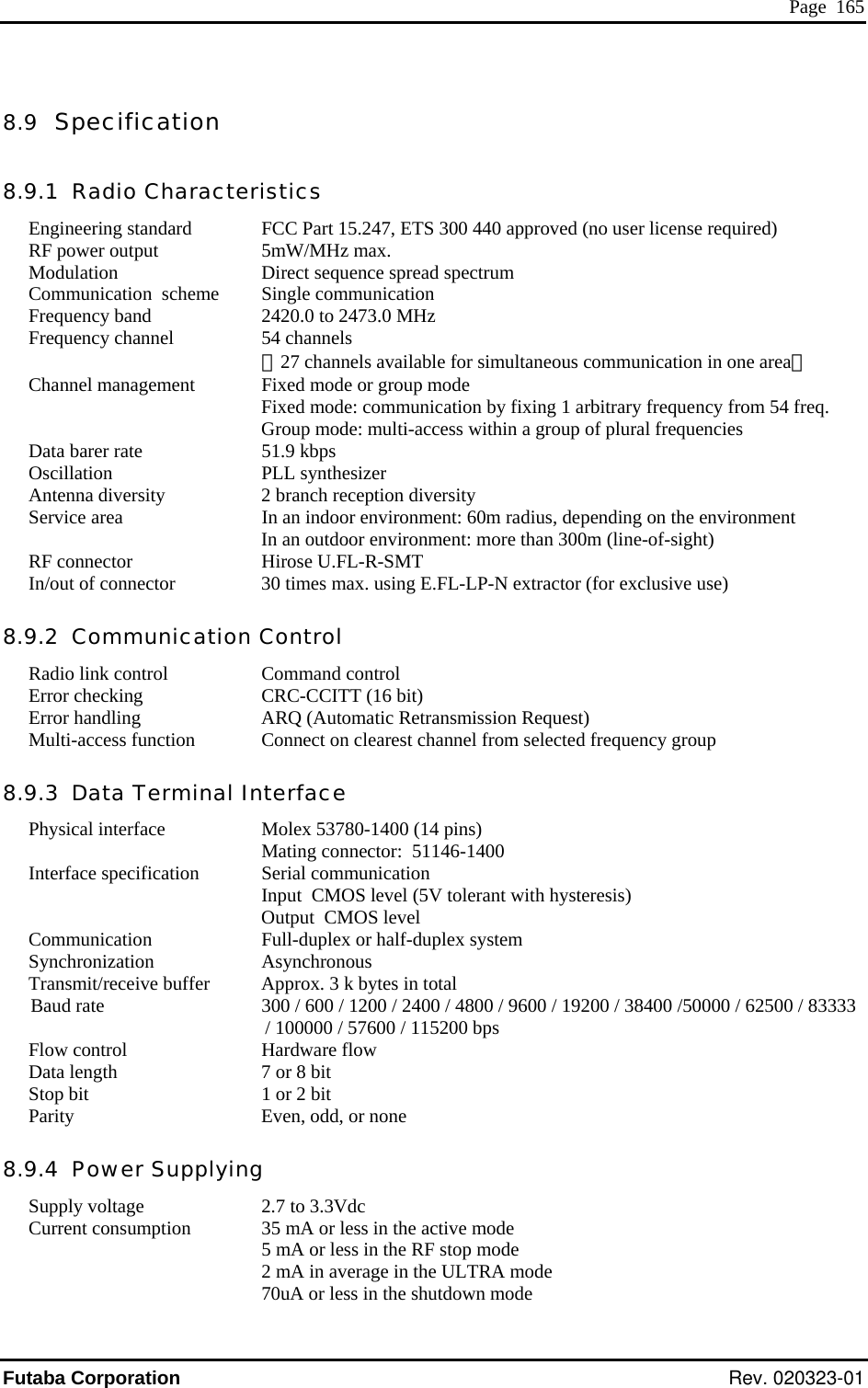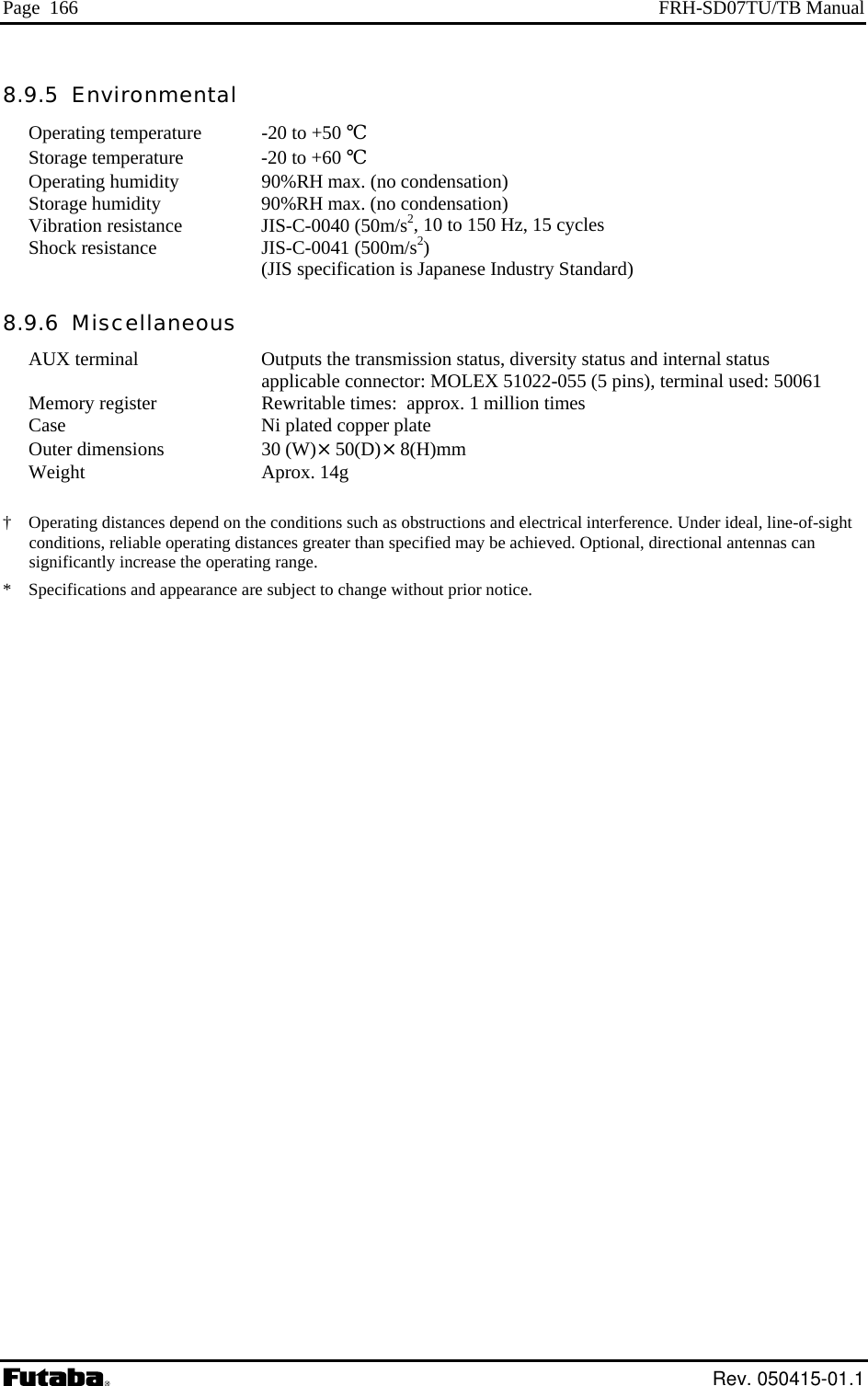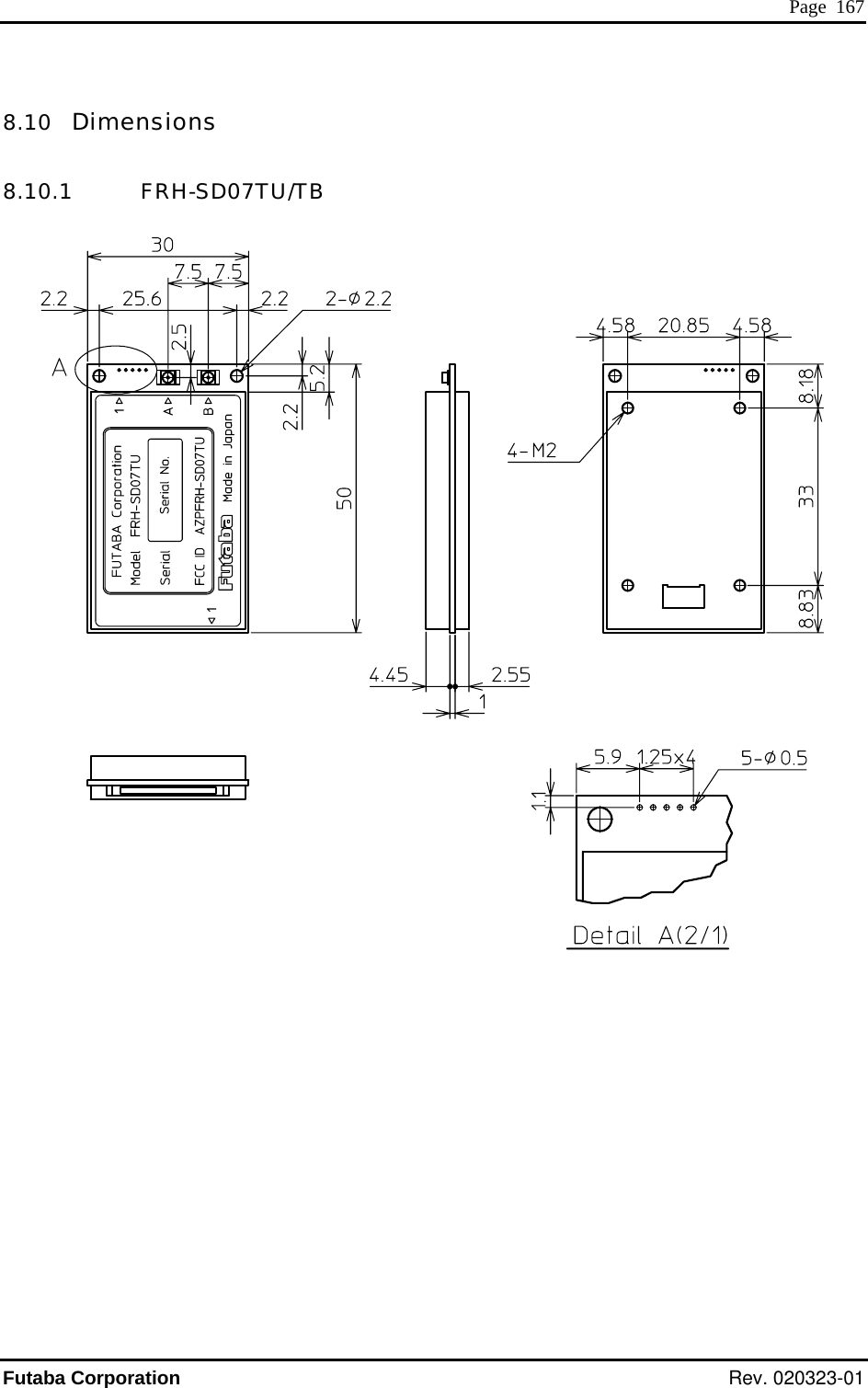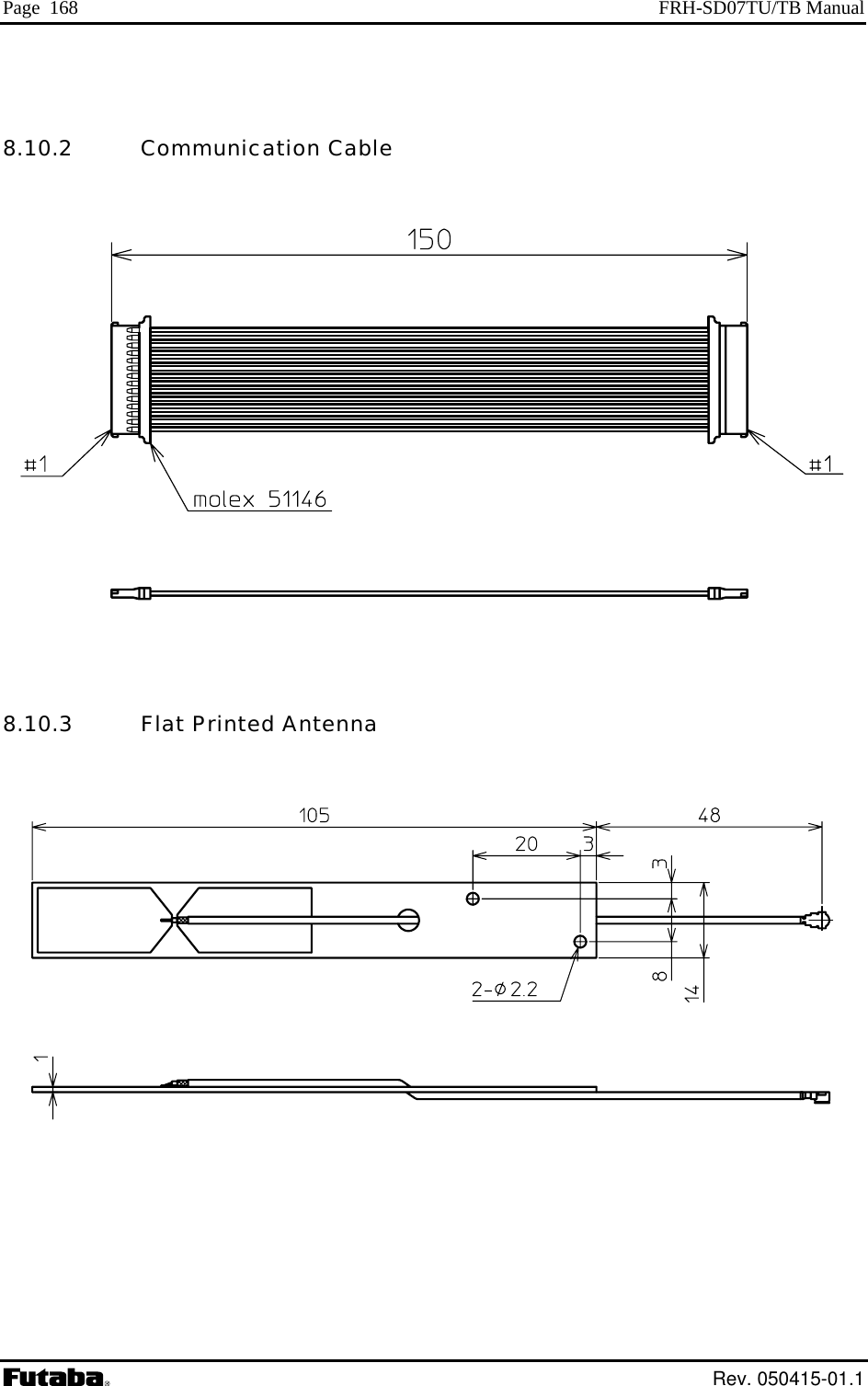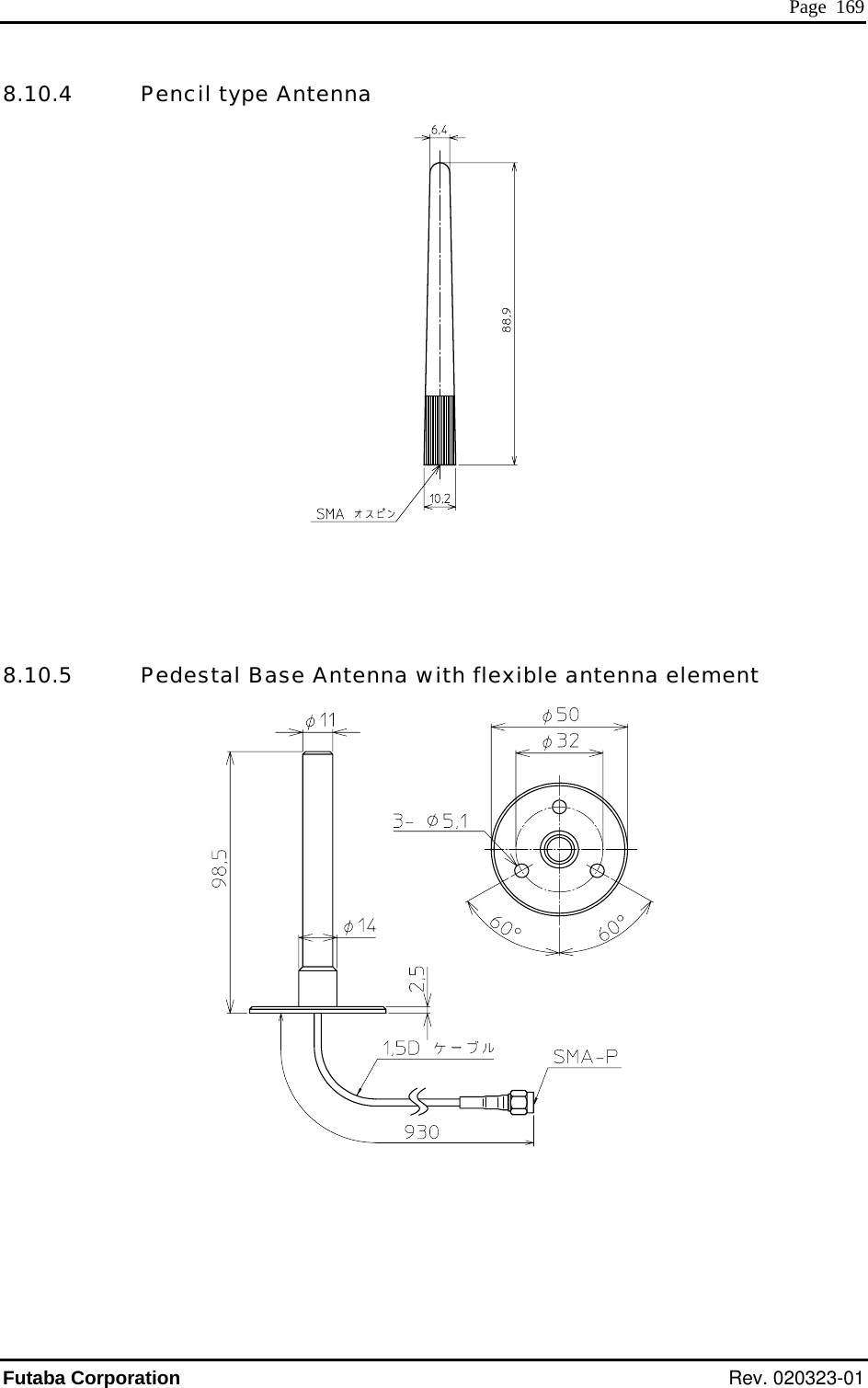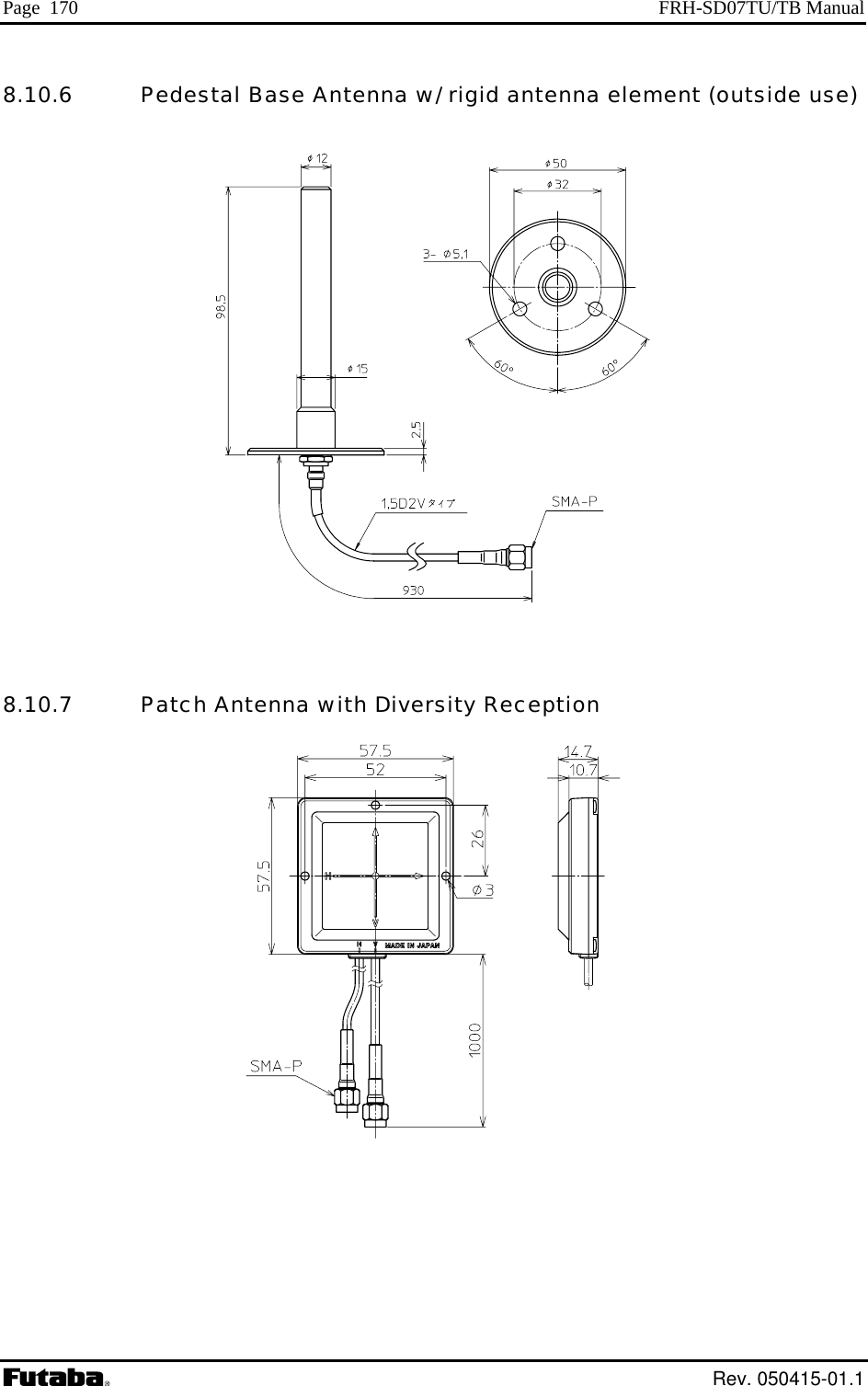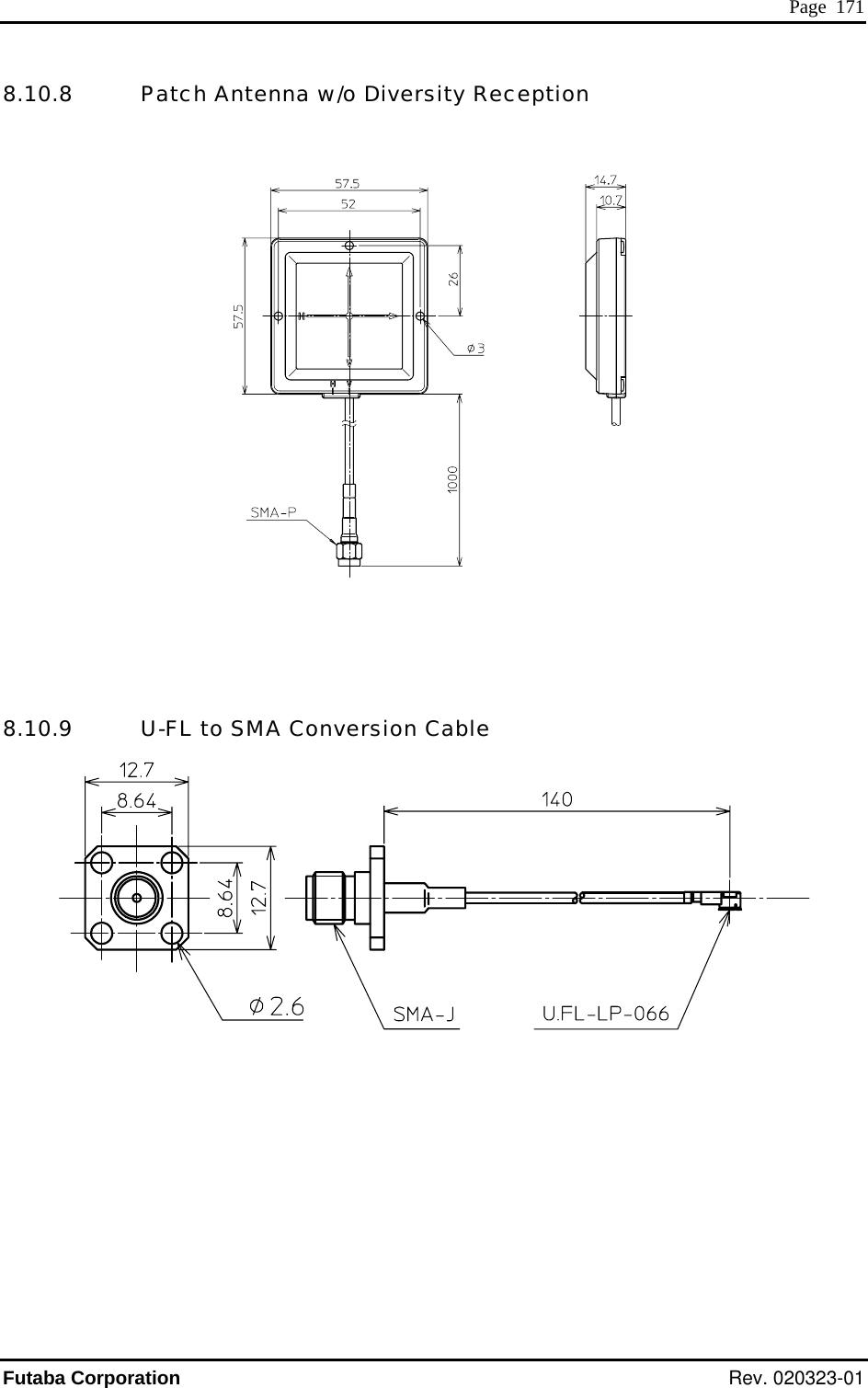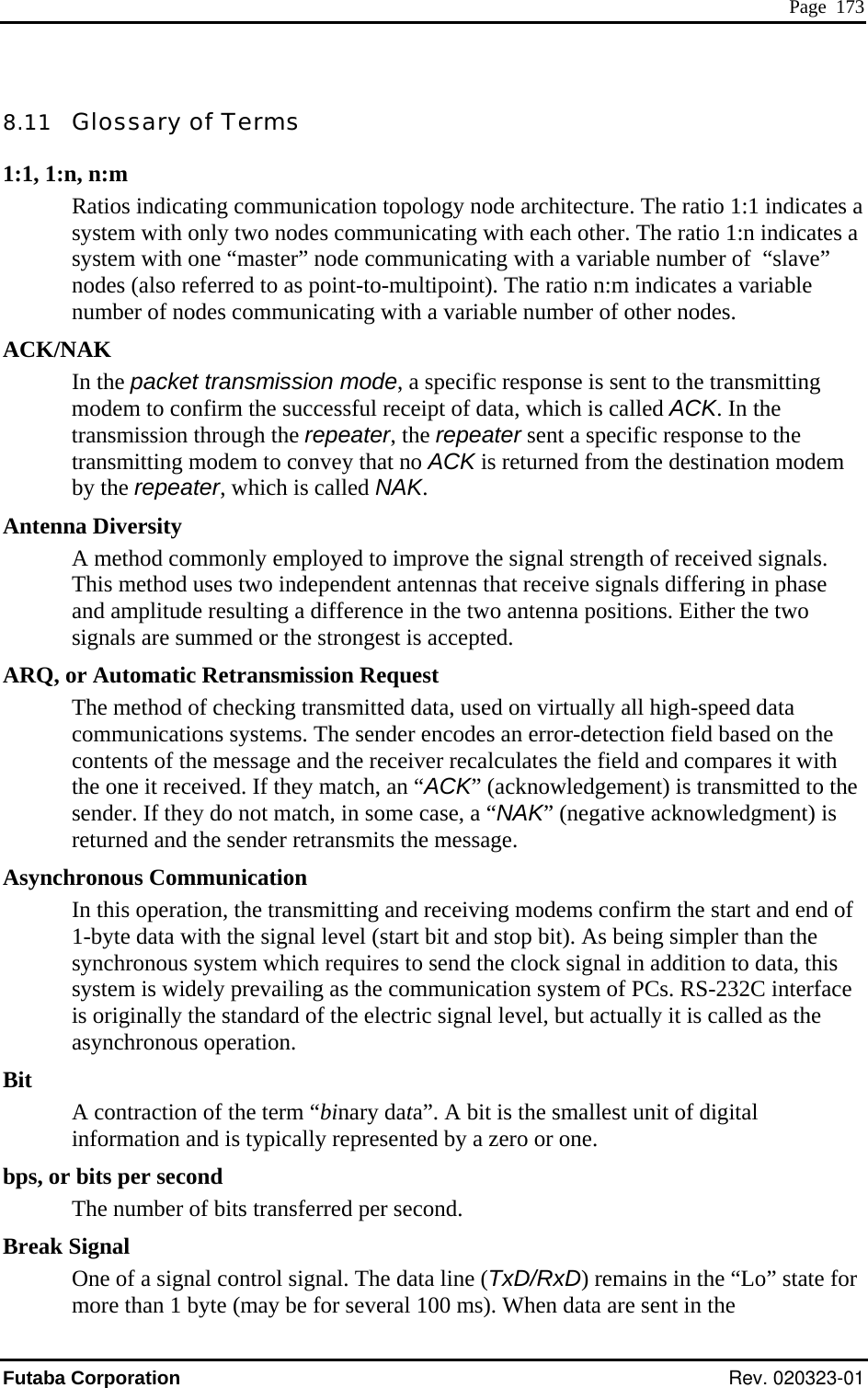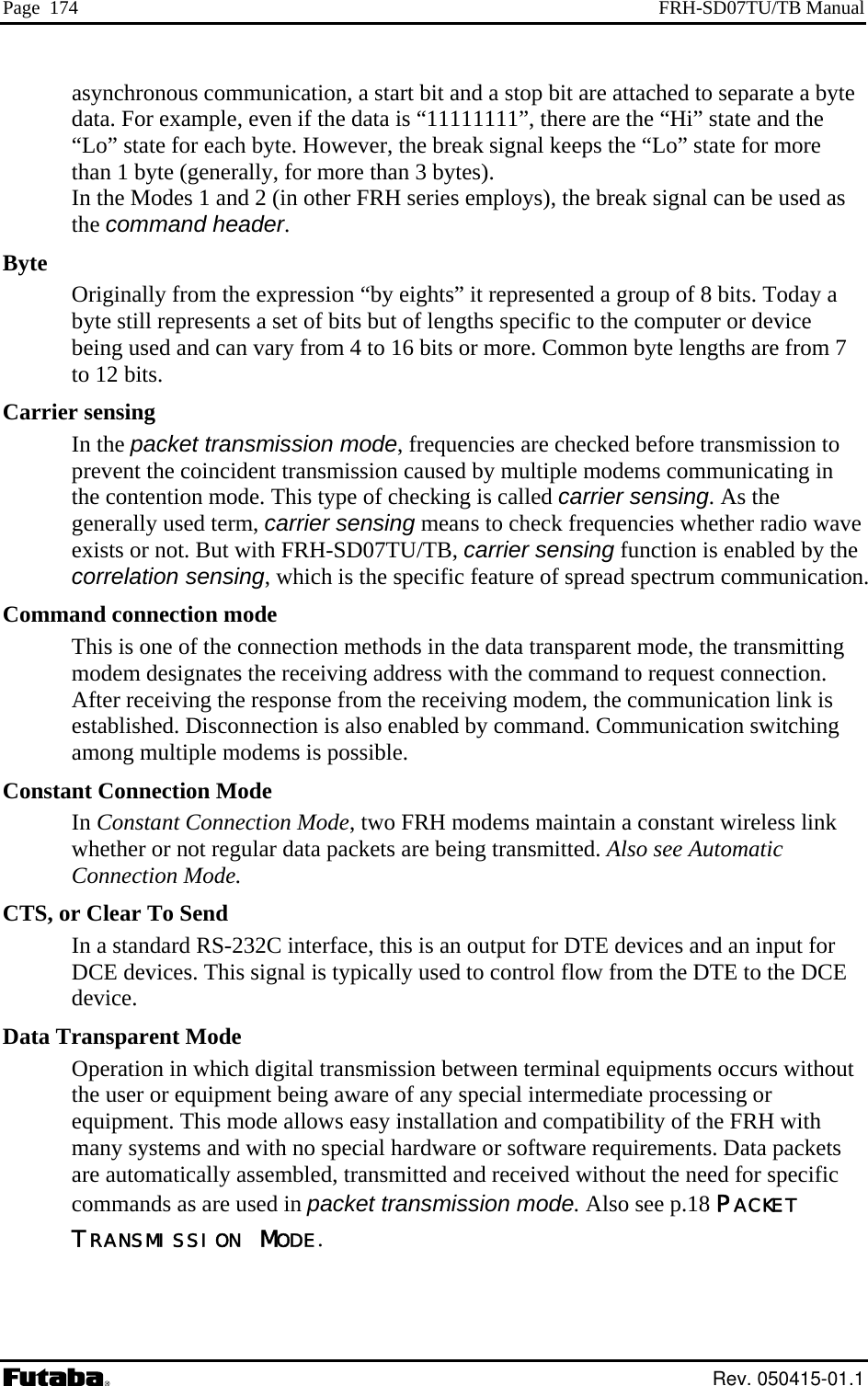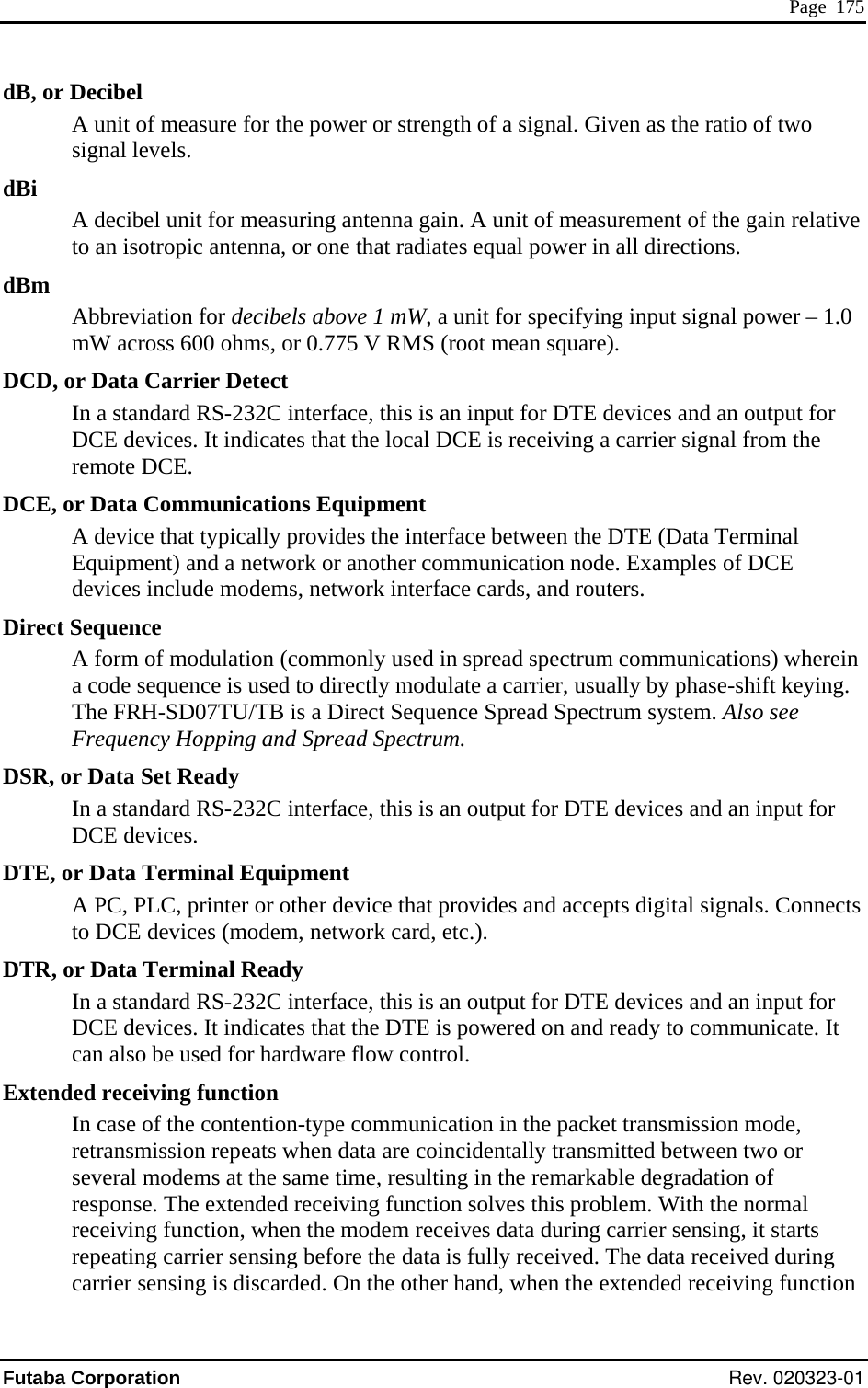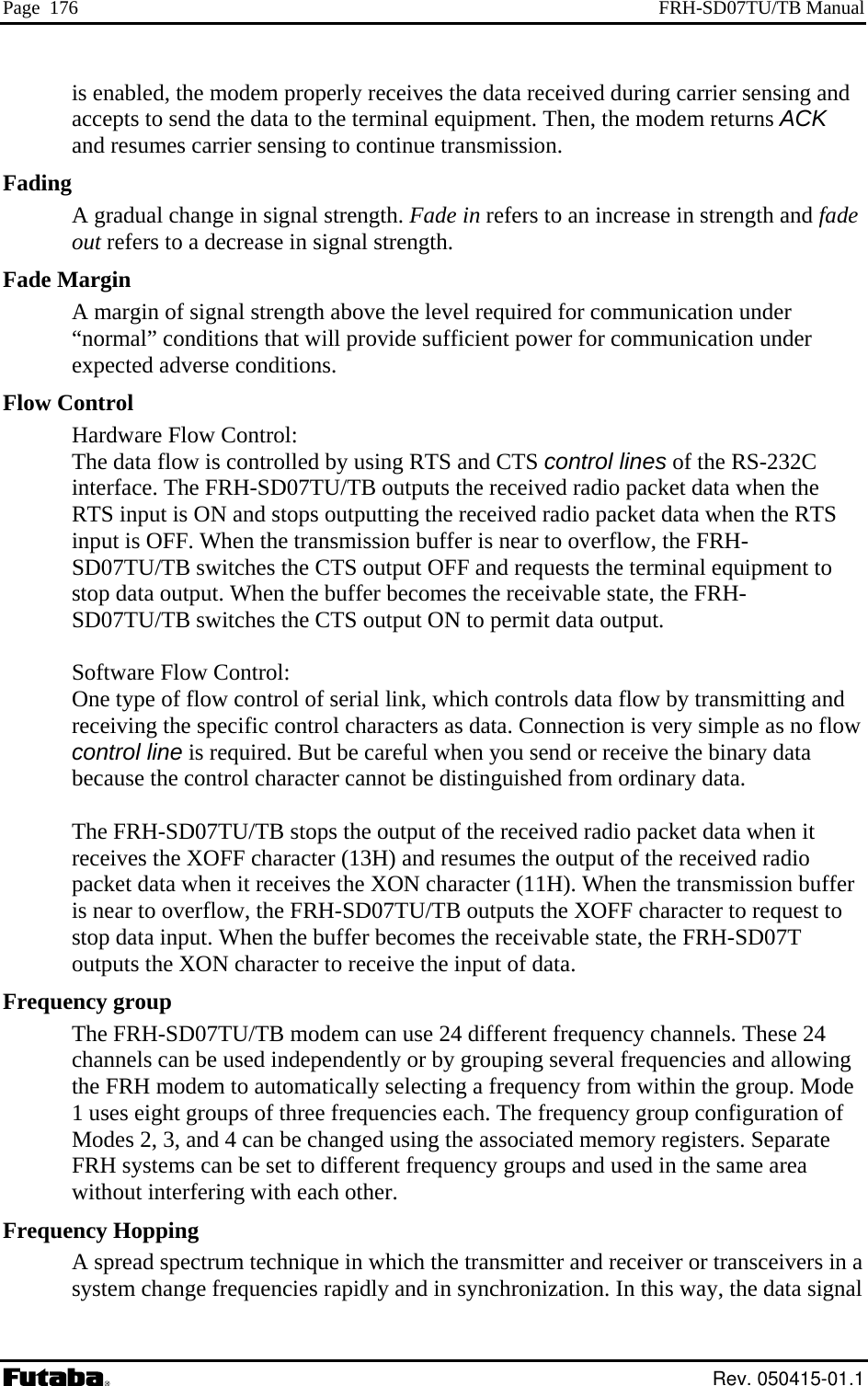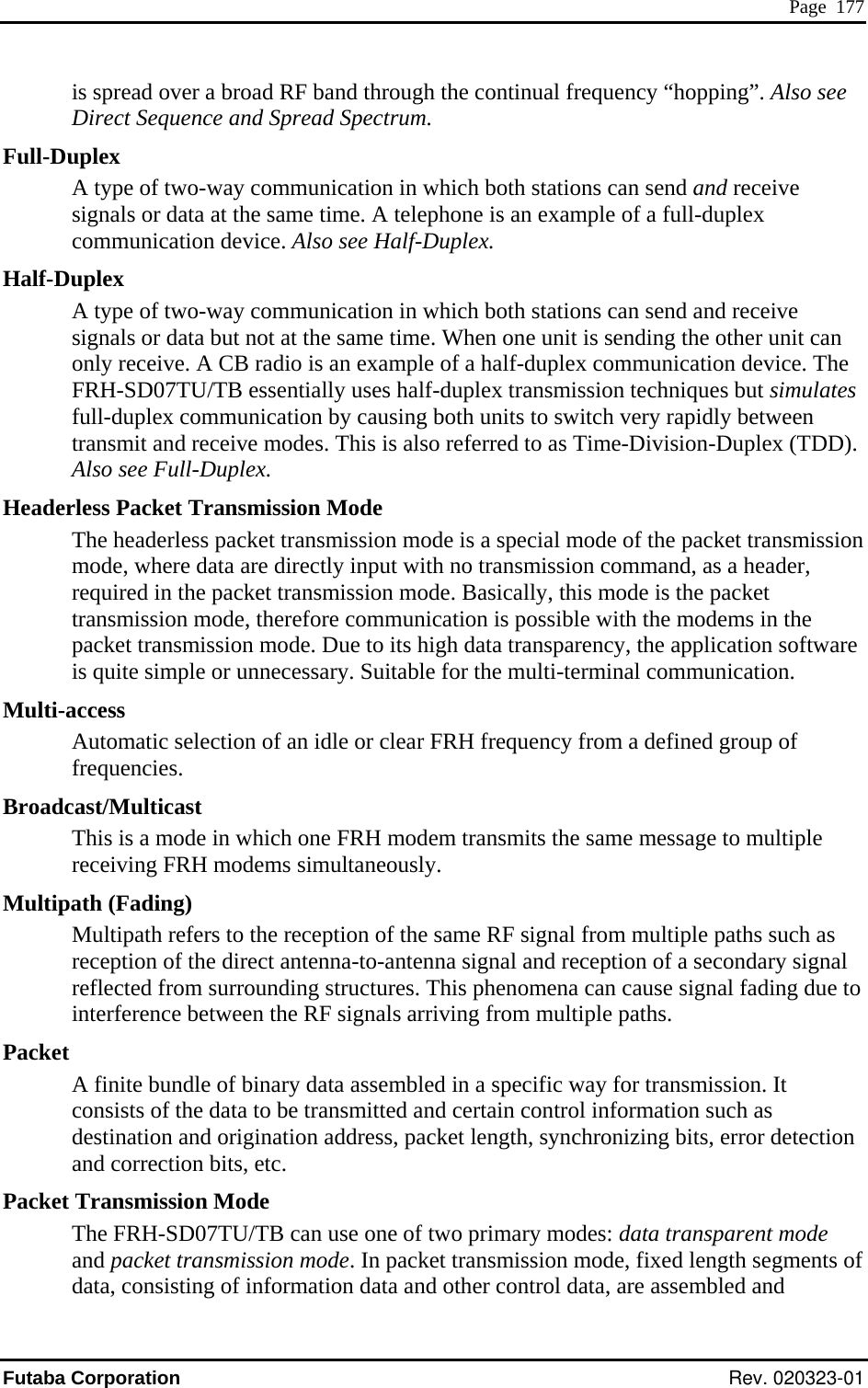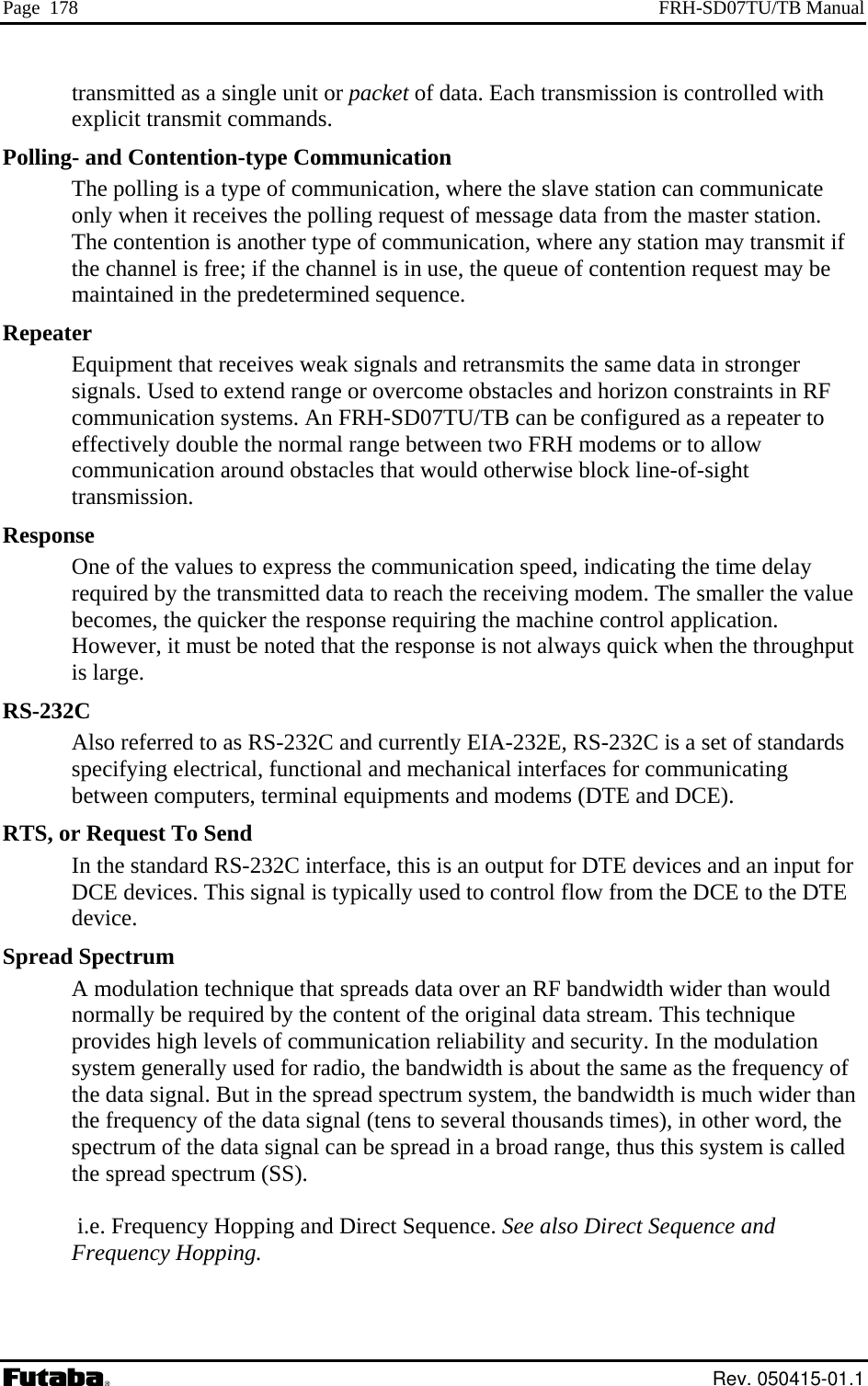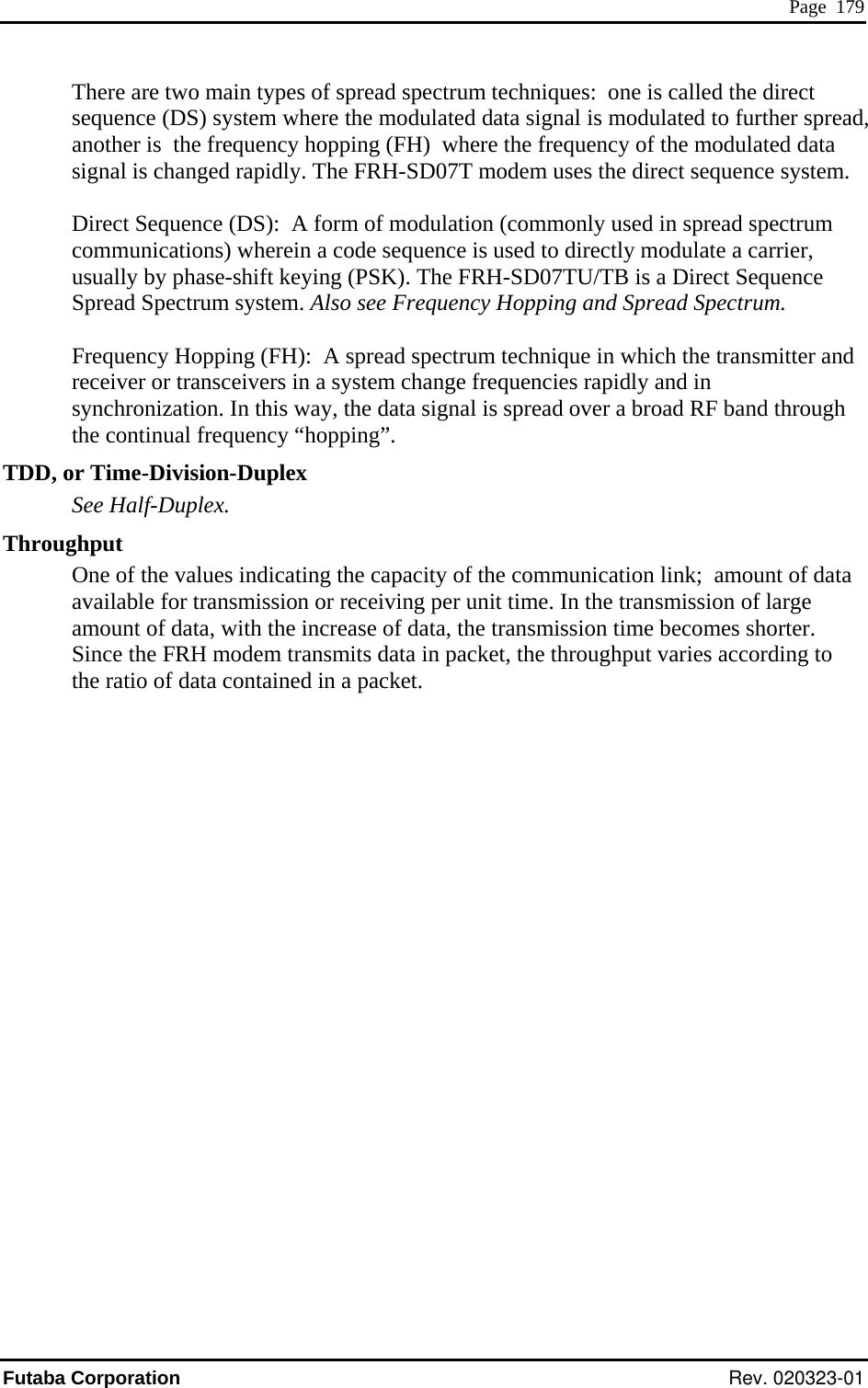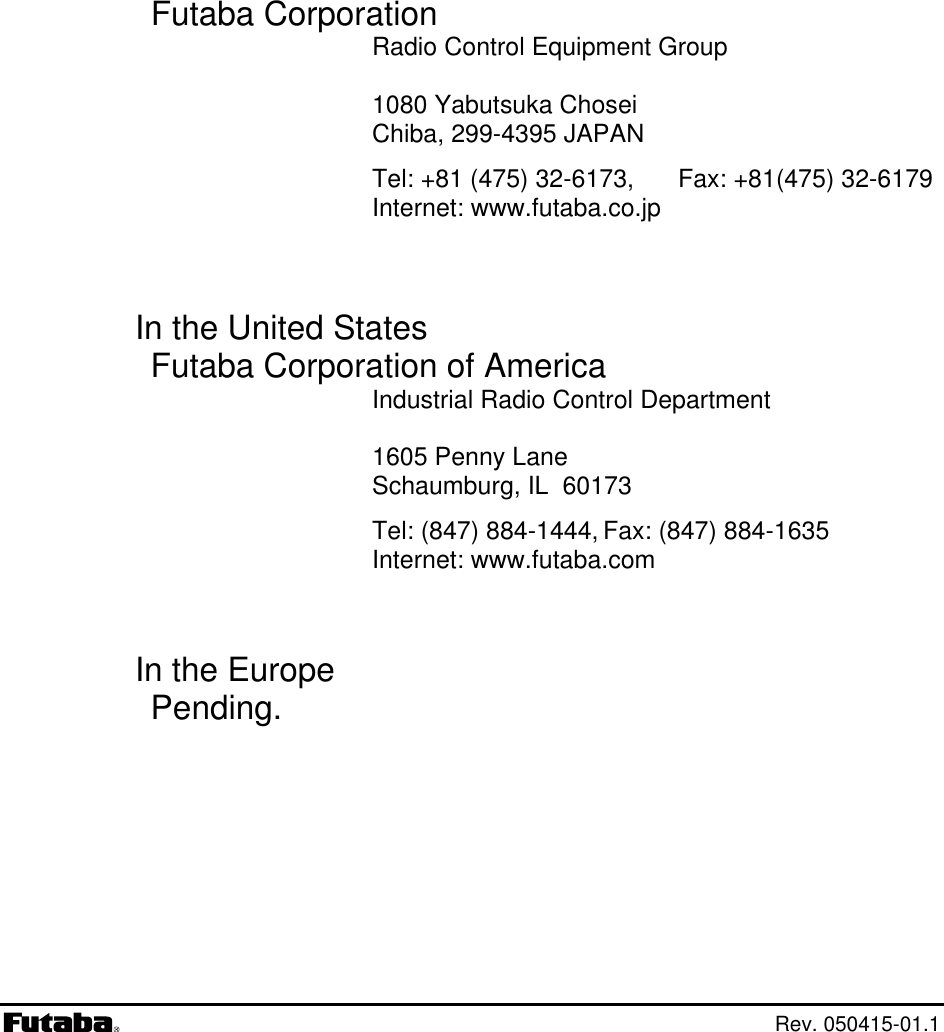Futaba FRH-SD07TU RF Modem using digital modulation User Manual Your FRH set should contain the following
Futaba Corporation RF Modem using digital modulation Your FRH set should contain the following
Futaba >
Contents
- 1. Users Manual
- 2. User Manual
User Manual
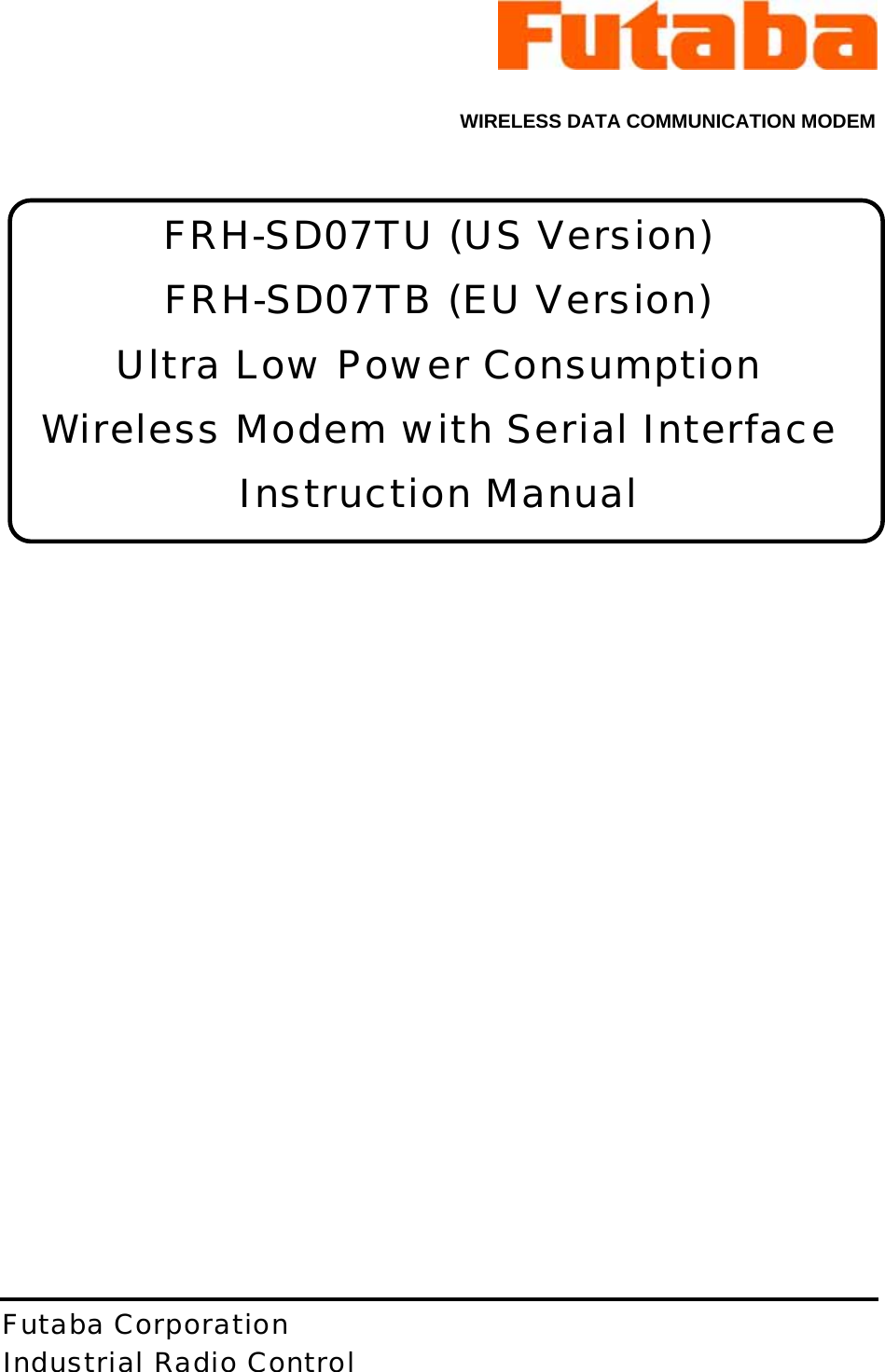
![Page i I Notice This device complies with part 15 of the FCC rules and with ETS 300 440 of the European Telecommunication Standard Institute (ETSI). Operation is subject to the following two conditions: (1) This device may not cause harmful interference, and (2) this device must accept any interference received, including interference that may cause undesired operation. This equipment has been tested and found to comply with the limits for a Class A digital device, pursuant to part 15 of the FCC Rules. These limits are designed to provide reasonable protection against harmful interference when the equipment is operated in a commercial environment. This equipment generates, uses, and can radiate radio frequency energy and, if not installed and used in accordance with the instruction manual, may cause harmful interference to radio communications. Operation of this equipment in a residential area is likely to cause harmful interference in which case the user will be required to correct the interference at his own expense. Any unauthorized changes or modifications to this device not expressly approved by Futaba Corporation could void the user’s authority to operate the device and possibly result in damage to the equipment and/or cause serious or fatal injuries to the operator or nearby personnel. This device is intended to be installed and used in accordance with the instructions contained in this manual. Failure to comply with these instructions could void the user’s authority to operate the device and possibly result in damage to the equipment and/or cause serious or fatal injuries to the operator or nearby personnel. [Especially for users in Europe] FRH-SD07TB, European version can be used in the following countries: Austria, Belgium, Denmark, Estonia, Finland, France, Germany, Greece, Iceland, Ireland, Italy, Luxembourg, Norway, Portugal, Spain, Sweden, Switzerland, The Netherlands and United Kingdom (the Czech Republic and Hungary with limitation, see below). In France and Spain, usable frequency is limited by its country’s regulatory authority. See p.35 FREQUENCY GROUPING for the frequency usage limitation. Belgium does not authorize FRH-SD07TB itself. FRH-SD07TB must be fitted into the final product, then tested to Radio, EMC and safety requirements. A notification will be only accepted for the final product then. Users in the Czech Republic and Hungary can use FRH-SD07TB modem, but it has some limitation for operation. Please contact local regulatory authority to obtain details before attempt to use FRH-SD07TB modem in that countries. Futaba Corporation Rev. 050415-01.1](https://usermanual.wiki/Futaba/FRH-SD07TU.User-Manual/User-Guide-535573-Page-3.png)
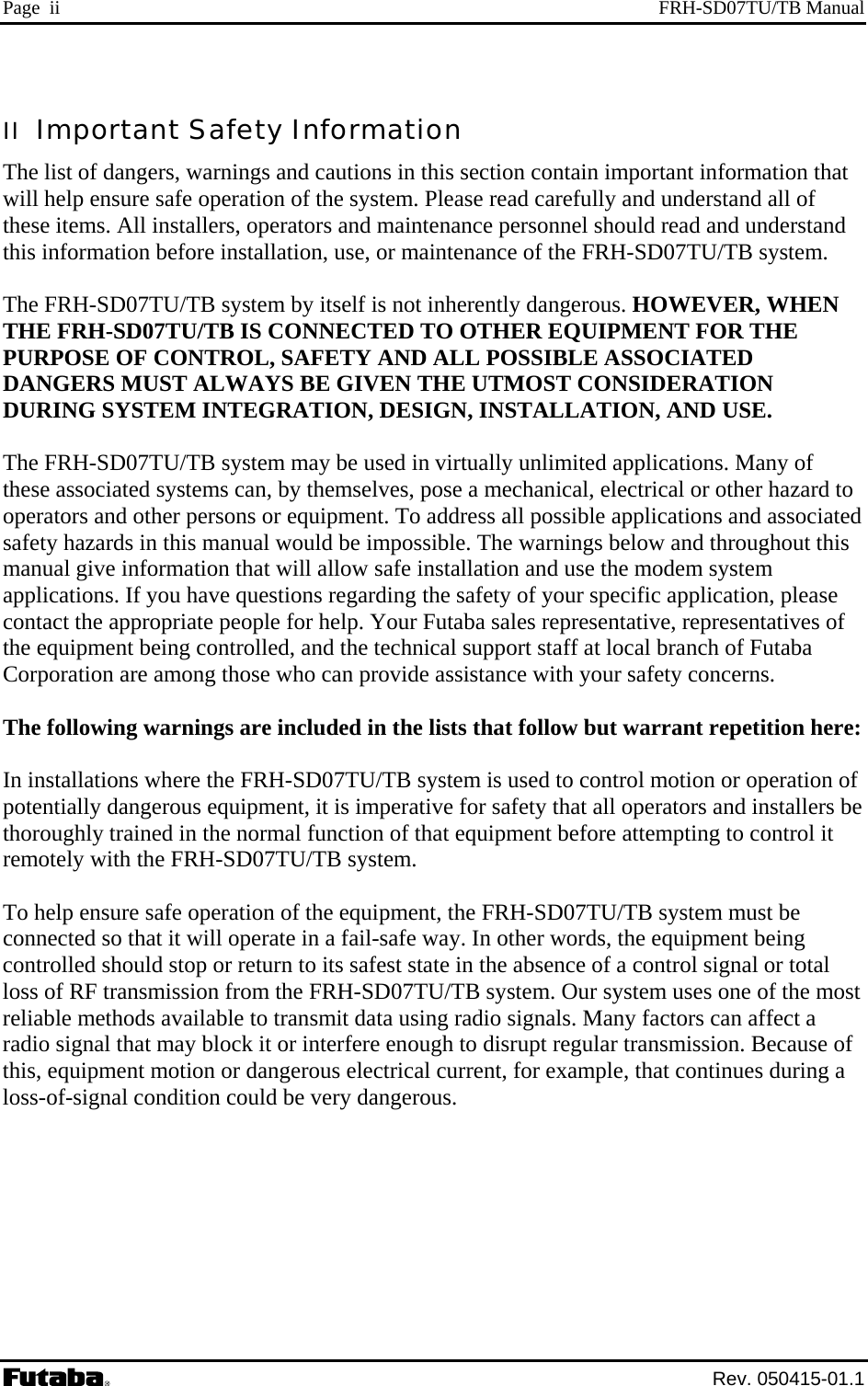
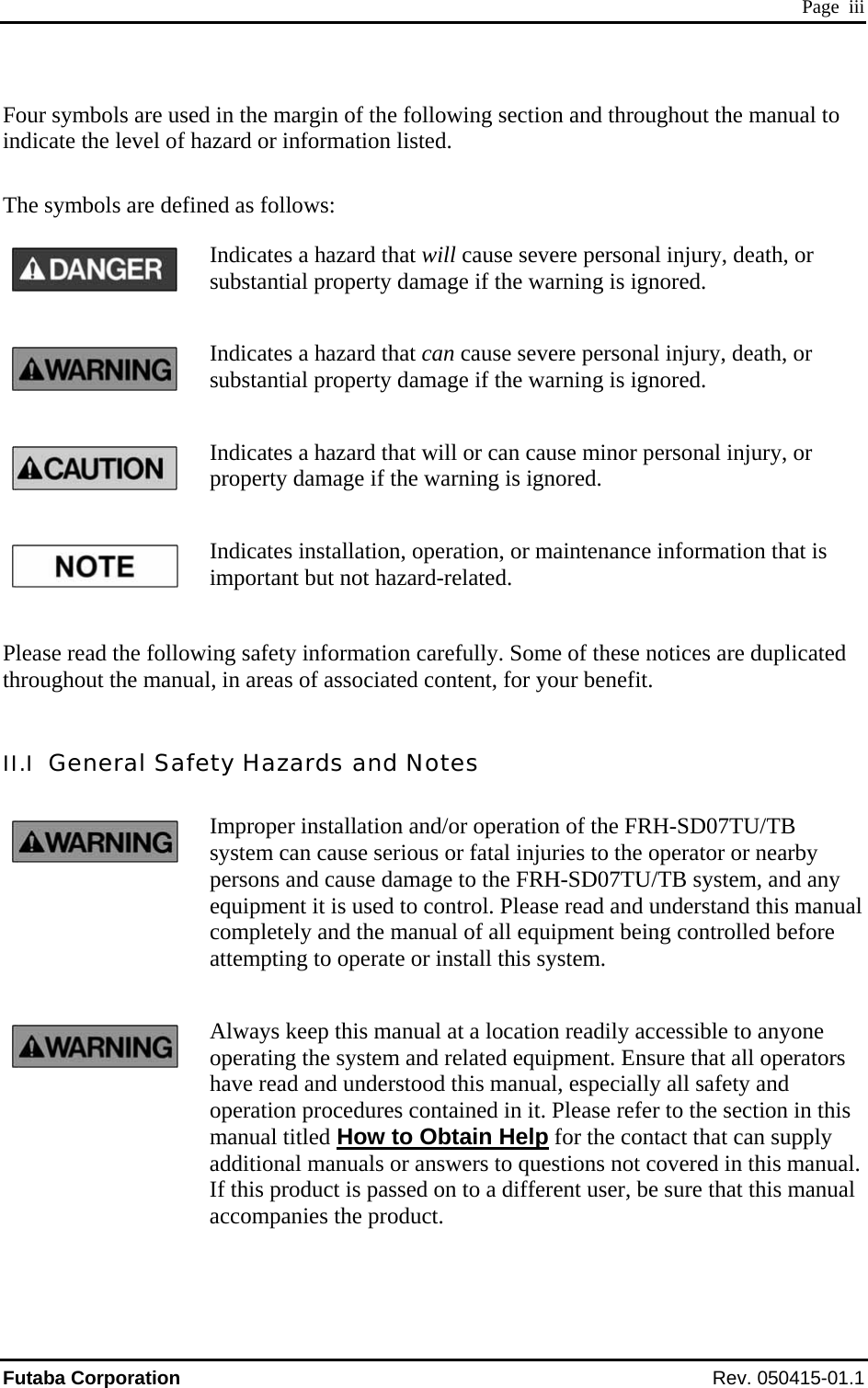
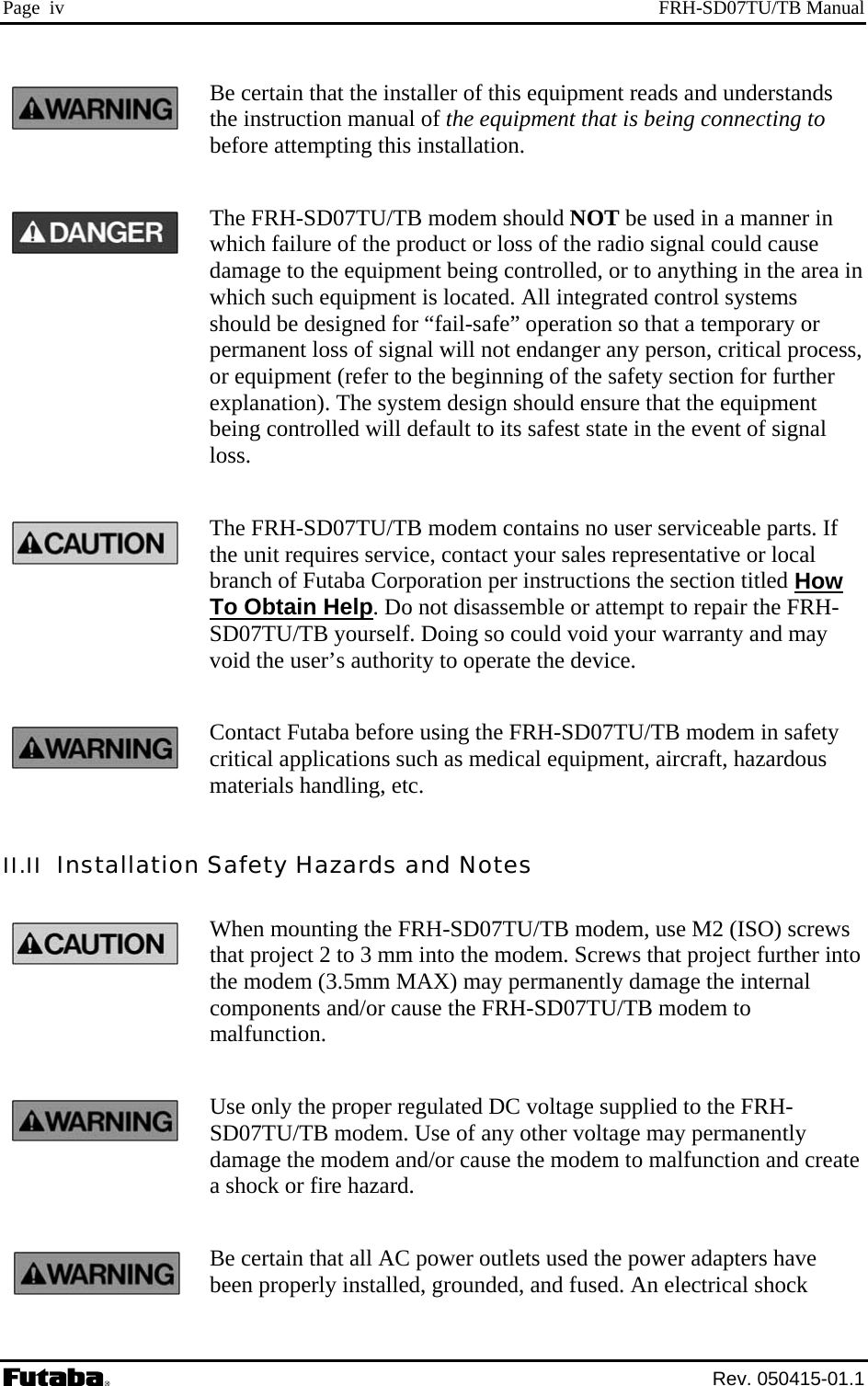
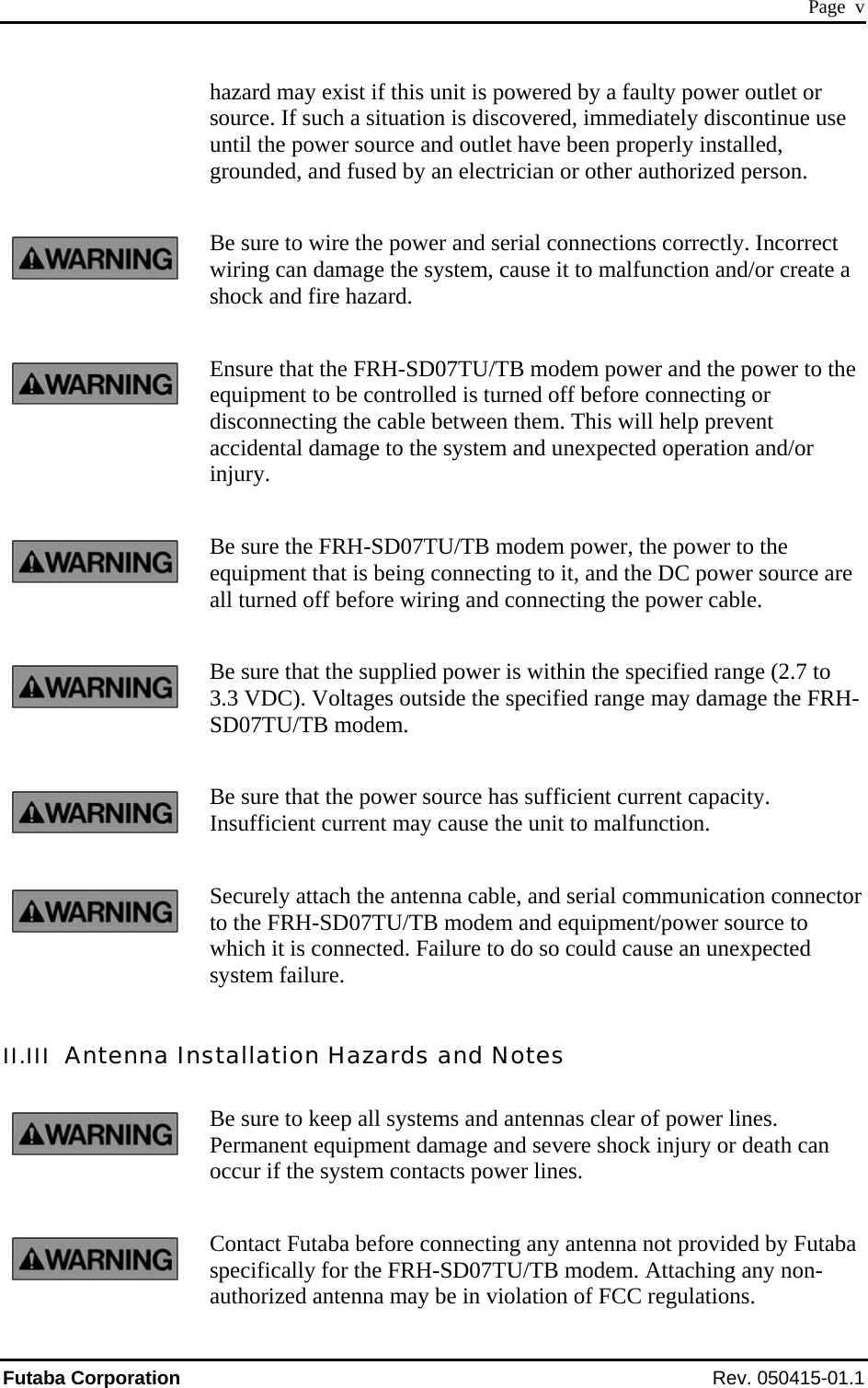
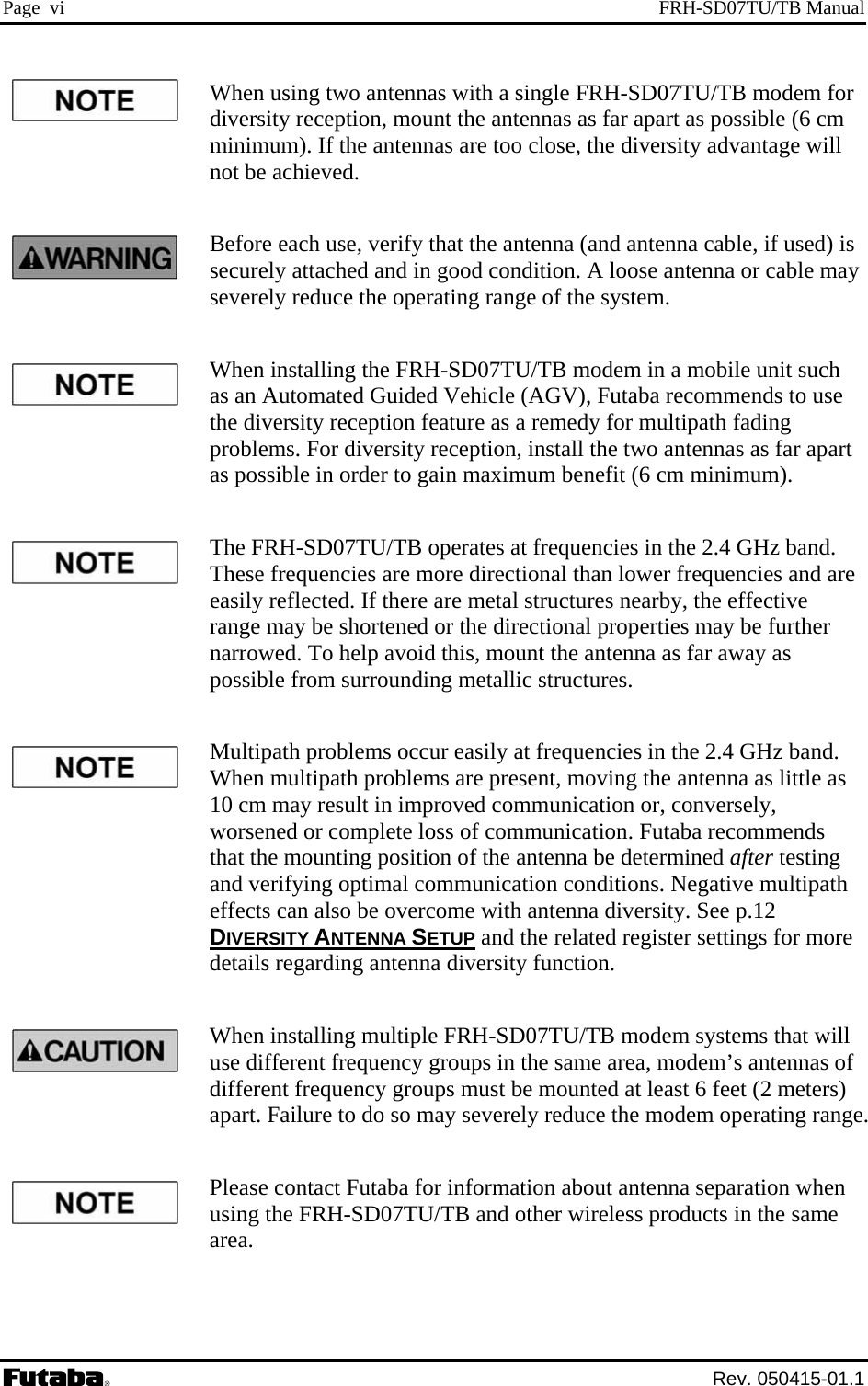
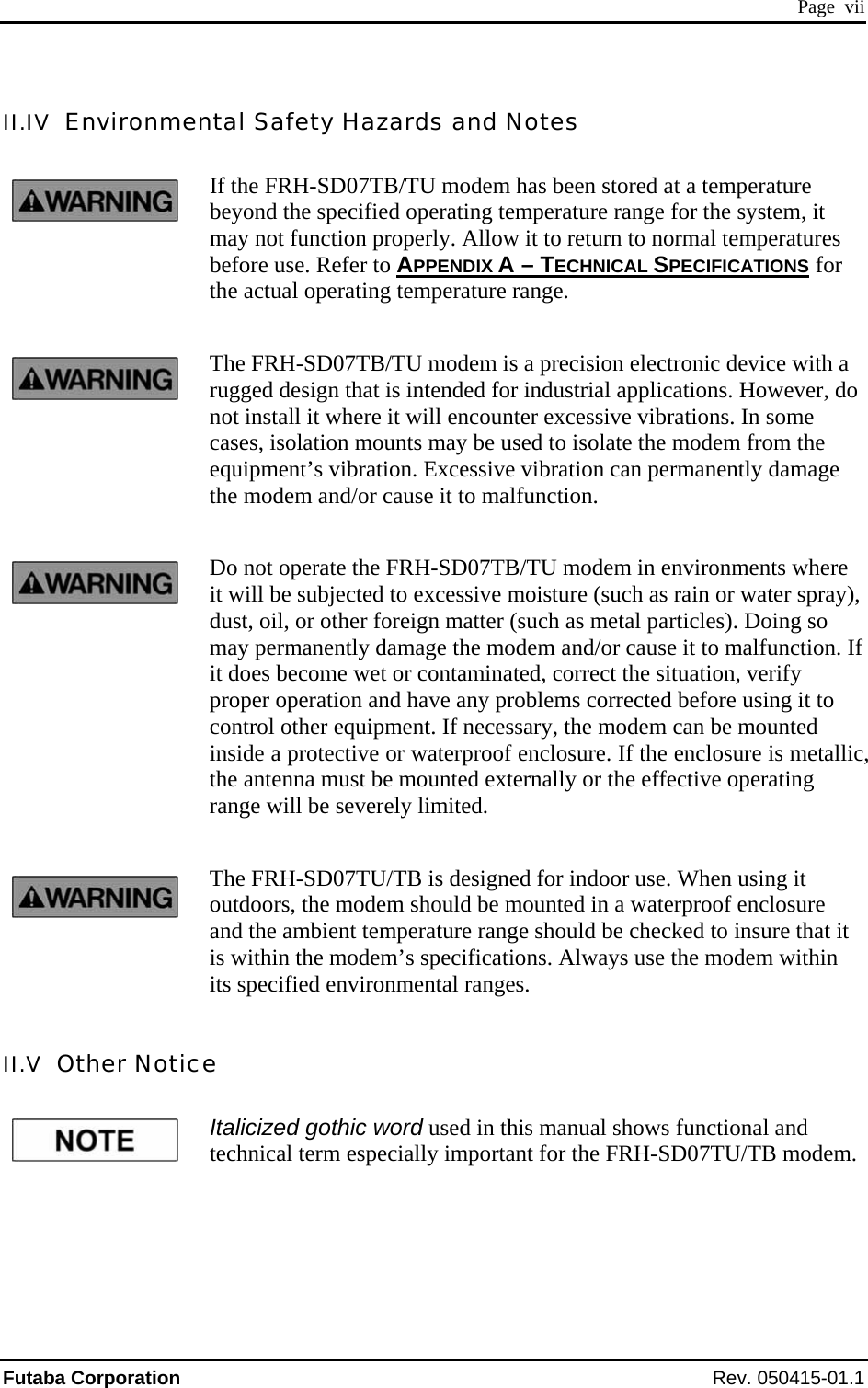
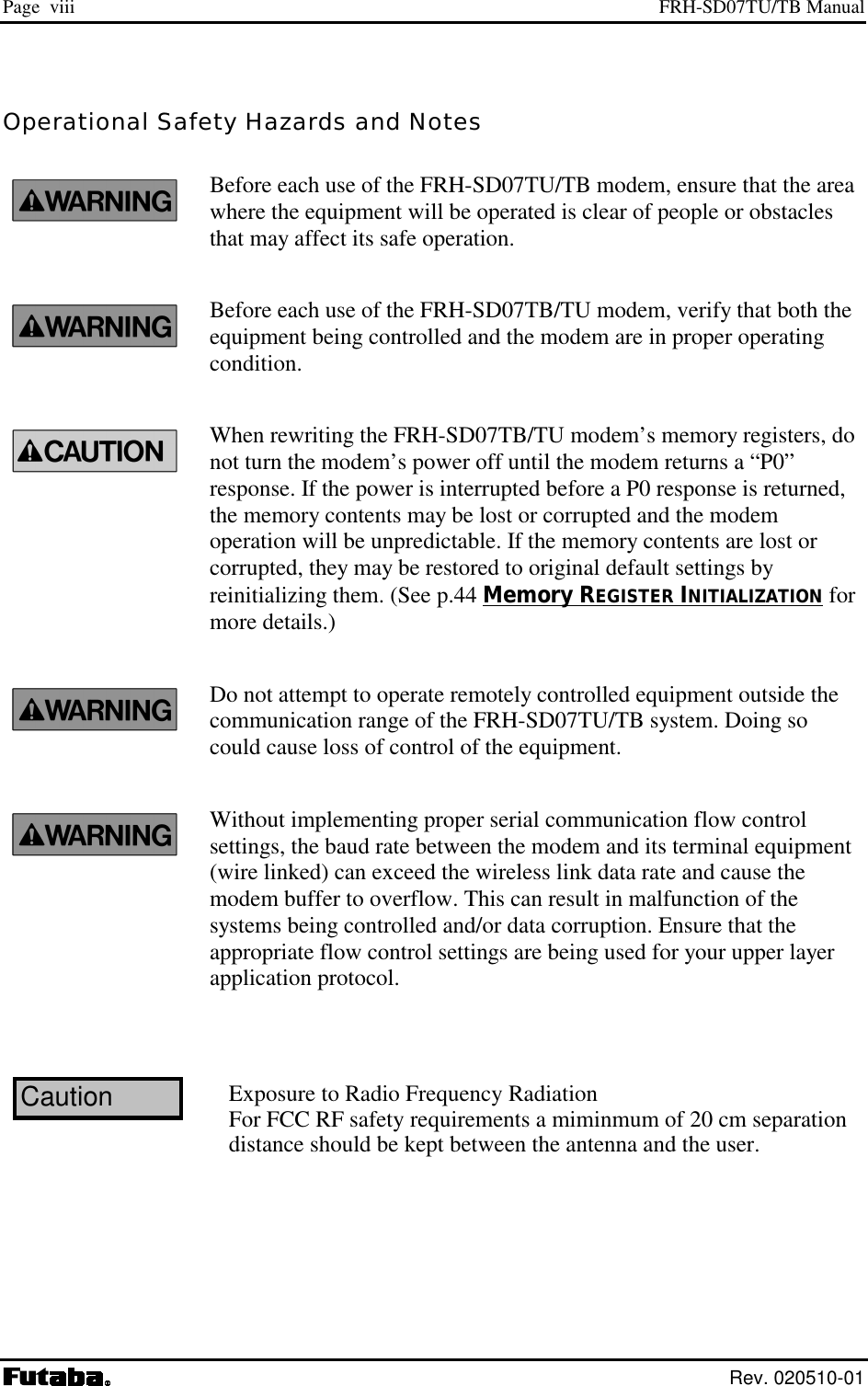
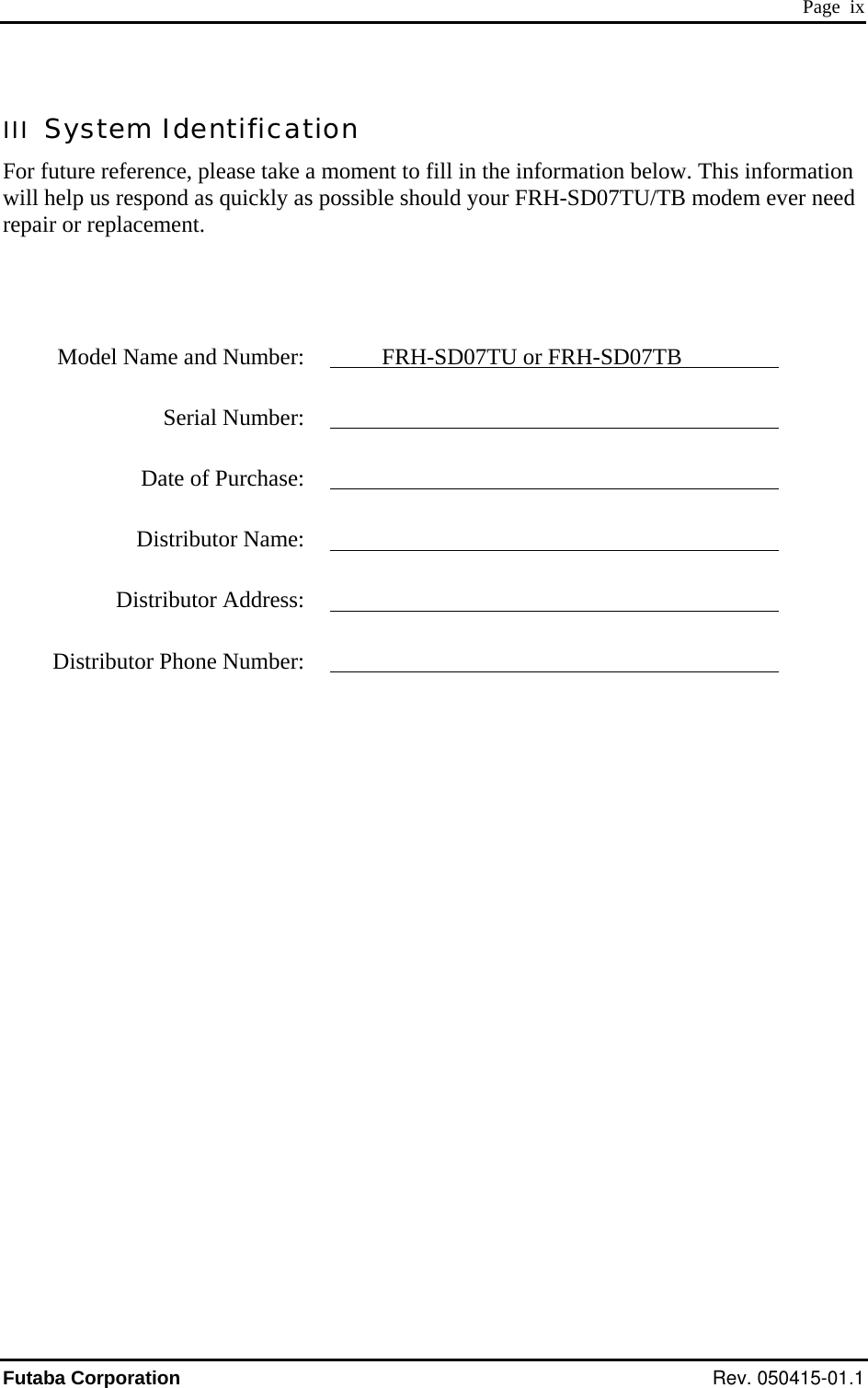
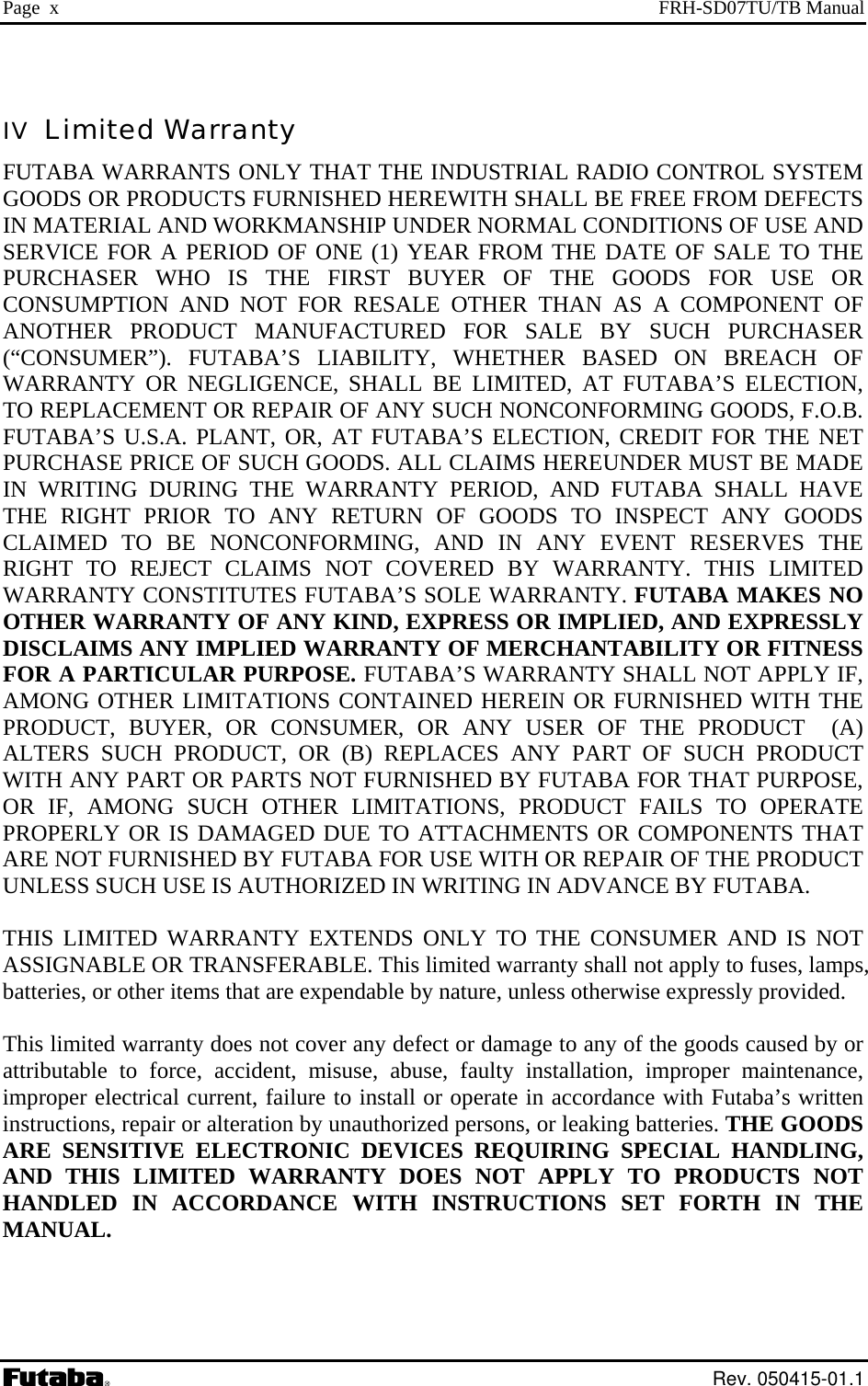
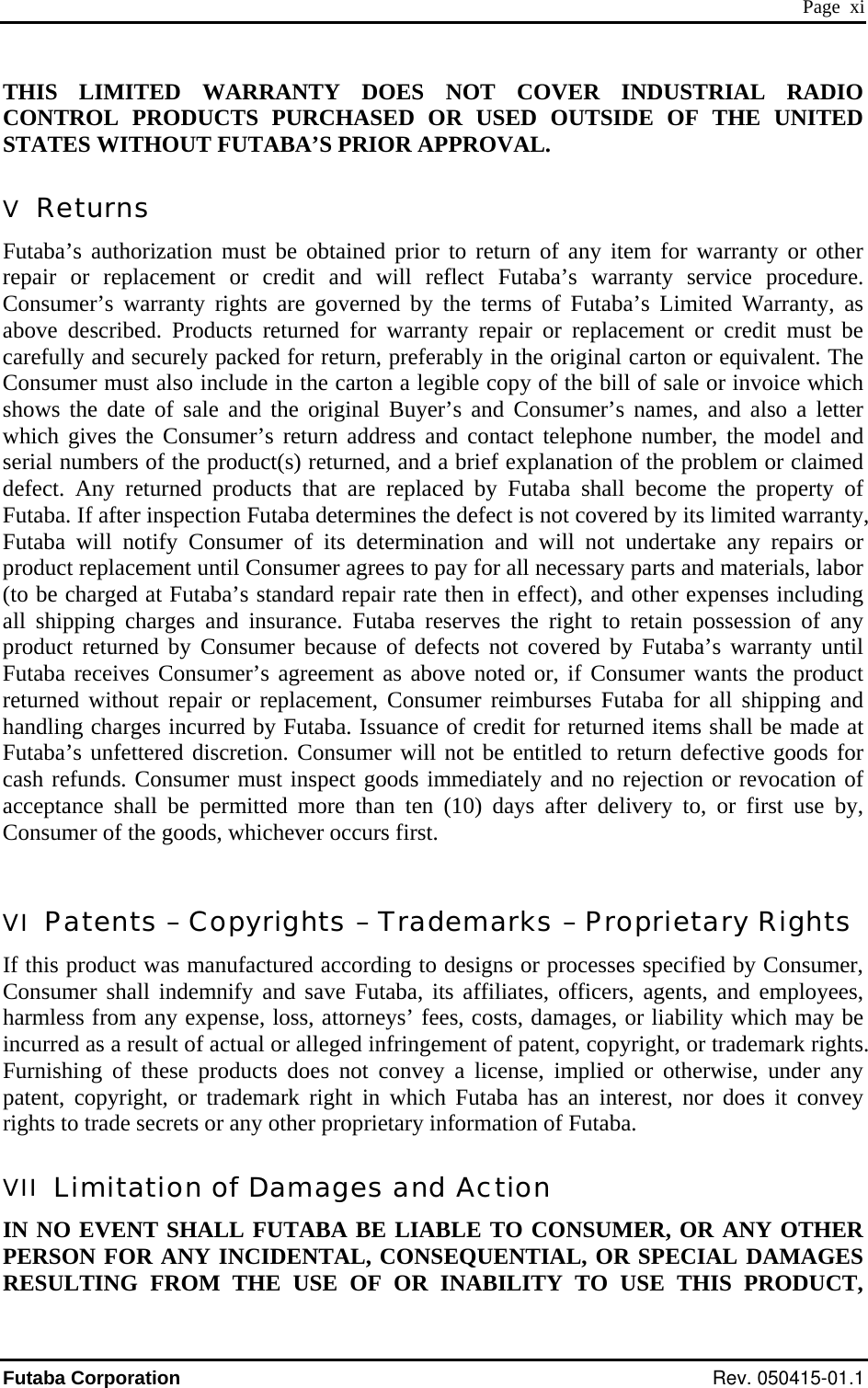
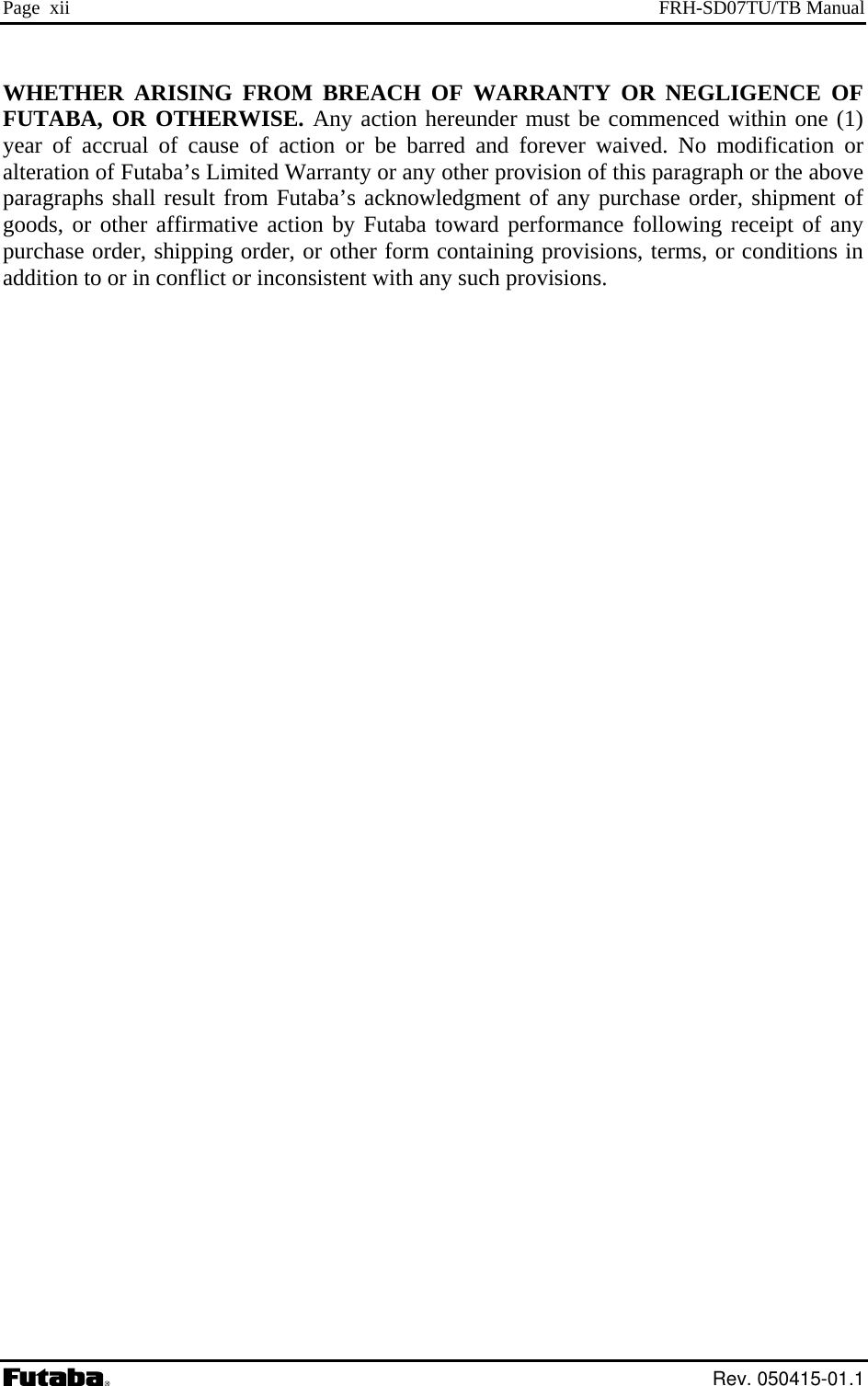
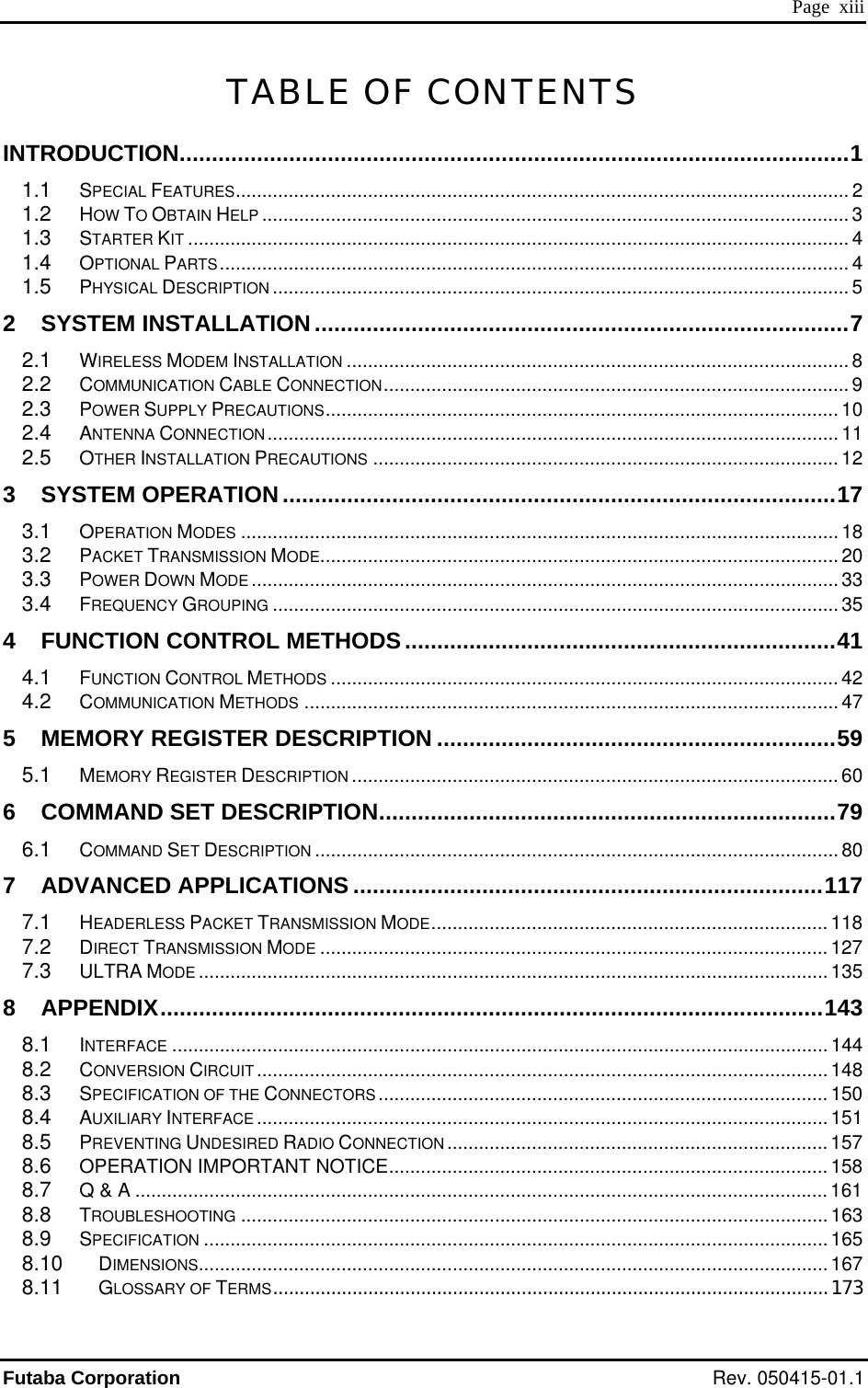
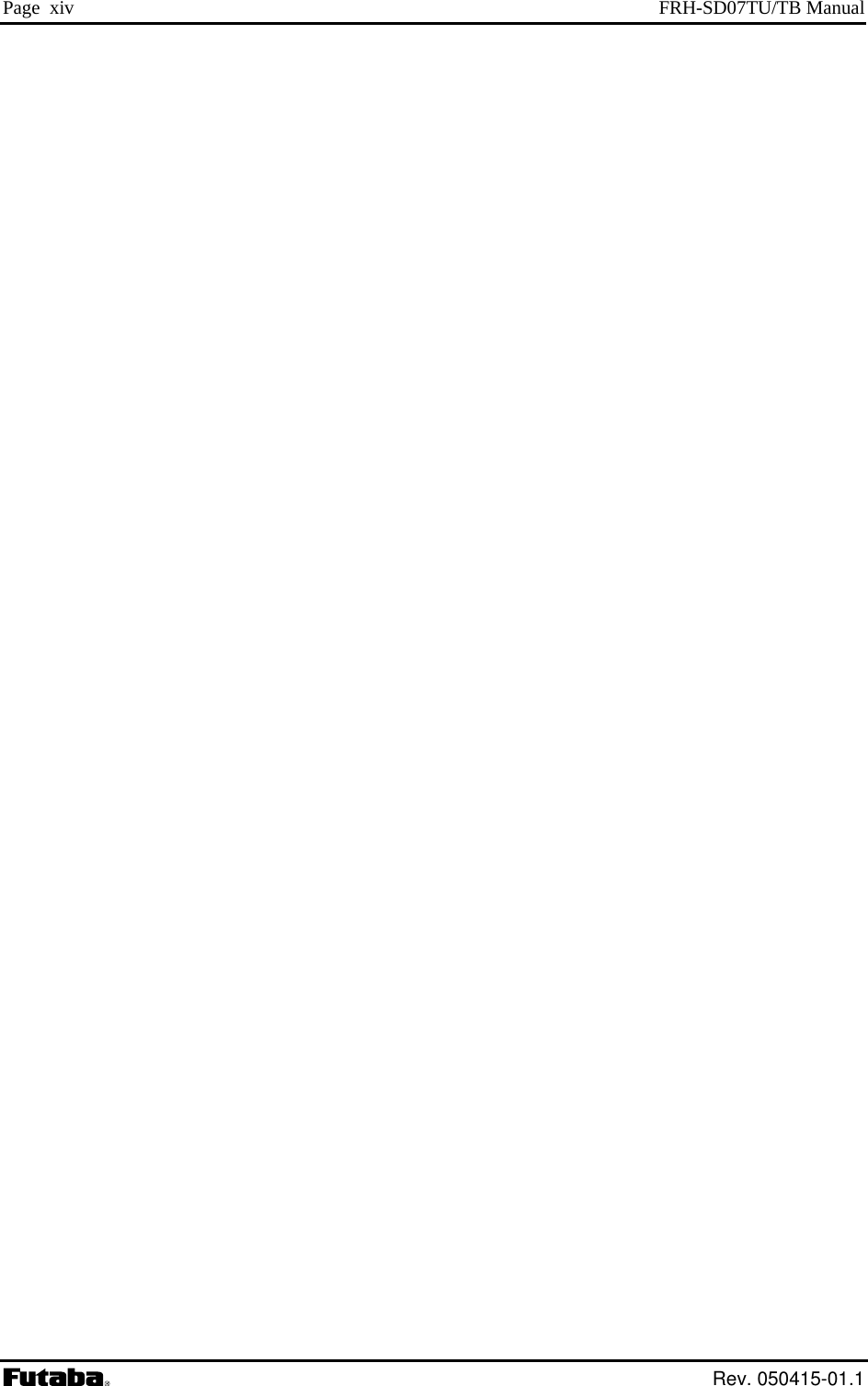
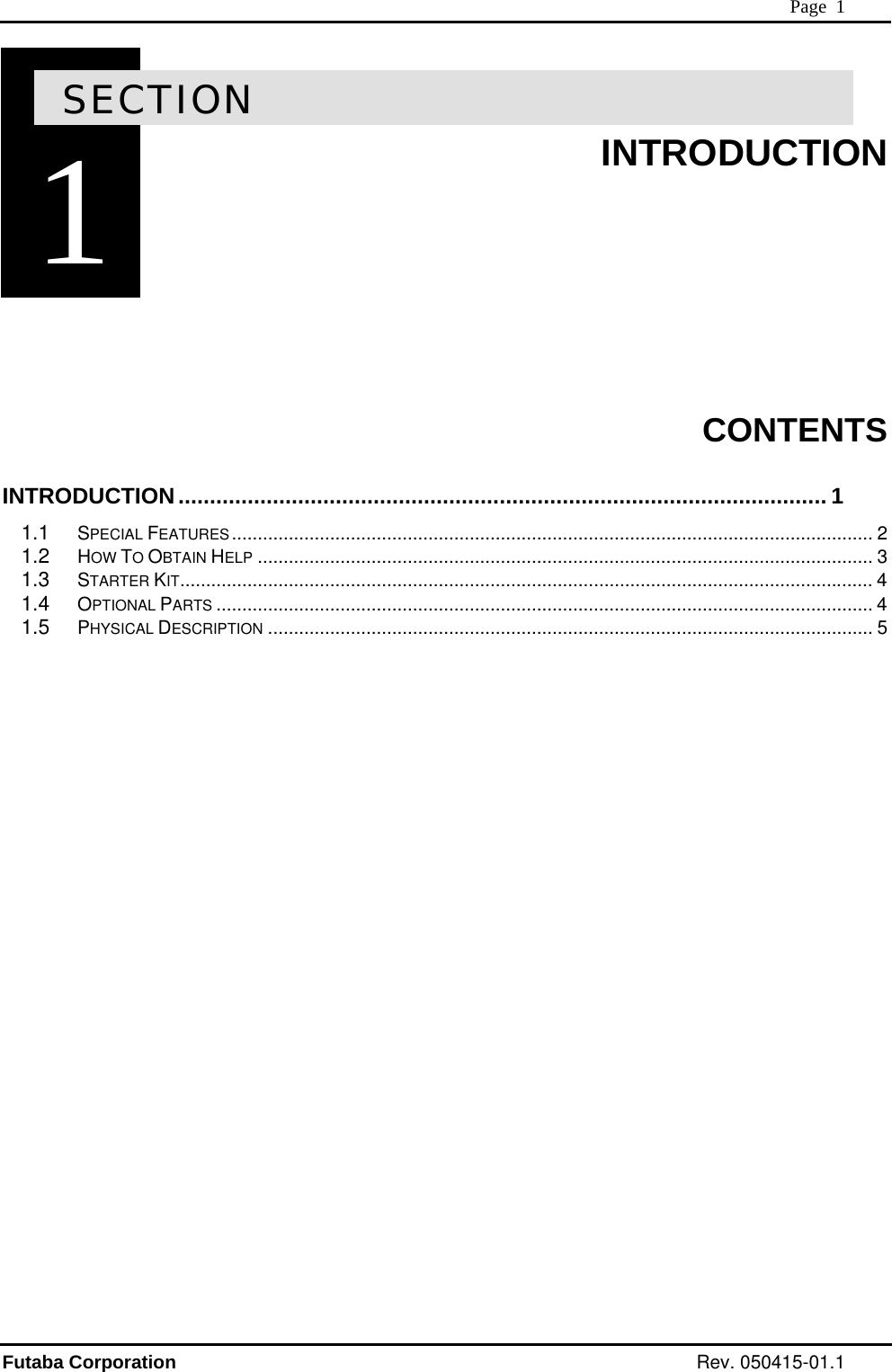
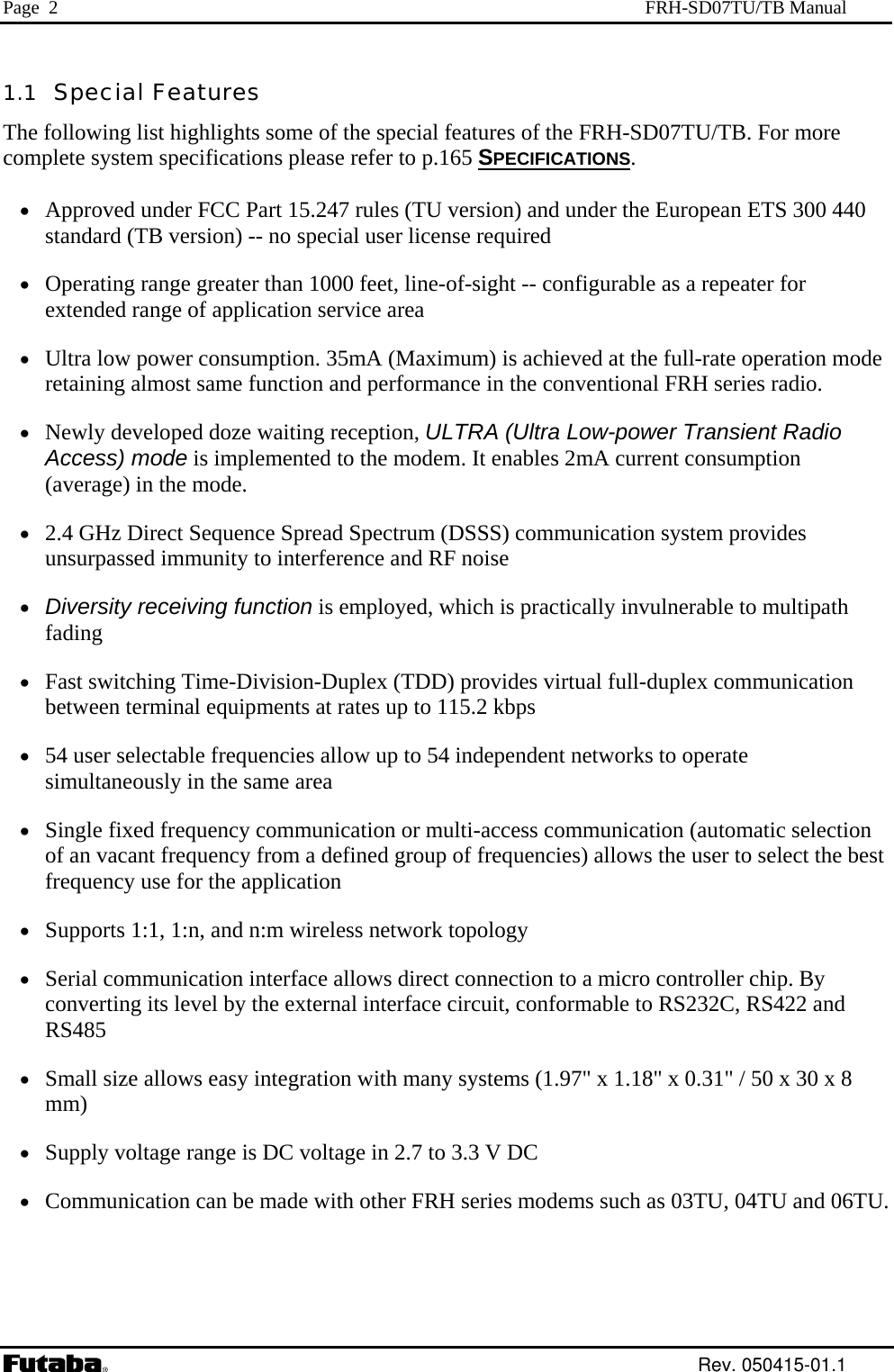
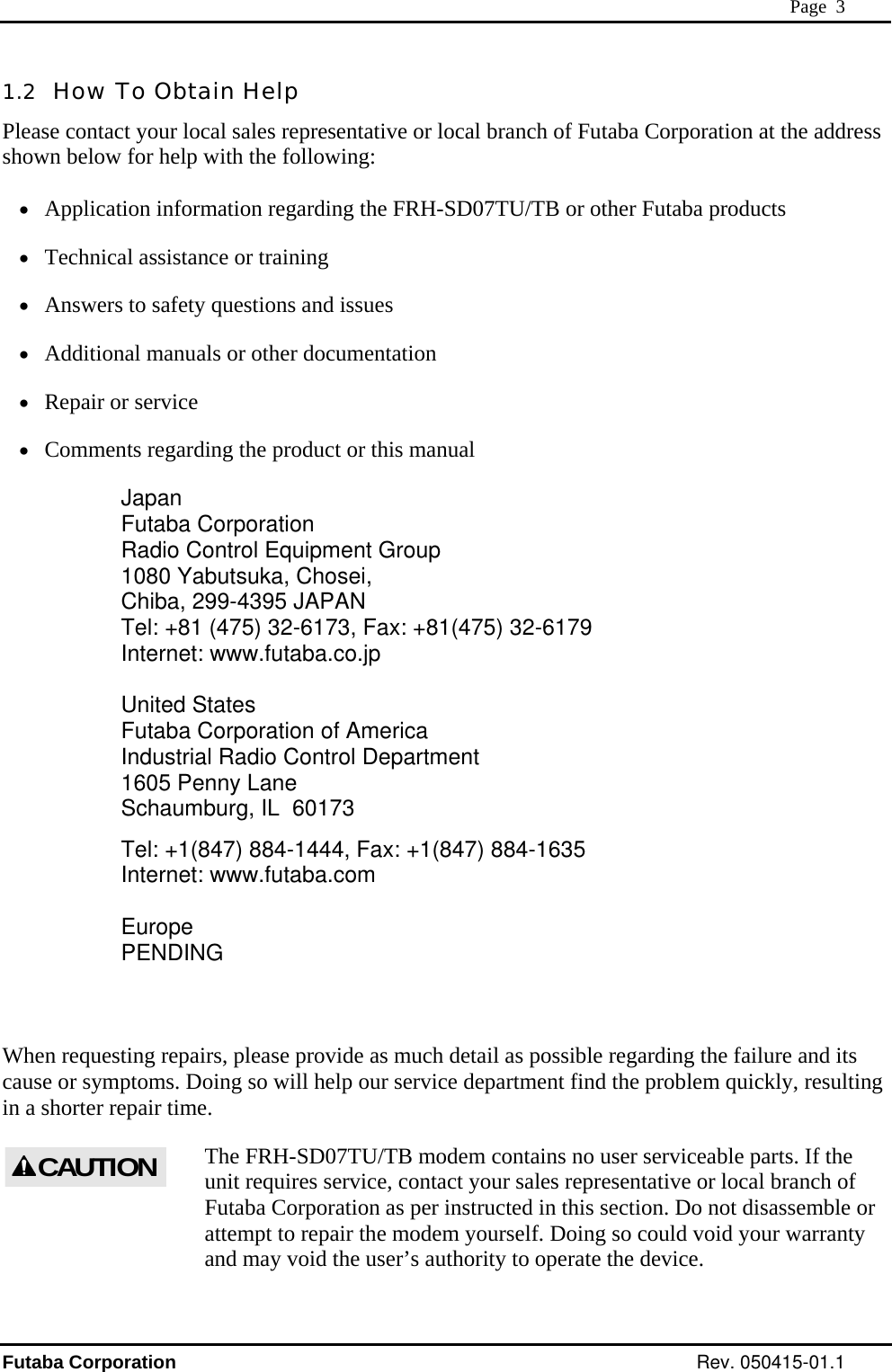
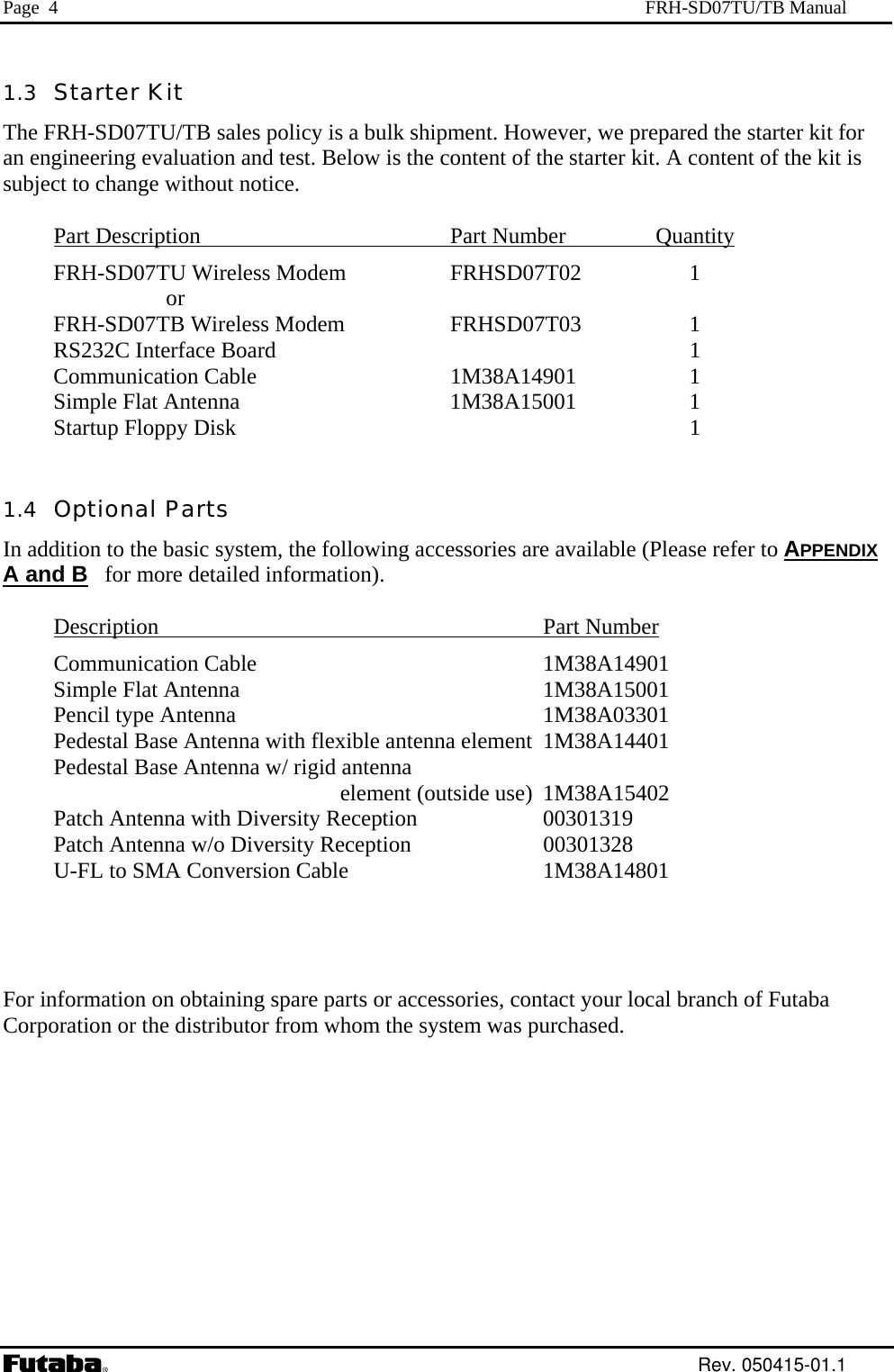
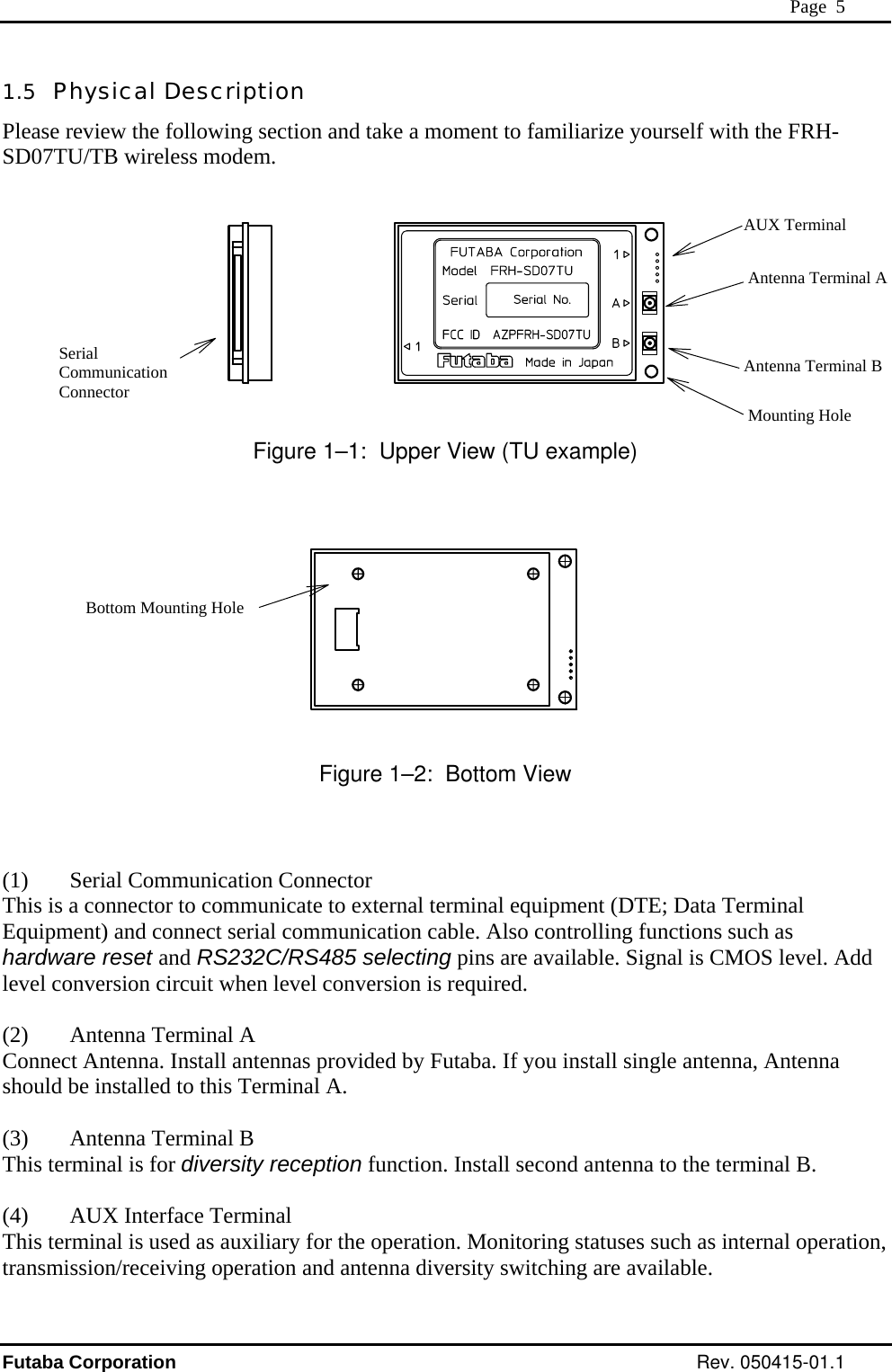
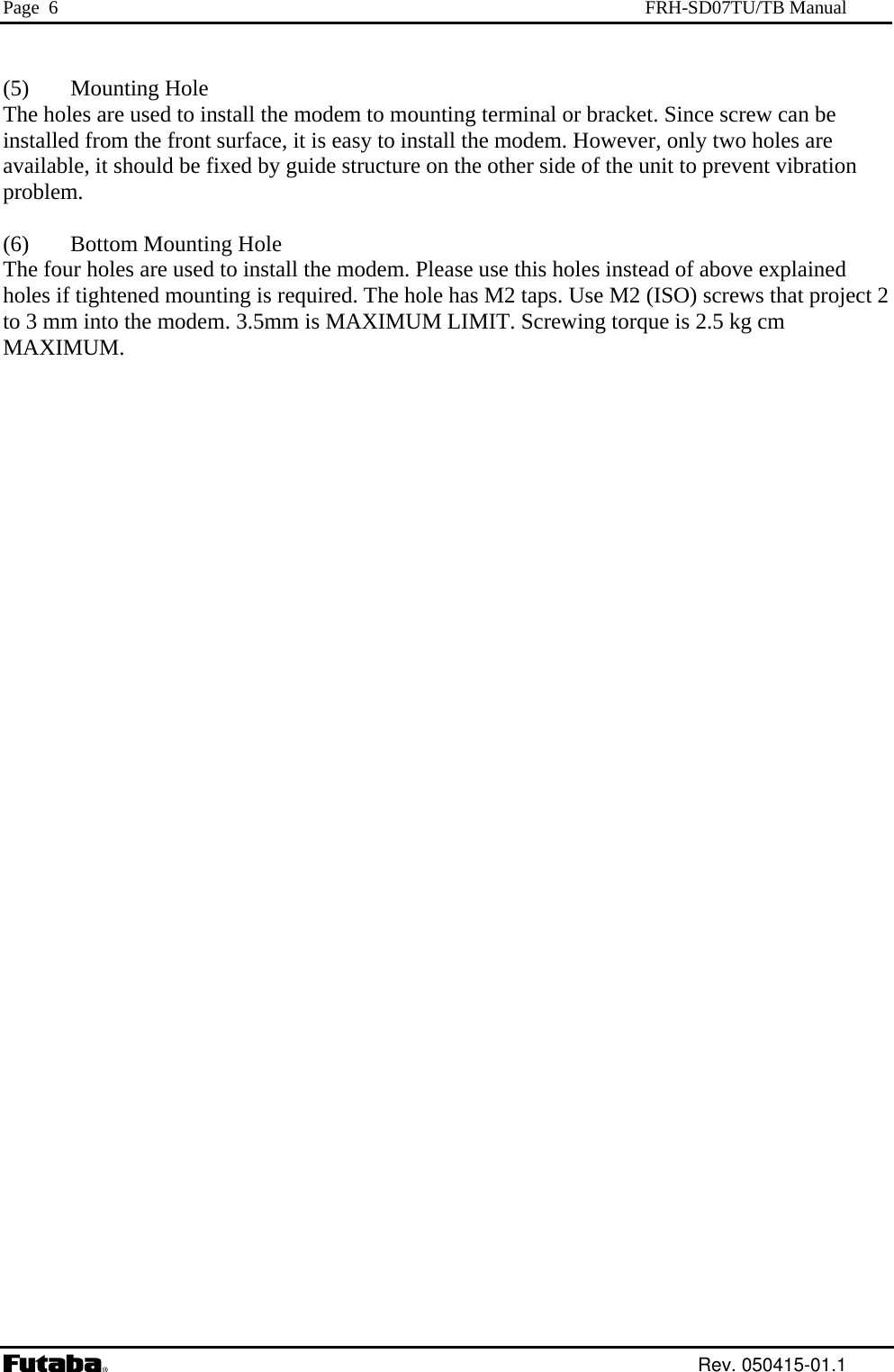
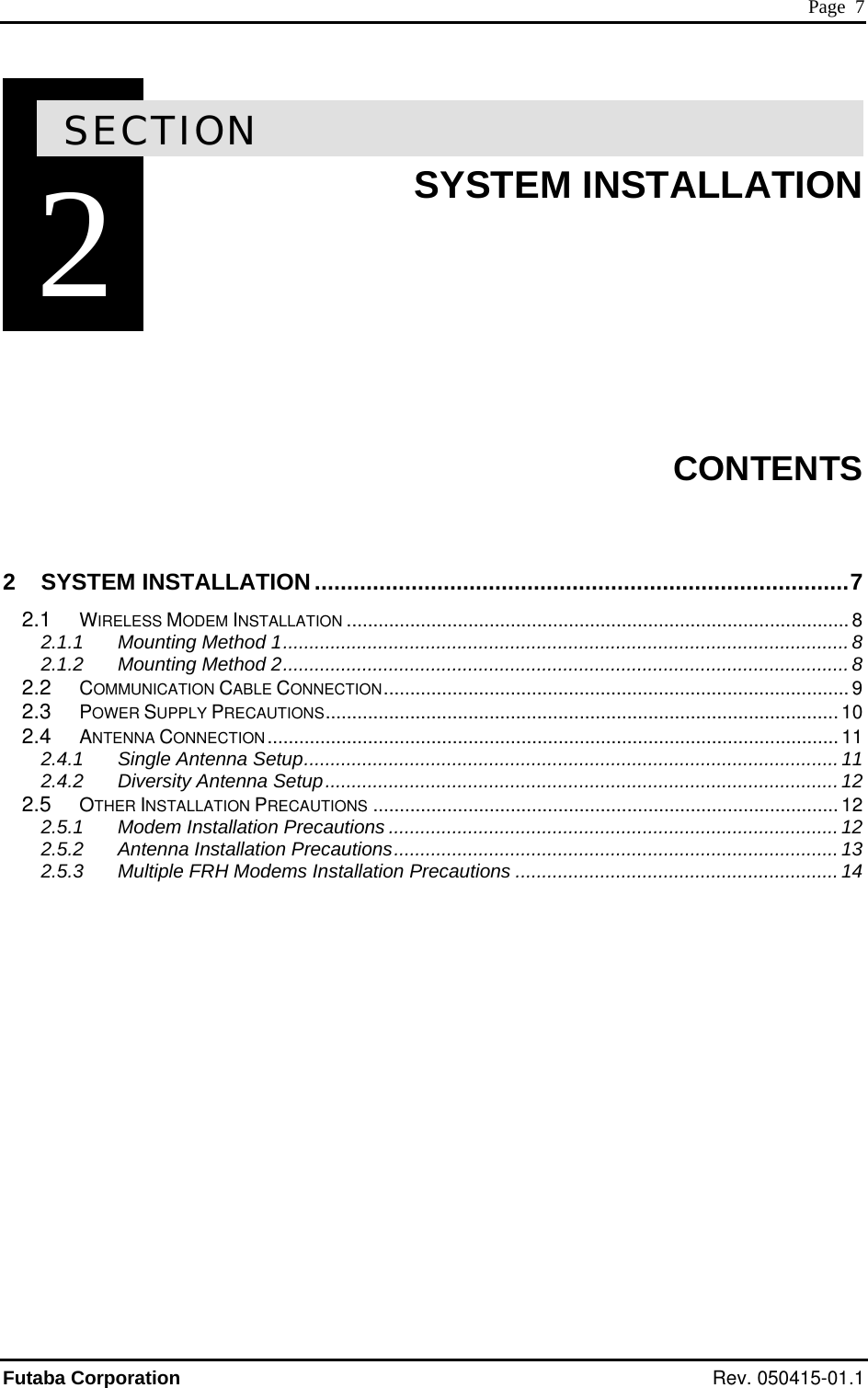
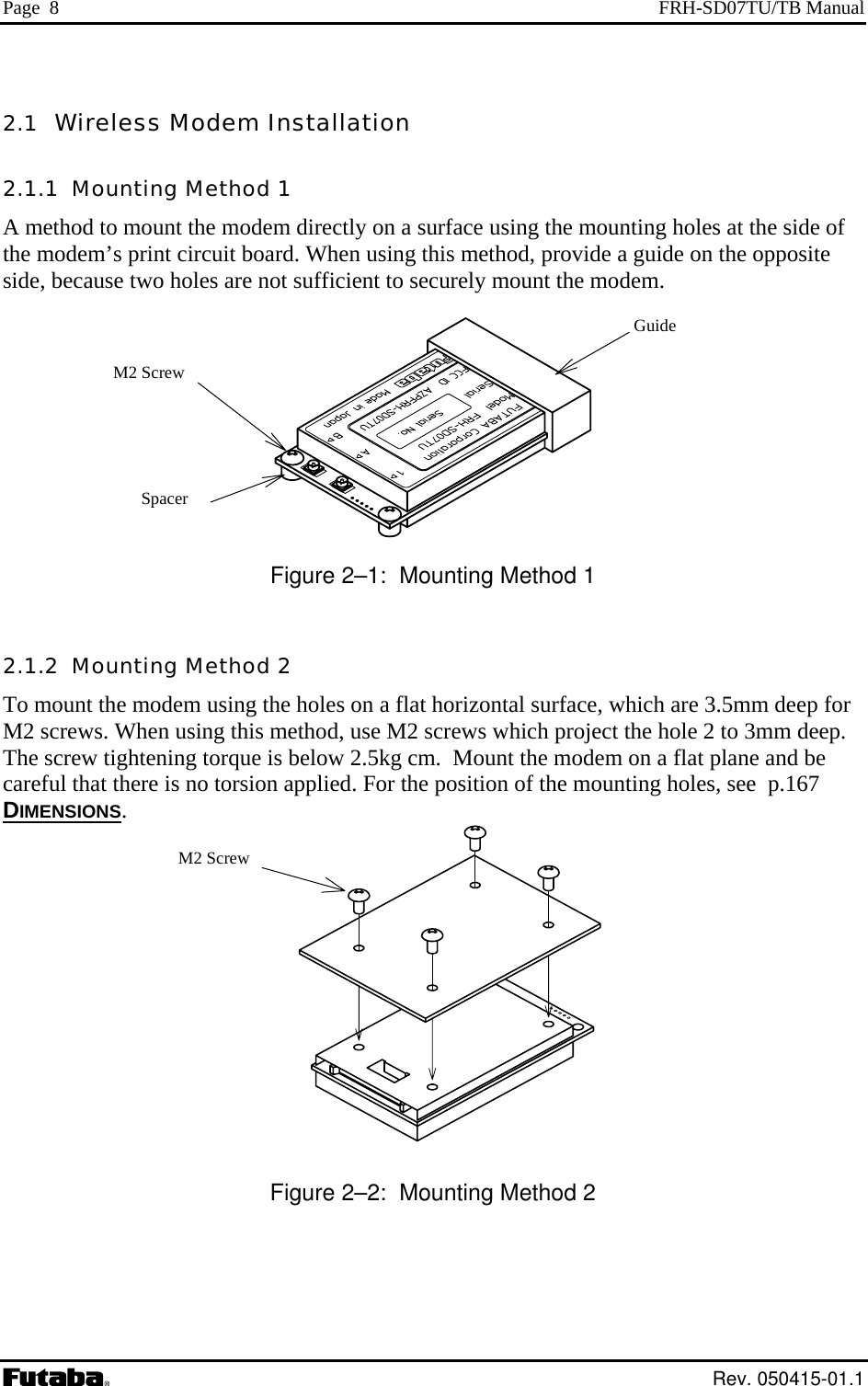
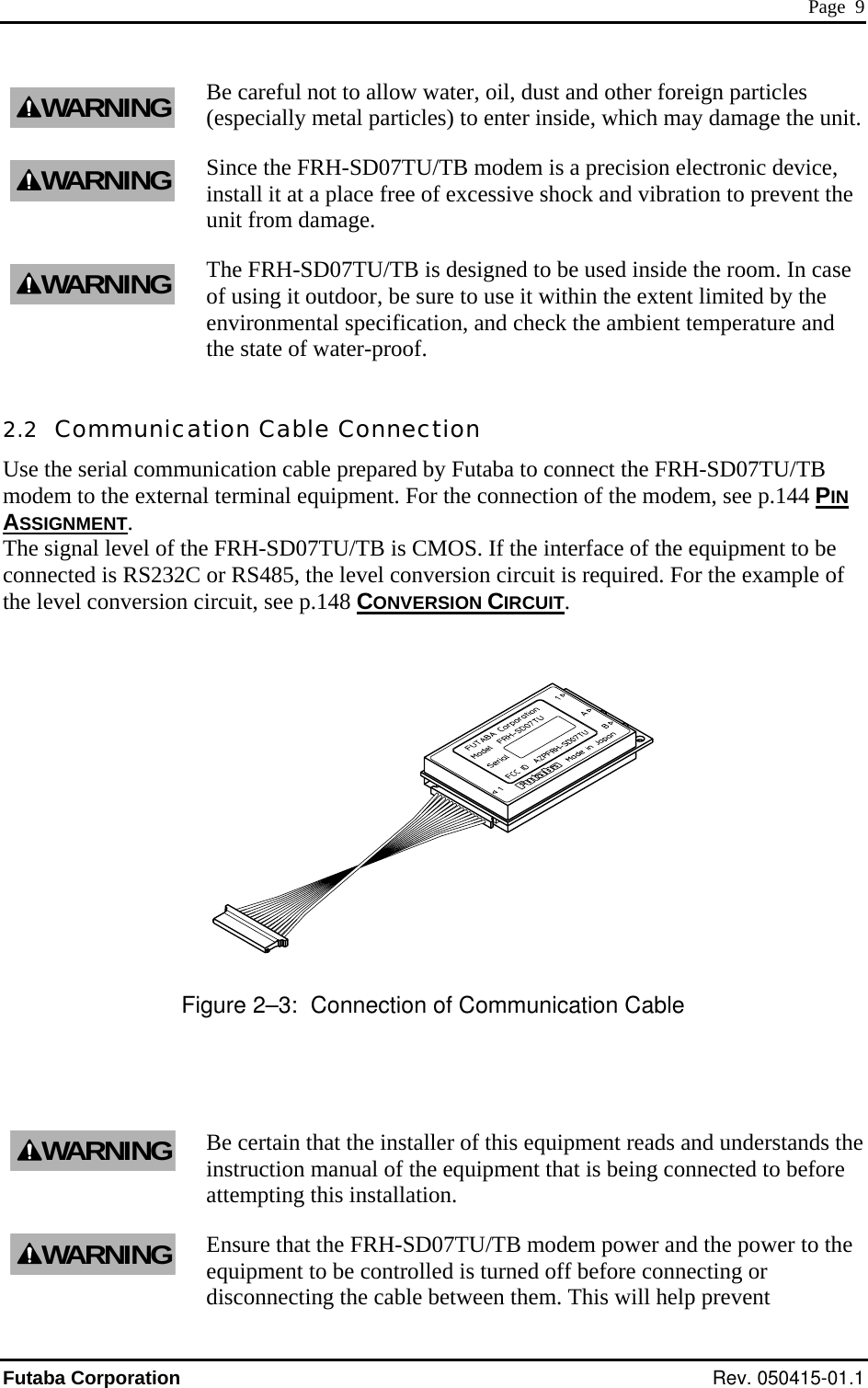
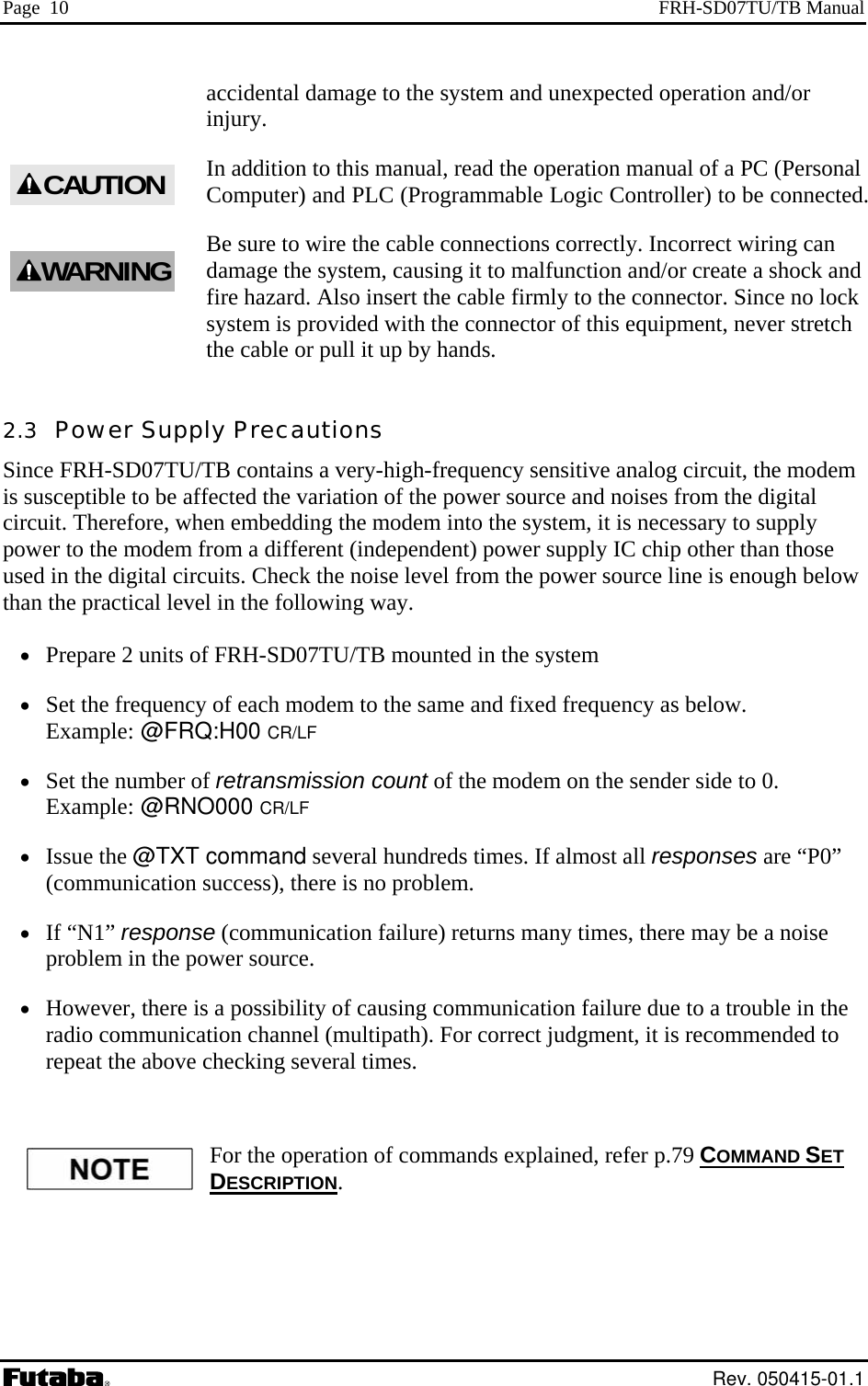
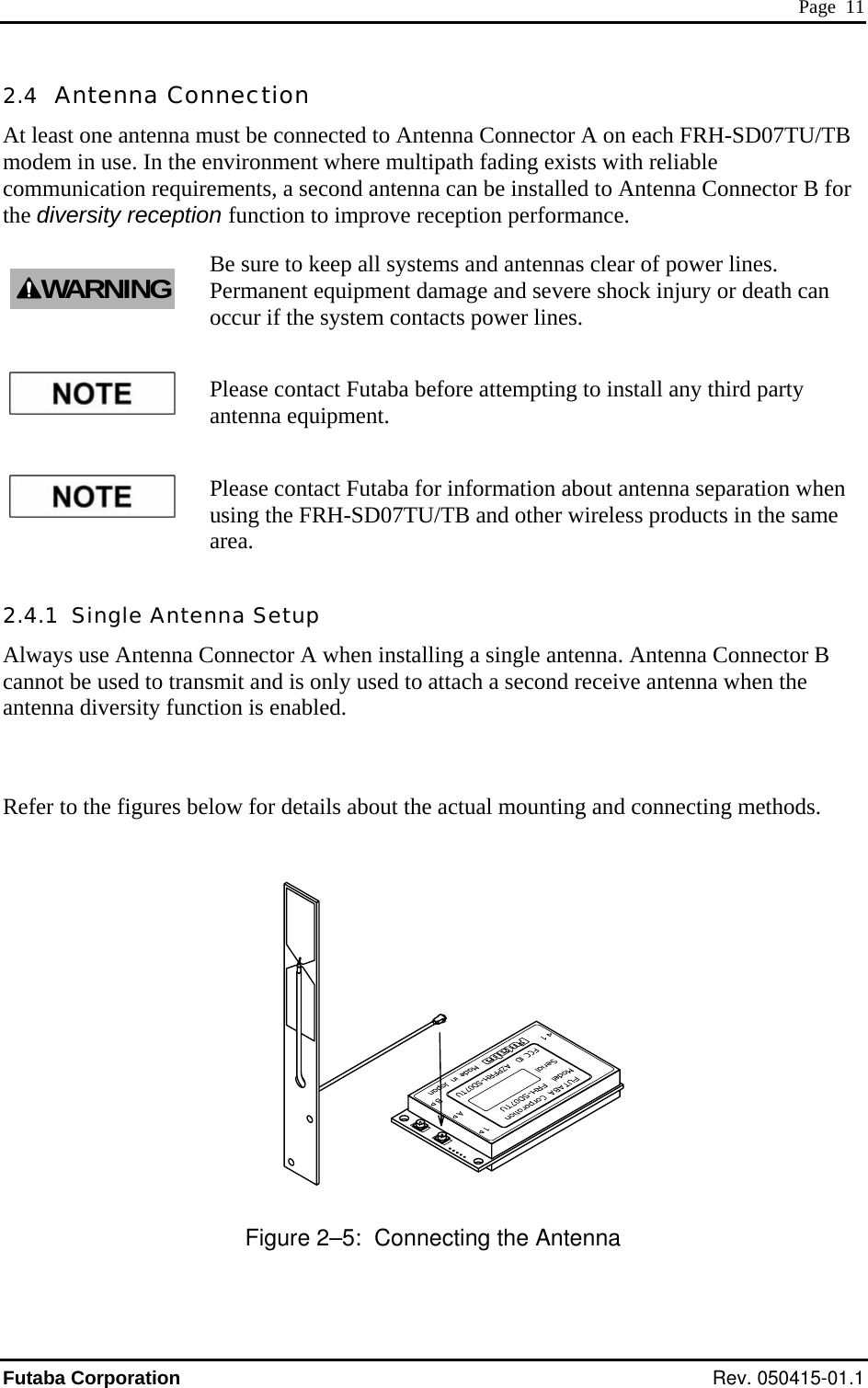
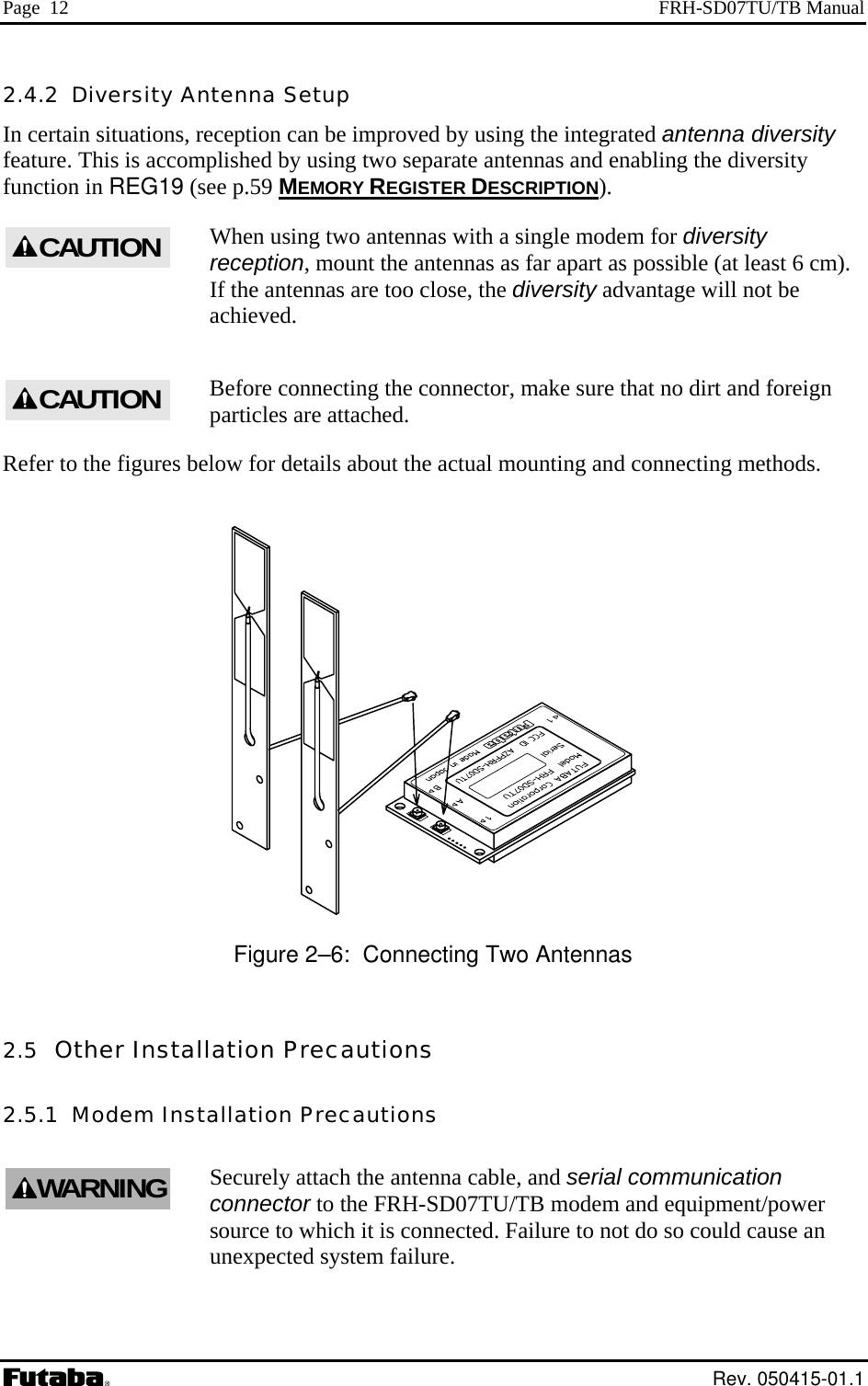
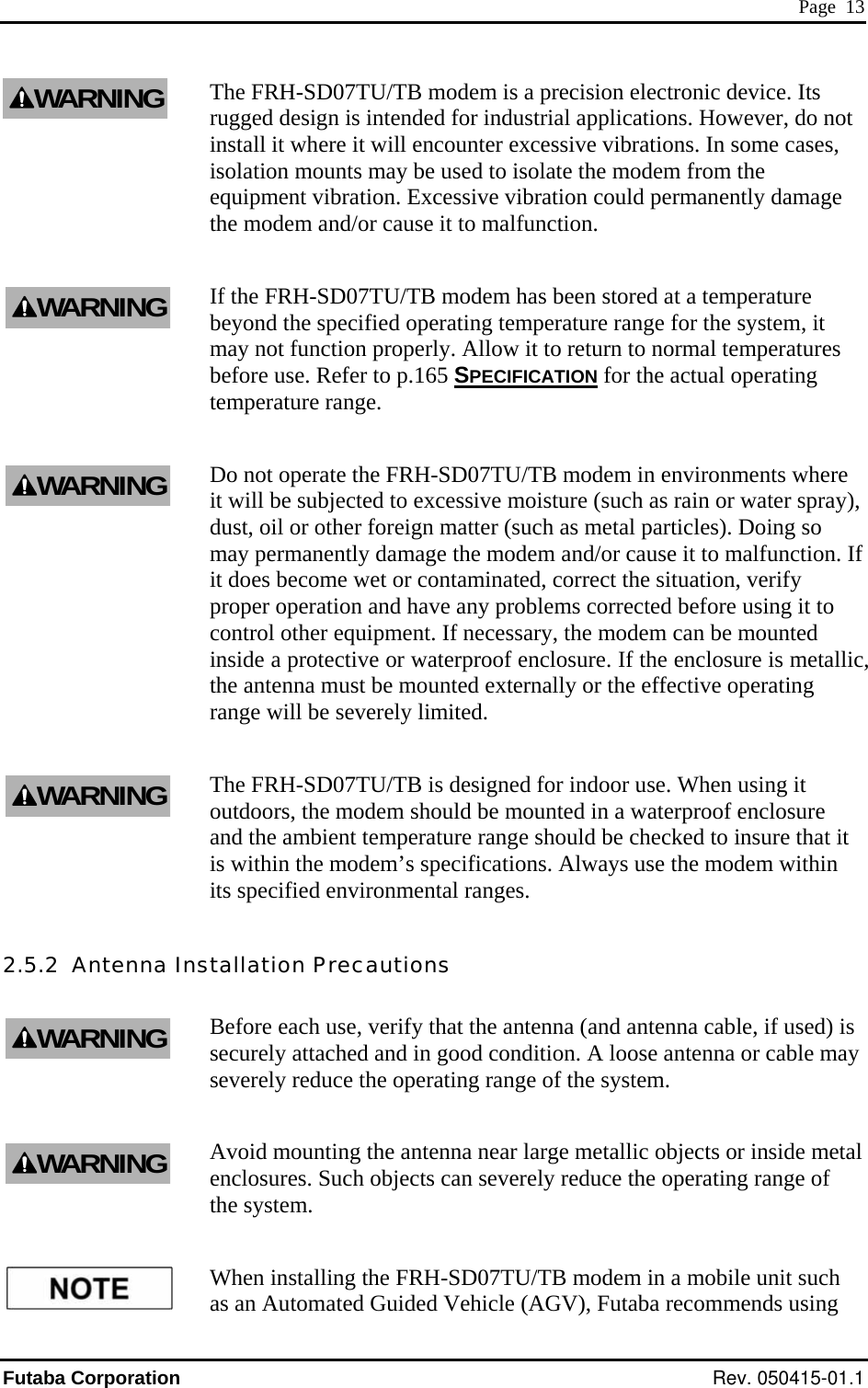
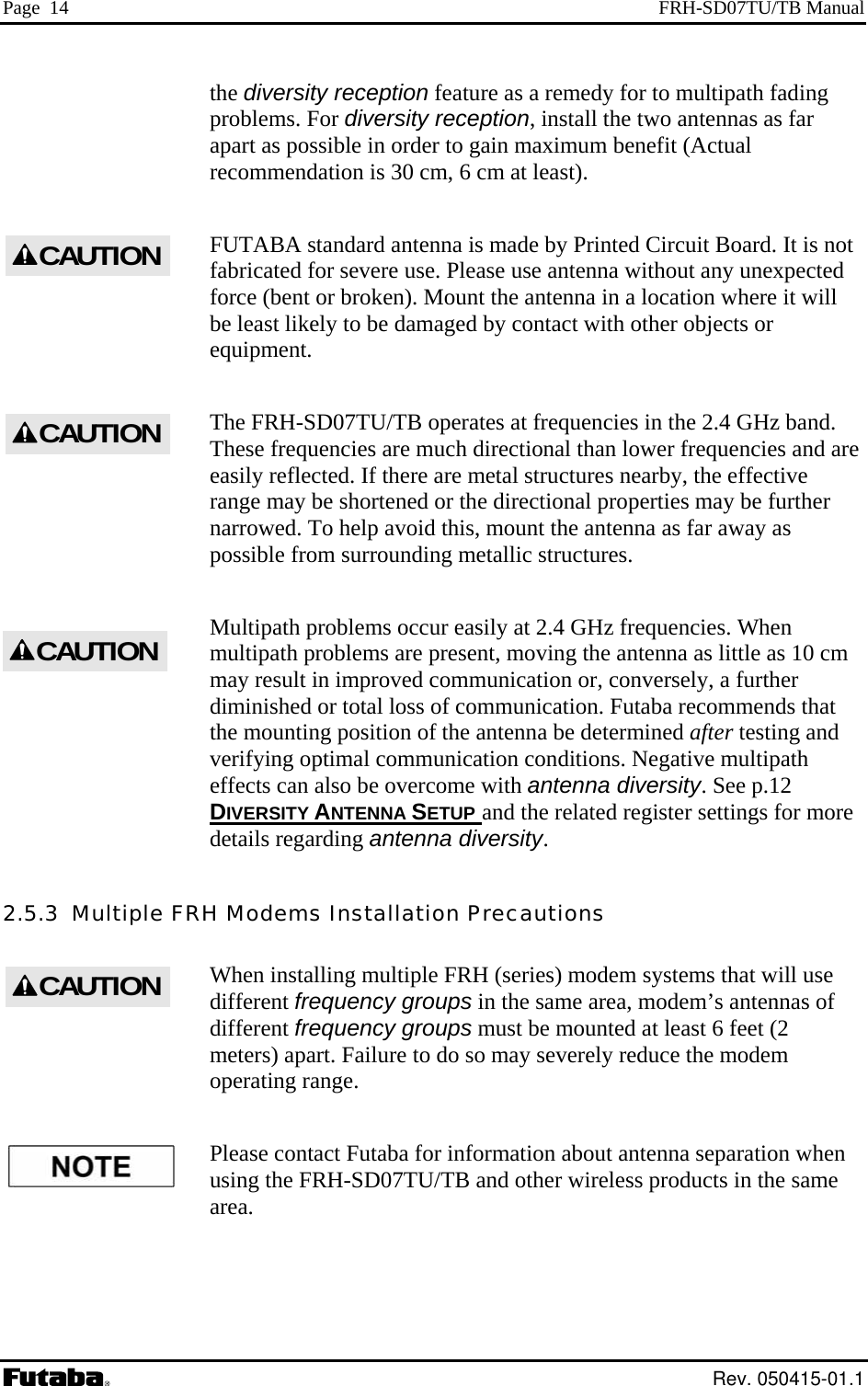
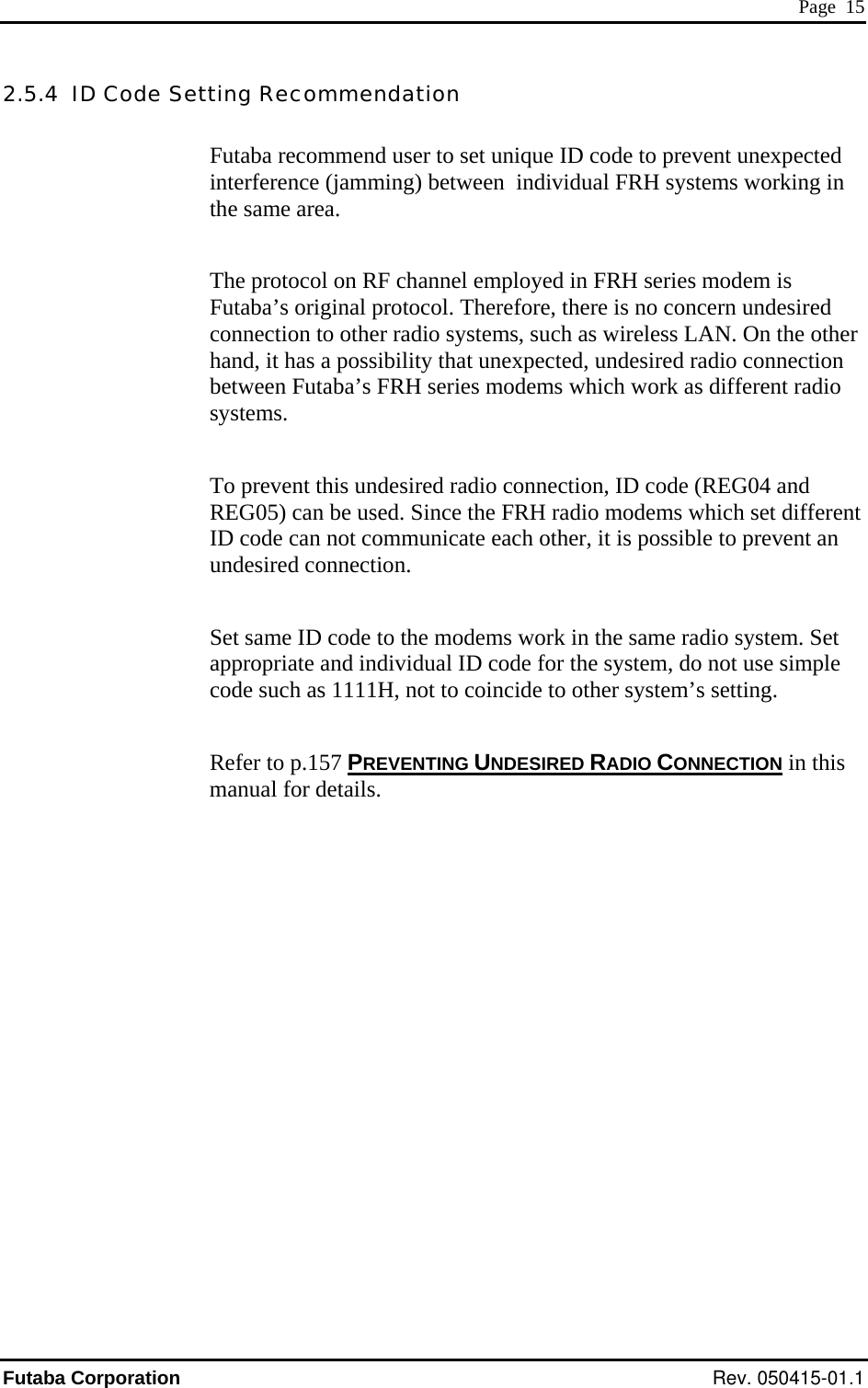
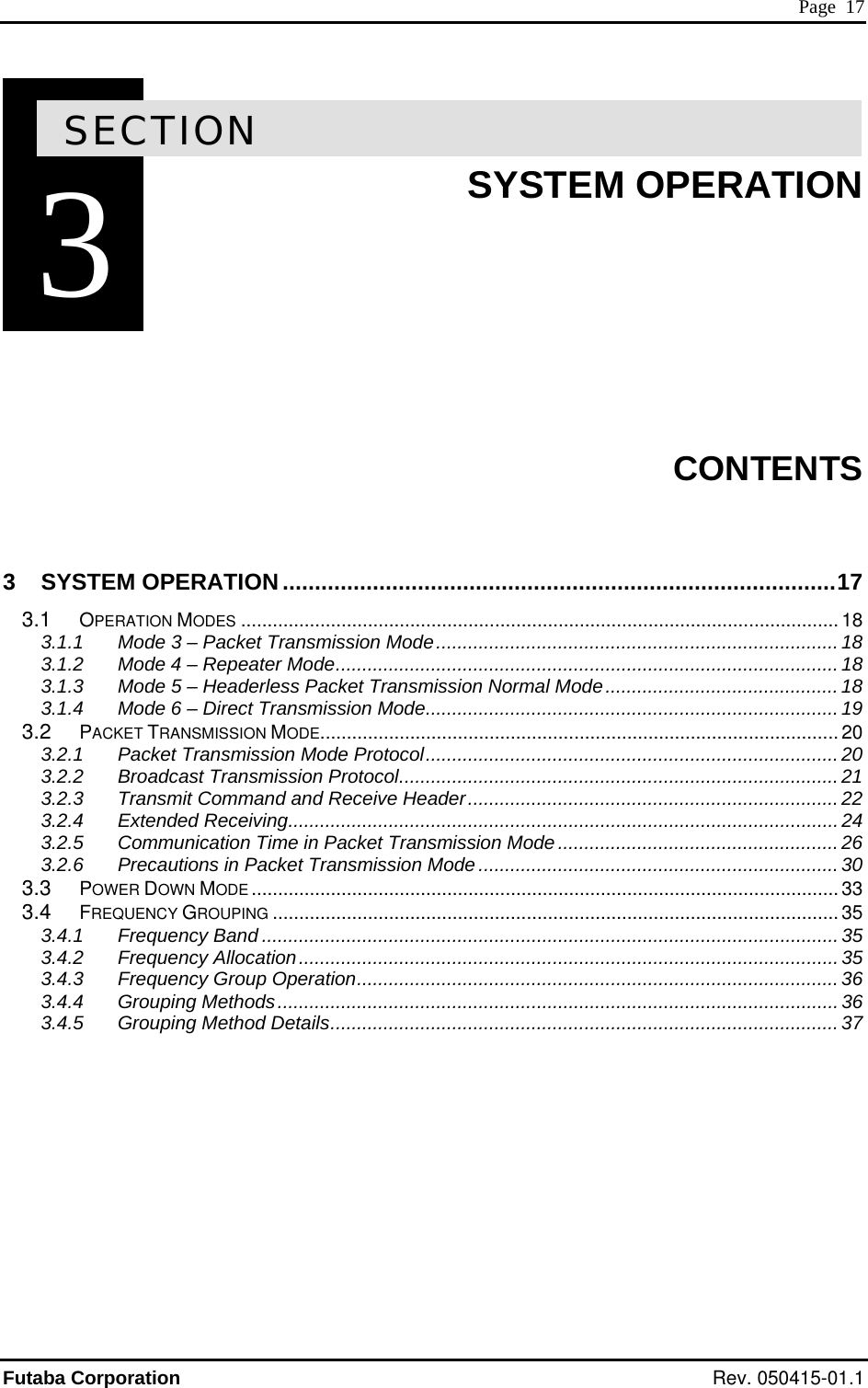
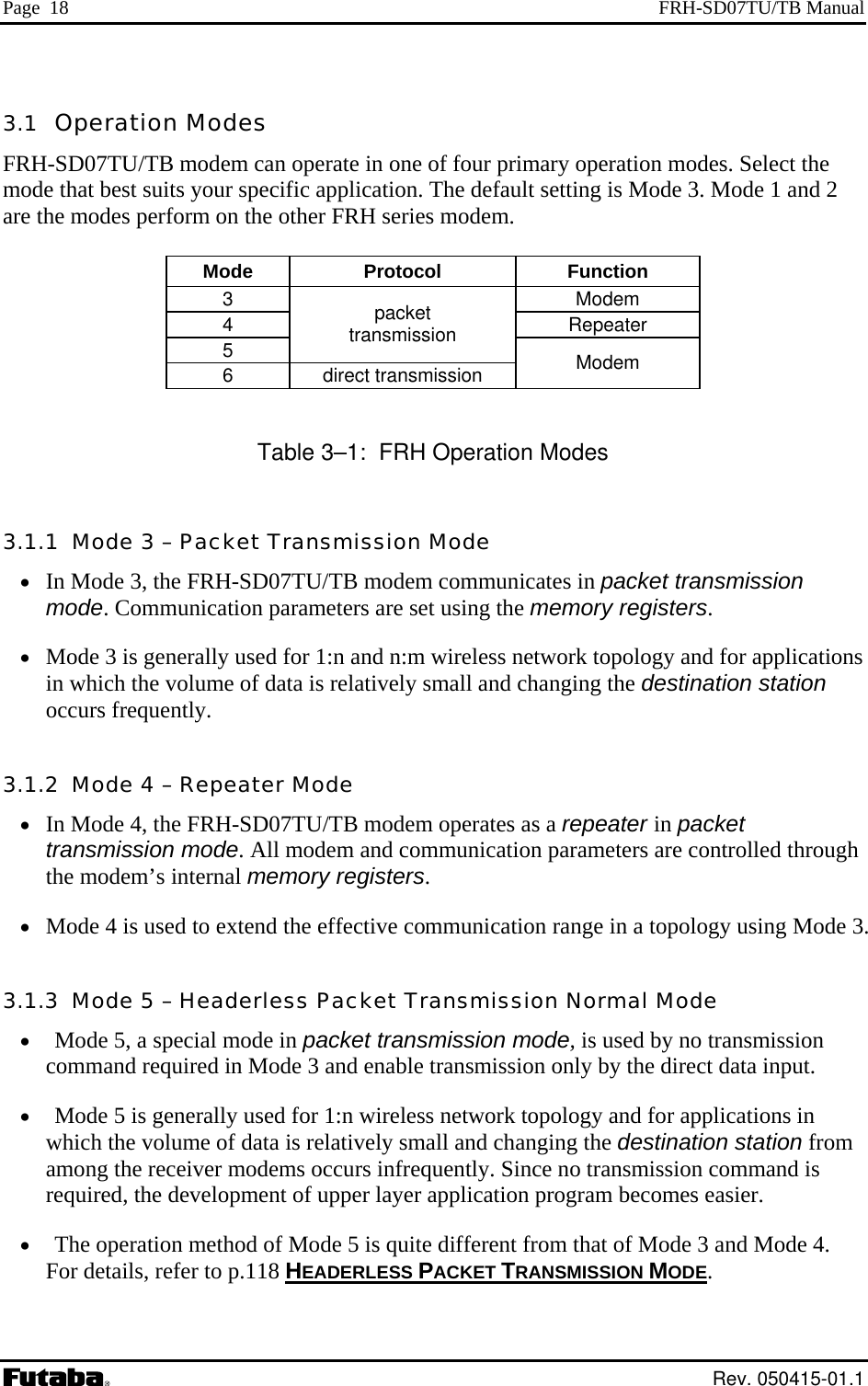
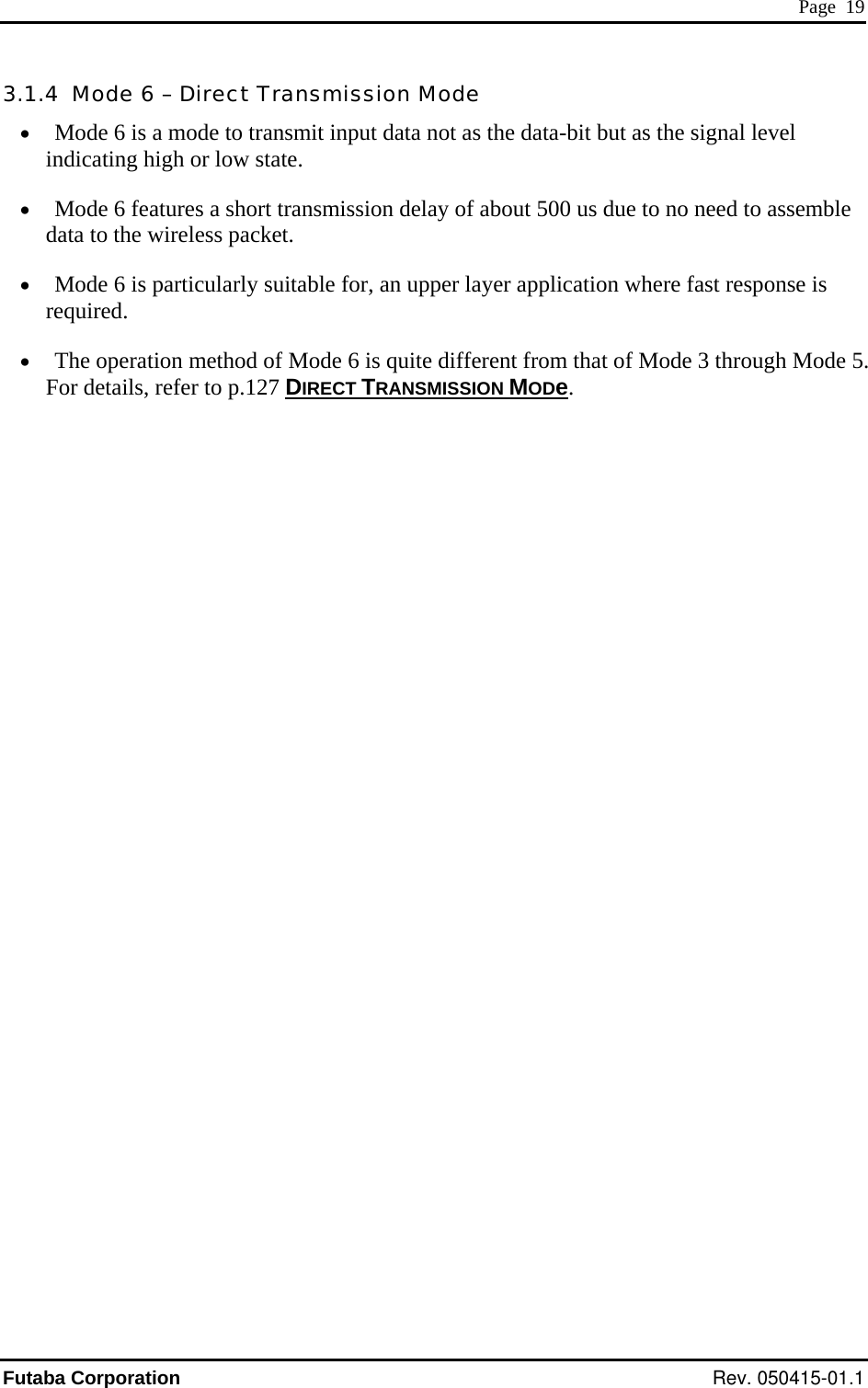
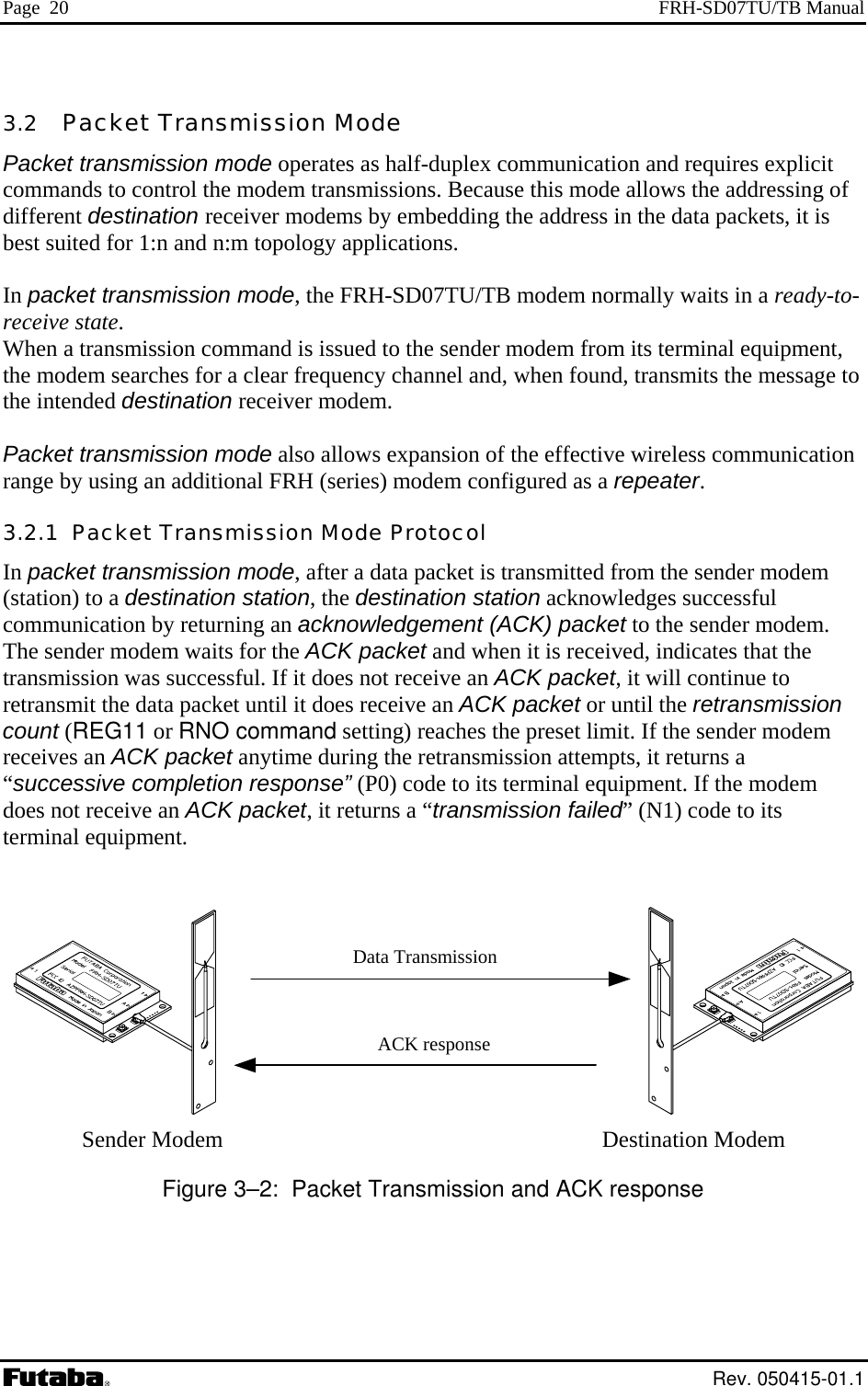
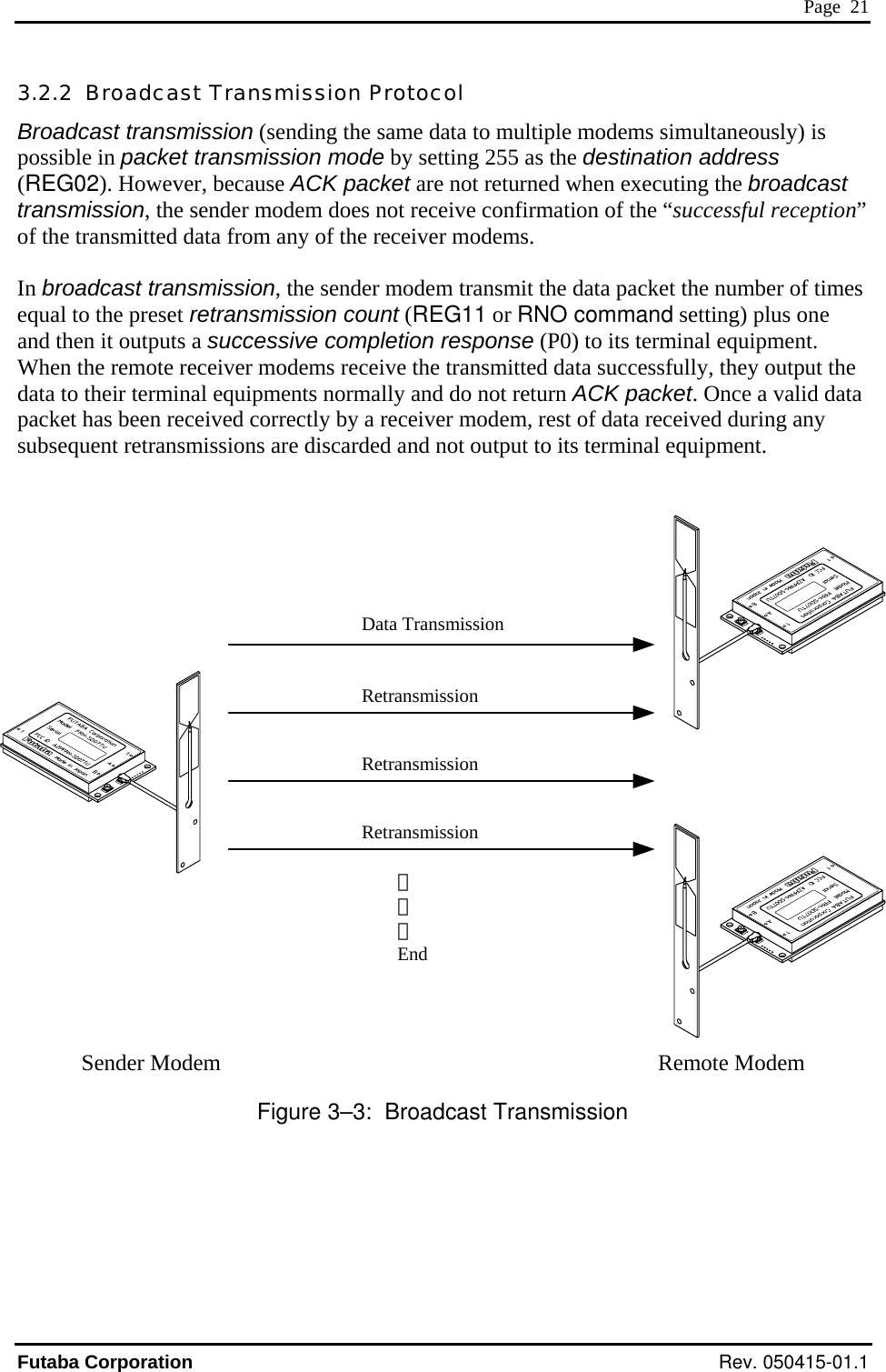
![Page 22 FRH-SD07TU/TB Manual 3.2.3 Transmit Command and Receive Header Four transmit commands can be used in packet transmission mode (mode 3). Both text and binary data can be sent directly from modem-to-modem or sent through a third FRH (series) modem configured as a repeater. The receiver modem automatically determines the transmitted data format and communication path from the information in the received packet header. Refer to the table below for a list of the transmit commands and the corresponding header component. Transmit Command Receive Header Function TXT RXT Text data transmission TBN RBN Binary data transmission TXR RXR Text data transmission via repeater TBR RBR Binary data transmission via repeater Table 3–5: Transmit Commands and Receive Headers The following list shows each command’s syntax as issued at the sender terminal equipment and the response displayed at the receiver terminal equipment when the packet is received. 1. Direct Text Data Transmission transmit: @TXT [destination address]{source address}[message] receive: RXT [source address][message] CR/LF 2. Direct Binary Data Transmission transmit: @TBN[destination address]{source address}[message length][message] CR/LF receive: RBN [source address][message length][message] CR/LF 3. Text Data Transmission through Repeater transmit: @TXR [repeater address][destination address]{source address} [message] CR/LF receive: RXR [repeater address][source address][message] CR/LF 4. Binary Data Transmission through Repeater transmit: @TBR [repeater address][destination address]{source address} [message length][message] CR/LF receive: RBR [repeater address][source address][message length][message] CR/LF where {source address} is optional, used in RS485 mode set by serial communication cable 12 pin. The following list defines the parameters and symbols used in the commands above: @ = command header CR/LF = carriage return + line feed destination address = address of modem to receive the message (000 to 239) Rev. 050415-01.1](https://usermanual.wiki/Futaba/FRH-SD07TU.User-Manual/User-Guide-535573-Page-38.png)
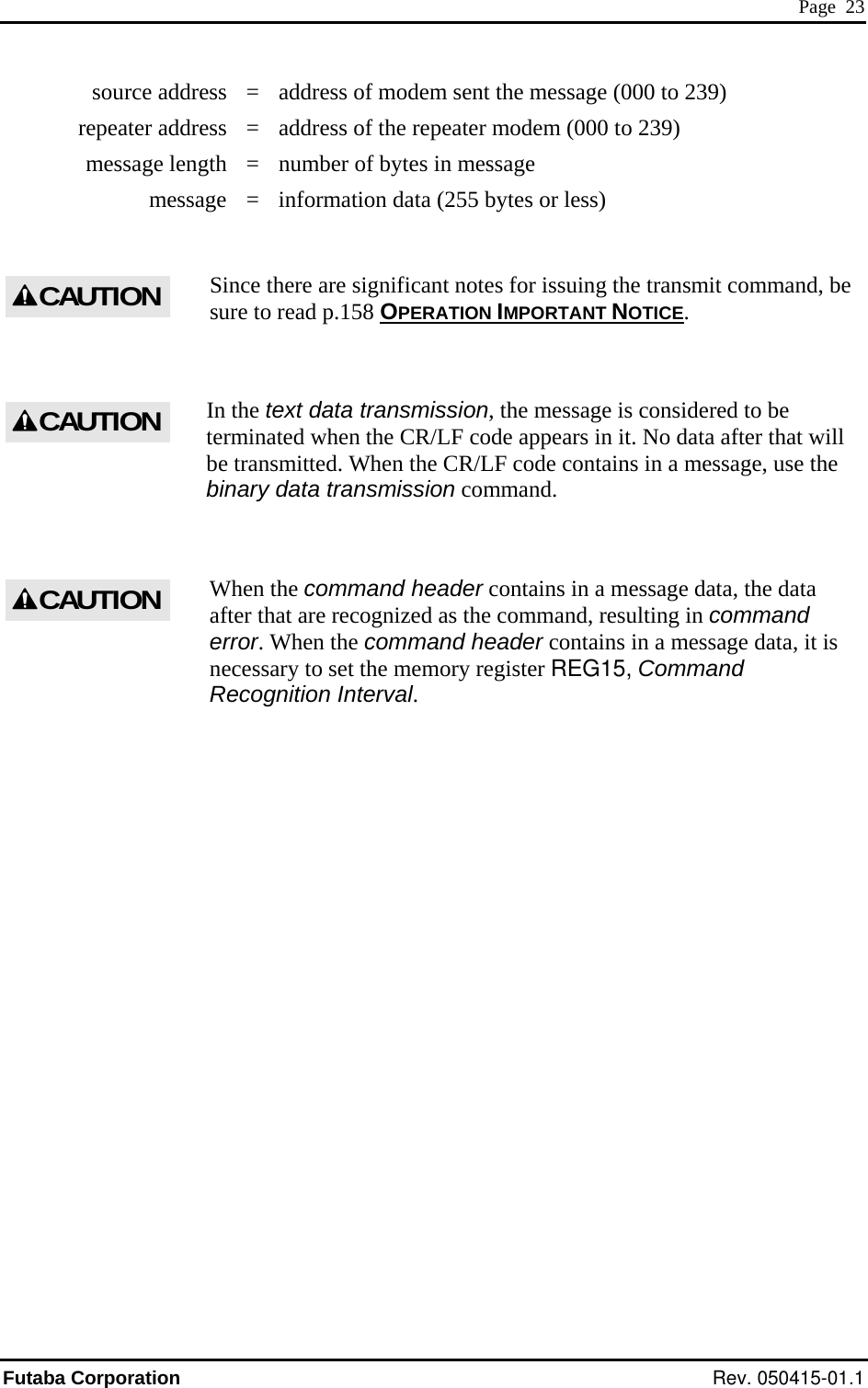
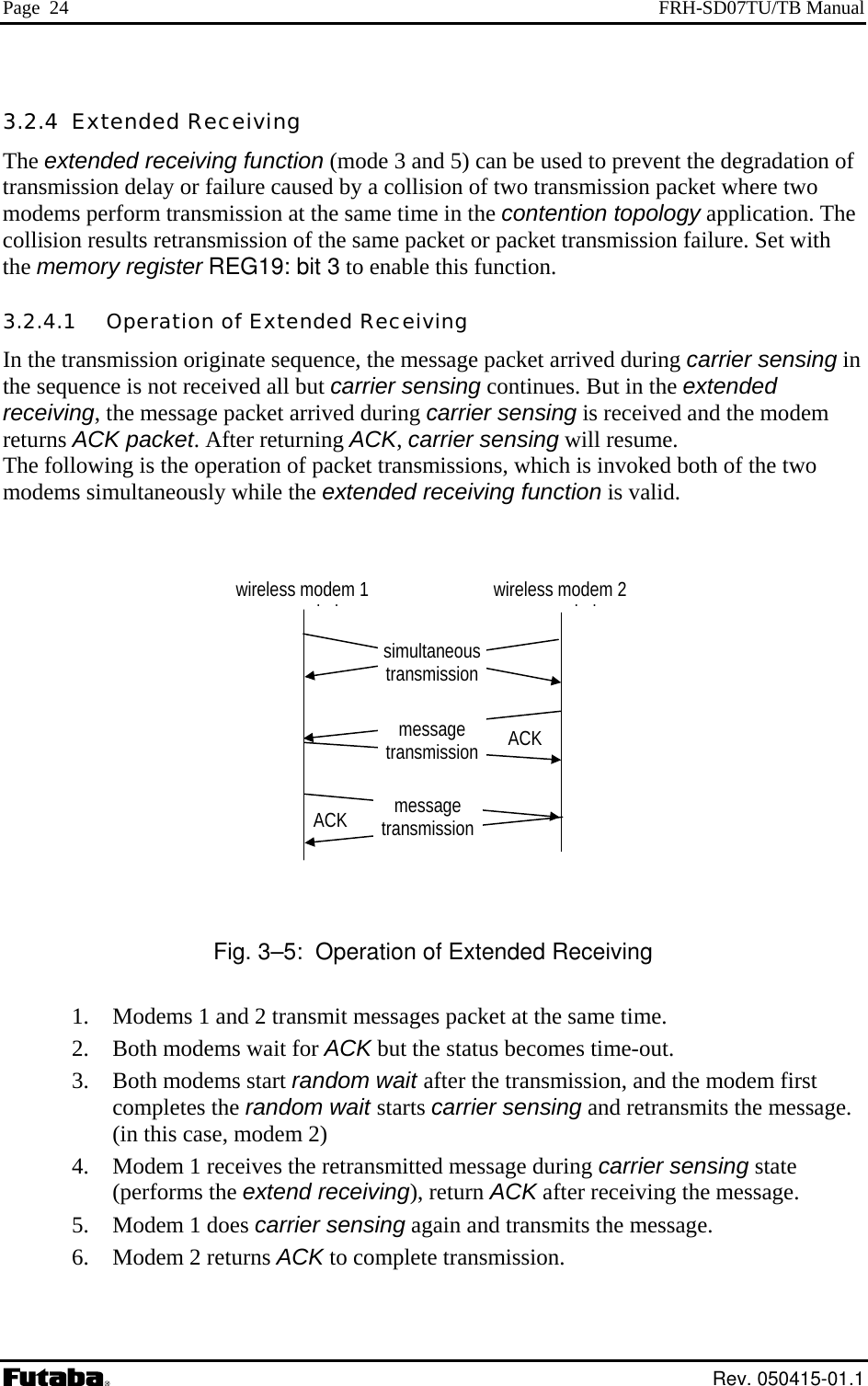
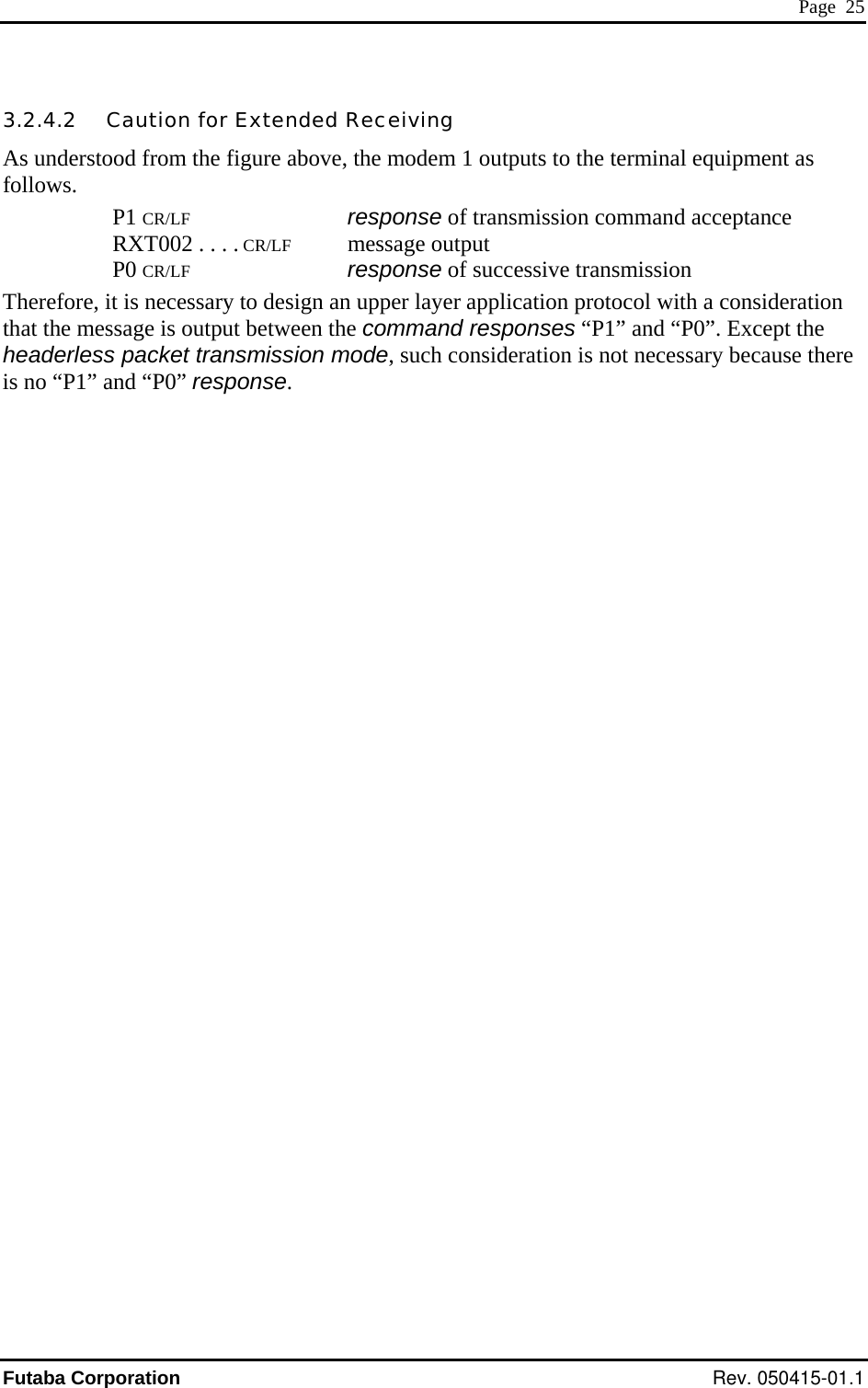
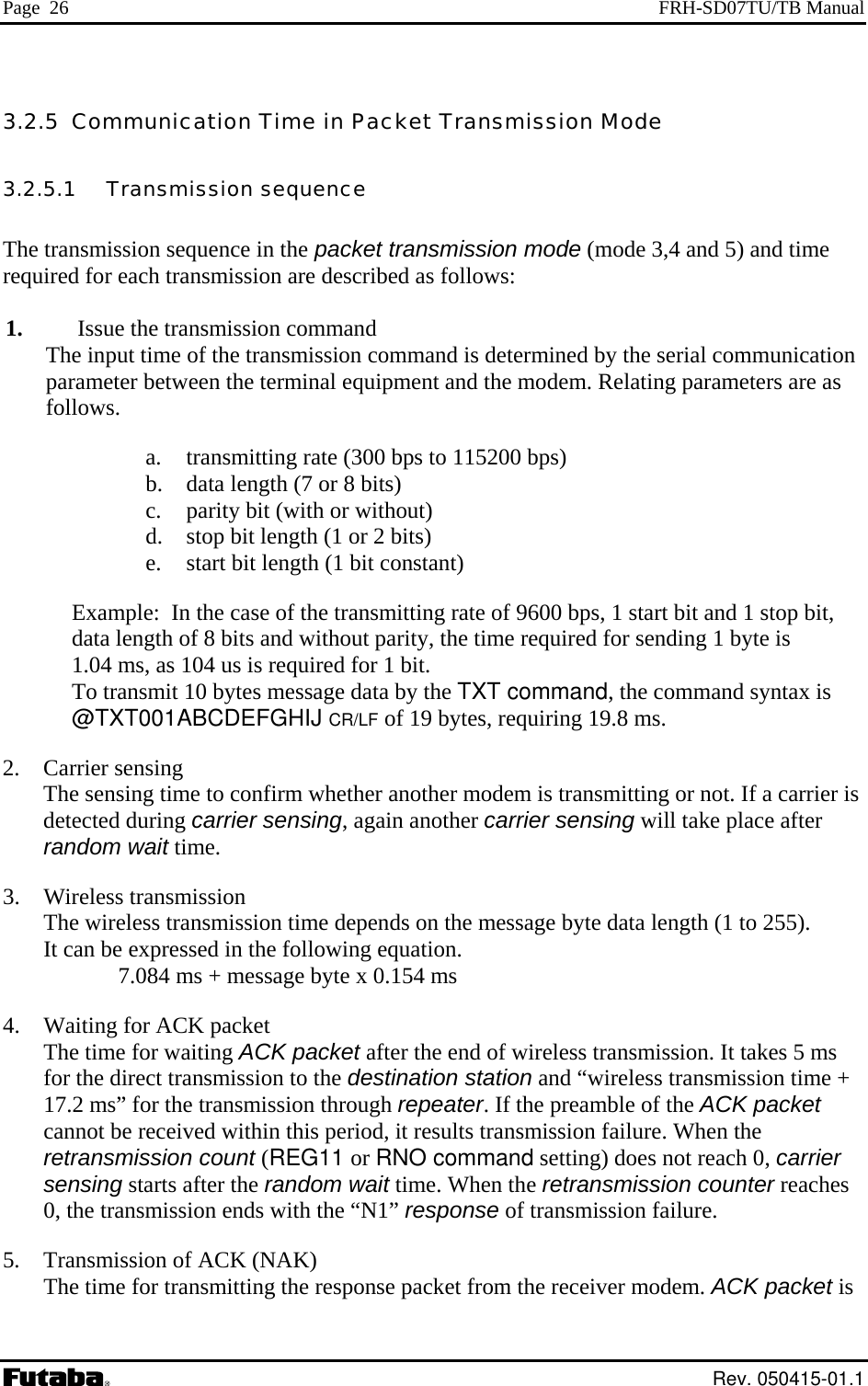
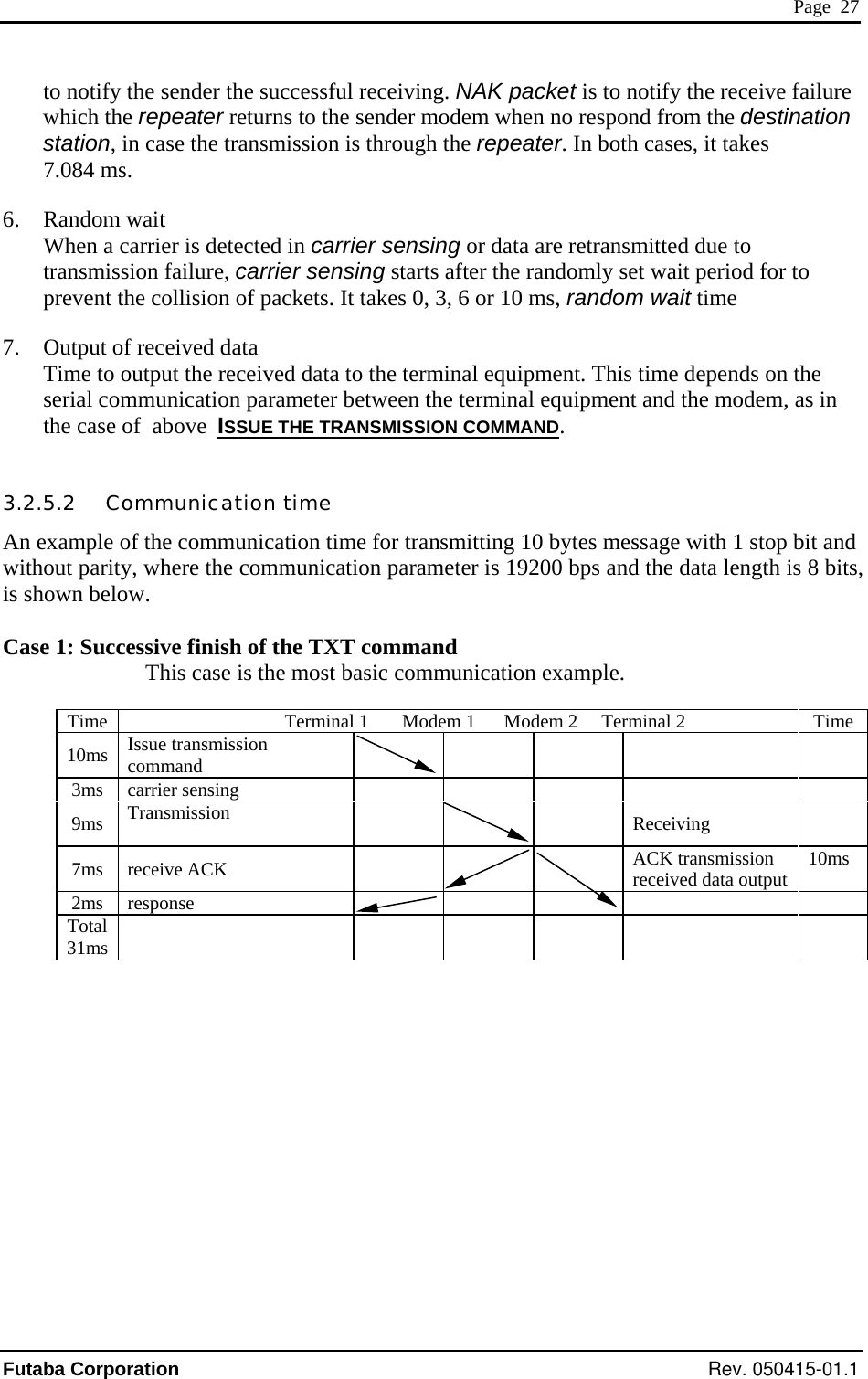
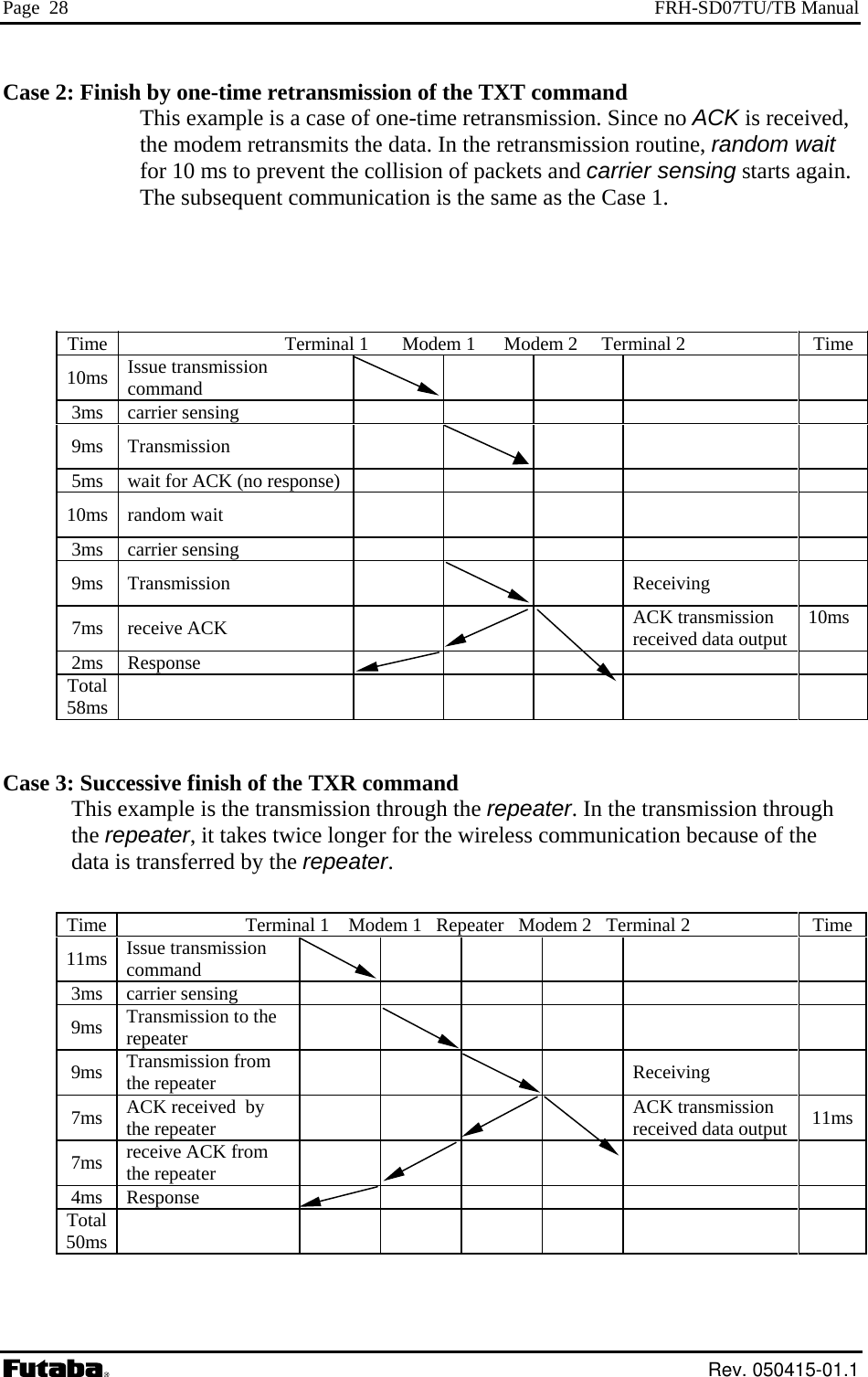
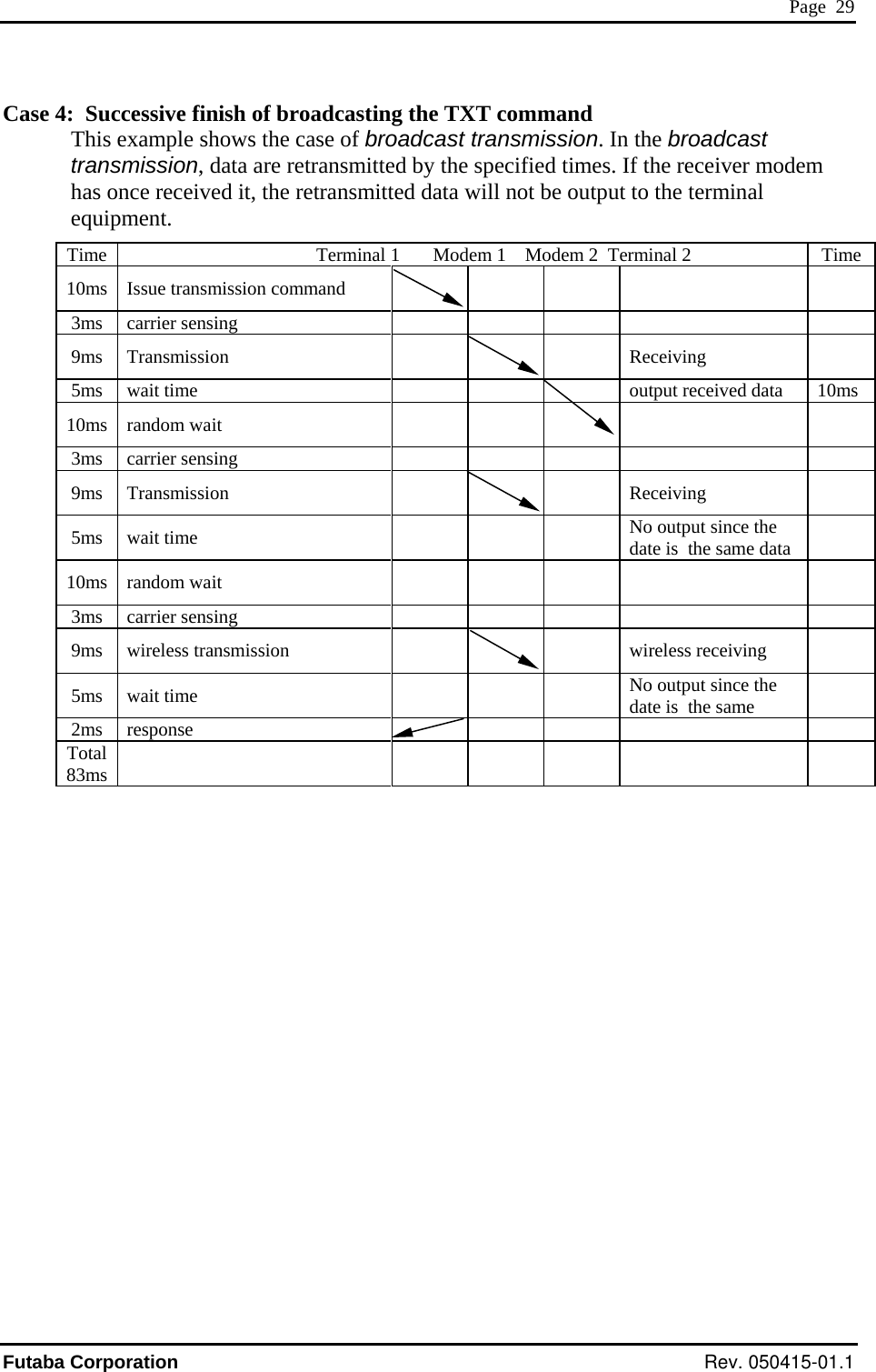
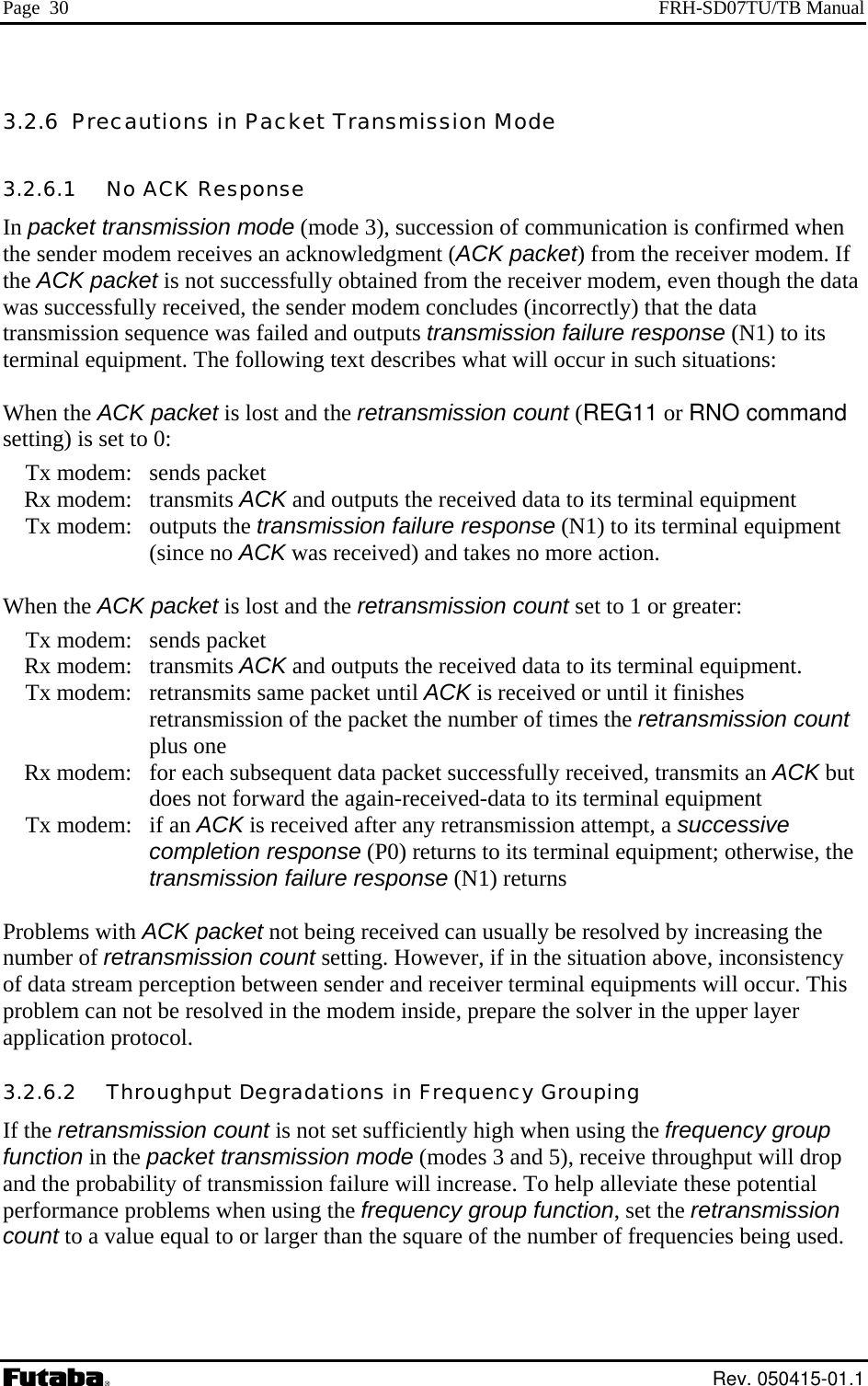
![Page 31 Receive throughput will drop since the frequency between the sender modem and receiver modem is not identical in some case (because multiple frequencies are used). When using the frequency group function, receiver modems are in the ready-to-receive state and is sequentially changing frequencies. A sender modem, that has data to be transmitted, also transmits its packet sequentially with changing frequencies until it receives ACK from the receiver modem or until it reaches the retransmission count plus one. Because the receiving modem changes frequencies at a slower rate than the transmitting modem, the both frequency channels will eventually align. And the data packet will be successfully transmitted. To make frequency alignment in both mode, the retransmission count should be set high enough. But sometimes, it takes a time to make this alignment. The use of the frequency group function is effective when specific frequencies are interfered, but will result a degradation of data throughput. Accordingly, it is recommended to use the fixed frequency mode for applications that require high data throughput in the packet transmission mode. (In this case, the communication may be susceptible to interference or multipath fading) 3.2.6.3 Collision Avoidance in RS485 Interface When multiple modems are connected on RS485 wire-line, the received data or the command responses of the modem may collide on the line. Reasons of such collision are that multi-dropped multiple modems receive packet at the same time and output to RS485 line, or, multiple modems accept global addressing command and output its response at the same time. When there is a possibility of the RS485 line collision, avoid it by taking following remedy. 1) Set each of the multi-dropped modem’s Interval between packets (REG07) value to different value. Difference between each set value shall be larger than 1 byte transmission duration (from the start bit to the stop bit) which determined by the RS485 line baud rate. 2) Set the Collision avoidance function (REG23:bit 1) of all modems to 1. 3) Set Regular interval output for RS485 collision avoidance (REG23:bit 2) to 1 of the modem which Interval between RS485 packets (REG07) is set to the longest The above remedy is set to the multiple modems that are multi-dropped, the modem which set REG07 interval to the longest outputs regularly CR code [0DH] when all modem has no data to output. This enables timing synchronization of all of the modems to start measuring the interval time between RS485 data packets to packet. This results that data will not be output from multiple modems at the same time since the interval between RS485 packets (REG07) of each modem is set to different values. Also the modem can detects another station’s RS485 data transmission status since the interval difference is set more than 1 byte time. Eventually, this can avoid collision on the RS485 line since the modem can wait for their turn to output RS485 data. Futaba Corporation Rev. 050415-01.1](https://usermanual.wiki/Futaba/FRH-SD07TU.User-Manual/User-Guide-535573-Page-47.png)
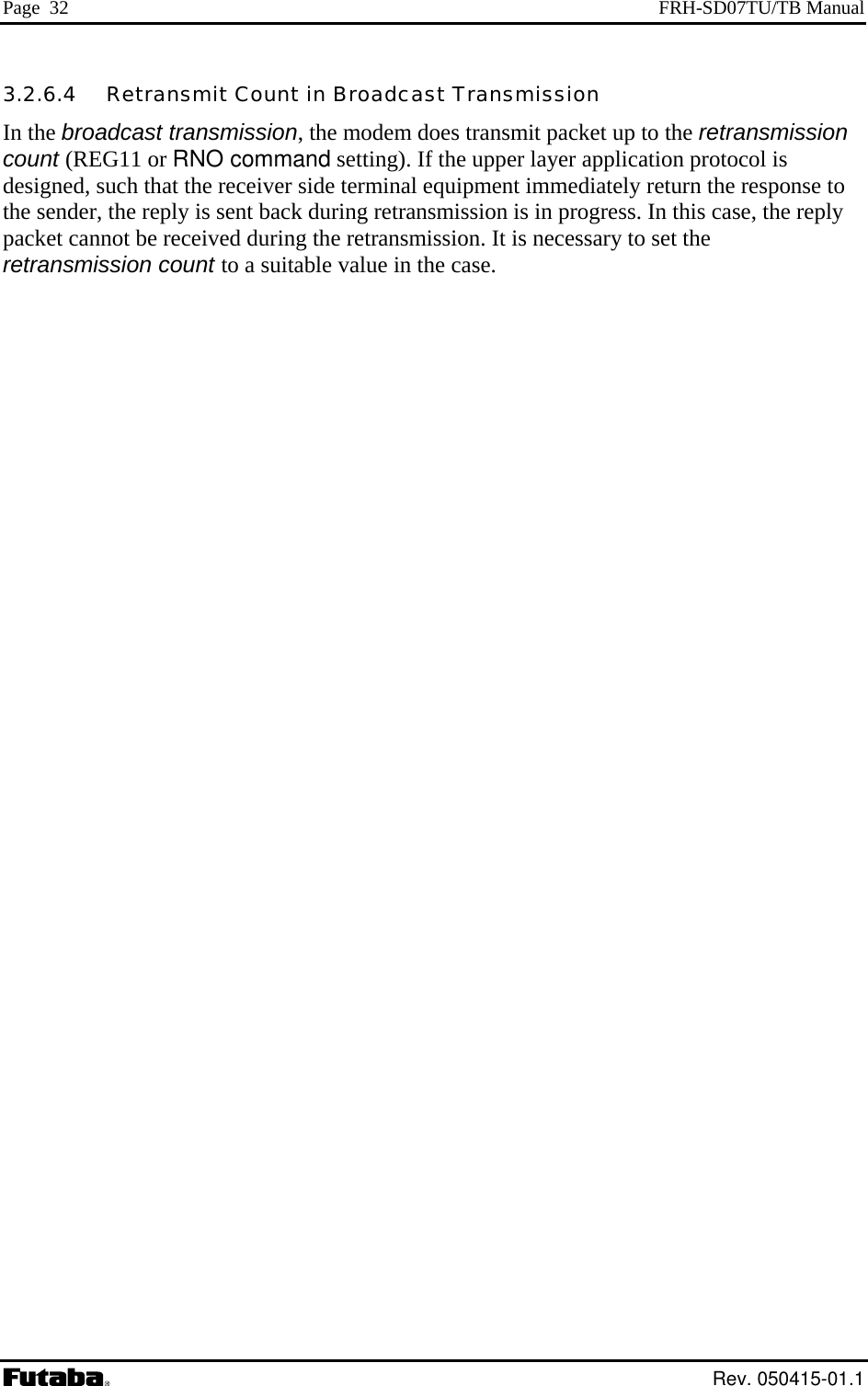
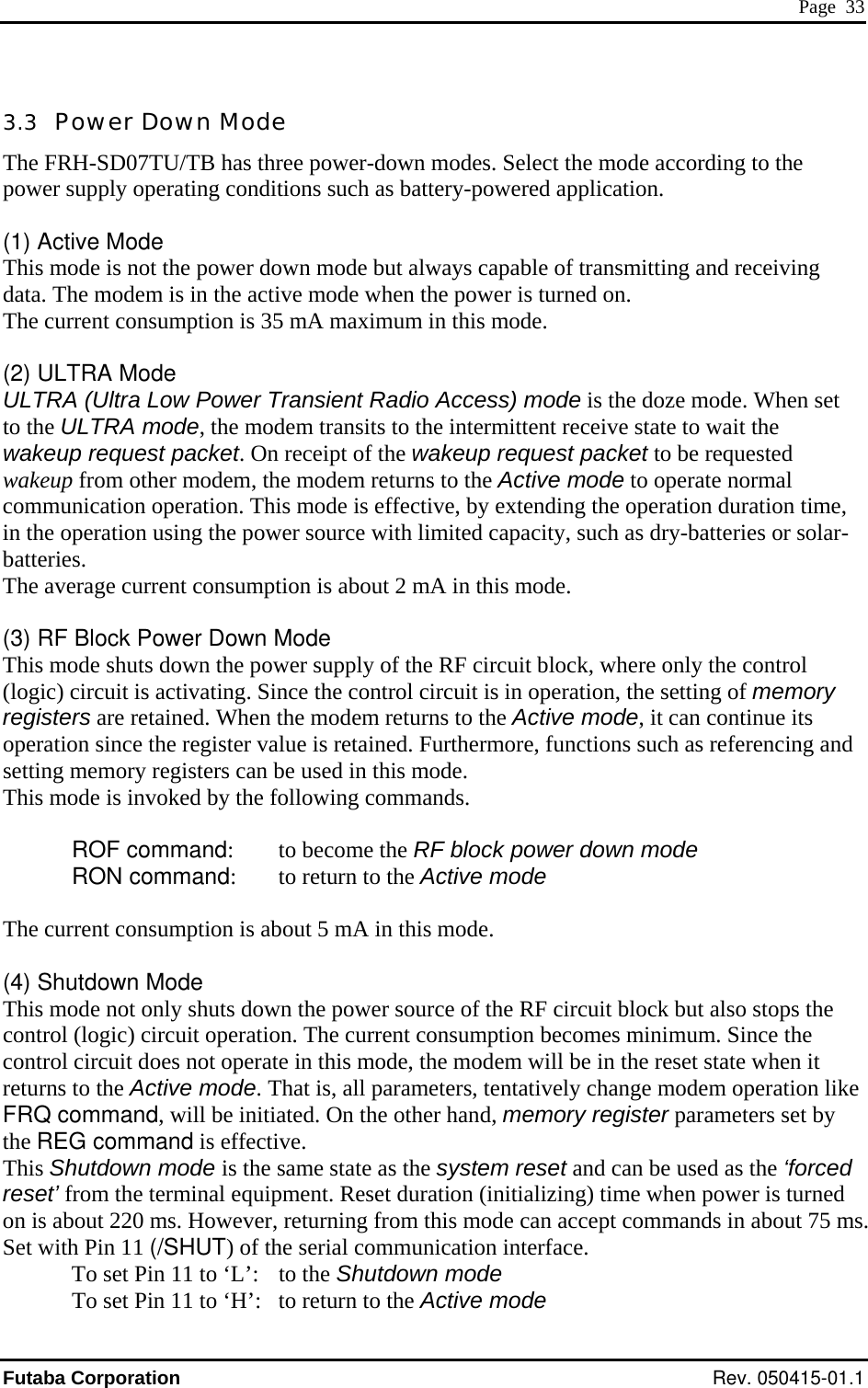
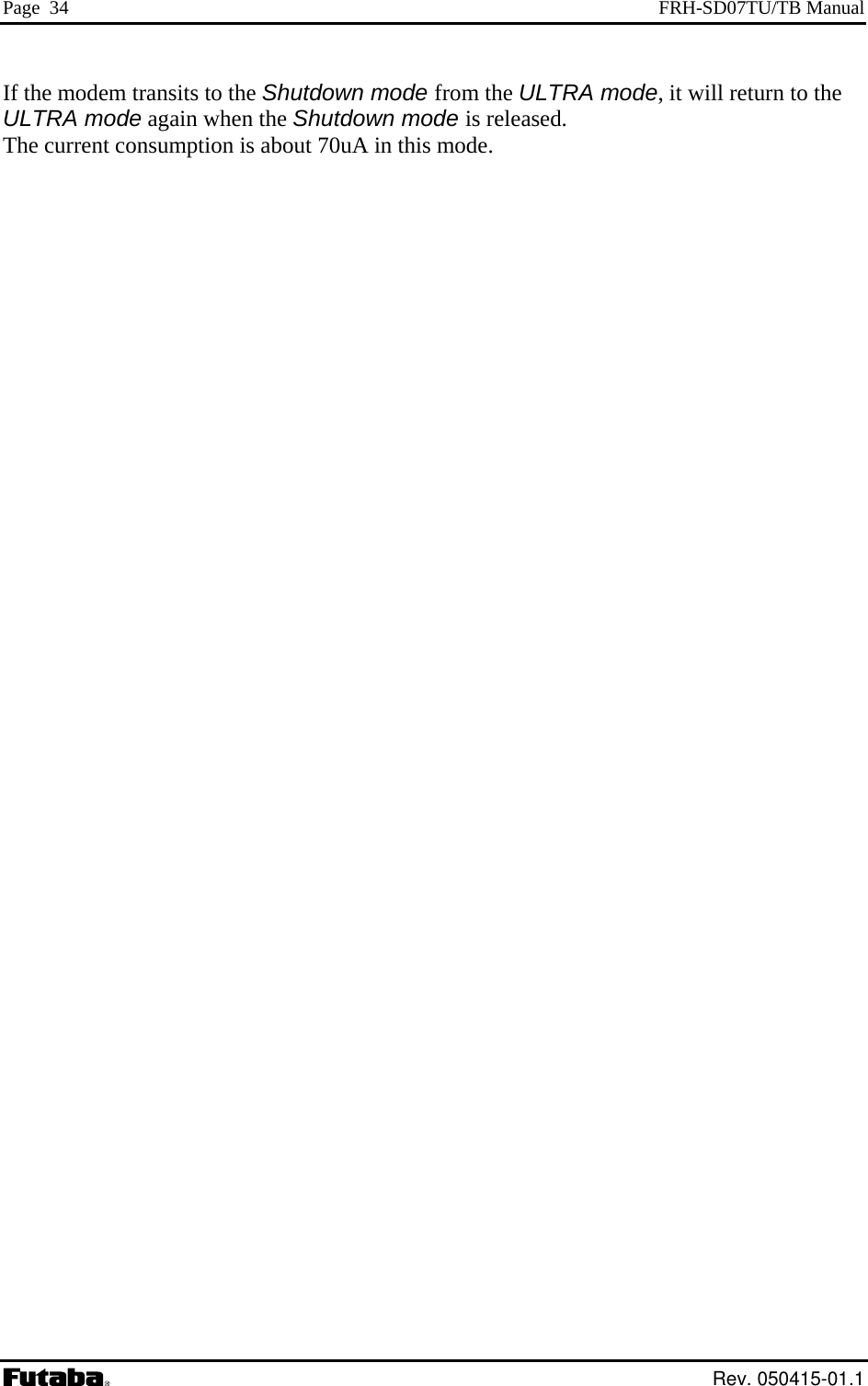
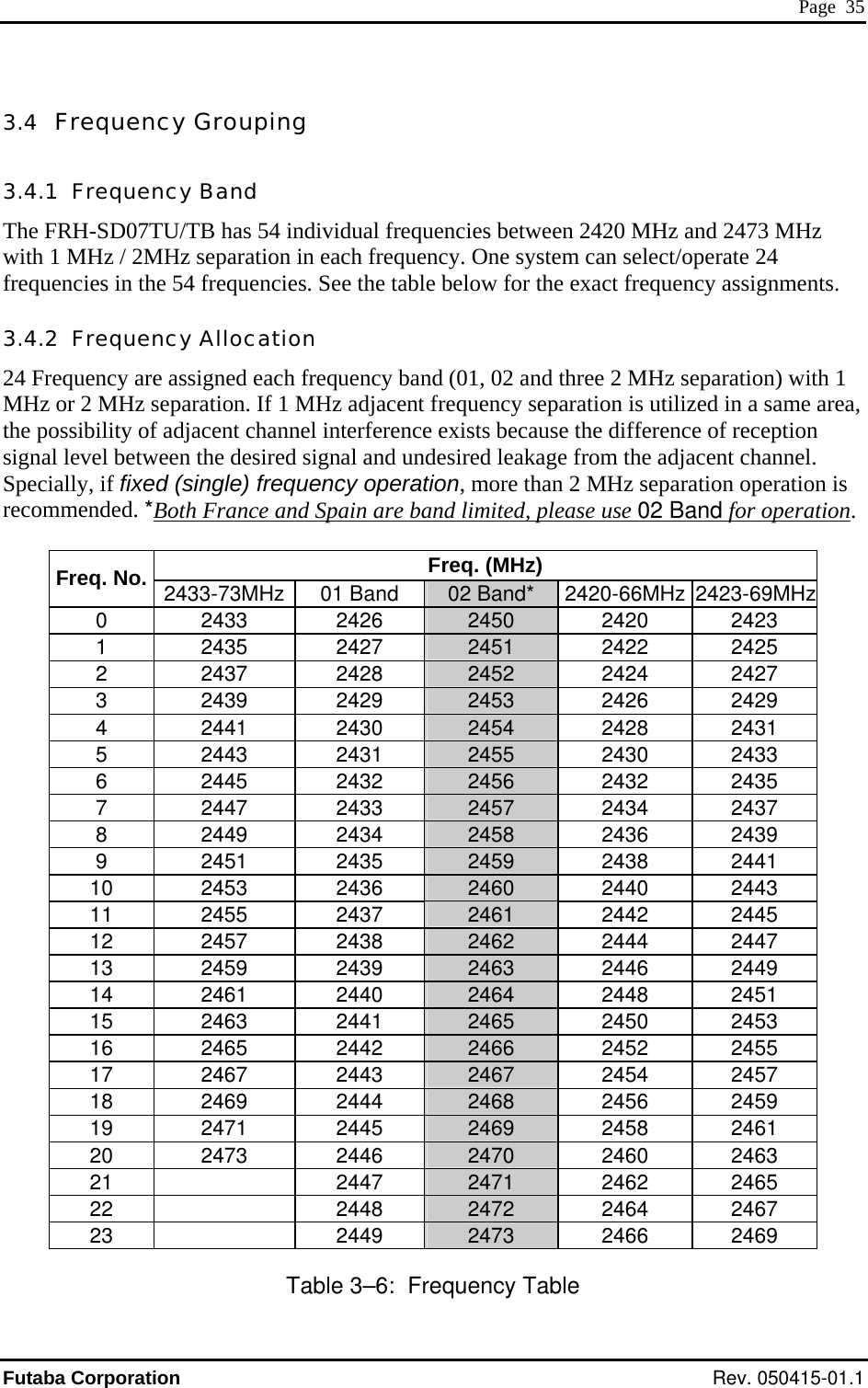
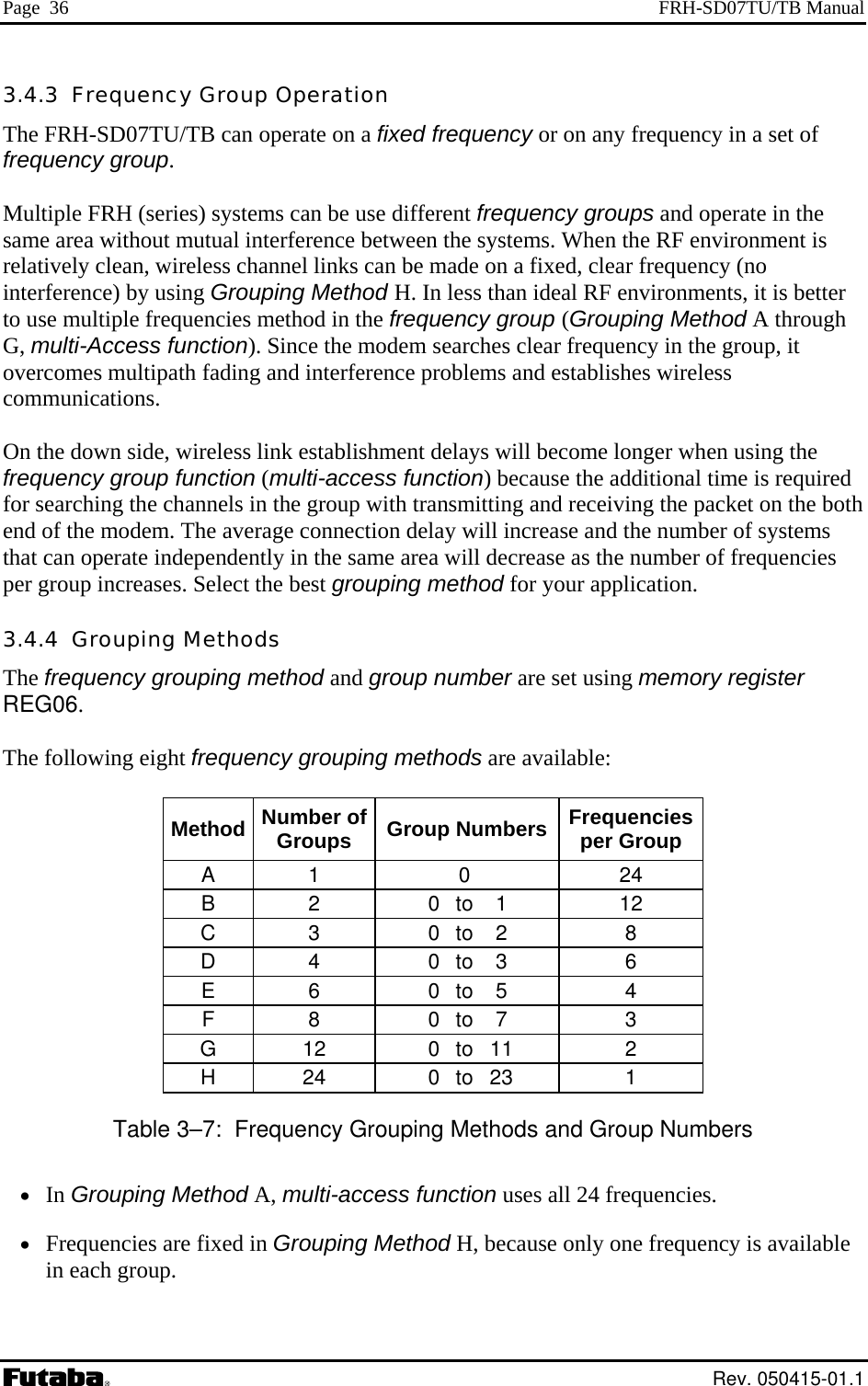
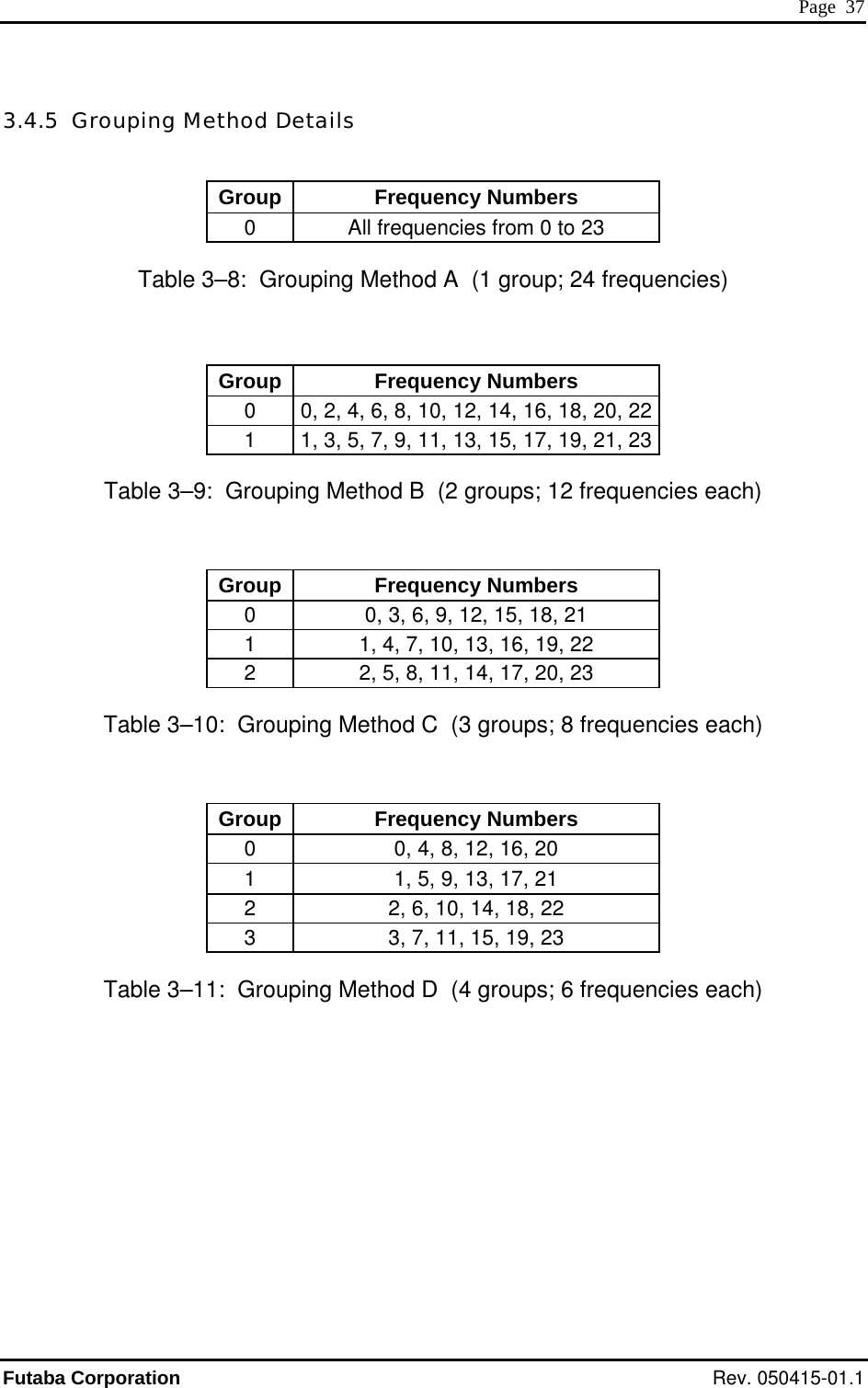
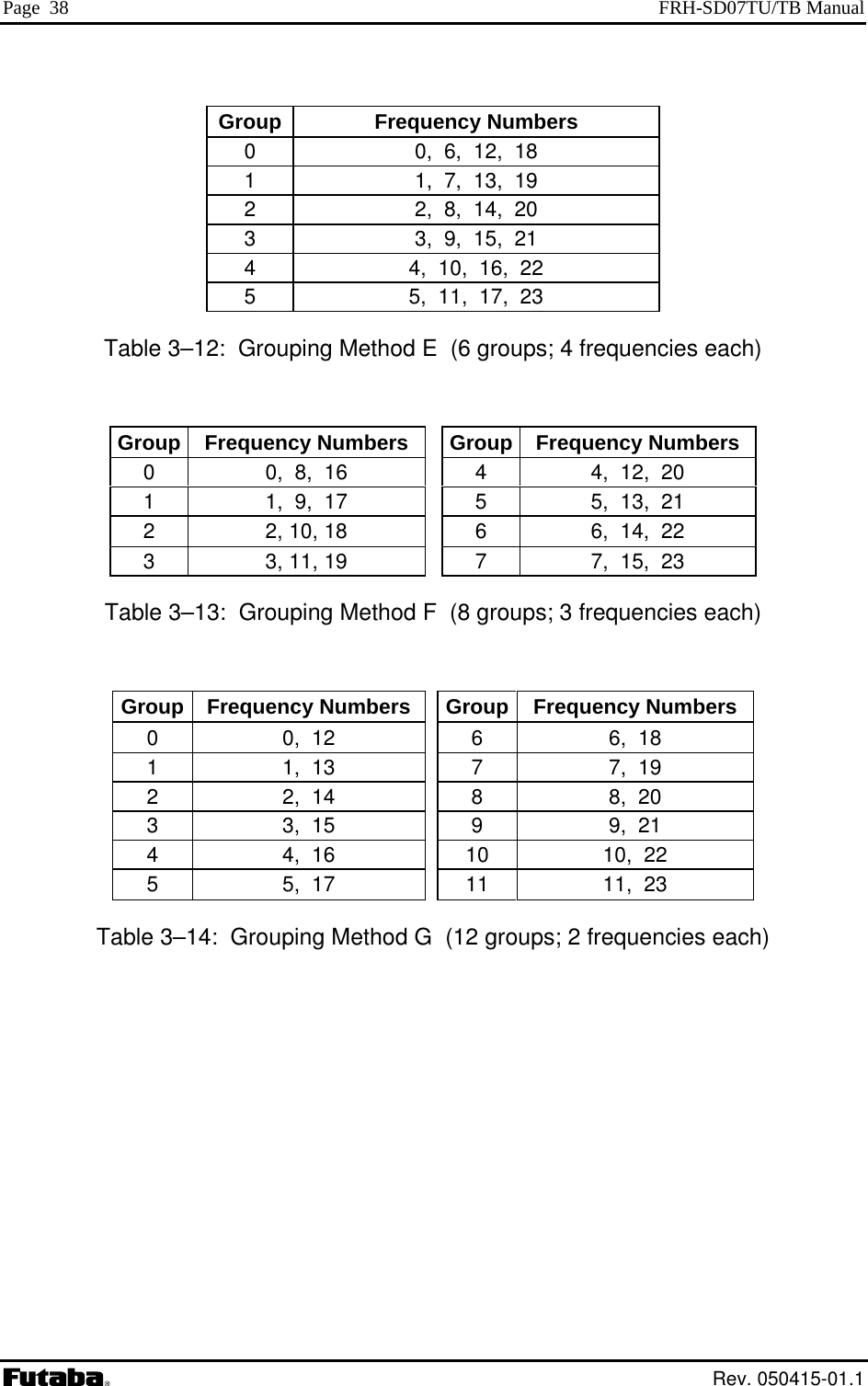
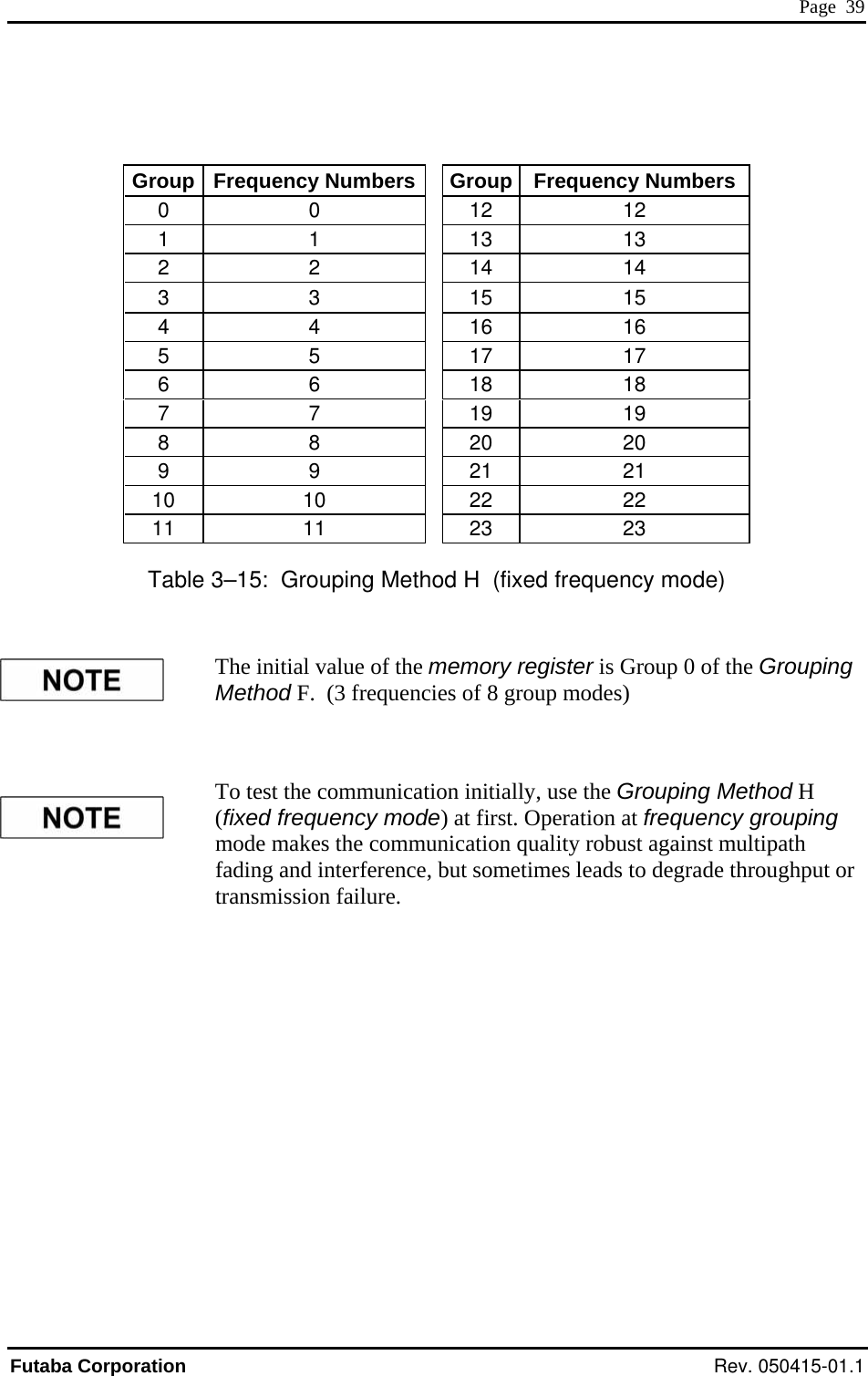
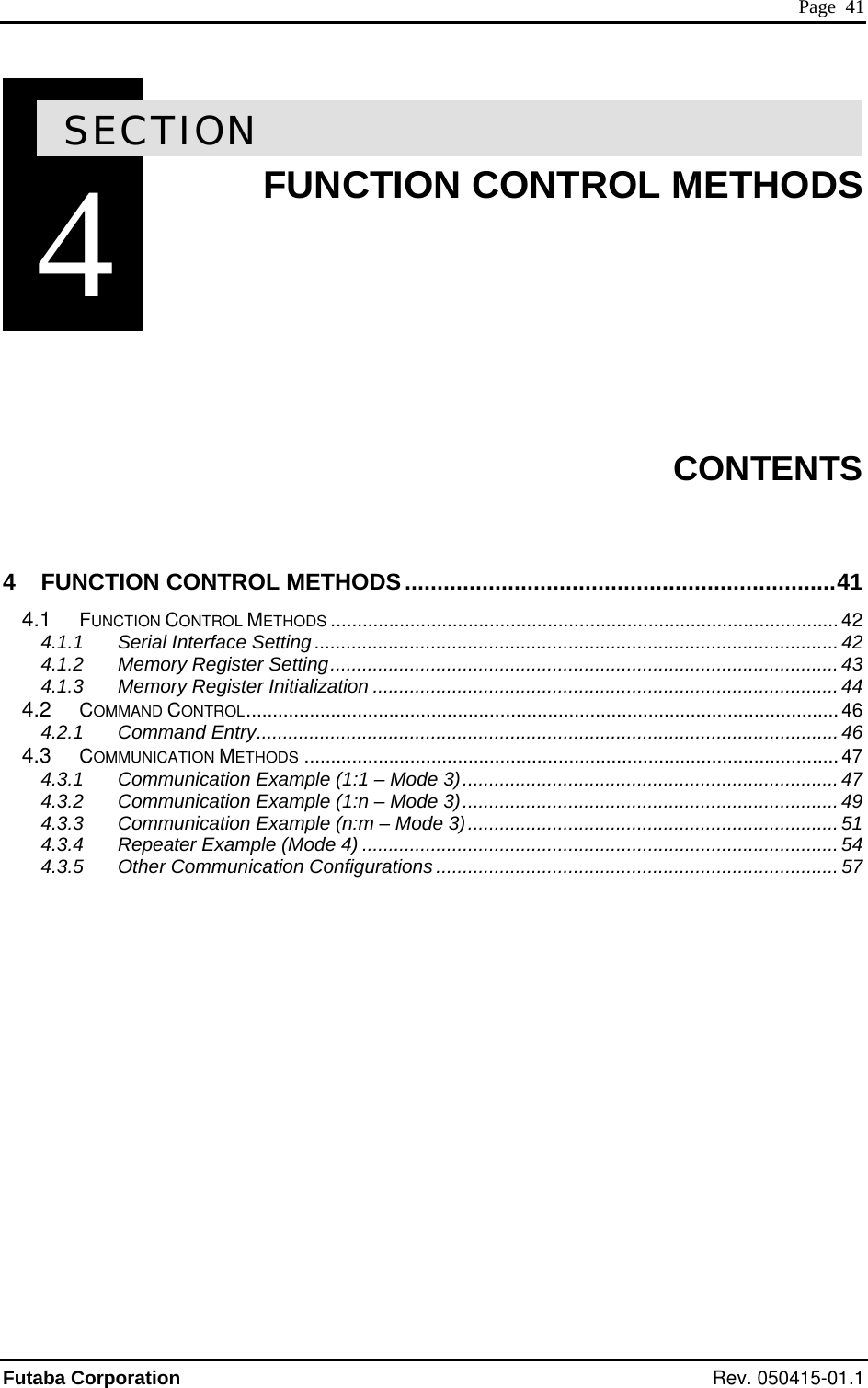
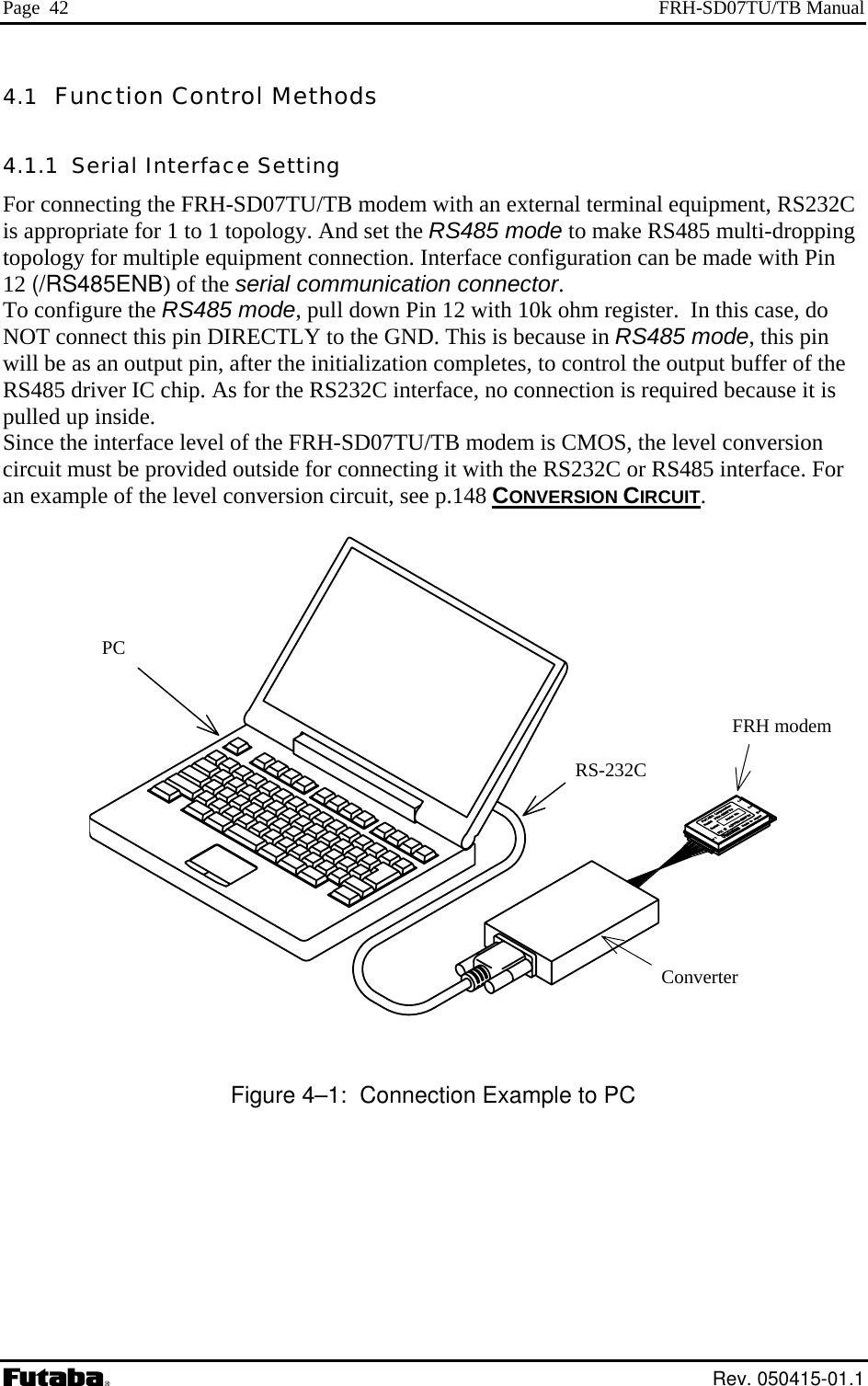
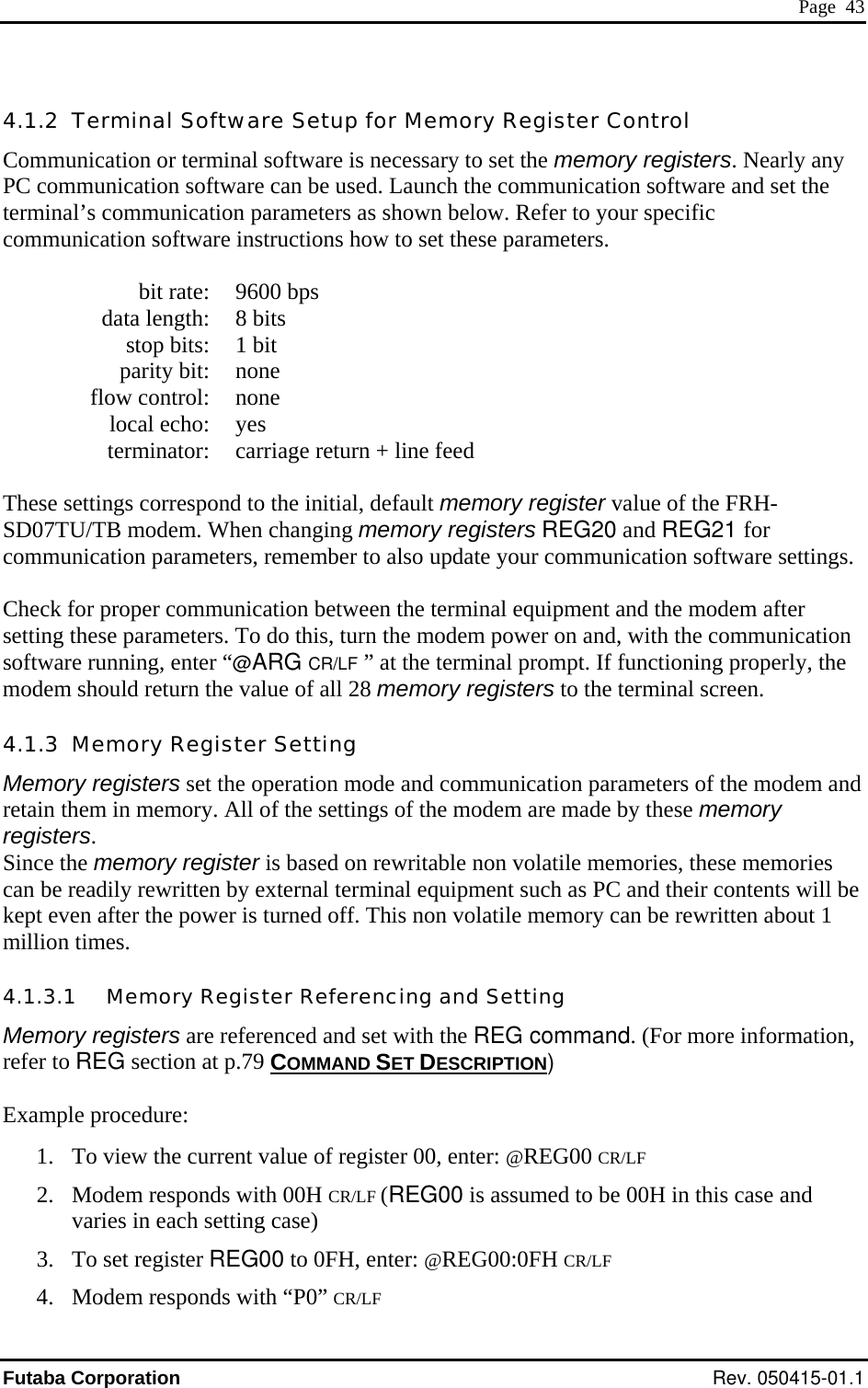
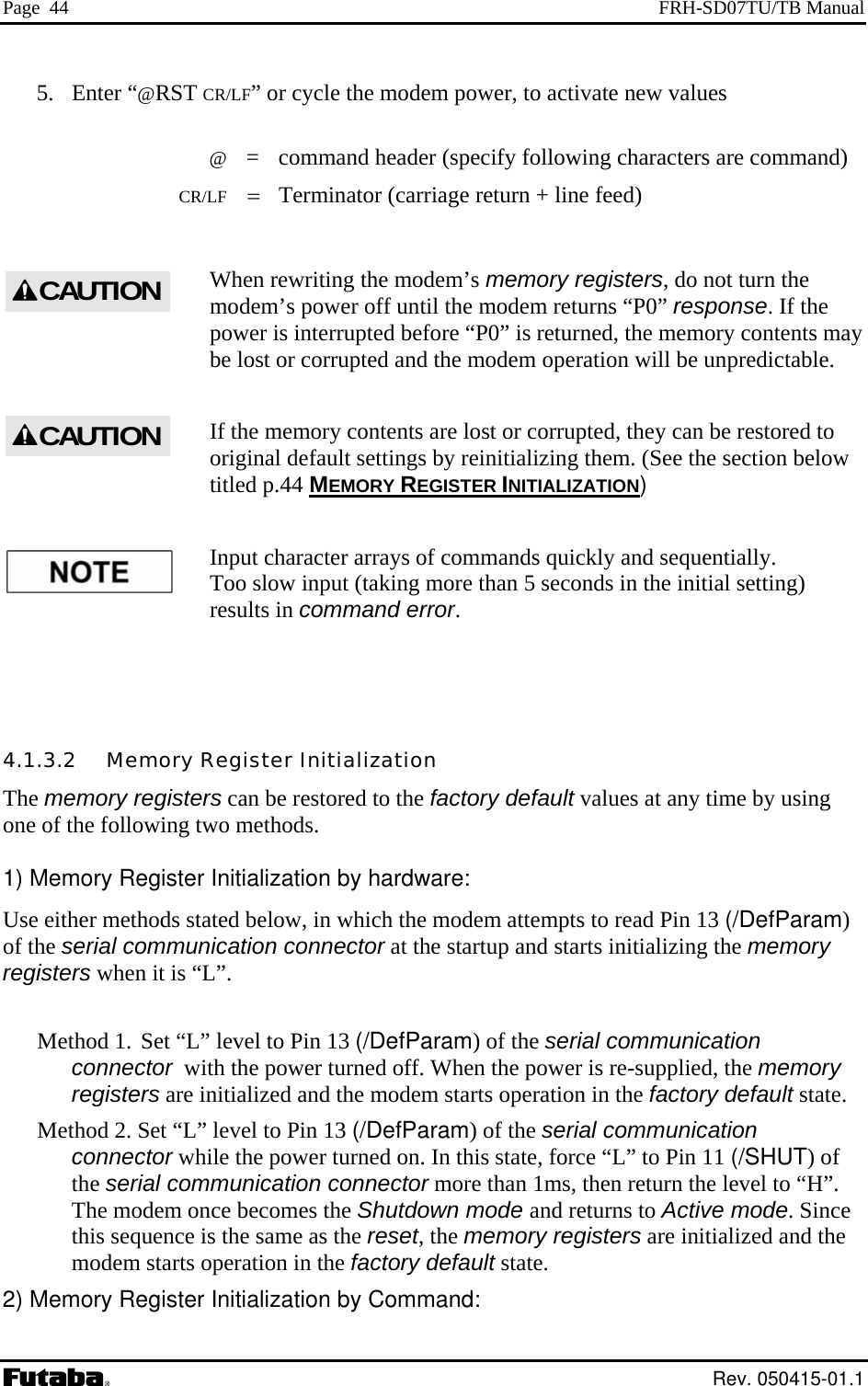
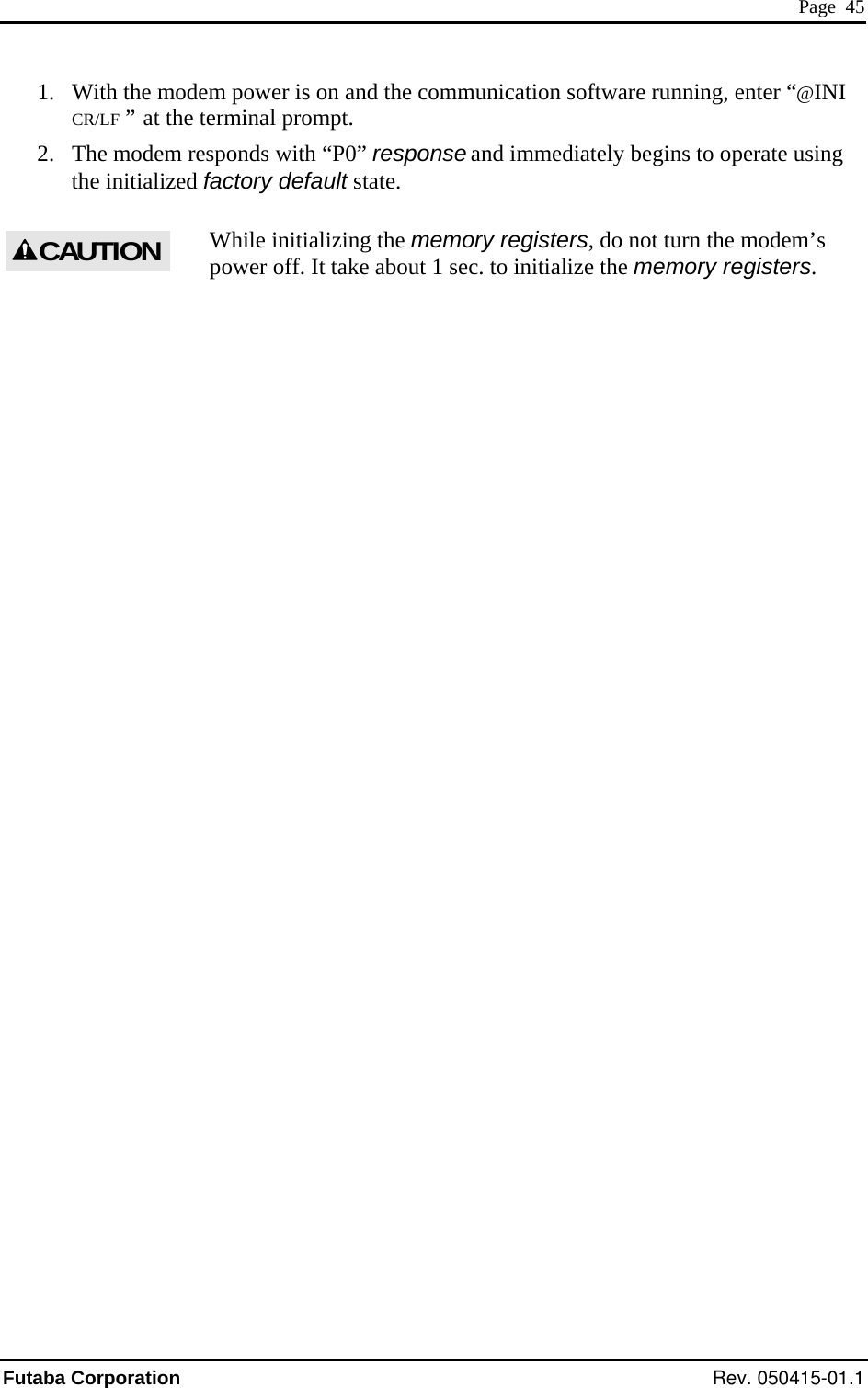
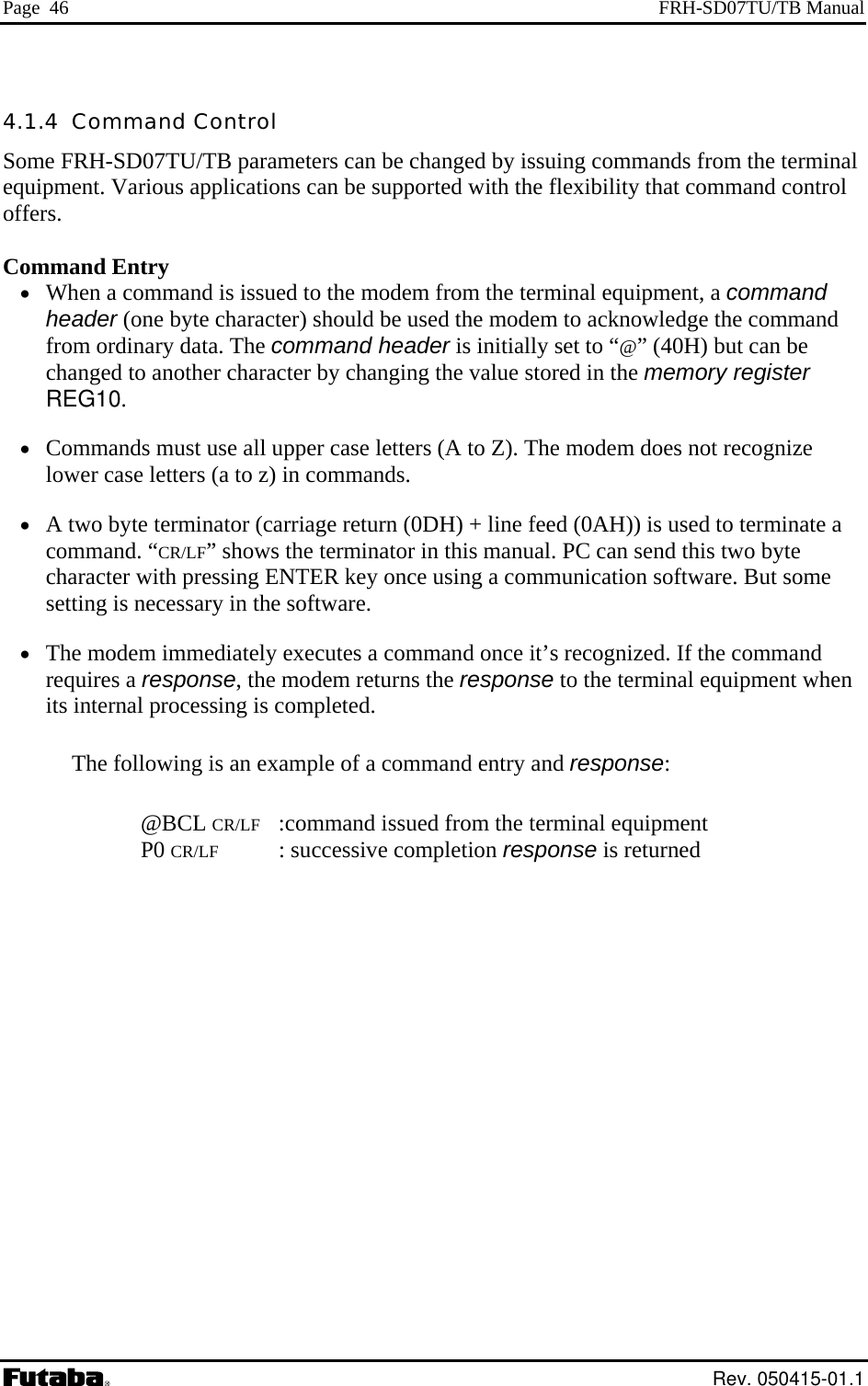
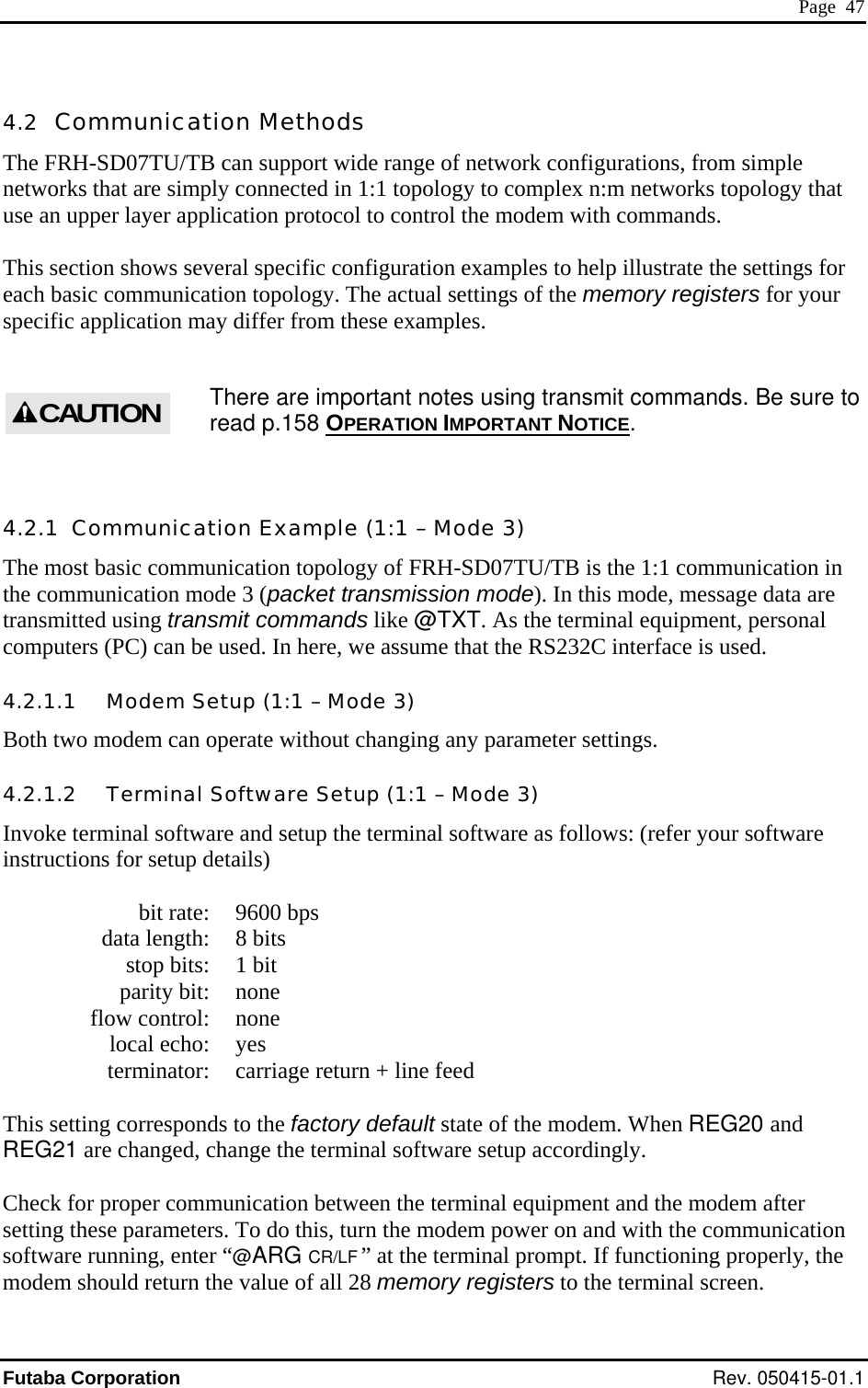
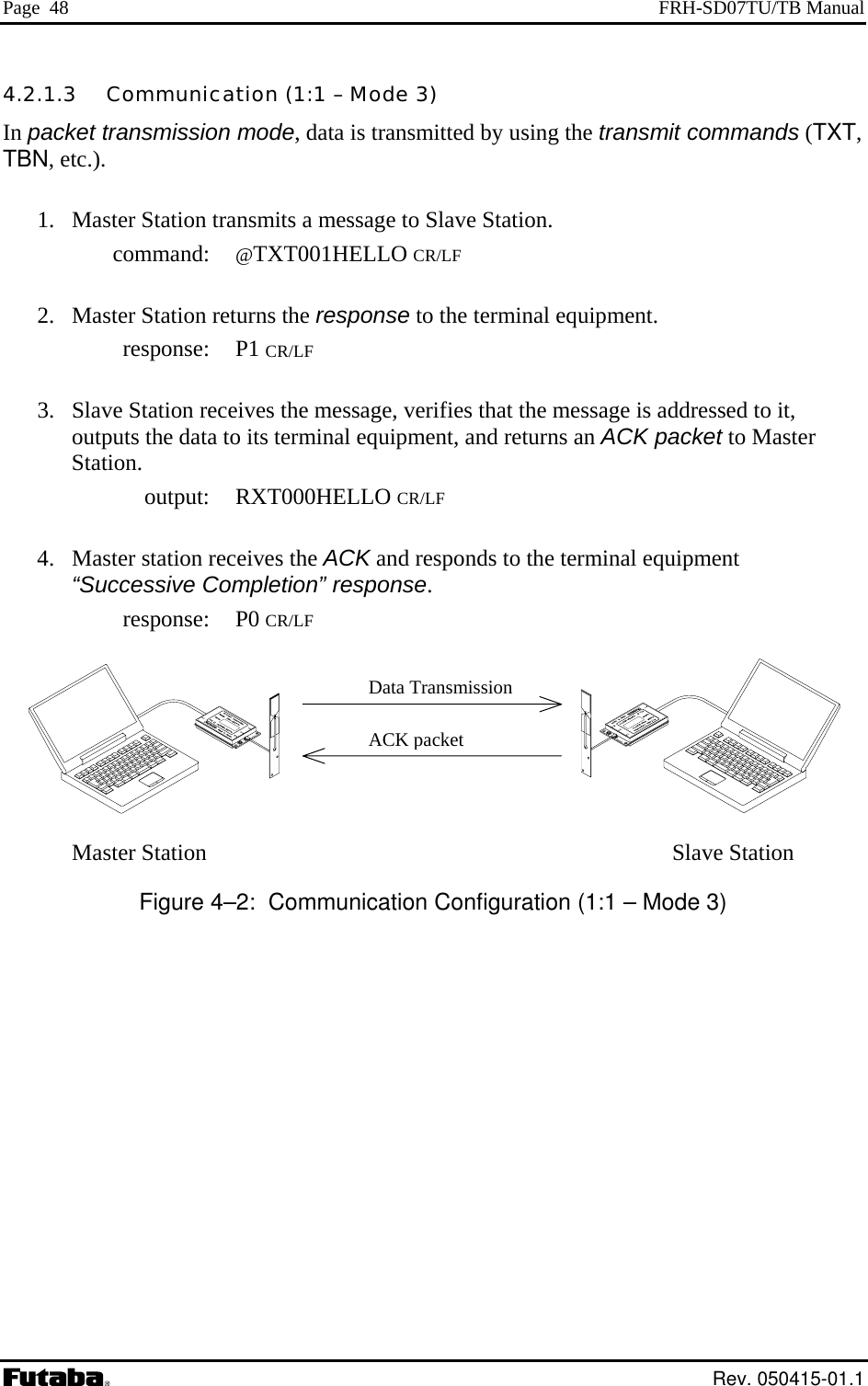
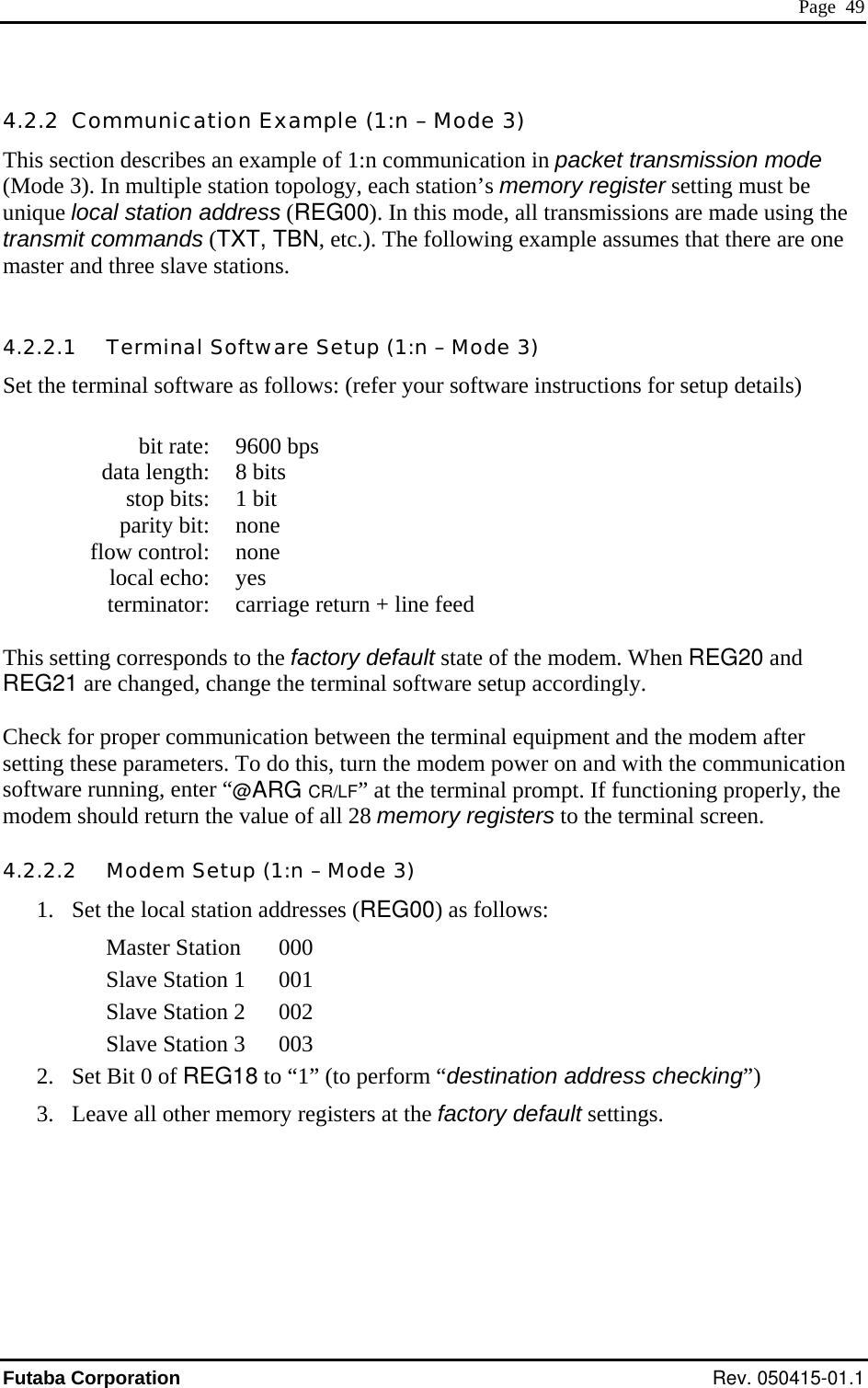
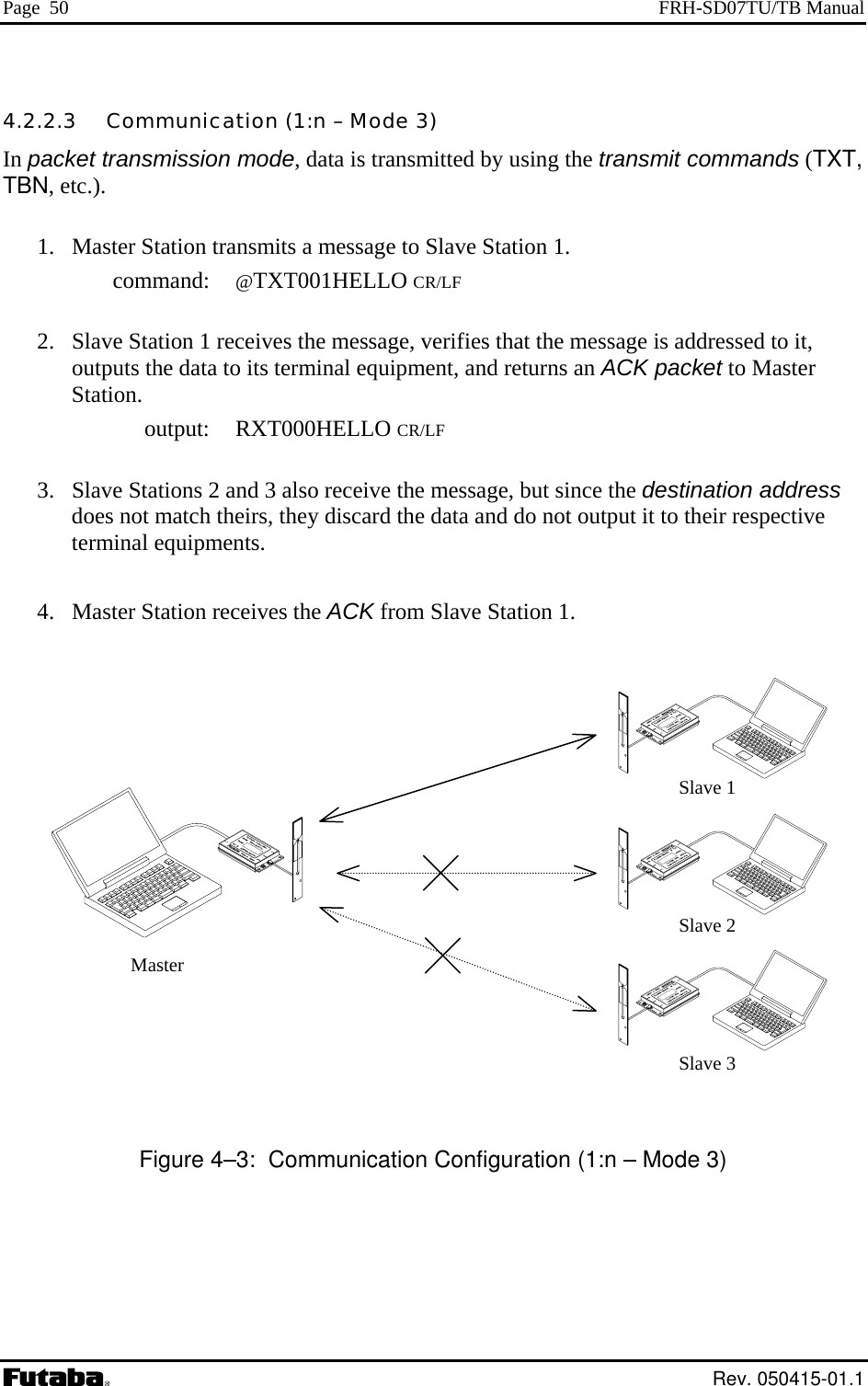
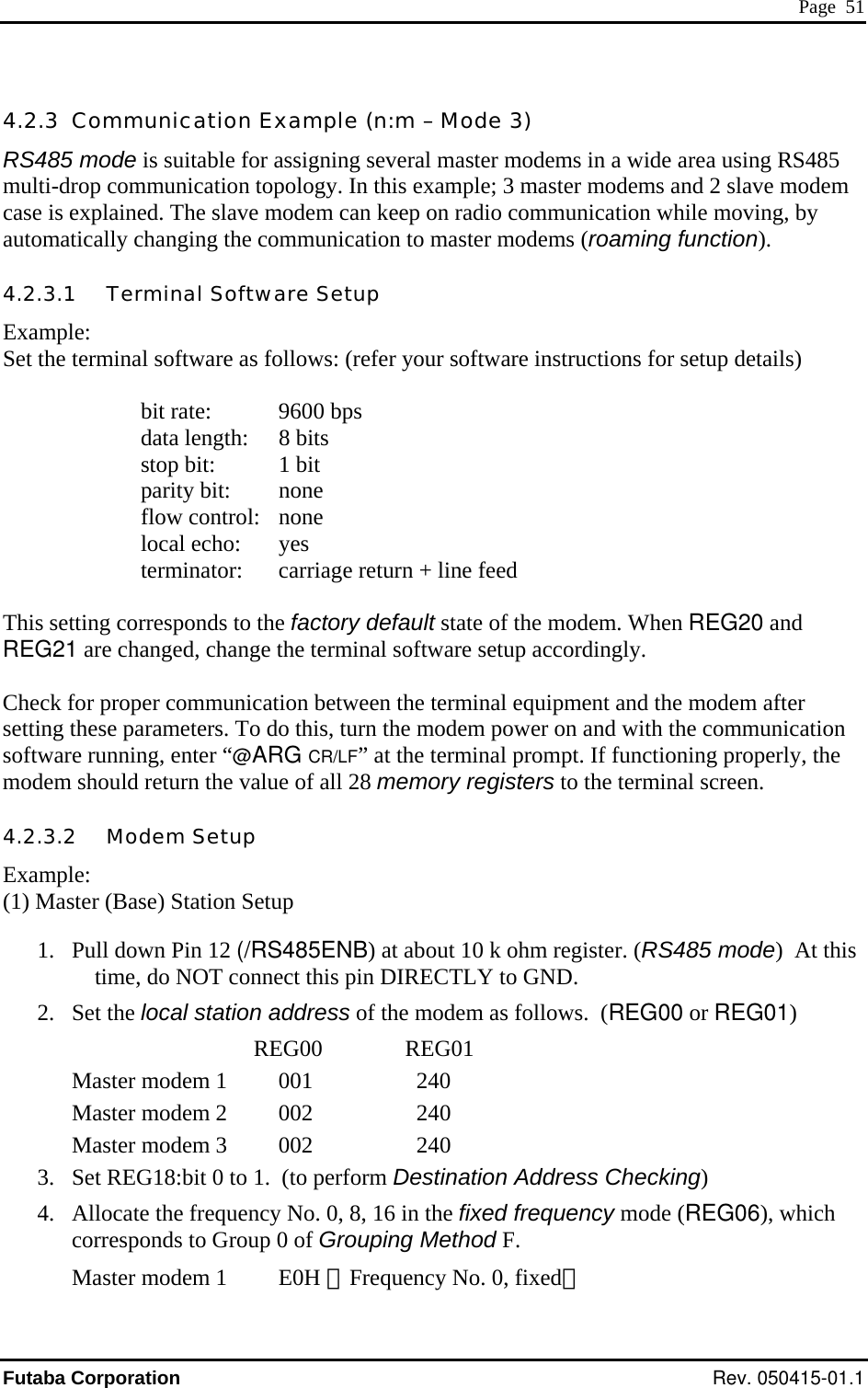
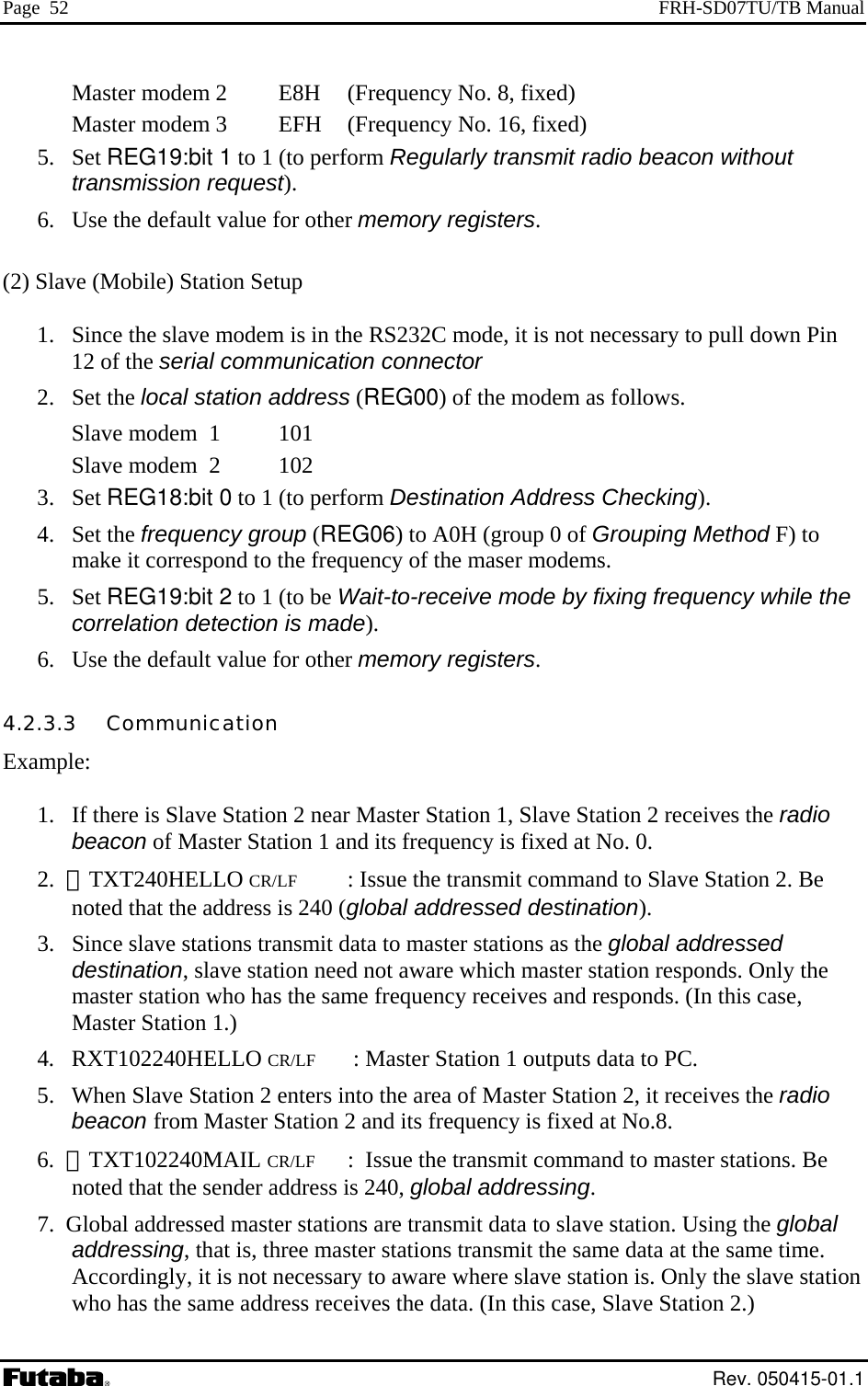
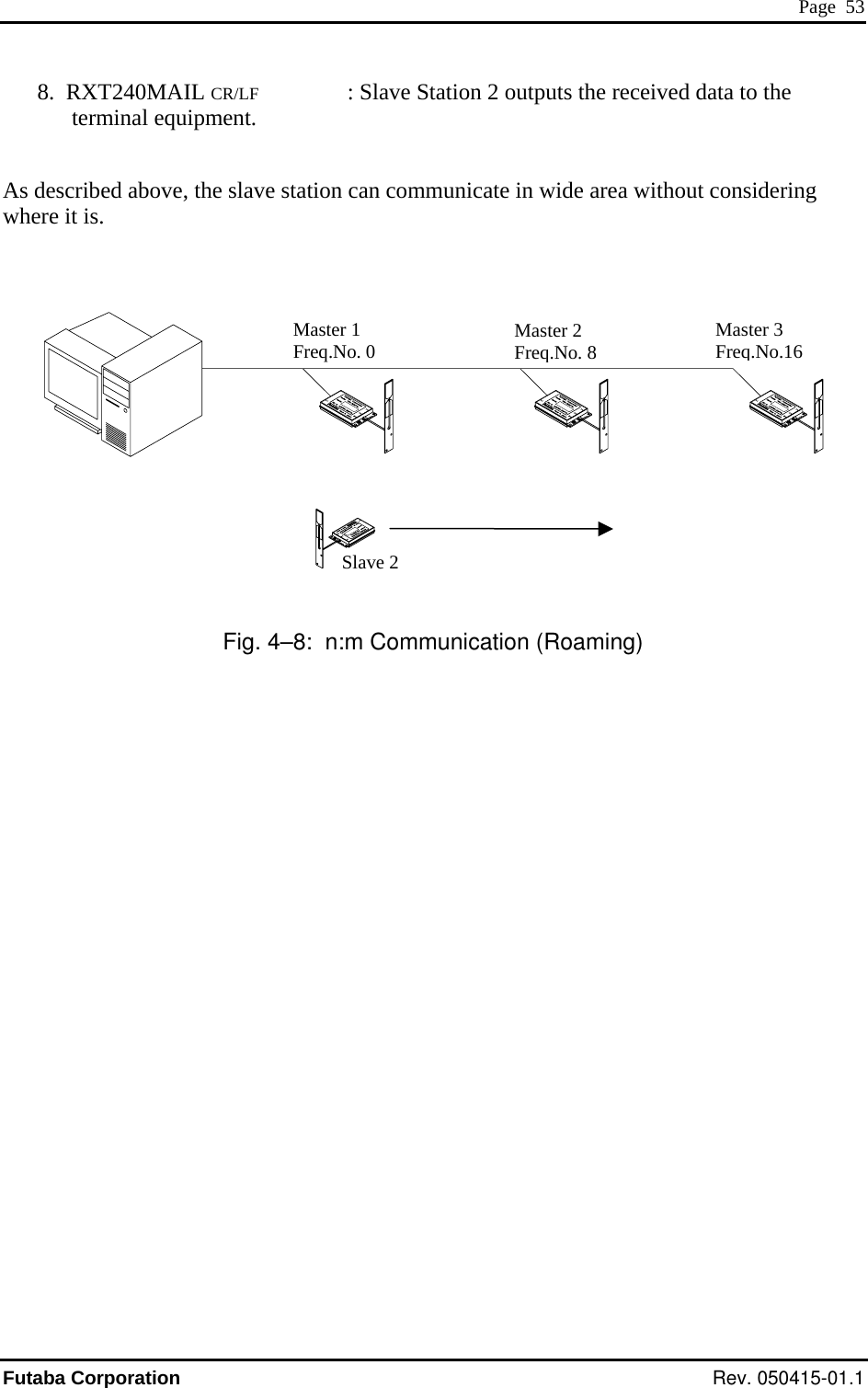
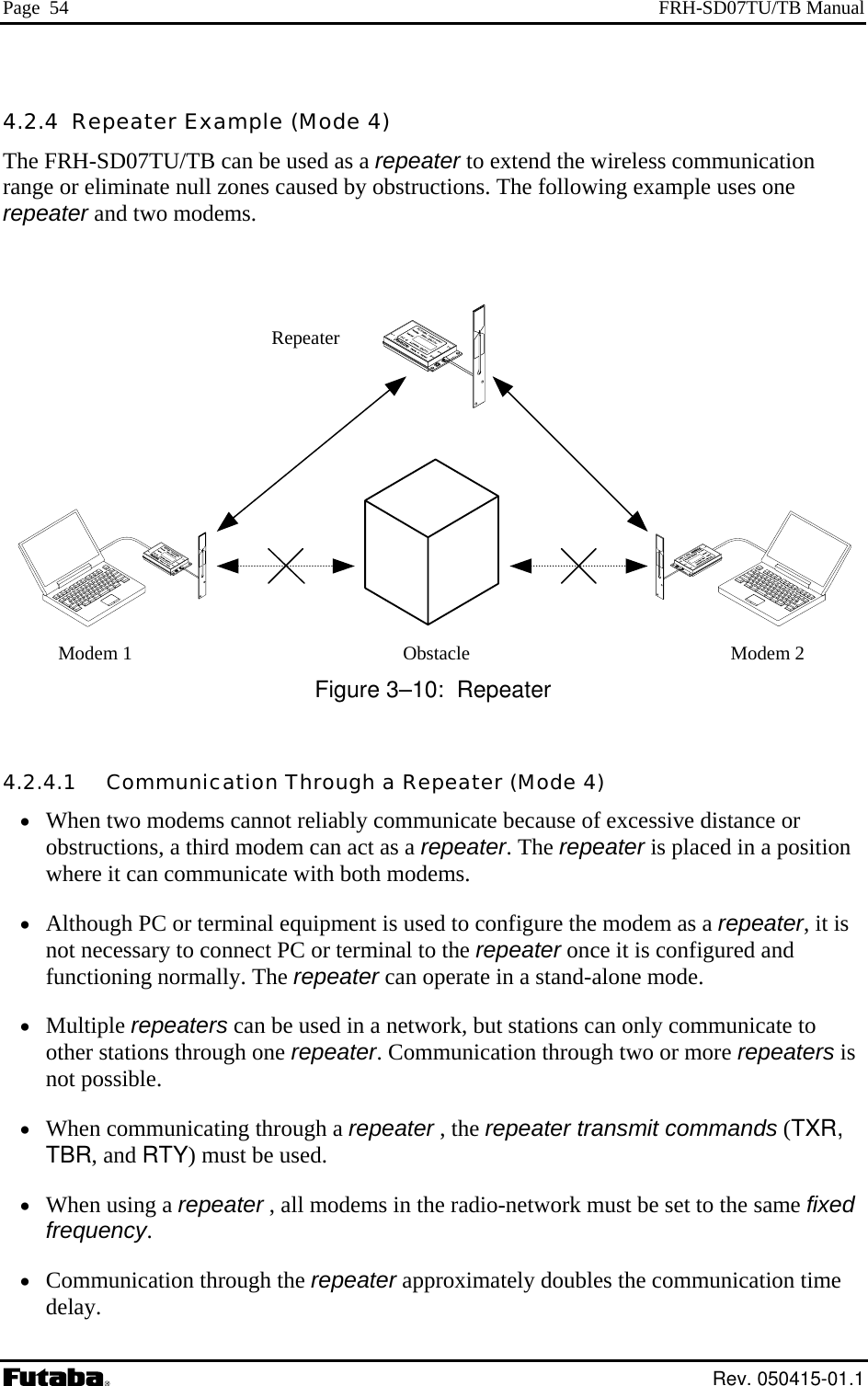
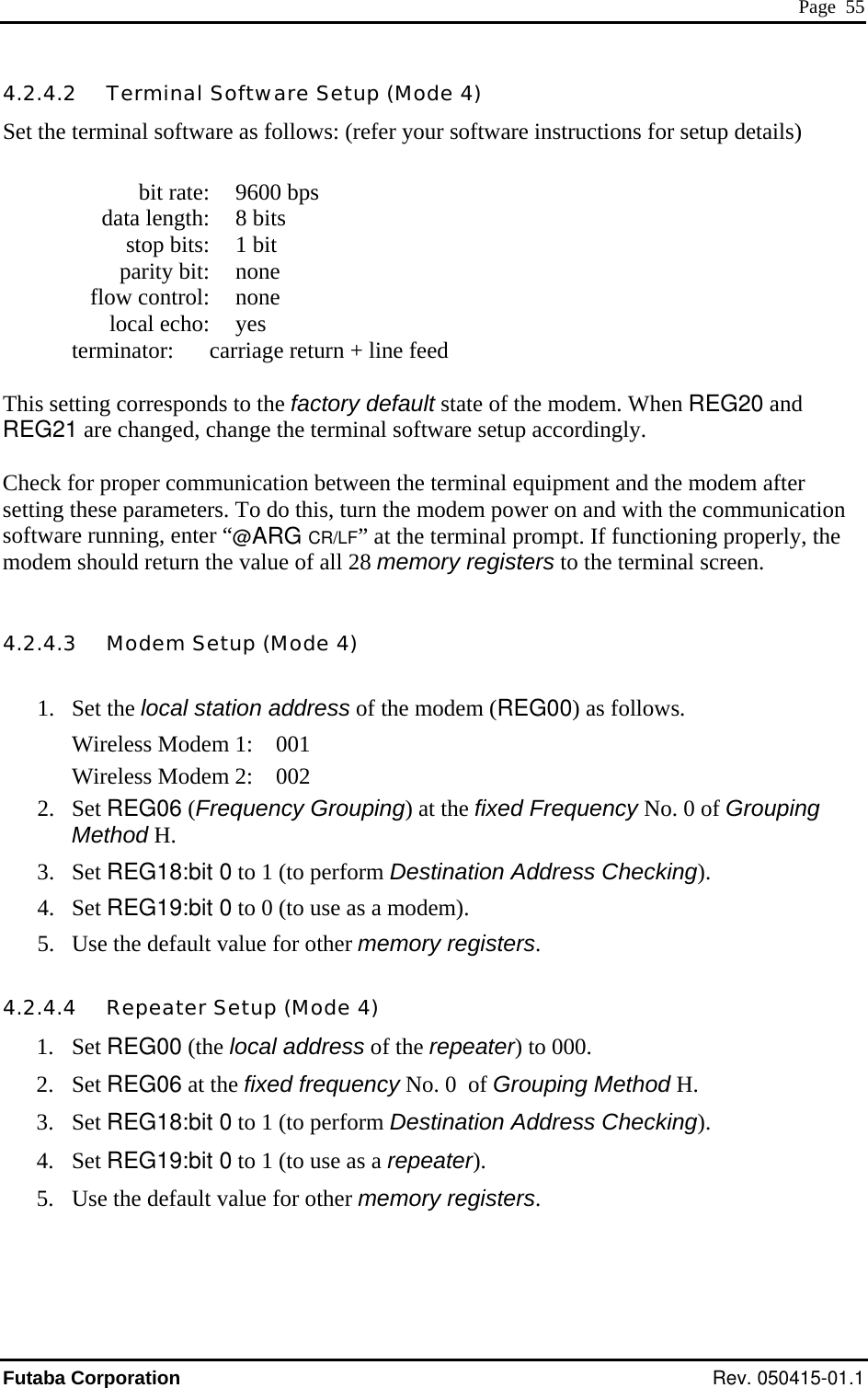
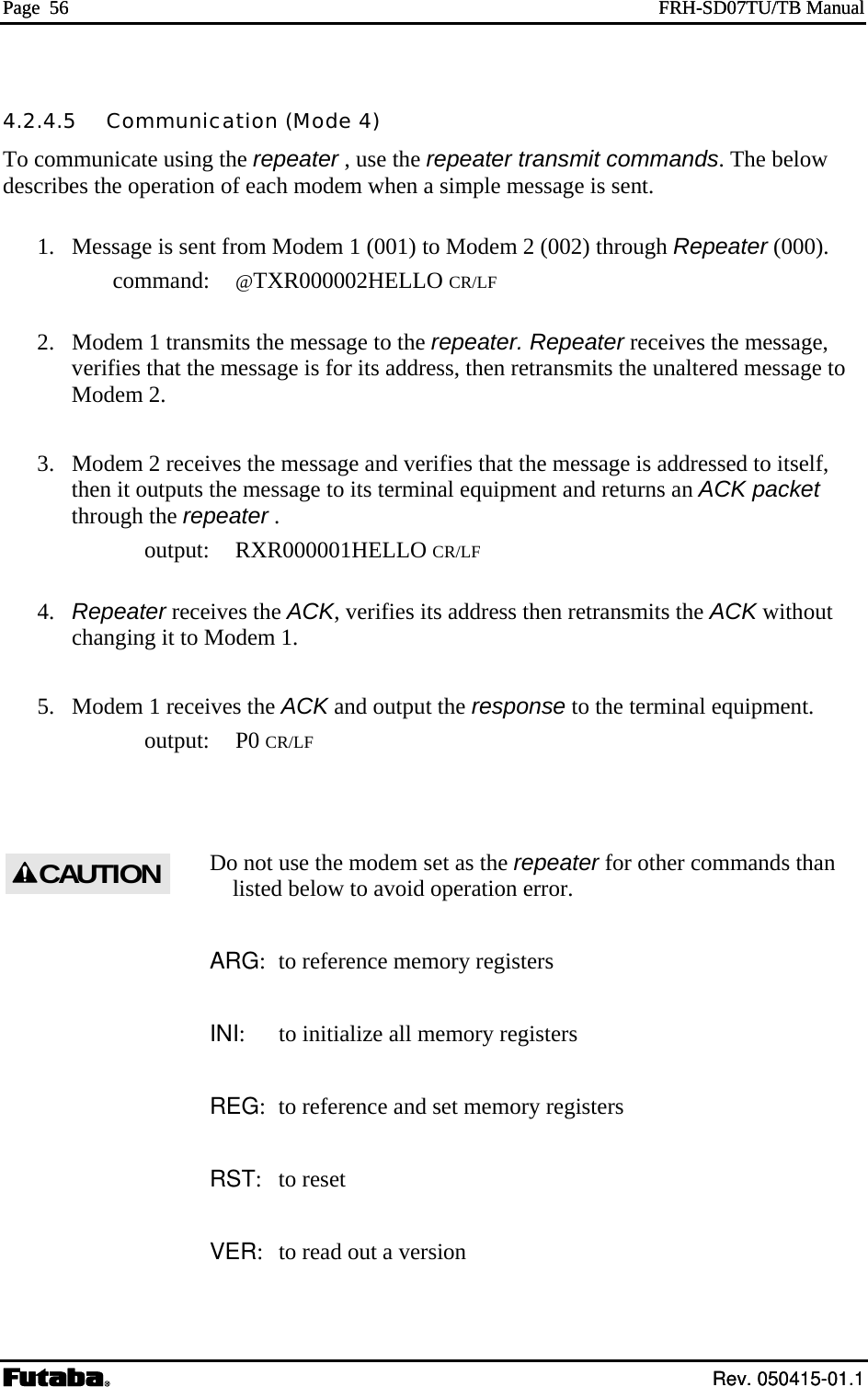
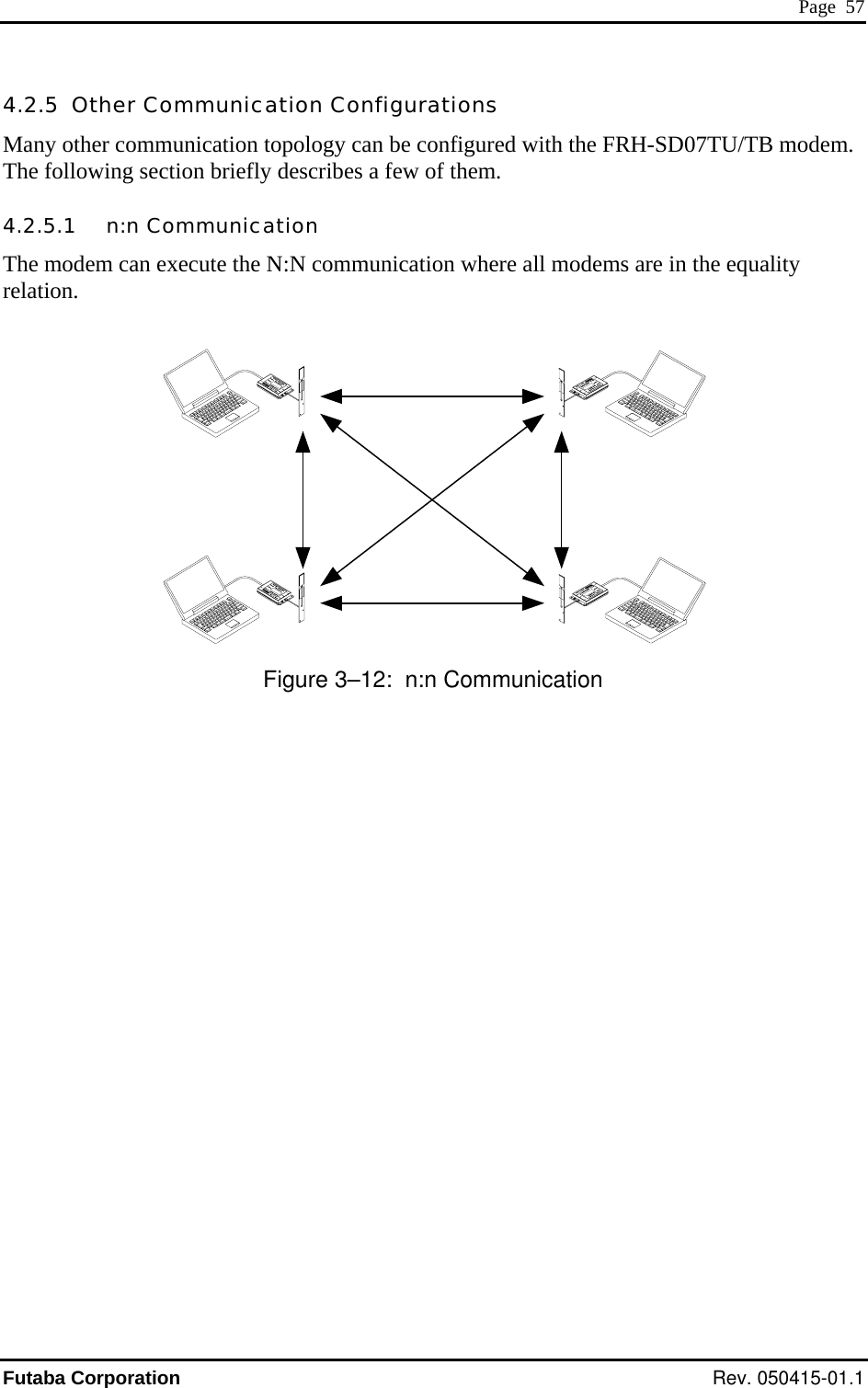
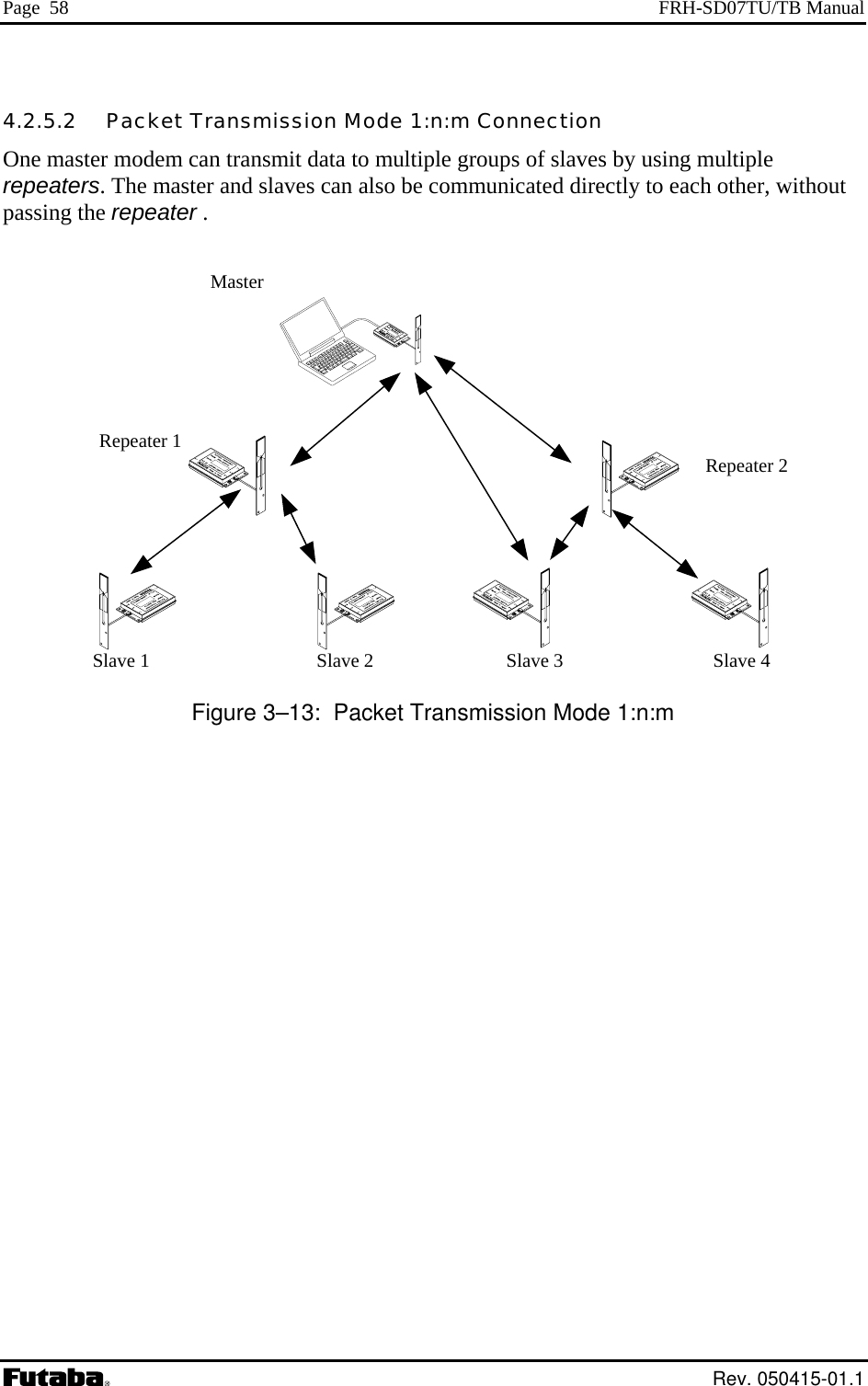
![Page 59 5SECTIONSECTION STER DESCRIPTION CONTENTS 5 MEMORY REGISTER DESCRIPTION ..............................................................59 5.1 MEMORY REGISTER DESCRIPTION5 MEMORY REGI5 MEMORY REGI Page 59 Futaba Corporation Rev. 050415-01.1 5 STER DESCRIPTION CONTENTS 5 MEMORY REGISTER DESCRIPTION ..............................................................59 5.1 MEMORY REGISTER DESCRIPTION ............................................................................................ 60 REG00: LOCAL S [DEFAUL 61 REG01: LOCAL SDDRESS V ............... ....................... 61 REG02: DESTINATION ADDRESS [DEFAULT VALU ................................................................. 61 REG03: SPECIAL SETTING [DEFAULT VALUE: F0H].......................................................................... 61 REG04: ID CODE ............................. 61 REG05: ID CODE 62 REG06: FREQUENCY GROUP [DEFAULT VALUE: A0H]...................................................................... 62 REG07: PACKET INTERVAL [DEFAULT VALUE: 05H].......................................................................... 63 REG08: RESERVED [DEFAULT VALUE: 11H] .................................................................................... 63 REG09: RESERVED [DEFAULT VALUE: 13H] .................................................................................... 63 REG10: COMMAND HEADER [DEFAULT VALUE: 40H]........................................................................ 63 REG11: RETRANSMISSION COUNT [DEFAULT VALUE: 32H]............................................................... 64 REG12: ROAMING THRESHOLD [DEFAULT VALUE: B4H]................................................................... 64 REG13: RESERVED [DEFAULT VALUE: 1EH].................................................................................... 64 REG14: RECEIVE DATA OUTPUT INTERVAL [DEFAULT VALUE: 00H].................................................. 64 REG15: COMMAND RECOGNITION INTERVAL [DEFAULT VALUE: 00H]................................................ 64 REG16: COMMAND INPUT TIMEOUT [DEFAULT VALUE: 32H]............................................................. 65 REG17: RESERVED [DEFAULT VALUE: 32H] .................................................................................... 65 REG18: COMMUNICATION SETTING 1 [DEFAULT VALUE: 8CH].......................................................... 66 REG19: COMMUNICATION SETTING 2 [DEFAULT VALUE: 00H] .......................................................... 67 REG20: RS-232C SETTING 1 [DEFAULT VALUE: 05H]..................................................................... 69 REG21: RS-232C SETTING 2 [DEFAULT VALUE: 09H]..................................................................... 70 REG22: RS-232C SETTING 3 [DEFAULT VALUE: 00H]..................................................................... 72 REG23: MISCELLANEOUS SETTINGS [DEFAULT VALUE: 00H]............................................................ 74 REG24: SPECIAL MODE SETTINGS [DEFAULT VALUE: C0H].............................................................. 76 REG25: ULTRA MODE SETTINGS [DEFAULT VALUE: 40H]............................................................... 77 REG26: RESERVED [DEFAULT VALUE: 00H] .................................................................................... 77 REG27: FREQUENCY BAND SETTINGS [DEFAULT VALUE: 01H]......................................................... 78 TATION ADDRESS T VALUE: 00H]..............................................................TATION GLOBAL A [DEFAULT ALUE: F0H]........ ...E: 00H] 1 [DEFAULT VALUE: 00H] ....................................................... 2 [DEFAULT VALUE: 00H] ....................................................................................Futaba Corporation Rev. 050415-01.1](https://usermanual.wiki/Futaba/FRH-SD07TU.User-Manual/User-Guide-535573-Page-75.png)
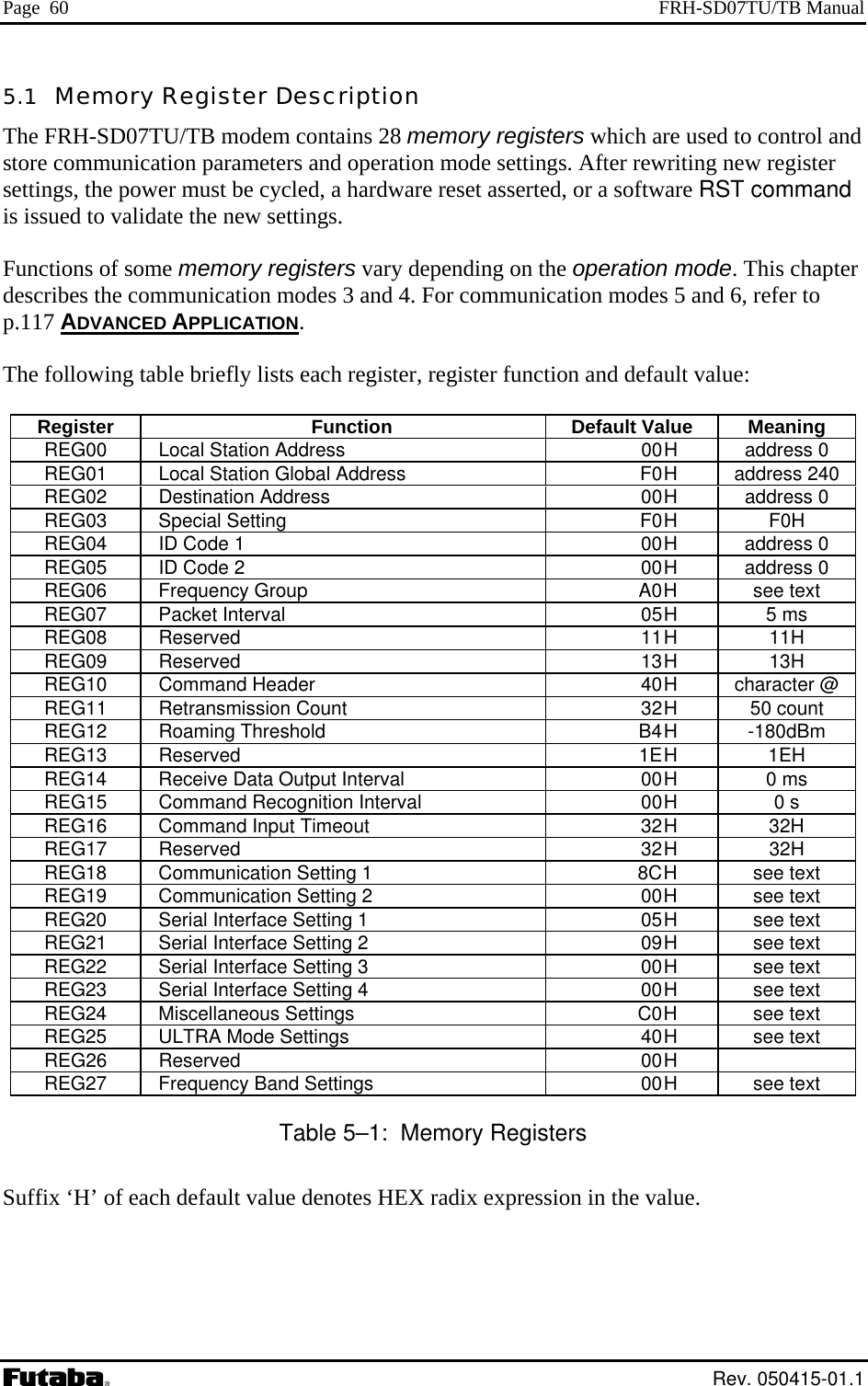
![Page 61 REG00: Local Station Address [default value: 00H] • Sets the local station address. Valid values are 000 to 239. (240 addresses) • This value is inserted in the “source address” field in the transmitted packet header. • In the RS485 mode, this register is used as 485 mode local station address. RE ca Station Globa s (RS485) ult v H] • If the address check function is enabled (REG18) in the receiving modem, the modem can receive the packet which header contains destination address information identical to REG00. G01: Lo l l Addres [defa alue: F0• e lo odem. Valid vaes• plu onnected by RS485 multi-dropping topology, commands can ed odems simultaneously by setting all connected mo glo is the global addressing. • ob llows to handle multiple multi-dropp dems as y ne REG st fault H] Sets th cal station global address of the m lues are 240 to 254. (15 address ) When ral modems are cbe issu to multiple m dems to thesame bal address. ThisThis gl al addressing a ed mo if thewere o modem. 02: De ination Address [de value: 00• dre packet transmission m (communication 5). ADERLESS PACKET TR ON METhis ad ss is used in the headerless odemodes For details, refer to p.118 HEANSMISSI OD . • de ission mode 3 or 4. REG ec fault v 0H] Use the fault value for the transm03: Sp ial Setting [de alue: F• eci s headerless packet trans ion motra to p.117 ADVANCED APPLICSets sp al operation modes such a miss de or direct nsmission mode. Refer ATION. • de mission mode 3 or 4. REG04: ID Code 1 [default value: 00H] Use the fault value for the trans• Used with ID code 2 (REG05with ID code 2, up to 61,440 ID codes can be set. p. The ID code is used to prevent erroneous connection with other systems and for communication security. ), set the ID code. Valid values are 000 to 255. Together • The ID code identifies the group of the modems works in the same grouFutaba Corporation Rev. 050415-01.1](https://usermanual.wiki/Futaba/FRH-SD07TU.User-Manual/User-Guide-535573-Page-77.png)
![Page 62 FRH-SD07TU/TB Manual • Before transmission, radio data packets are scrambled using a pseudo-random data sequence generated with this ID code as the seed. During reception, the original data is the pseudo-random data sequenR 00H] restored by de-scrambling it with ce. The modems with different ID codes cannot communicate with each other. EG05: ID Code 2 [default value: • • REG04 and REG05 value and assigns REG04 to 255 and REG05 to 239. modems and repeaters. RUsed with ID code 1 (REG04), set the ID code. Valid values are 000 to 239. Together with ID code 1, up to 61,440 ID codes can be set. Do not set the value 240 and above. If excess value is set, the modem ignores the • In case plural modems are used as a single system, always set the same ID code for all EG06: Frequency Group [default value: A0H] • Refer to p.35 FREQUENCY GROUPING in Section 3, for a detailed description of the frequency operation modes. – 5: Grouping ofBits 7 frequency Grouping Setting Bit 7 Bit 6 Bit 5 A 24 fr 0 eq. × 1 group 0 0B 12 freq. × 2 group 0 0 1 C 8 freq. × 3 group 0 1 0 D 6 freq. × 4 group 0 1 1 E 4 freq. × 6 group 1 0 0 F ×1 0 3 freq. 8 group 1 G 2 freq. ×12 group 1 1 0 H 1 1 freq. ×24 group 1 1Table 5–2: Grouping of Frequency • Set the grouping method for the 24 available frequencies. The number of available frequencies per group is allocated to perform multi-access in the frequencies of group. • The multi-access function is performed within a frequency group. encies per group are made available for multi-a• When more frequ ccess function, the system will gain an advantage in overcoming interference and fading, but average time required to establish a connection will increase because more frequencies are scanned. Rev. 050415-01.1](https://usermanual.wiki/Futaba/FRH-SD07TU.User-Manual/User-Guide-535573-Page-78.png)
![Page 63 B 4its – 0: Group Number Group No. Bit 4 Bit 3 Bit 2 Bit 1 Bit 0 0 0 0 0 0 0 1 0 0 0 0 1 2 0 0 0 1 0 3 0 0 0 1 1 4 0 0 1 0 0 : : : : : : : : : : : : 19 1 0 0 1 1 20 1 0 1 0 0 21 1 0 1 0 1 22 1 0 1 1 0 23 1 0 1 1 1 Table 5–3: Frequency Group Settings ber is set. Valid group numbers fo[default value: 05H] • The frequency group num r setting vary depending on the frequency grouping method. REG07: RS485 Packet Interval • In the nsmission m h the RS485 e is set between re nse and/or h output from the m em to RS485 line. • Be able to set 0 to 254 ms ms. 255m s not a ed. T default value is 5 • Set this interval to a large ceiving in rval set by REG14. • Suitable setting of this inte ata collision possibility of RS485 line. For details, refer to p.31 CNCE IN RS485 INTERFACEpacket tra ode wit mod used, s the intervalspo received data whic od at increment of 1 s i llow he ms. r value than the re terval avoids the dOLLISION AVOIDA . REG08: Reserved [default value: 11H] • The FRH-SD07TU/TB does not use this register. Keep the default value as it is. R ult value: 13H] EG09: Reserved [defa• The FRH-SD07TU/TB does not use this register. Keep the default value as it is. REG10: Command Header [default value: 40H] • Sets the character that identifies the start of a command. • The default is character “@” (40H). Futaba Corporation Rev. 050415-01.1](https://usermanual.wiki/Futaba/FRH-SD07TU.User-Manual/User-Guide-535573-Page-79.png)
![Page 64 FRH-SD07TU/TB Manual • When this character is input from the terminal equipment after no character is received for the command recognition interval REG15) or longer, subsequent input character is rec an th emREG11: Retransmission Coun [default value: 32H] (d rogniz as a commed fo e m do . t • Sets the maximum n mber o acke etran issio ttemp . Valid values are 000 to 254. 255 is not allowed. • When retransmission exceeds the retransmission count (retransmission count plus one for broadcast transmission), the modem outputs an error response to the terminal equipmentREG12: Roaming Thr [default value: B4H] u f p t r sm n a ts. eshold • At the tim (REG19:bit 2 , set the receiving • h threshold represented in dBm excluding the minus sign, e.g., set to “80” to search the next master station when the s below -80 dBm. REG ] e to set the frequency roaming is 1)strength threshold of the radio beacon which starts scanning frequency. Set the value of the desired radio beacon strengtradio beacon strength become13: Reserved [default value: 1EH• The FRH-SD07TU/TB does not use this register. Keep the default value as it is. R 0H] EG14: Receive Data Output Interval [default value: 0• p bit of one character to the start bit of the next character) when output data from the modem to the 55, representing milliseconds in 1 ms incremval between the characters output to the terminal equipment does not guaranteed. Characters are continuously sent to the terminal equipment until the modem’s buffer hen the data cannot be received by the termintion Interval Sets the minimum time interval between characters (time from the stoterminal equipment. • Valid values are 000 to 2 ents. • Since the modem transmit data to other end modem in packet form, minimal interbecomes empty. W al equipment, set this interval longer. REG15: Command Recogni [default value: 00H] • When a message data contains a command header character (in case of binary data or data in two-byte Chinese characters), data following the command header character message does not transmit properly. will be interpreted as a command, the Rev. 050415-01.1](https://usermanual.wiki/Futaba/FRH-SD07TU.User-Manual/User-Guide-535573-Page-80.png)
![Page 65 • Sets the necessary vacant duration time interval to discriminate between ordinary data character and a command header character. Input a command after a longer inthan time interval setting. terval • Valid values are 0.1 to 25.4 sec., representing tenths of seconds in 0.1 second al to ten times the number of seconds desired.) header is recognized at any timR G increments. (Set an integer value equ• When set to 000, the command e, and when set to 255, all command header character are ignored. E 16: Command Input Timeout [default value: 32H]• ut timeout interval for command input. It is used as the timeout between the command header and the character following it and between eration transits from command-in• rements. • REG17: Reserved [default value: 32H] Sets the character inpeach character of the command. • At the timeout, the modem op put-wait-state to ordinary-data-wait-state. Valid values are 000 to 255, representing tenths of seconds in 0.1 second inc(Set an integer value equal to ten times the number of seconds desired.) A setting of 000 disables this timeout function. • The FRH-SD07TU/TB does not use this register. Keep the default value as it is. Futaba Corporation Rev. 050415-01.1](https://usermanual.wiki/Futaba/FRH-SD07TU.User-Manual/User-Guide-535573-Page-81.png)
![Page 66 FRH-SD07TU/TB Manual REG tting 1 [default value: 8CH] 18: Communication SeBits 7Bit 1: Source address check – 2: Reserved • The FRH-SD07TU/TB does not use this register. Keep the default value as it is. 0 Inhibit source address checking (default value) 1 Activate source address checking Table 5–4: Source Address Check Settings • ta is ceived). Bit 0When the source address checking is active and the source address in the received packet header does not match the destination address setting (REG02), the dadiscarded (data cannot be re: Destination address check 0 Inhibit destination address checking on receipt (default) 1 Activate destination address checking on receipt Table 5–5: Destination address check in the received packet header does not match the received modem’s local station address (REG00), the data is discarded (data cannot be received). • When the destination address checking is active and the destination address Rev. 050415-01.1](https://usermanual.wiki/Futaba/FRH-SD07TU.User-Manual/User-Guide-535573-Page-82.png)
![Page 67 REG19: Communication Setting 2 [default value: 00H] Bit 7: Reserved • The FRH-SD07TU/TB does not use this register. Keep the default value as it is. Bit 6: Diversity Reception 0 Disable diversity reception (default value) 1 Enable diversity reception Table 5–6: Diversity Reception Settings • Enable/disable diversity reception. To enable diversity reception, set this bit to 1 and connect an antenna to Antenna Terminal B. • ay degrade the reception performance. Bit 5: Broadcas ra• Enabling diversity reception with only one antenna connected mt T nsmission Reception 0 Ena lue) ble broadcast transmission reception (default va1 Disable broadcast transmission reception Table 5–7: Broadcast Reception Settings Enable/disable reception of broadcast transmission in pa• cket transmission mode (Mode 3 and 5). Bit 4: Antenna selection 0 Receiving antenna is fixed to A (default value) 1 Receiving antenna is fixed to B Table 5–8: Antenna Selection • At the non-diversity reception, decide the antenna terminal for the receiving antenna fixing. • Selection of 1 fixes the receiving antenna to the terminal B. When the high gain antenna connecting to the terminal B is used for reception, this setting would achieve better performance than the diversity reception in some case. Futaba Corporation Rev. 050415-01.1](https://usermanual.wiki/Futaba/FRH-SD07TU.User-Manual/User-Guide-535573-Page-83.png)
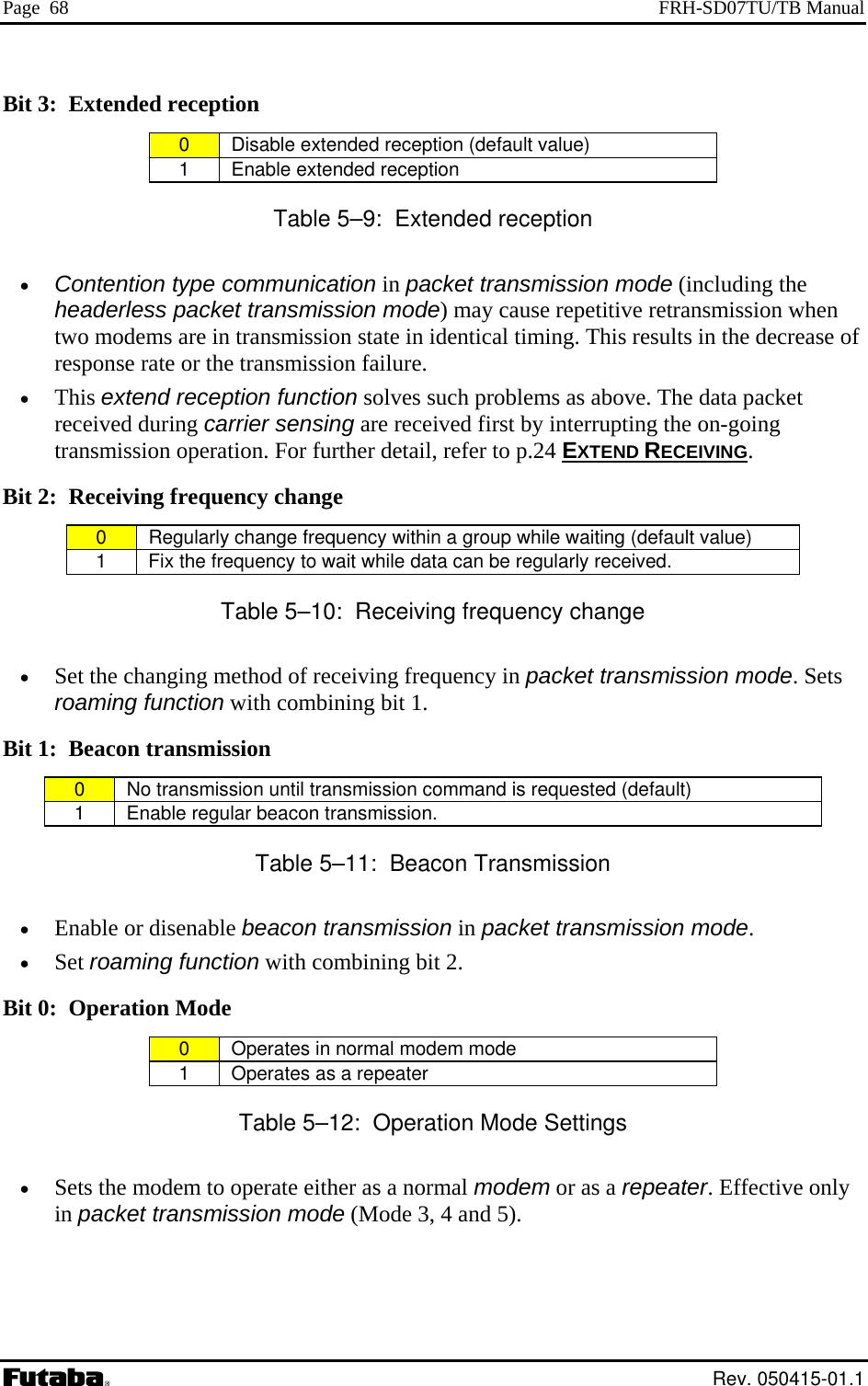
![Page 69 REG20: RS-232C Setting 1 [default value: 05H] Bit 7: Data Length 0 8 bit data bytes (default value) 1 7 bit data bytes Table 5–13: Data Length Settings : Parity Bit Bit 60 No parity bit (default value) 1 Parity bit Table 5–14: Parity Settings Bit 5: Ev /Oen dd Parity 0 Even parity (default value) 1 Odd parity Table 5–15: Odd/Even Parity Settings • ty. Invalid when bit 6 is set to 0, without pariBit 4: Stop Bit 0 1 stop bit (default value) 1 2 stop bits Table 5–16: Stop Bit Settings Futaba Corporation Rev. 050415-01.1](https://usermanual.wiki/Futaba/FRH-SD07TU.User-Manual/User-Guide-535573-Page-85.png)
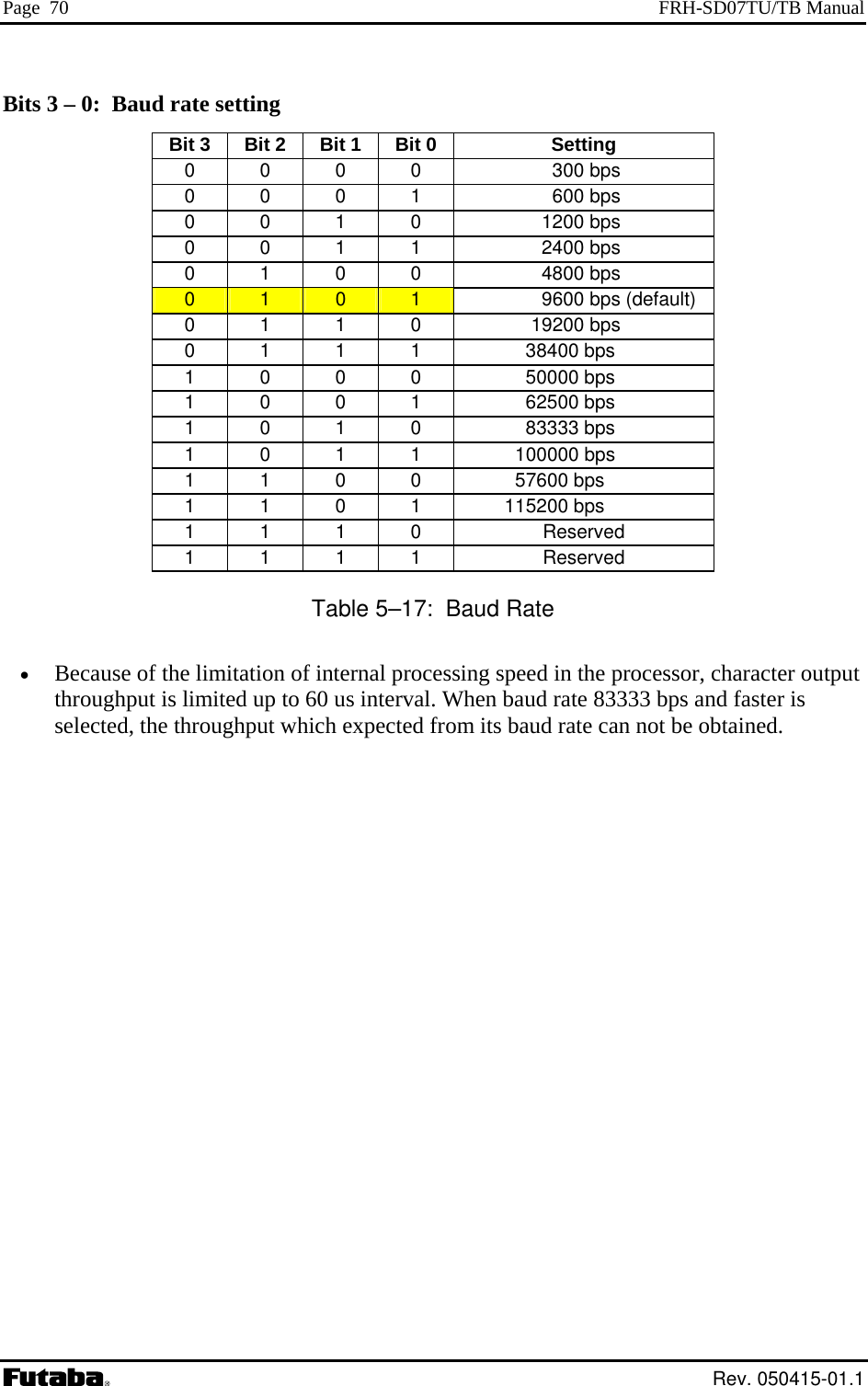
![Page 71 REG21: RS-232C Setting 2 [default value: 09H] Bits 7 – 2: Reserved • The FRH-SD0 U/TB oes n use th reg ault value as it is. Bit 1: Flow Control 7T d ot is ister. Keep the def0 No flow cont (defa varol ult lue) 1 Ha ntrordware flow co l Table 5–18 Software/Hardware Flow Control Settings • Selects the flow control method. This settin onnected terminal equipment’s setting. • Hardware flo contr control lines R TS. When using hardware flo contr RTS and CTS lines are properly wired. • When using with the RS485 interface, be sure to set to 0. Bit 0: Reserved g must match the cw ol uses the two TS and Cw ol, be sure that • The FRH-SD07TU/TB does not use this register. Keep the default value as it is. Futaba Corporation Rev. 050415-01.1](https://usermanual.wiki/Futaba/FRH-SD07TU.User-Manual/User-Guide-535573-Page-87.png)
![Page 72 FRH-SD07TU/TB Manual REG22: RS-232C Setting 3 [default value: 00H] Bit 7: Enable and Disable Reception 0 Enable reception at the initial state (default value) 1 Disable reception at the initial state Table 5–19: Enable/Disable Reception • Select enable or disable reception at the initial state in the packet transmission mode. • The initial odem, the initial state of the modem may be better in the reception disable state. In such a case, • and to enable reception. Bit 6 default value as it is. B 5Bit 5 Bit 4 Setting state is in reception enable. Depending on an usage of the muse this setting. Issue the REN comm: Reserved • The FRH-SD07TU/TB does not use this register. Keep the its – 4: DCD (Data Carrier Detect) 0 0 Ignore DCD input; DCD output always ON (default value) 0 1 Reserved 1 0 Remote modem’s DCD (IN) is transferred to local modem DCD (OUT). (DCD Output = OFF at reset state) 1 1 Remote modem’s DCD (IN) is transferred to local modem DCD (OUT) (DCD Output = ON at reset state) Table 5–20: DCD Settings • When connecting to the telephone line modem, set the FRH-SD07TU/TB modem to transfer the DCD input of the remote modem to the DCD output of the local modem. • Operation on Direct Transmission Mode differs. Please refer to p.127 DIRECT TRANSMISSION MODE. Rev. 050415-01.1](https://usermanual.wiki/Futaba/FRH-SD07TU.User-Manual/User-Guide-535573-Page-88.png)
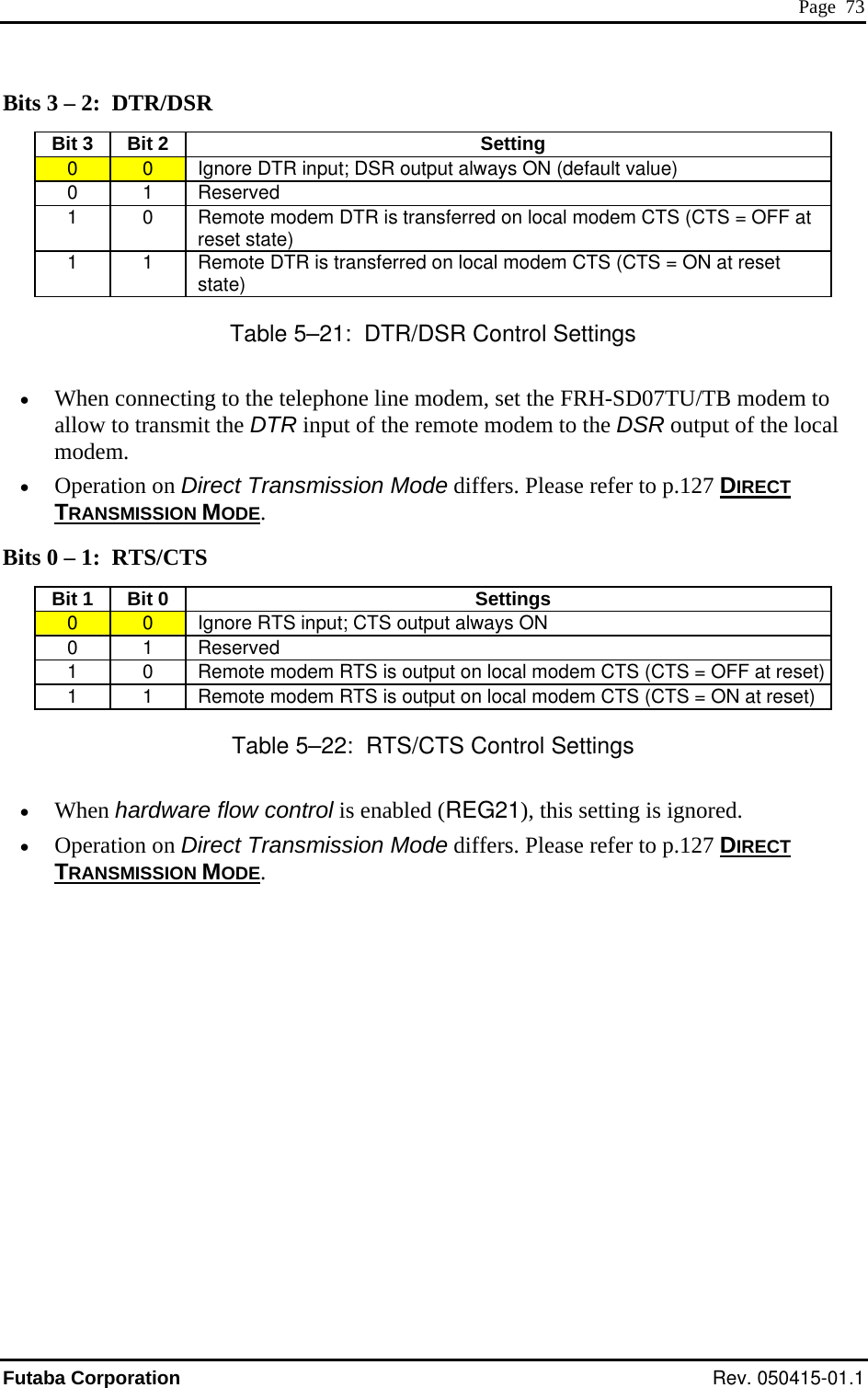
![Page 74 FRH-SD07TU/TB Manual REG [default value: 00H] 23: Miscellaneous Settings Bit 7 – 5: reserved • The FRH-SD07TU/TB does not use this register. Keep the default value as it is. Bit 4 : CR/LF addition• Especially used for the headerless packet transmission mode only. Refer to p.124 /deletion MEMORY REGISTER SETTING, IN HEADERLESS PACKET TRANSMISSION MODE. : reserved Bit 3Bit 2: RS485 collision avoidance regular interval output • The FRH-SD07TU/TB does not use this register. Keep the default value as it is. 0 No C/R code output for collision avoidance (default value) 1 ularly output C/R code for collis nce Reg ion avoidaTable 5–23: C/R Code Regular Interval Output • Sets whether t• When this bit is se 485 line if there are such responses oInterval (REG07). If there are no such responses or data exist in the buffer, the C/R Eventually it avoids the data collision on the RS485 line. • To use this function, set REG23:bit 1 of all RS485 multi-dropped modems to 1. And set all the RS485 Packet Interval (REG07) to different values more than 1.5 bytes each. Further set this bit of the modem, the RS485 Packet Interval is set to the longest, to 1. he collision avoidance function is used or not, together with bit 1. t to 1, responses or data will be output to RSr data exist in the buffer at the timeout of the RS485 Packet code (0Dh) is compulsorily output. • The effective use of this function helps to shift the output timing of multi-droppedmodems on RS485 line. Rev. 050415-01.1](https://usermanual.wiki/Futaba/FRH-SD07TU.User-Manual/User-Guide-535573-Page-90.png)
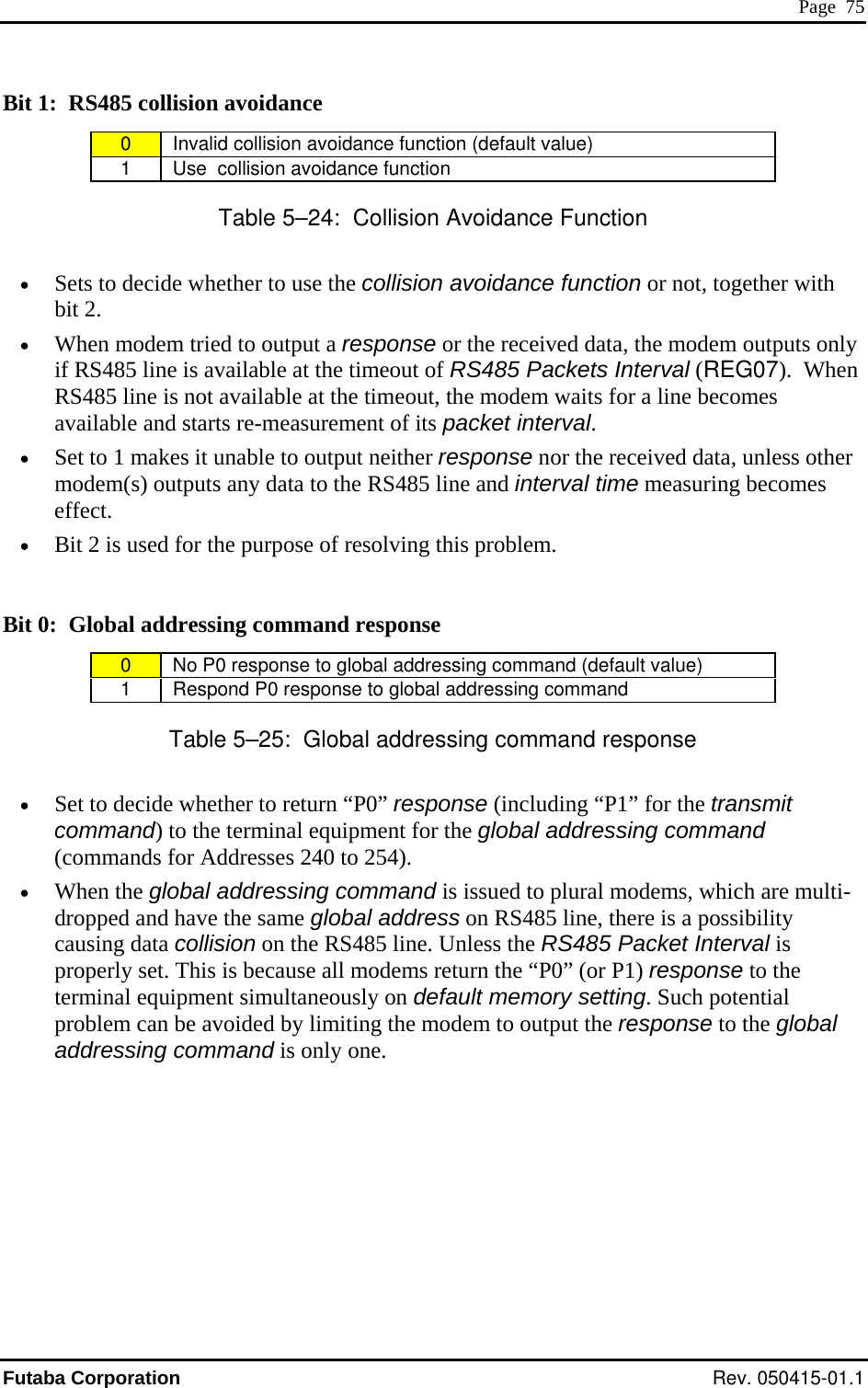
![Page 76 FRH-SD07TU/TB Manual REG24: Sp ia [default value: C0H] ec l Mode Settings Bit 7 – 6: reserved • The FRH-SD07TU/TB does not use this regiBit 5: Delay time of transmission and reception (Direct transmission mode) ster. Keep the default value as it is. 0 Same delay time as the conventional series modem (default value) 1 Sets short delay time Table 5–26: Setting of delay time of transmission and reception • ils, refer to p.127 Sets the delay time of the direct transmission mode using REG03 together. For deta DIRECT TRANSMISSION MODE ) Bit 4: DCD output(Direct transmission mode0 DCD outputs in the same way as the conventional series modem. (default value) 1 DCD acts as the synchronous clock output. Tabl ing p.127 e 5–27: Output of DCD direct transmission mode sett• Sets the direct transmission mode using REG03 together. For details, refer to DIRECT TRANSMISSION MODE. B 3• it – 0: reserved The FRH-SD07TU/TB does not use this register. Keep the default value as it is. Rev. 050415-01.1](https://usermanual.wiki/Futaba/FRH-SD07TU.User-Manual/User-Guide-535573-Page-92.png)
![Page 77 REG25: ULTRA Mode Settings [default value: 40H] Bit 7: ULTRA mode setting 0 Disable ULTRA mode (default value) 1 Enable ULTRA mode Table 5–28: ULTRA mode setting Bit 6: ULTRA mode control frequency channel setting 0 No control channel is used 1 Use control channel (default value) Table 5–29: Control frequency channel setting LTRA mode. When the control frequency is assigned, the lowest frequency of the frequency group is used as the contro eq• Sets the frequency to be wait-to-receive in the Ul fr uency. For details, refer to p.141 CONTROL FREQUENCY. Bit 5 – 0: re• The FRH-SD07TU/TB does not use this register. Keep the default value as it is. [default value: 00H] served REG26: Reserved• The FRH-SD07TU/TB does not use this register. Keep the default value as it is. Futaba Corporation Rev. 050415-01.1](https://usermanual.wiki/Futaba/FRH-SD07TU.User-Manual/User-Guide-535573-Page-93.png)
![Page 78 FRH-SD07TU/TB Manual REG27: Frequency Band Setting [default value: 01H] s Bit 7 – 6: reserved • The FR -S r. Keep the default value as it is. Bit 5 – 4: Output clock raBit 5 Bit 4 Setting H D07TU/TB does not use this registete of AUX terminal 0 0 No clock output (default value) 0 1 100KHz 1 0 1.14MHz 1 1 8MHz Table 5–30: Setting of output clock rate of AUX terminal • Sets the operation clock rate of the output signal of the AUX terminal for the status ires higclo ption. • or the function of the AUX terminal, refer to p.151 AUXILIARY INTERFACEmonitor use. Some of the status data contains high speed one-shot signals, which requh speed clock to properly catch. Because of higher current consumption when higher ck rate, this parameter controls the clock rate to decrease current consumF. B 3it – 0: Frequency band setting Bit 3 Bit 2 Bit 1 Bit 0 Setting 0 0 0 0 Invalid (forced to 0001) 0 0 0 1 2433-2479MHz (default value) 0 0 1 0 Do not set (Invalid) 0 0 1 1 01 Band 0 1 0 0 02 Band 0 1 0 1 2420-2466MHz 2MHz Separation 0 1 1 0 2423-2469MHz 2MHz Separation 0 1 1 1 Reserved 1 - - - Table 5–31: Frequency band setting • For the frequency band, refer to p.35 FREQUENCY BAND. • For the FRH-SD07TB users in France and Spain, frequency usage is restricted to 02 Band because of its country’s regulatory authority. Also please refer p.35 FREQUENCY BAND for its details. Rev. 050415-01.1](https://usermanual.wiki/Futaba/FRH-SD07TU.User-Manual/User-Guide-535573-Page-94.png)
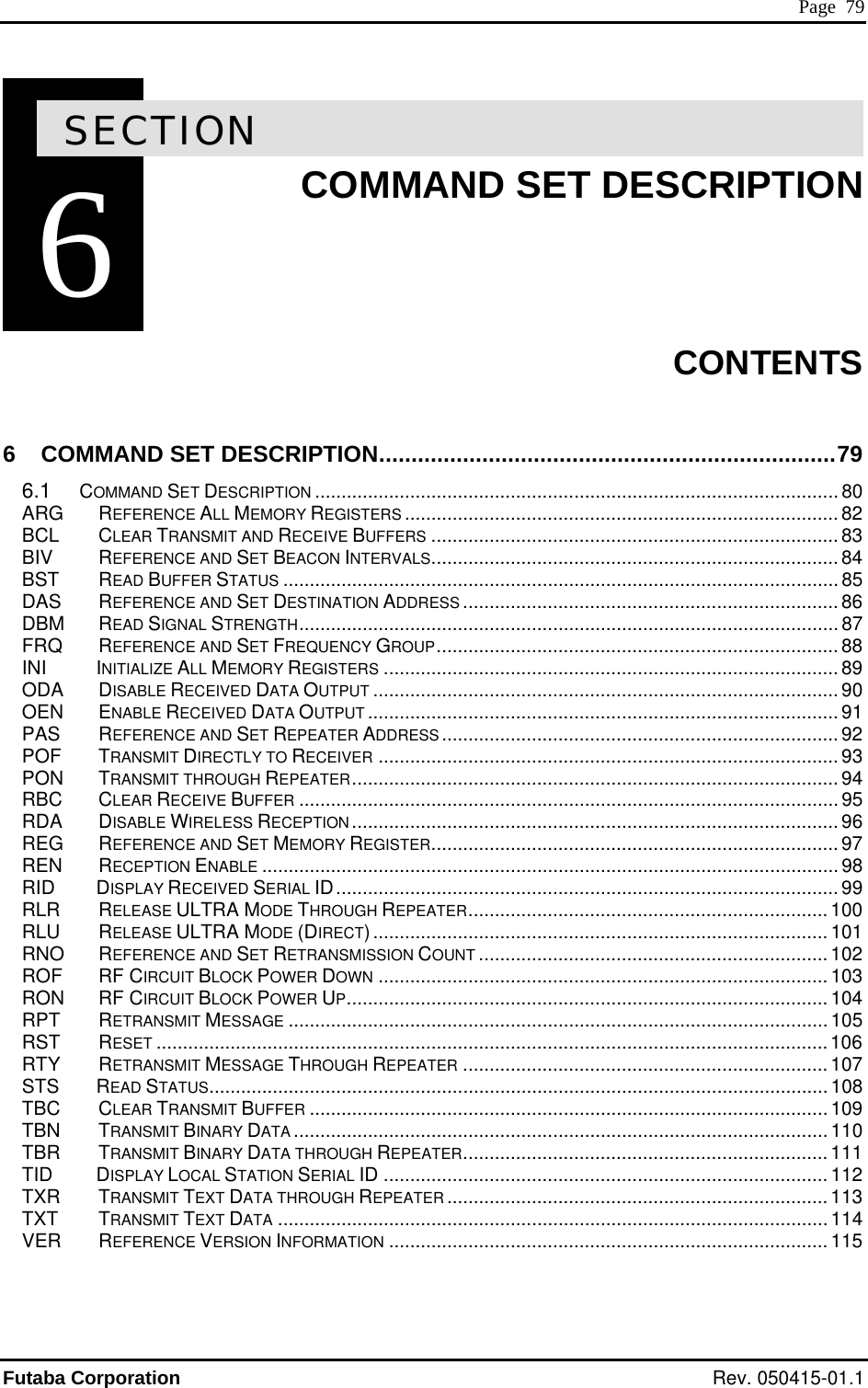
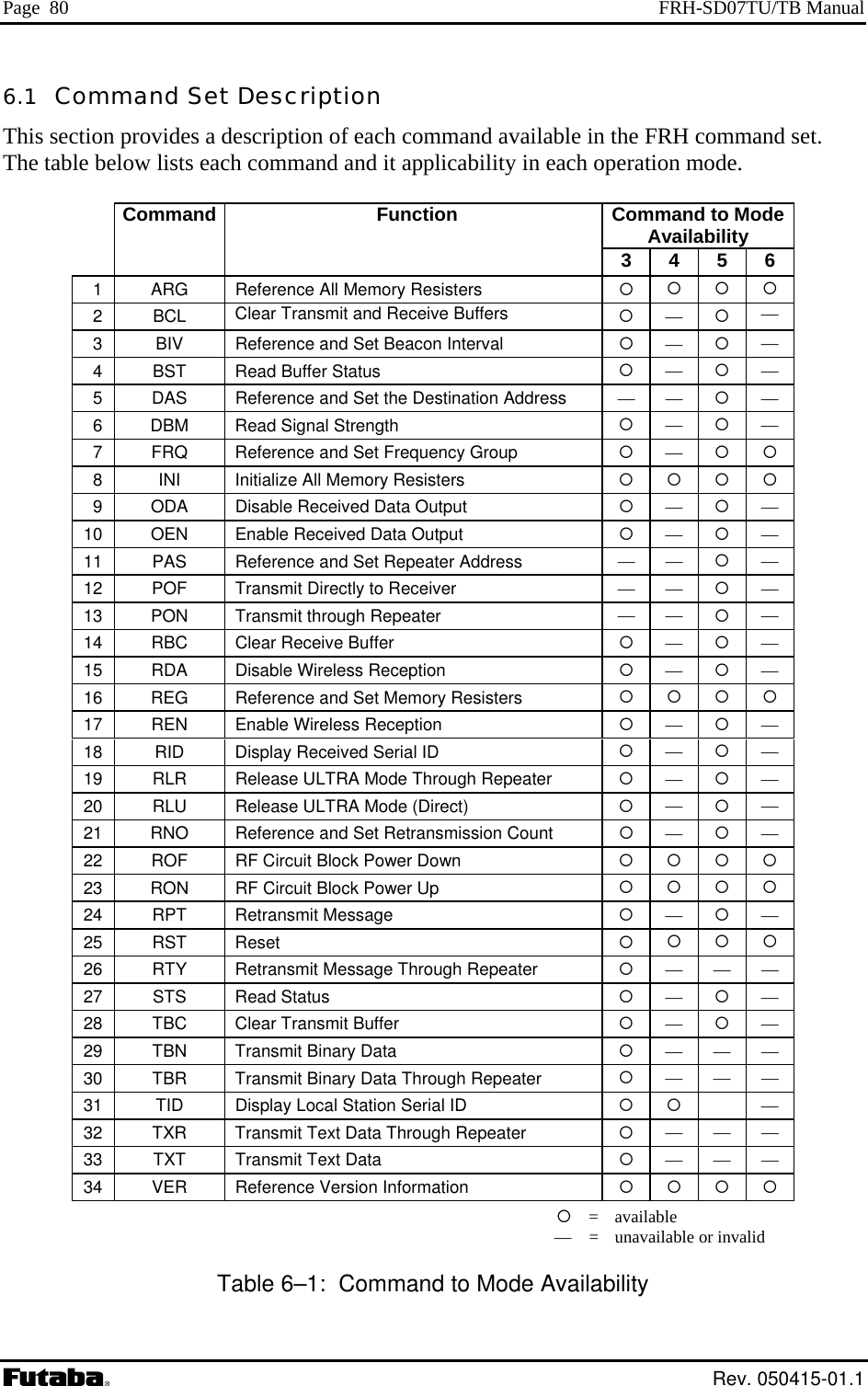
![Page 81 The symbols used in this section have the following meaning: > : Input character from the terminal equipment to the modem < : @ : CR/LF : Terminator (carriage return + line feed) [ ] : Required input parameter/s Be sure to input. ( ) : Optional input parameter/s May be omitted {} : 485 mode local station address (REG00). Be sure to input at 485 mode In the Syntax and Response segments of the following command descriptions the symbol (CR/LF) has been omitted for clarity. Output from the modem to the terminal equipment Command header terminator Futaba Corporation Rev. 050415-01.1](https://usermanual.wiki/Futaba/FRH-SD07TU.User-Manual/User-Guide-535573-Page-97.png)
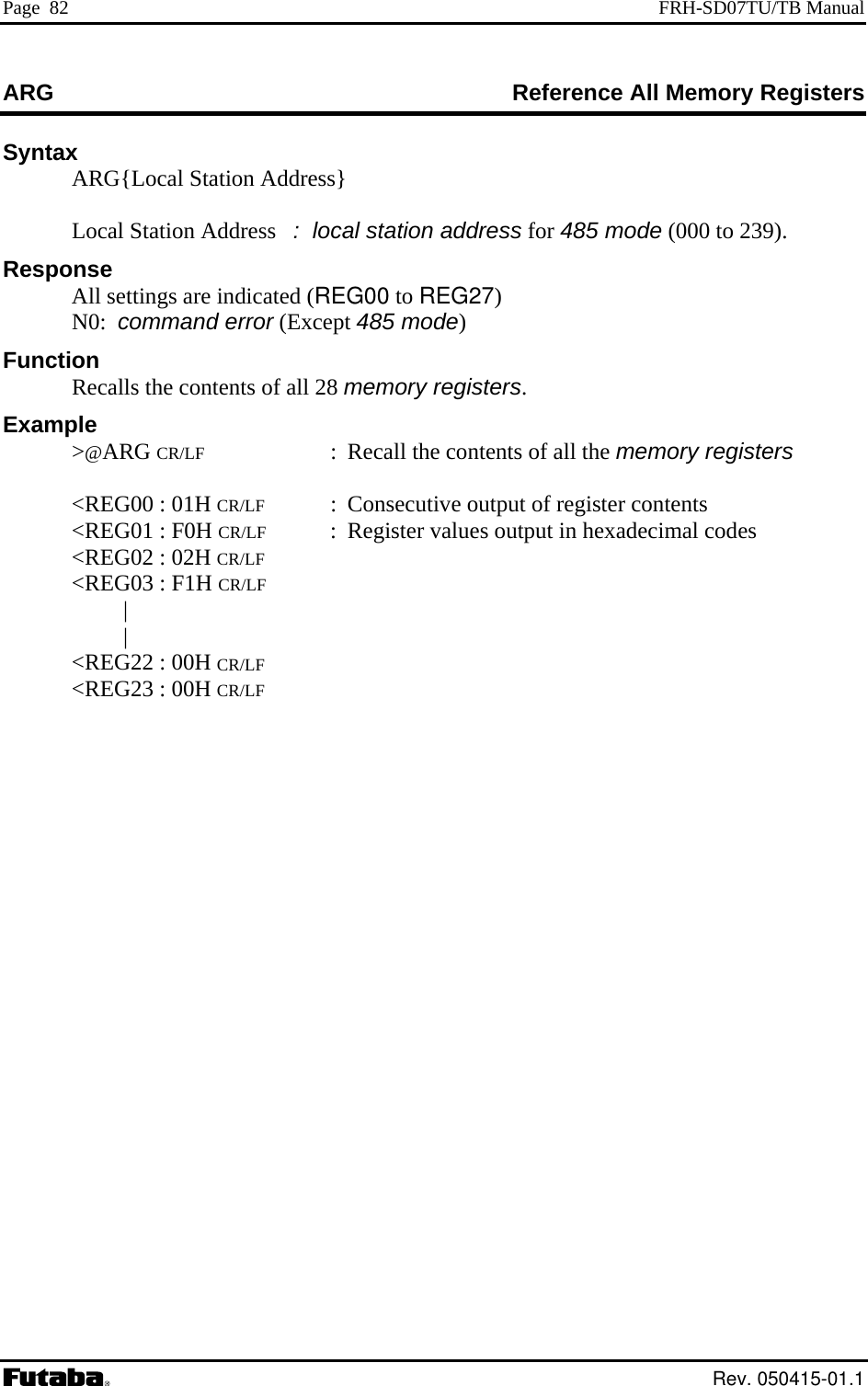
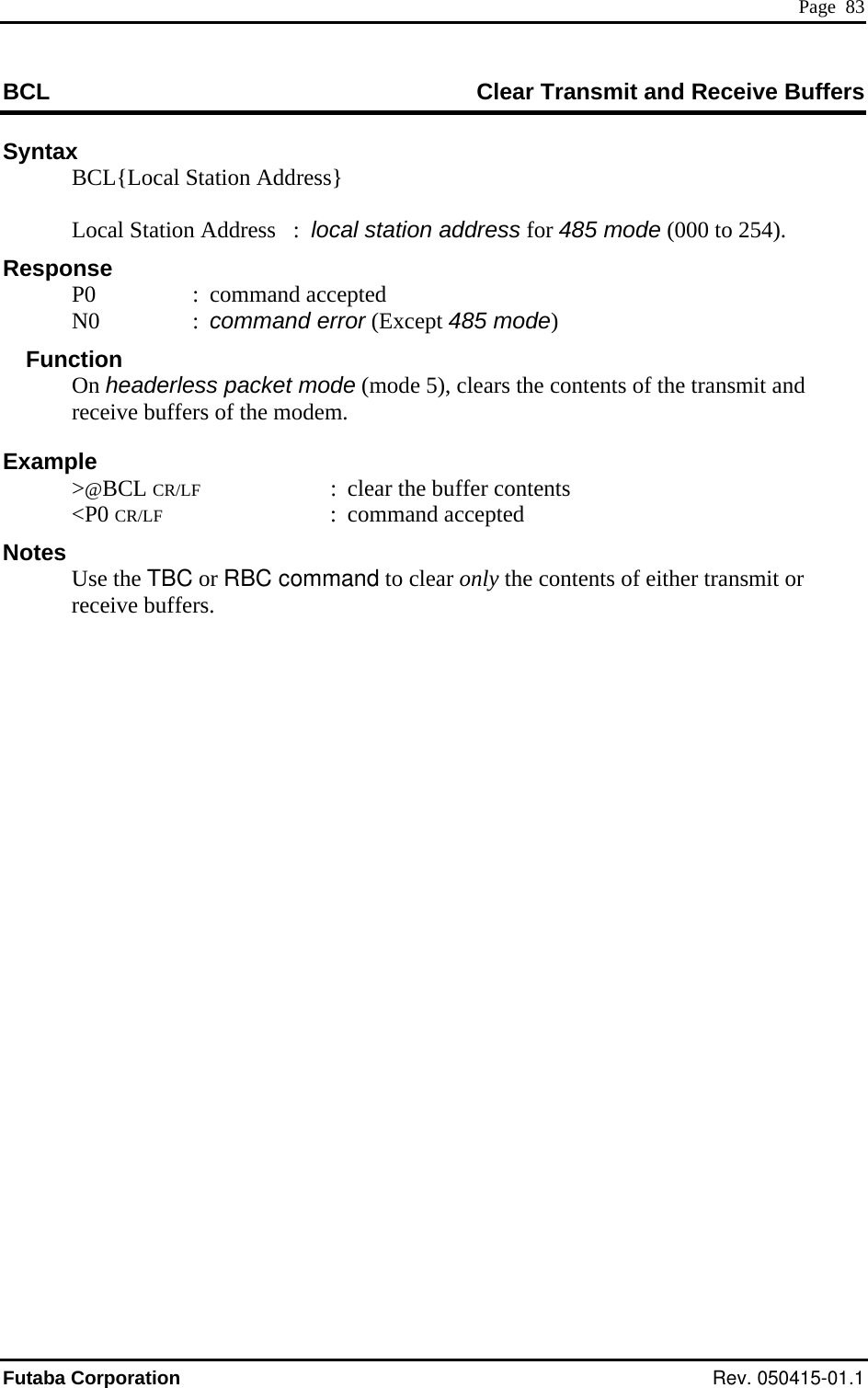
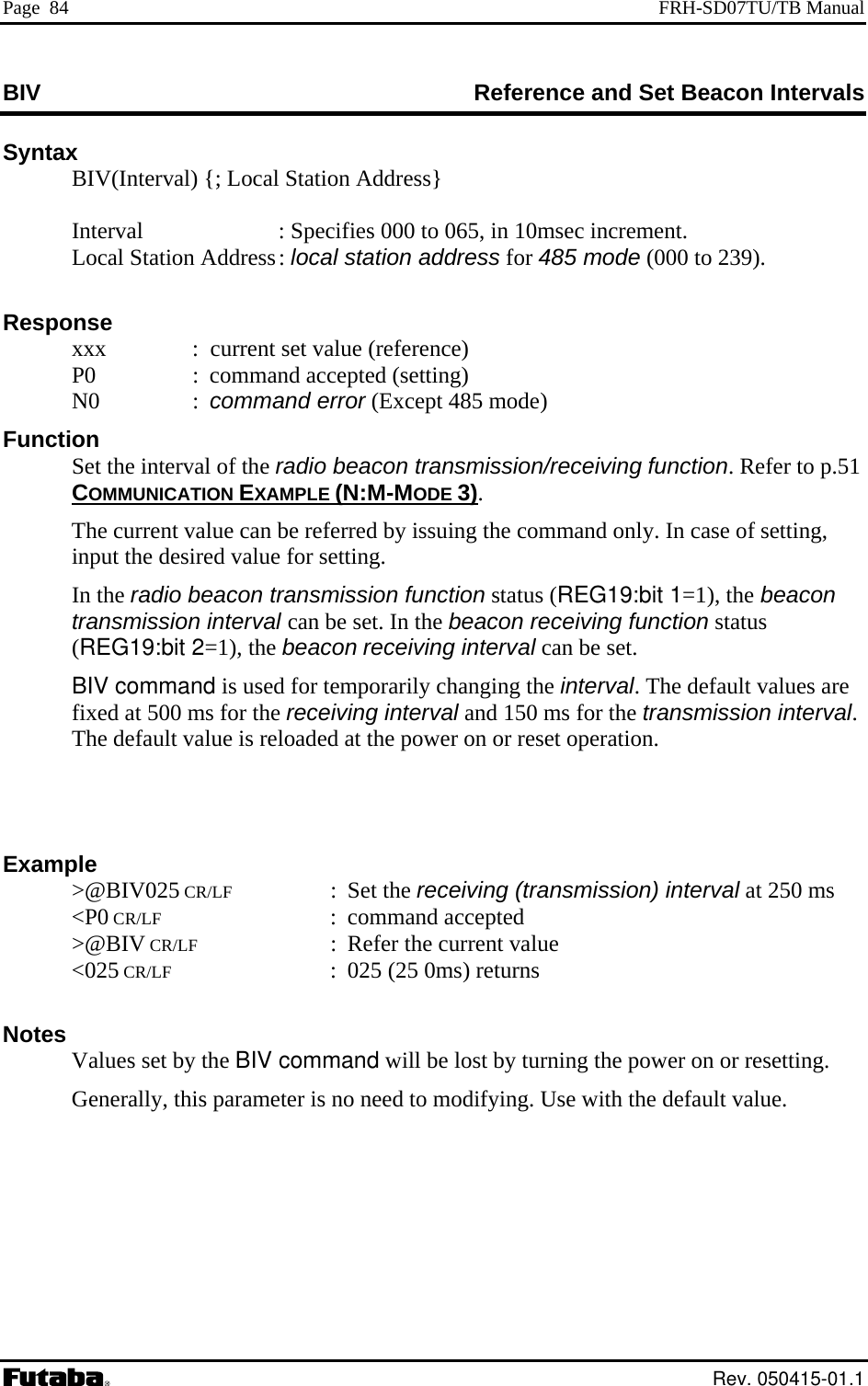
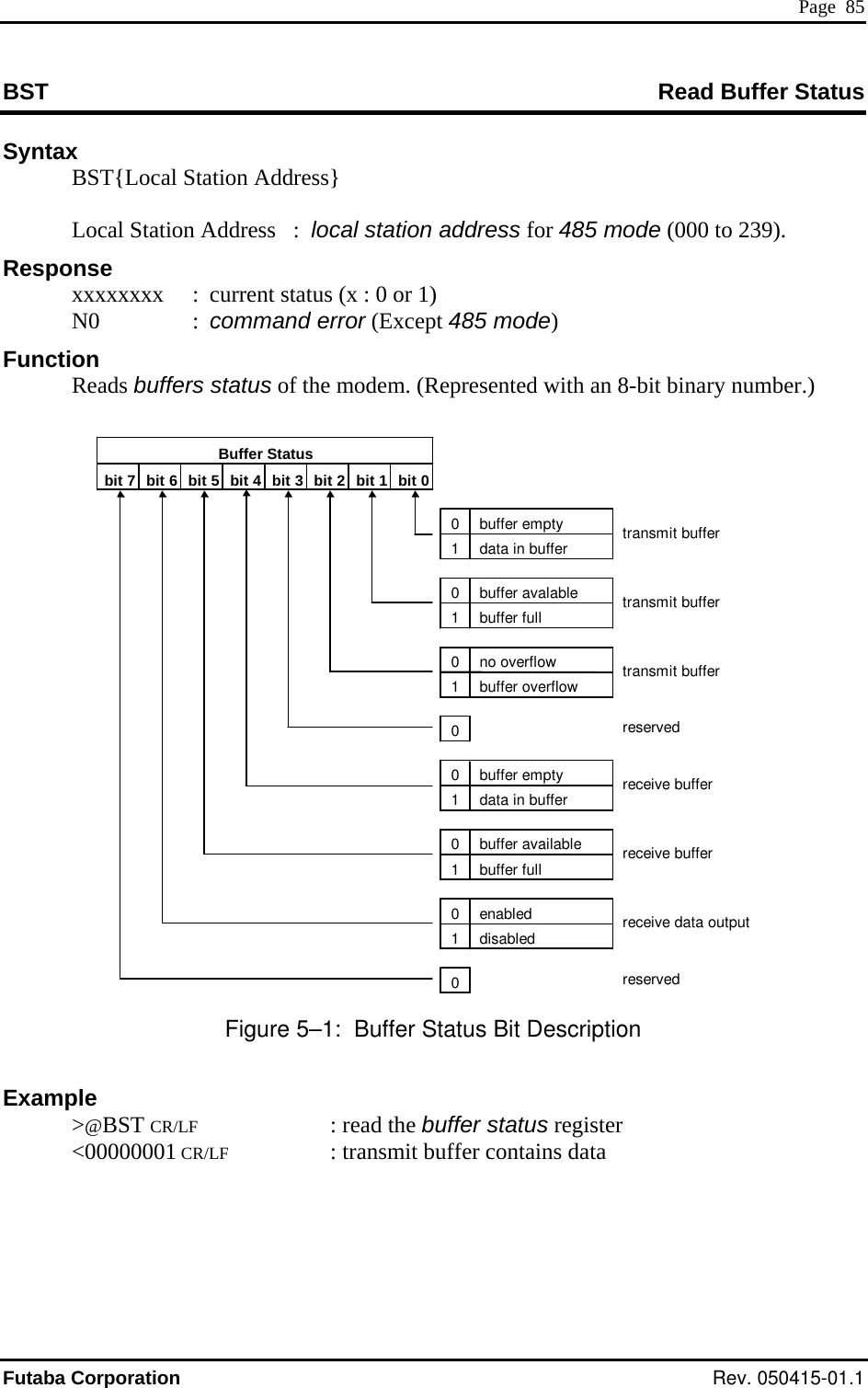
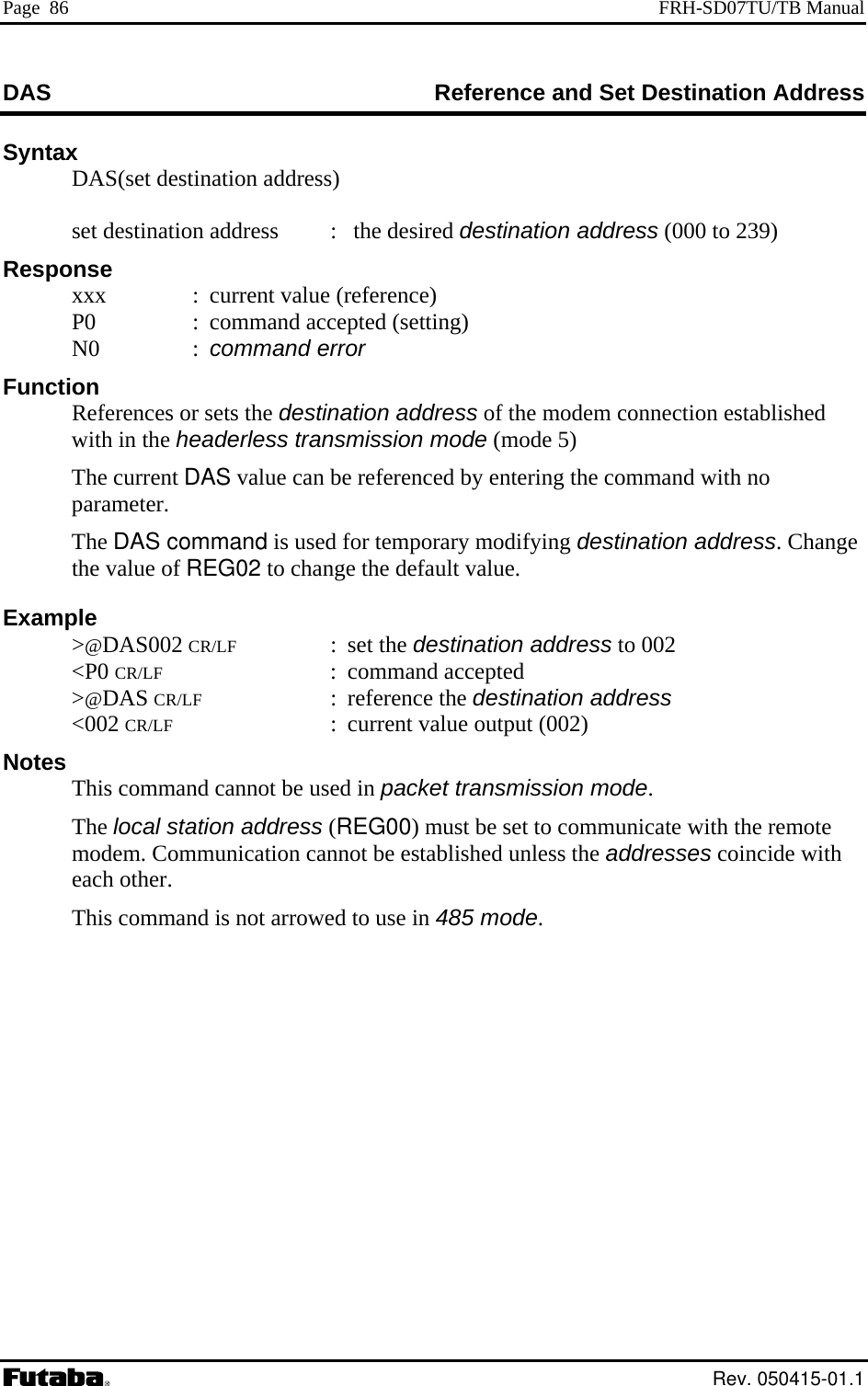
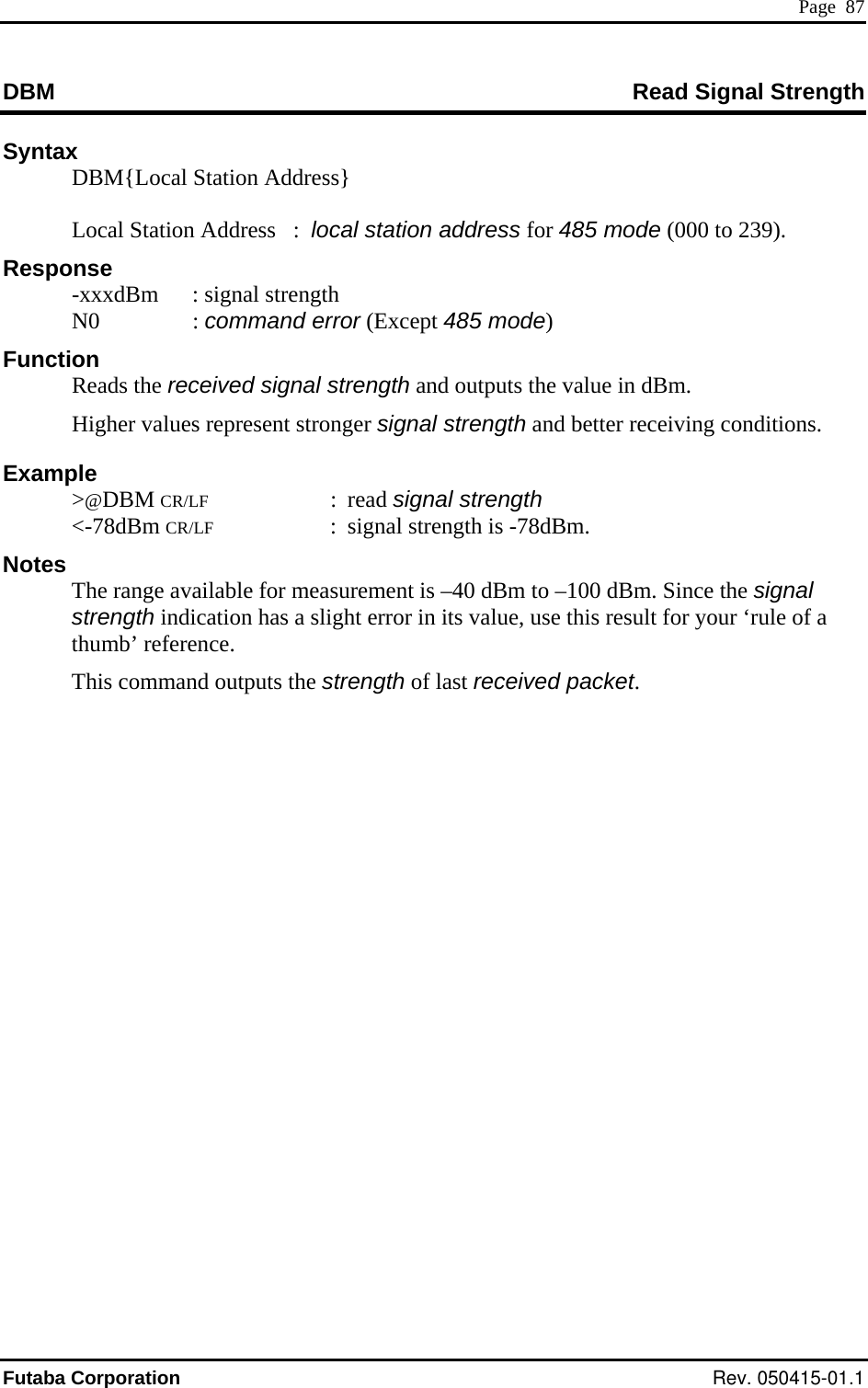
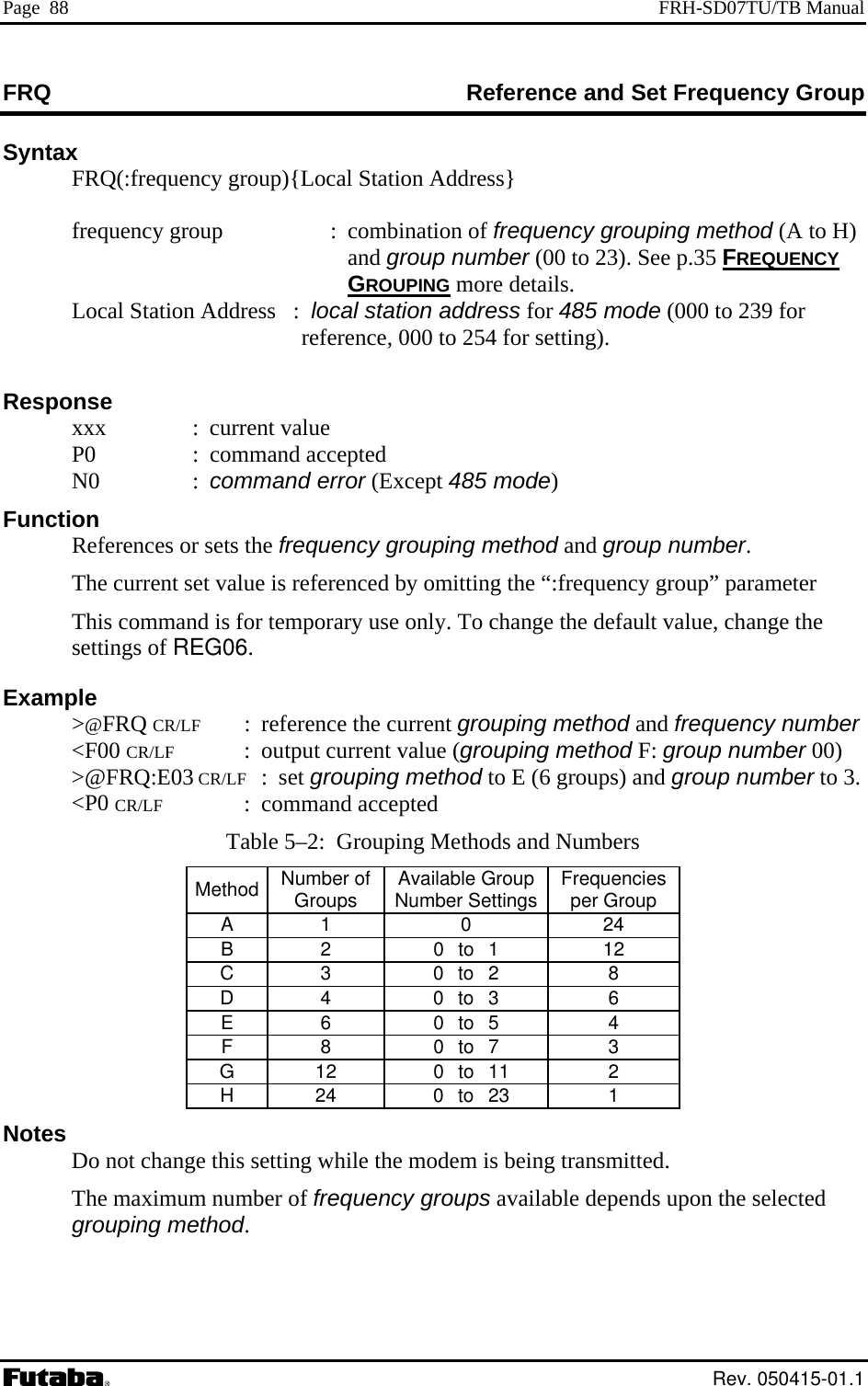
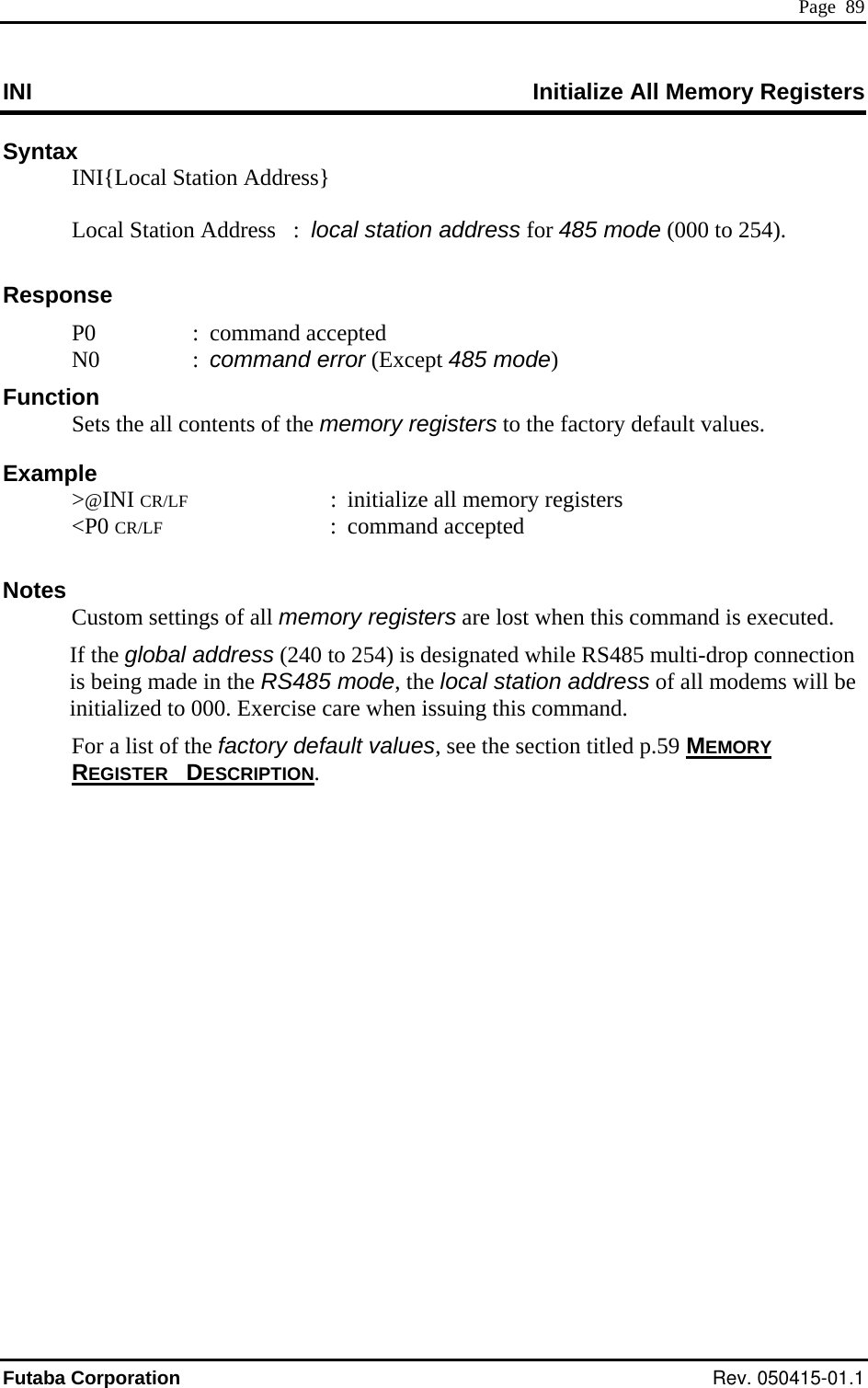
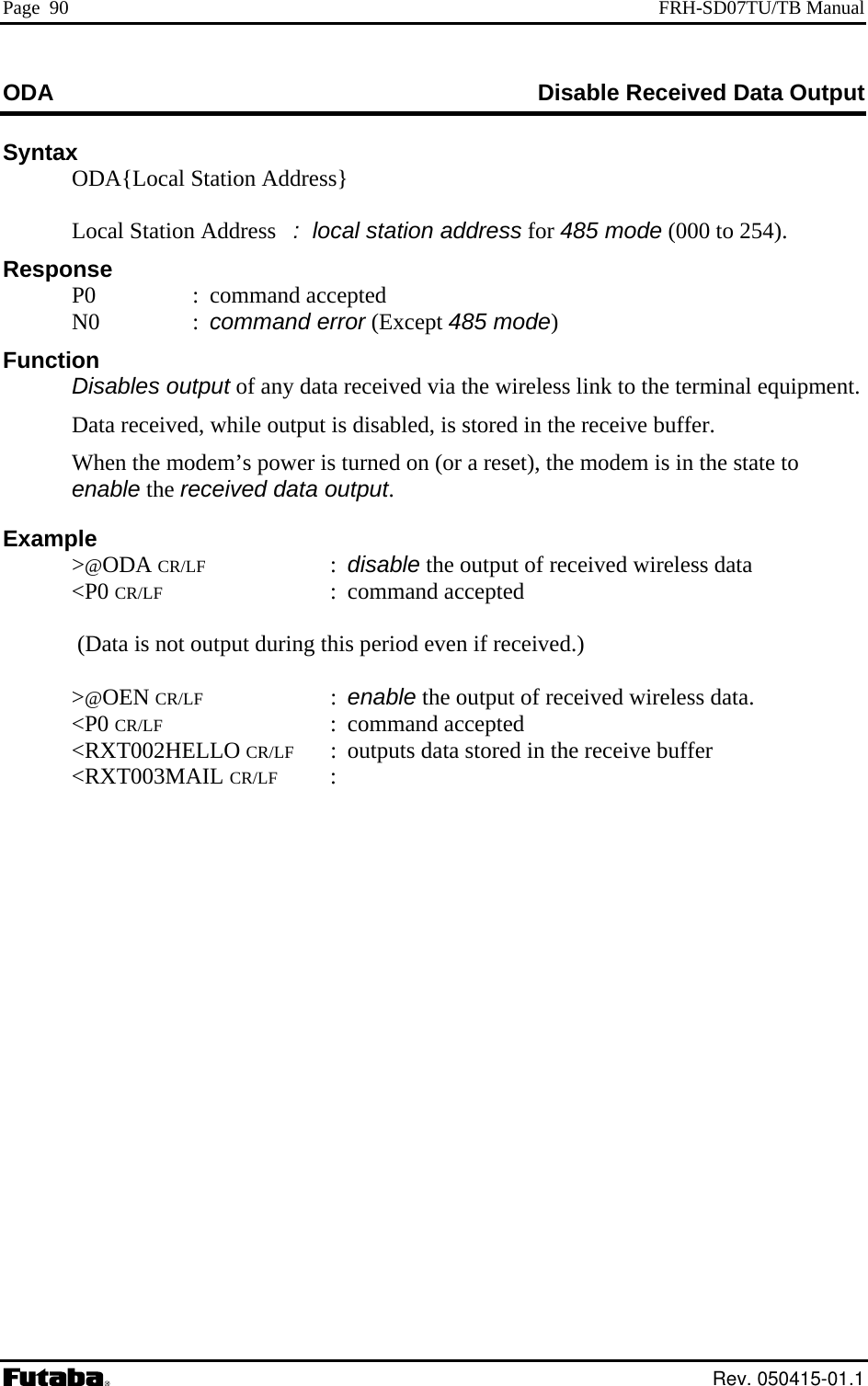
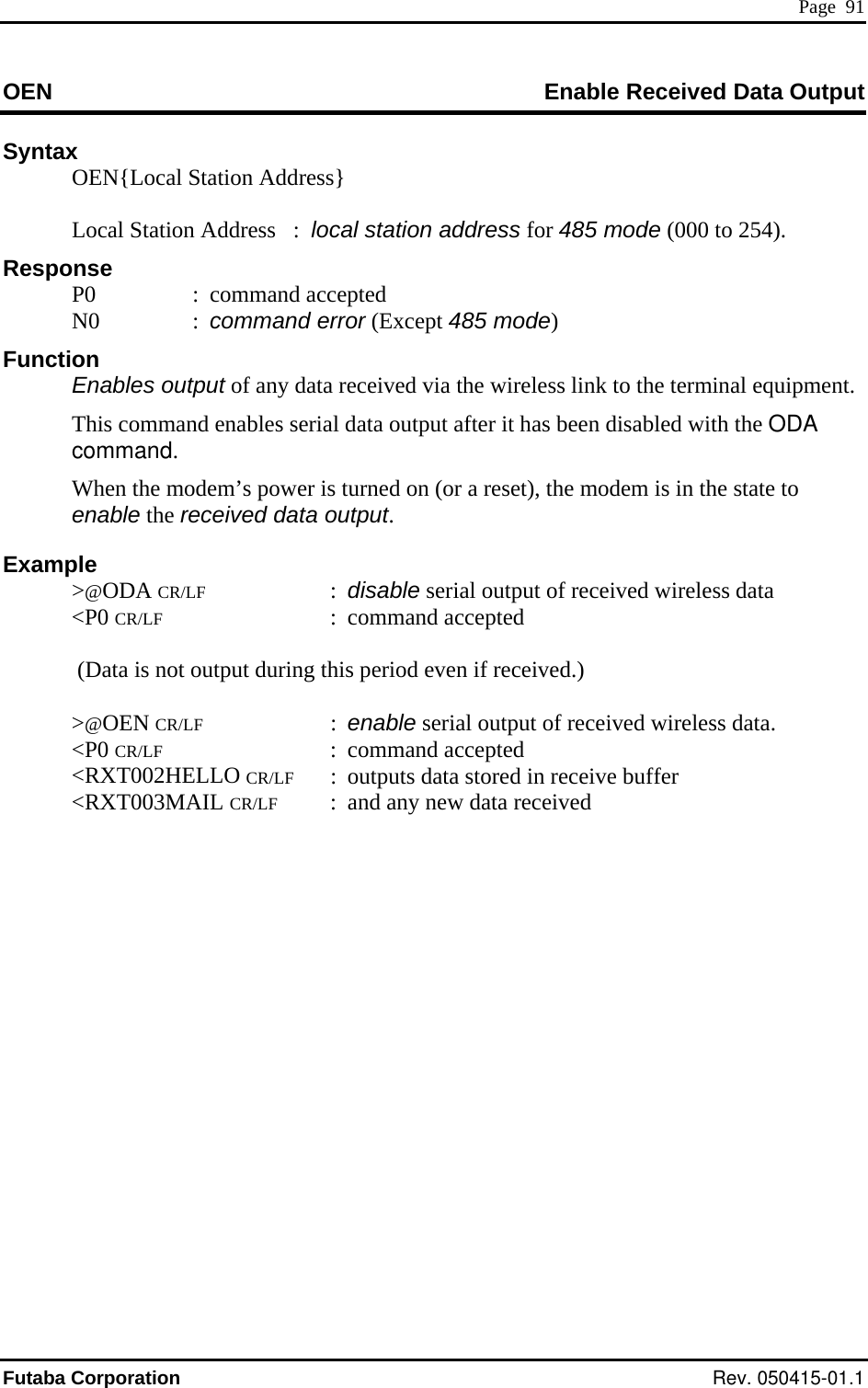
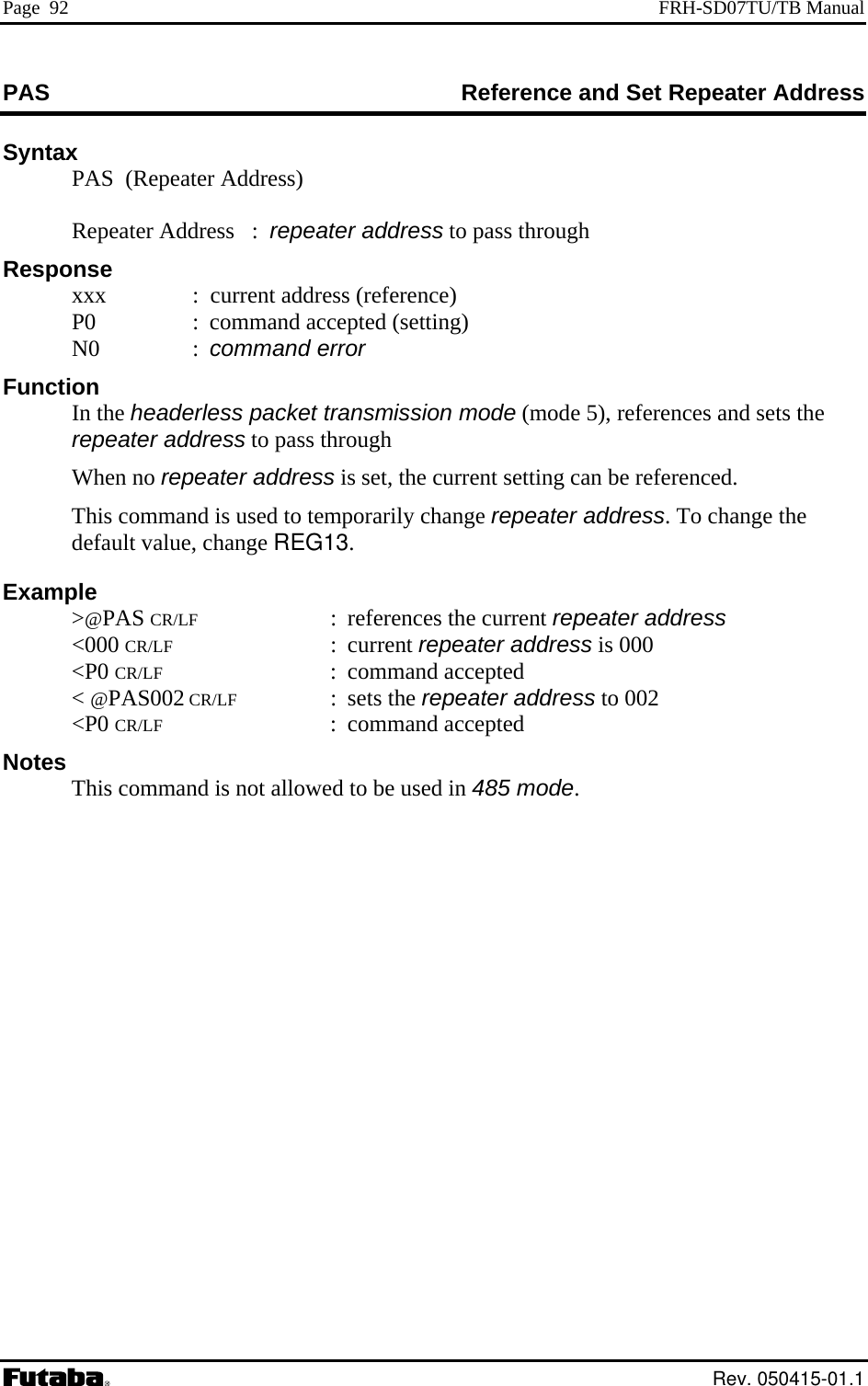
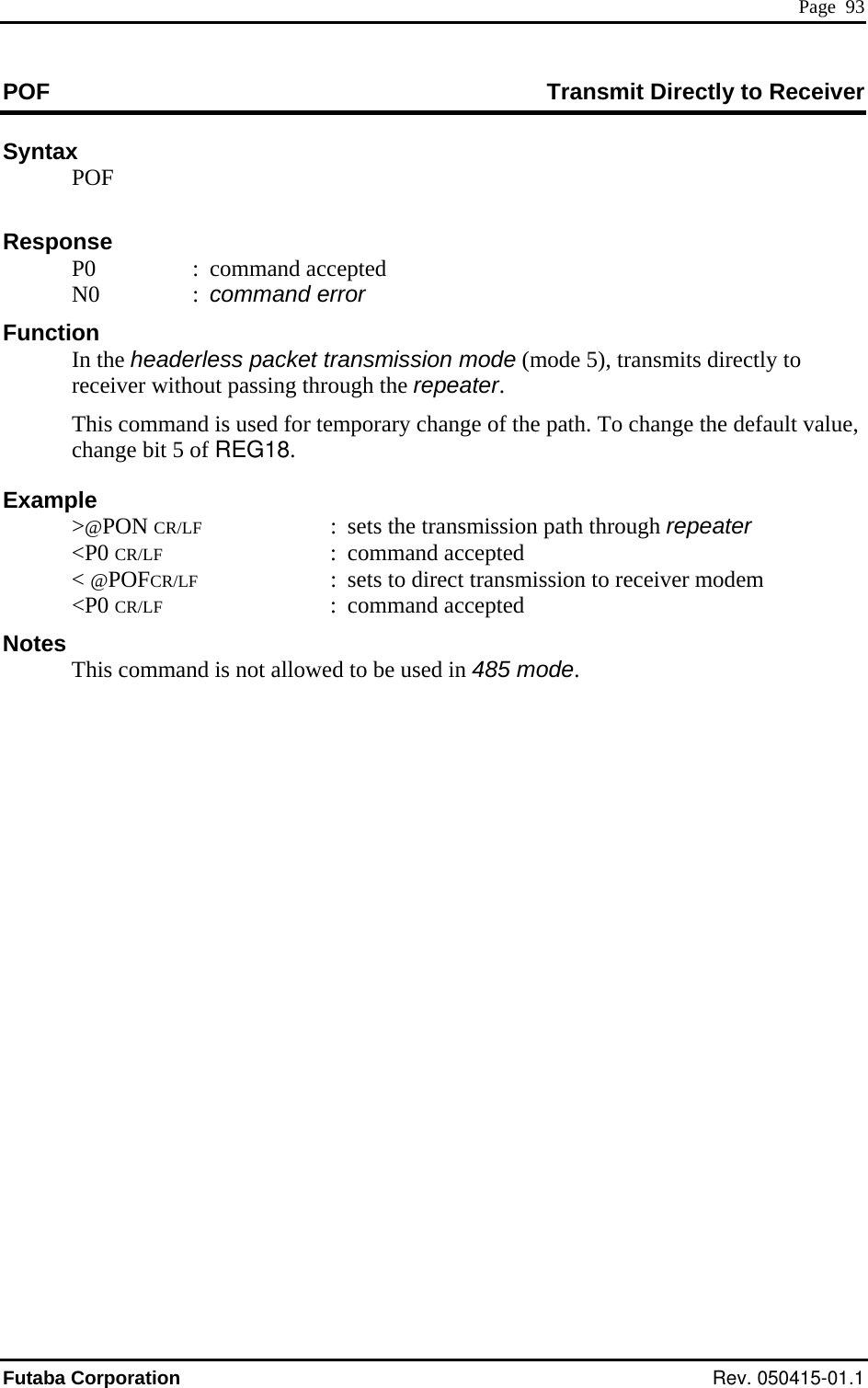
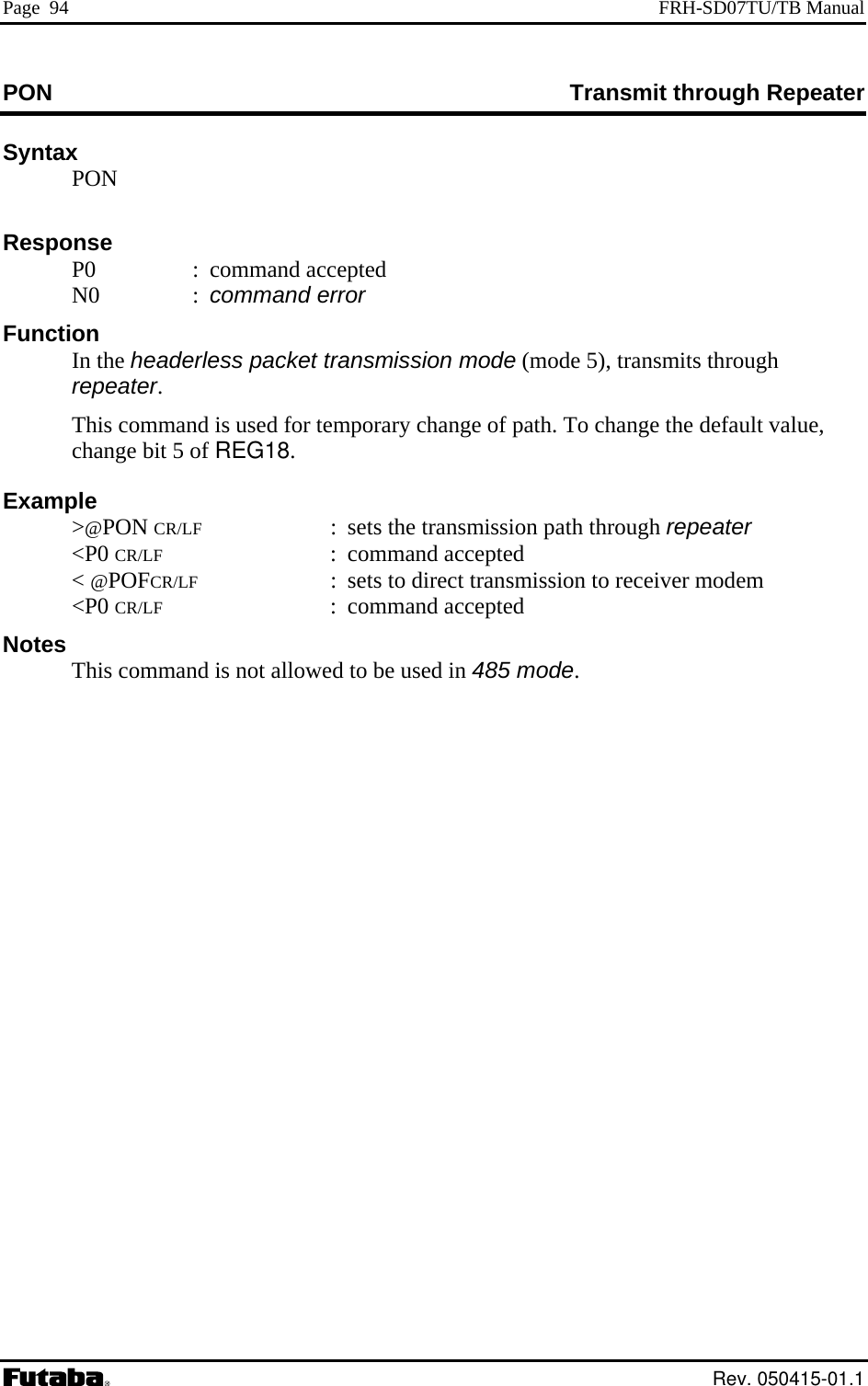
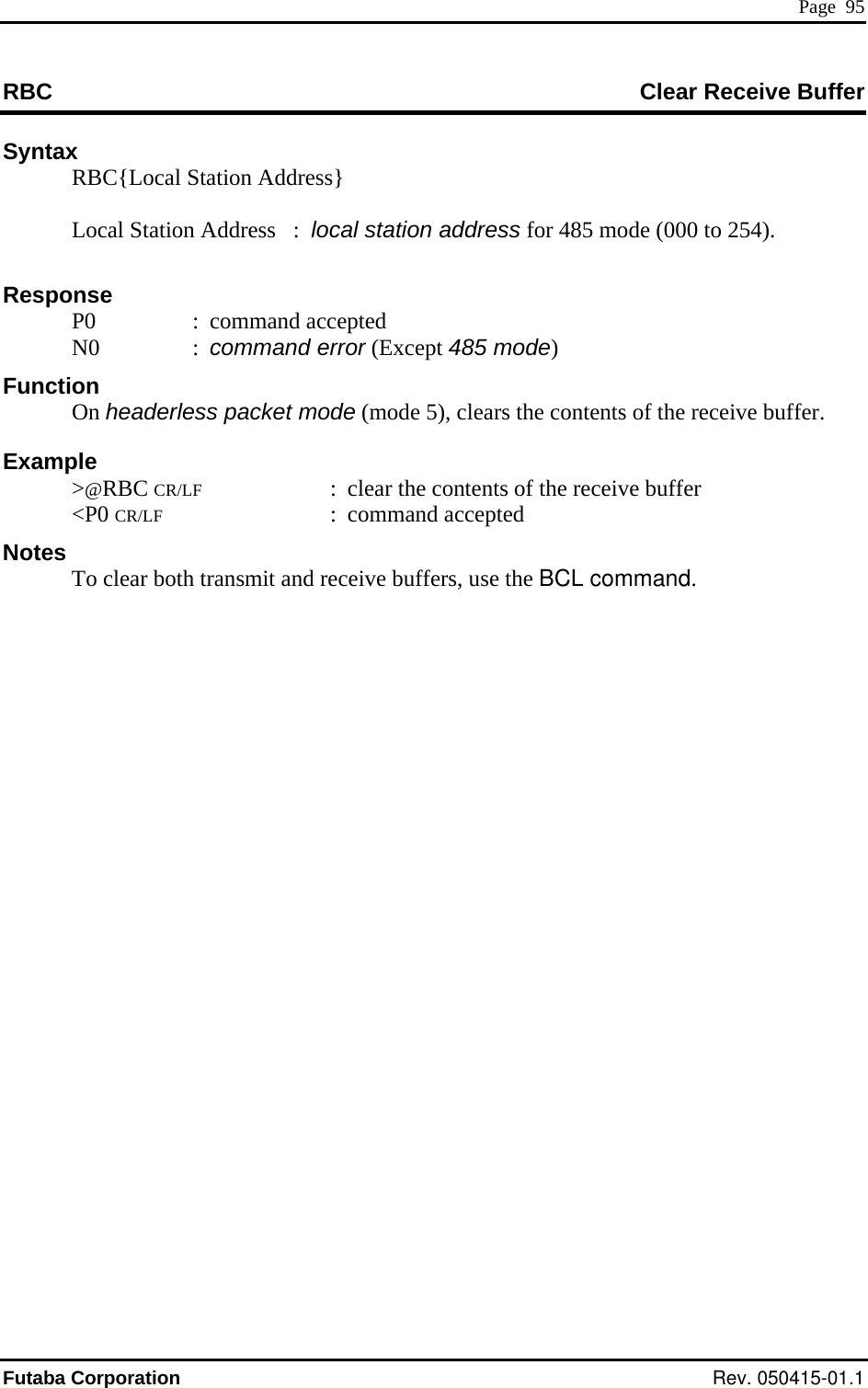
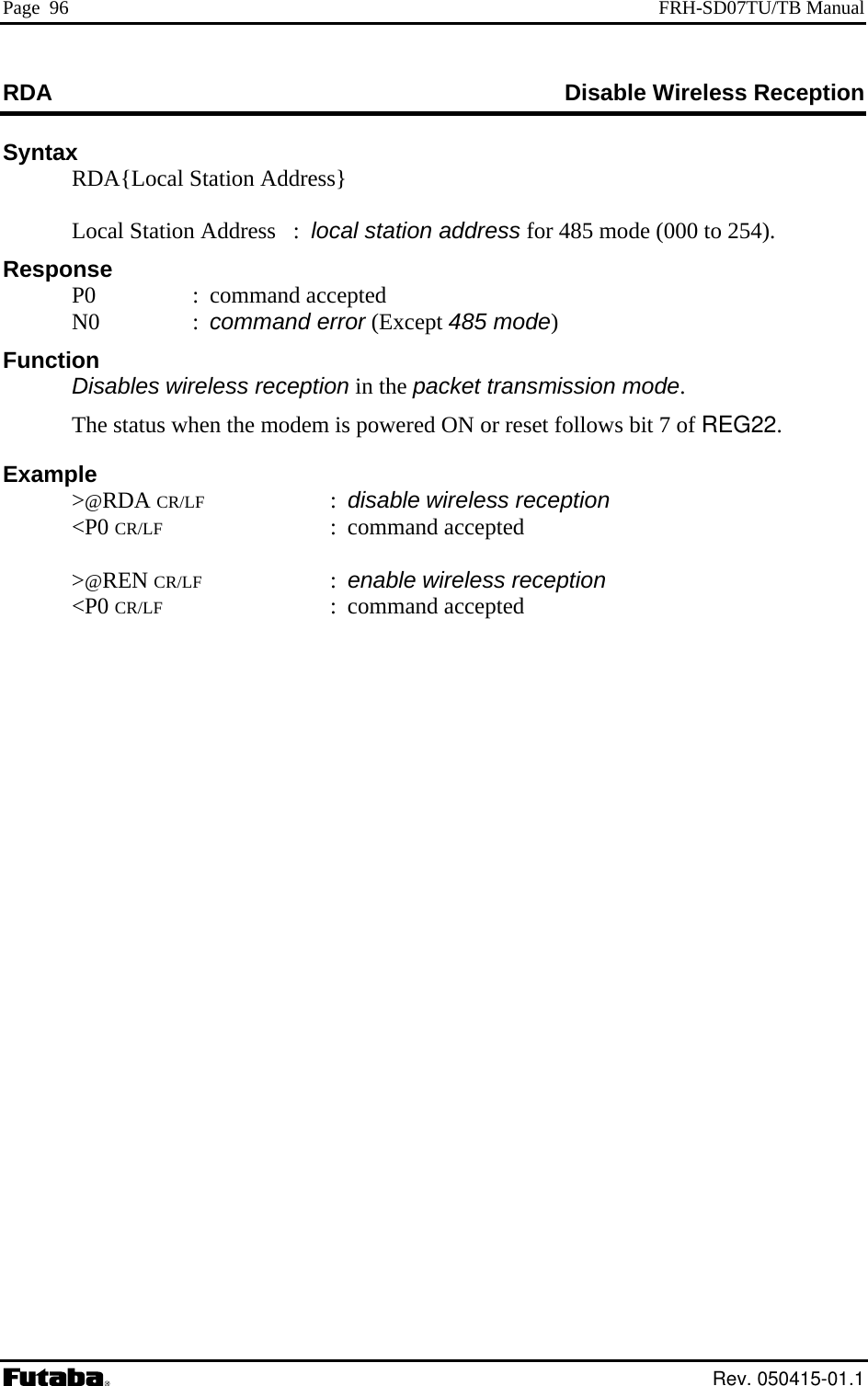
 {;Local Station Address} value : value to be set. Input 2 hexadecimal digits (0 through 9 and A through F) followed by the number radix . or 485 mode (000 to 239 for r setting). : current value (reference) ommand acc The current register value is referenced by omitting the “value” parameter. Example >@REG00 CR/LF : reference the contents of register 00 <01H CR/LF : displays current value >@REG00 : 02H CR/LF : set value of memory register 00 to 02H (hexadecimal) <P0 CR/LF : command accepted Notes The register can be rewritten sequentially. However, to make its parameter valid after rewriting it, re-supply the power, reset the modem using the Shutdown mode pin (Pin 11 of the serial communication connector) or use RST command. While rewriting the memory register, do not turn off the power until response is output. Otherwise, the memory registers content may be collapsed. When the response of the memory register write error is output, set the values after initializing the memory register. register number : register number to be set (00 to 23) designator H Local Station Address : local station address freference, 000 to 254 fo Response xxH P0 : c epted (setting) N0 : command error (Except 485 mode) N6 : memory register write error Function References or sets memory registers. Futaba Corporation Rev. 050415-01.1](https://usermanual.wiki/Futaba/FRH-SD07TU.User-Manual/User-Guide-535573-Page-113.png)
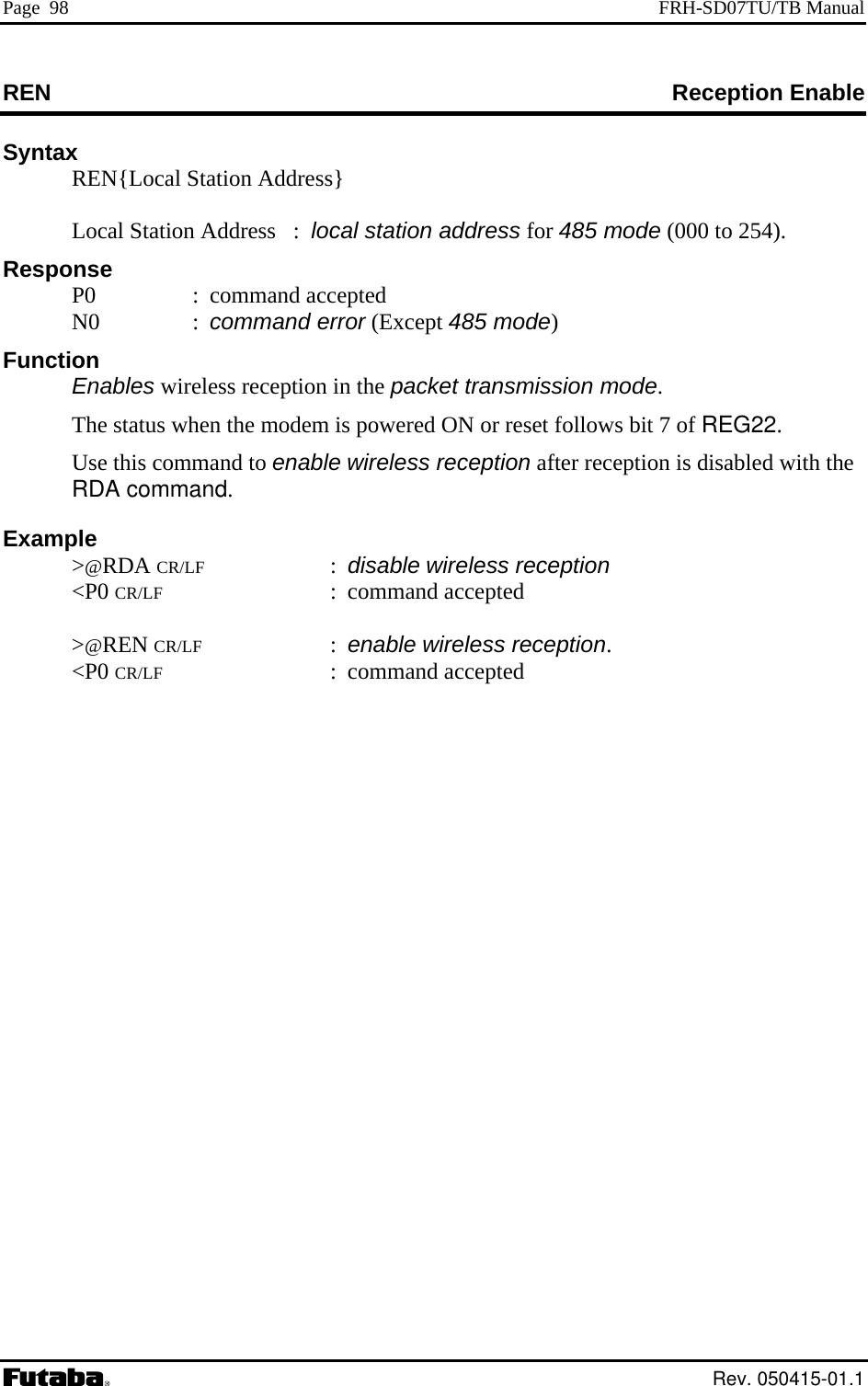
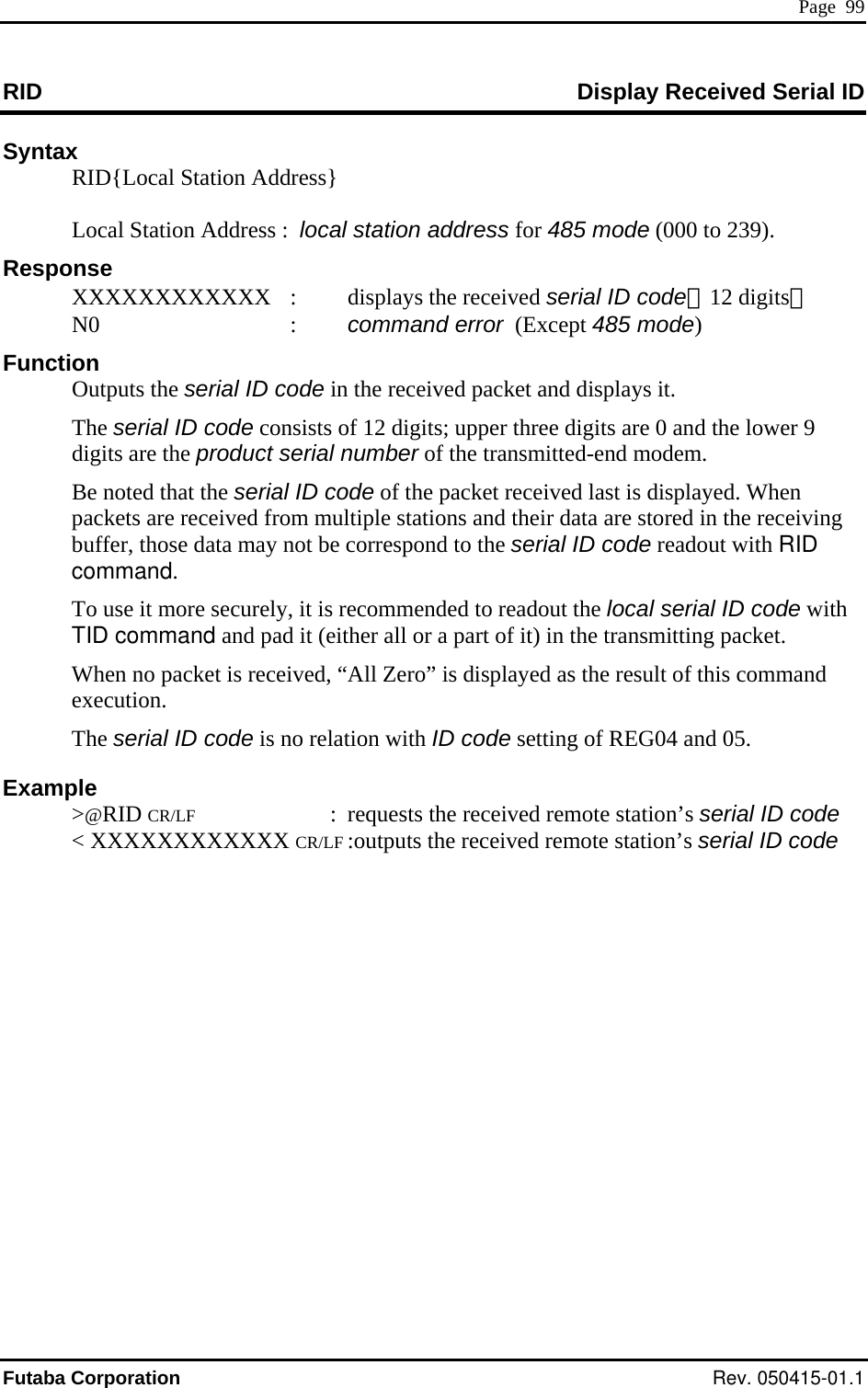
![Page 100 FRH-SD07TU/TB Manual RLR ode Through Repeater Release ULTRA MSyntax RLR [repeater address] [destination address]{Local Station Address} ation address : address of destination station (000 to 239, set to 255 for mode release) 85 mode (000 to 254). lease the ULTRA N1 ode release request transmission complete r Transient LTRA wakeup broadcast case). To confirm that the destination station returns to the Active mode, attempt communication with the destination station using TXR command. Example >@RLR100001 CR/LF : transmitting to Station 001 the request to release the ULTRA mode from the repeater 100. <P1 CR/LF : transmitting the Wakeup transmission request signal <N1 CR/LF : request signal transmission completes (unknown whether succeeded or failed) >@ RLR100255 CR/LF : transmits the broadcast request signal to release the ULTRA mode <P1 CR/LF : transmitting the request signal < P0 CR/LF : request signal transmission completes (unknown whether succeeded or failed) repeater address : address of repeater to pass through (000 to 239) destin broadcast ULTRA Local Station Address : local station address for 4 Response P1 : command accepted. Transmitting, the request to remode through the repeater. P0 : Broadcast ULTRA mode release request transmission complete N0 : command error (Except 485 mode) : ULTRA mFunction Makes the destination station(s) in the ULTRA (Ultra Low-poweRadio Access) mode return to the Active mode by transmitting Urequest packet from the repeater. Local modem just send the request to the repeater. At the command completion, “N1” response is output from in any case (P1 to Rev. 050415-01.1](https://usermanual.wiki/Futaba/FRH-SD07TU.User-Manual/User-Guide-535573-Page-116.png)
![Page 101 RLU ease ULTRA Mode (Direct) RelSyntax RLU [destination address]{Local Station Address} 55 for all station) to ULTRA mode release loc Funct Makes stination station(s) in the ULTRA (Ultra Low-power Transient ” e pt communication with the destination station using TXT command. e ULTRA e operation, but operating in the Active mode, will return “release success receives the W. Example >@RLU001 CR/LF : transmitting to Station 001 Wakeup request packet, the request to release the ULTRA mode <P1 CR/LF : transmitting the Wakeup request packet <N1 CR/LF : release failed >@ RLU002 CR/LF : transmits to Station 001 the Wakeup request packet <P1 CR/LF : transmitting the Wakeup request packet <P0 CR/LF : release succeeded >@ RLU255 CR/LF : transmits to all stations Wakeup request packet <P1 CR/LF : transmitting the Wakeup request packet <P0 CR/LF : transmission of Wakeup request packet completes (unknown whether it is succeeded or failed) destination address : address of destination station (000 to 239, set to 2 Local Station Address : al station address for 485 mode (000 to 254). Response P0 : ULTRA mode successfully released P1 : command received. transmitting the Wakeup request packet of the ULTRA mode N0 : command error (Except 485 mode) N1 : failed in releasing the ULTRA mode (no response from the destination station) ion the deRadio Access) mode return to the Active mode by transmitting Wakeup request packet, ULTRA mode release signal. In case of all station’s ULTRA mode release (broadcast), the modem outputs “P0response in any case. To confirm that the destination station returns to the Activmode, attemWhen the destination station, its REG 25:bit 7 is set to 1 which allows thmodACK” when it akeup request packet , ULTRA mode release signalTherefore, the response to the RLU command is “P0”. Futaba Corporation Rev. 050415-01.1](https://usermanual.wiki/Futaba/FRH-SD07TU.User-Manual/User-Guide-535573-Page-117.png)
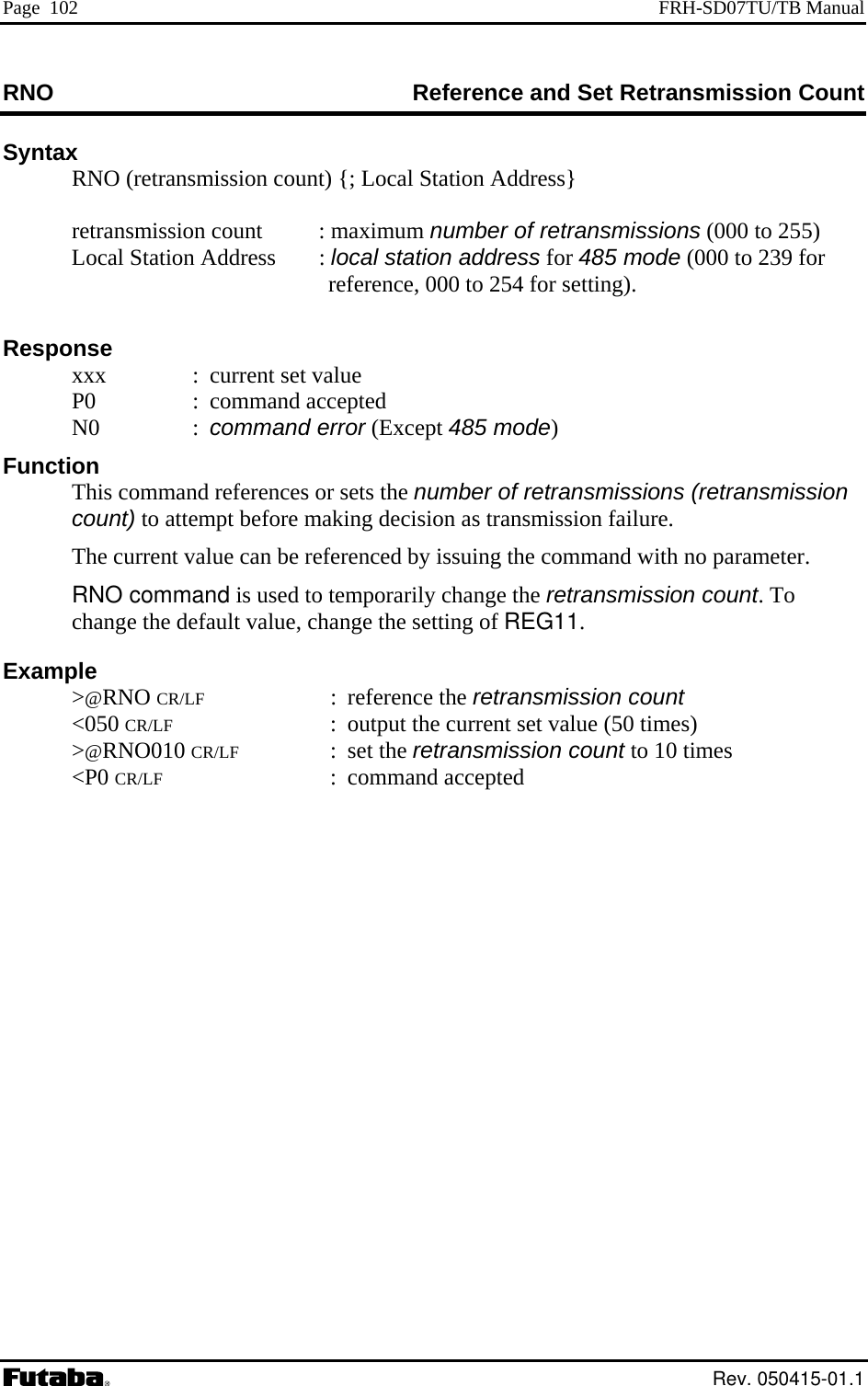
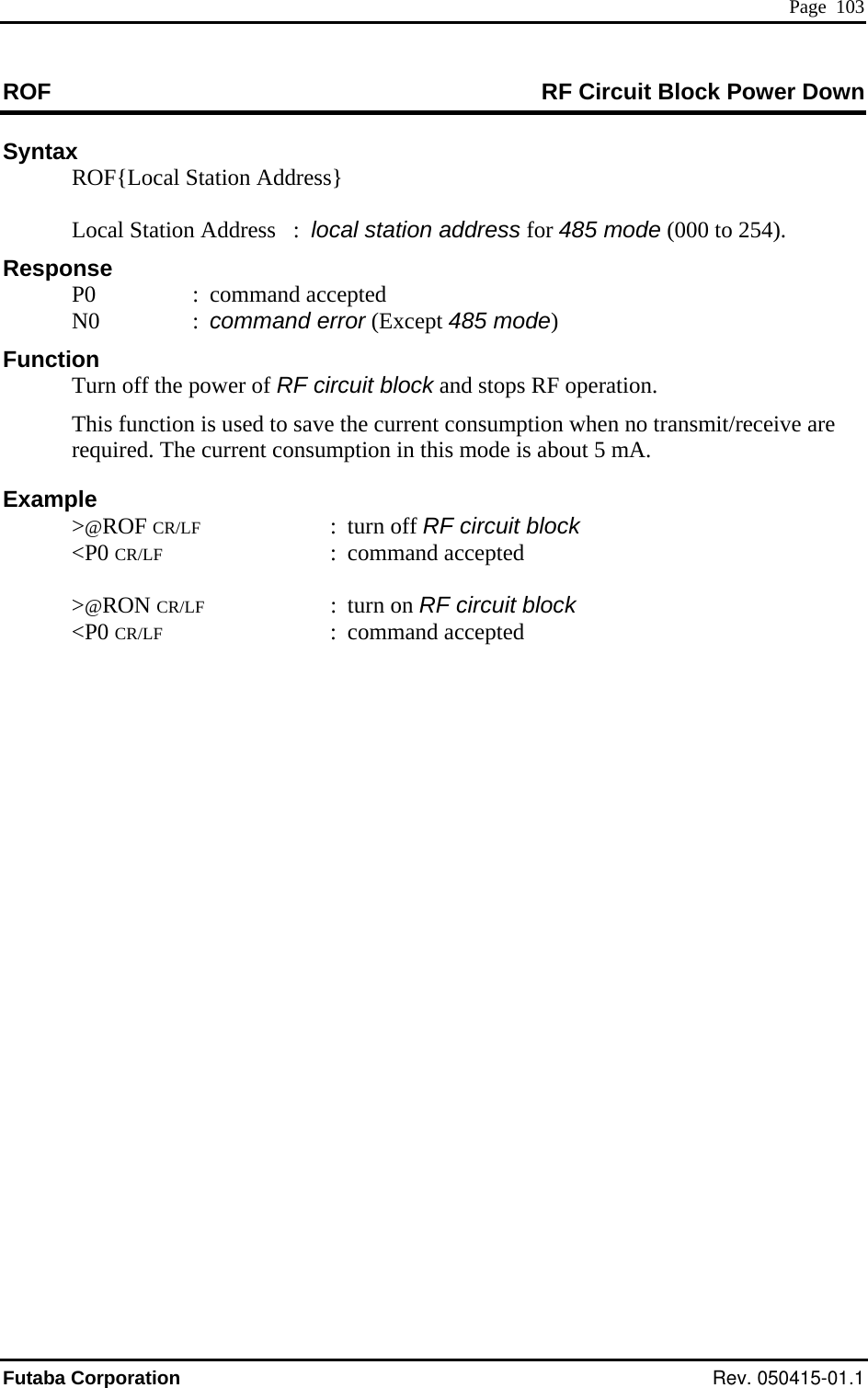
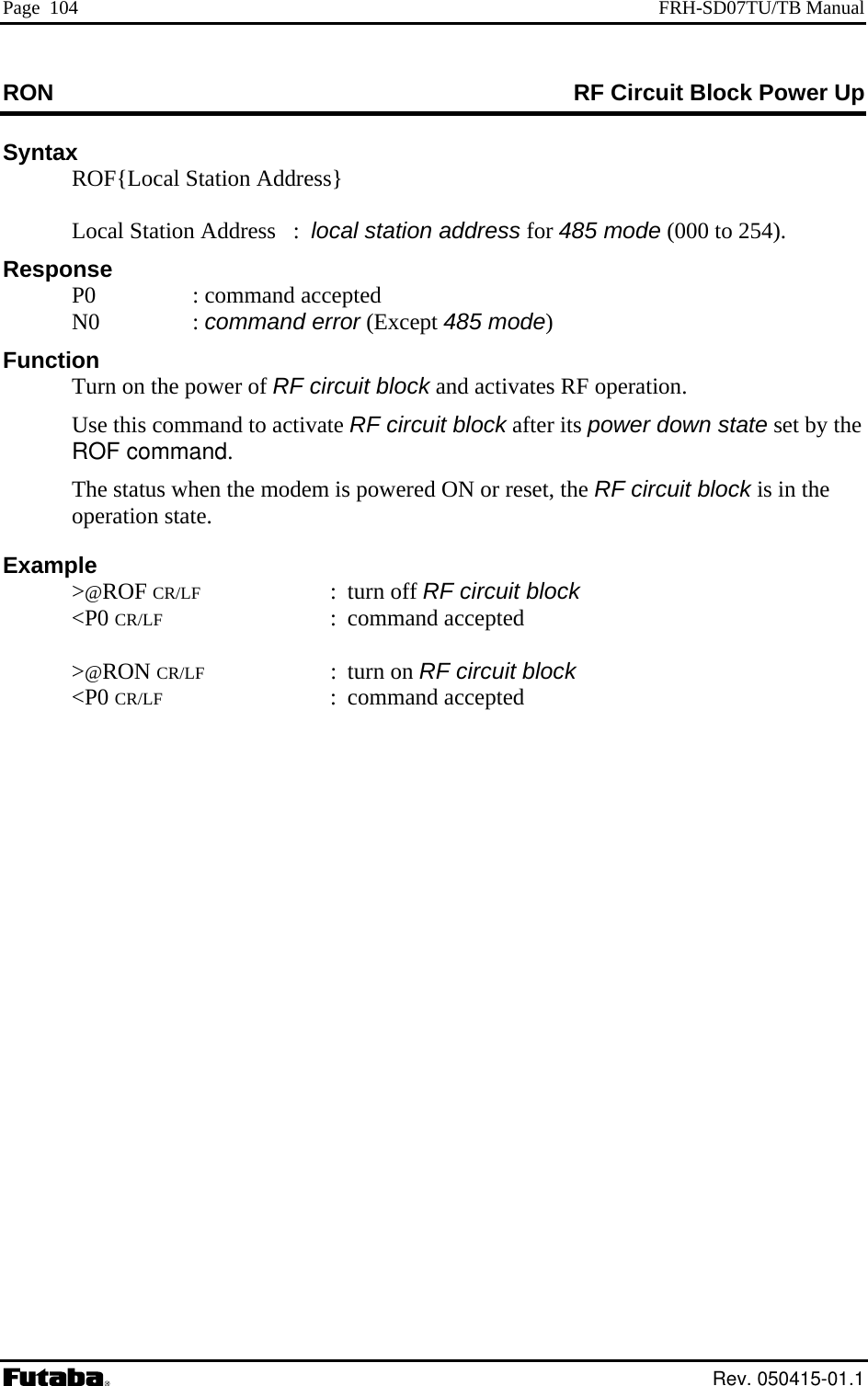
![Page 105 RPT Retransmit Message Syntax RPT [destination address]{Local Station Address} set 240 to 254 for global addressed destination dcast transmission 85 mode (000 to 254). tion : data transmission failed -- destination station is in the reception disabled state : data transmission failed -- destination station cannot receive because its receive its the lasata to a different station. For broadcasting messages to multiple modems, set the destination address to 255. In this case, the modem retransmit the message the number of times of the Retransmission count plus 1, and then it will return “P0”. Example >@TXT002HELLO CR/LF : transmit “HELLO” from station 001 to station 002 <P1 CR/LF : data being transmitted <N1 CR/LF : transmission failed. >@RPT002 CR/LF : retransmit “HELLO” from station 001 to station 002 <P1 CR/LF : data being transmitted <P0 CR/LF : data transmission succeeded >@RPT003 CR/LF : transmit “HELLO” from station 001 to station 003 <P1 CR/LF : data being transmitted <P0 CR/LF : data transmission succeeded Notes Follow the last transmit command’s form of transmission, text or binary, or whether passing through repeater or not. In case of broadcast transmission, the receiving result of the destination station cannot be confirmed at the sender end. Before invoking this command, execute any transmit command of TXT, TXR, TBN, or TBR. There are important notes using transmit commands. Be sure to read p.158 OPERATION IMPORTANT NOTICE destination address : address of destination station (000 to 239) set 255 for broaLocal Station Address : local station address for 4Response P0 : data transmission succeeded P1 : command accepted, data being transmitted. P2 : data packet reached to repeater N0 : command error (Except 485 mode) N1 : data transmission failed -- no response from destination sta N2 N3 buffer is full F unction Retransm t message. Use this command to retransmit the same data or transmit the same d. Futaba Corporation Rev. 050415-01.1](https://usermanual.wiki/Futaba/FRH-SD07TU.User-Manual/User-Guide-535573-Page-121.png)
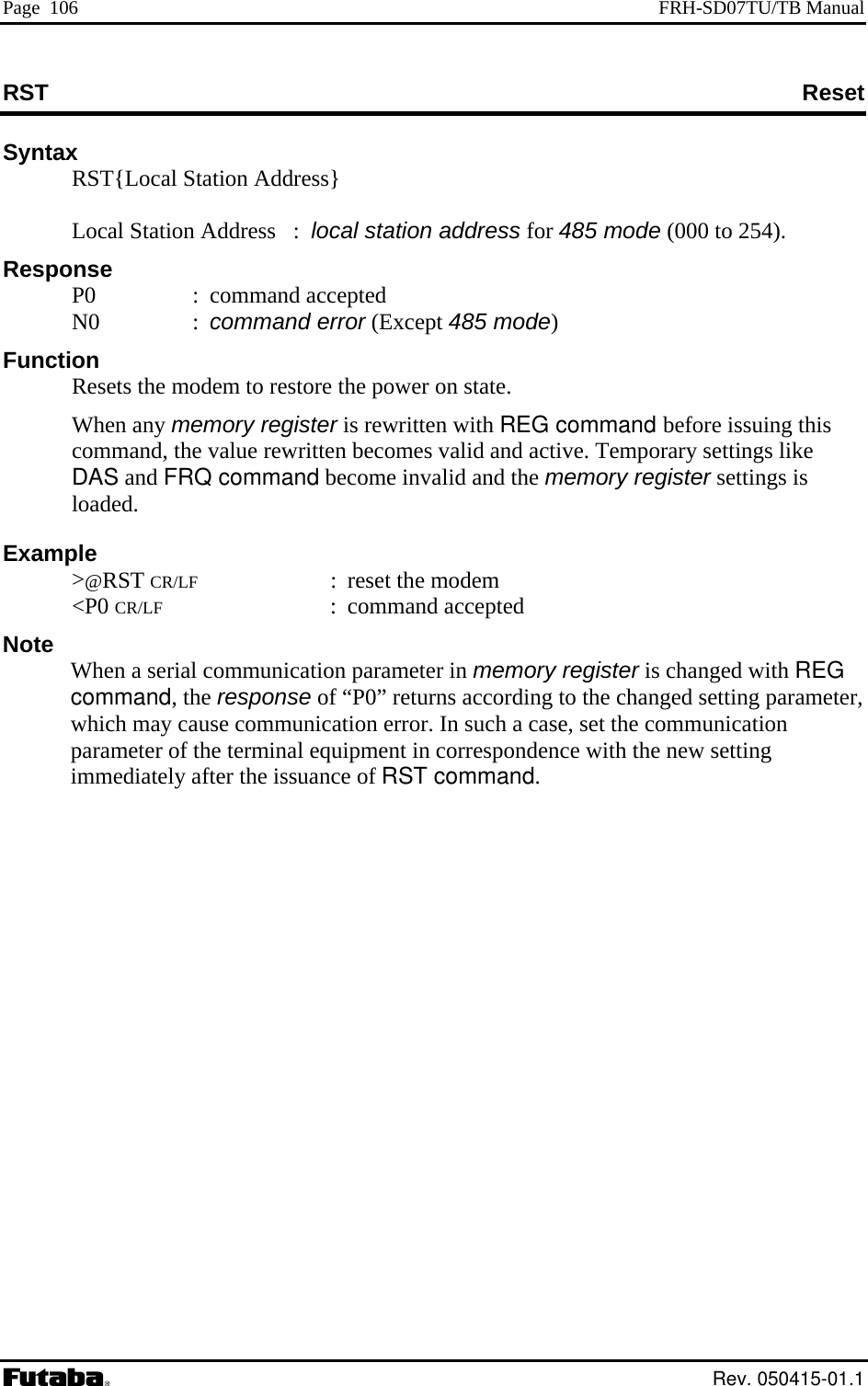
![Page 107 RTY Retransmit Message Through Repeater Syntax RTY [repeater address] {Local Station Address} : ge Local Station Address : l000 to 254). espo : data transmission succeeded being transmitted. ode) n station N3 : ission failed -- destination station cannot receive because its receive buffer is full r. tputs F tion 002 , data transmitted tion 002 to repeater ded e important notes using transmit commands. Be sure to read p.158 repeater address address of repeater to pass through for messatransmission (000 to 239) ocal station address for 485 mode (R nse P0 P1 : command accepted, data P2 : data packet reached to repeater N0 : command error (Except 485 m N1 : data transmission failed -- no response from destinatio N2 : data transmission failed -- destination station is in the reception disabled state data transmFunctions Retransmits the previous message to the same destination station through a repeate In case the global addressing command is issued to plural modems connected by RS485 multi-dropping interface, the transmission stops when any modem ou“P0”, “N2” or “N3” response to the RS485 line. Example >@TXT002HELLO CR/L : transmit “HELLO” from station 001 to sta <P1 CR/LF : command received <N1 CR/LF : transmission failed 0 CR/LF ” from station 001 to sta >@RTY10 : retransmit “HELLOthrough repeater 100 <P1 CR/LF : data being transmitted <P2 CR/LF : data packet reached <P0 CR/LF : data transmission succeeN Before invoking this command, execute any transmit command of TXT, TXR, TBN,or TBR. In case of broadcast transmission, the receiving result of the destination station cannot be confirmed at the sender end. There arotes OPERATION IMPORTANT NOTICE. Futaba Corporation Rev. 050415-01.1](https://usermanual.wiki/Futaba/FRH-SD07TU.User-Manual/User-Guide-535573-Page-123.png)
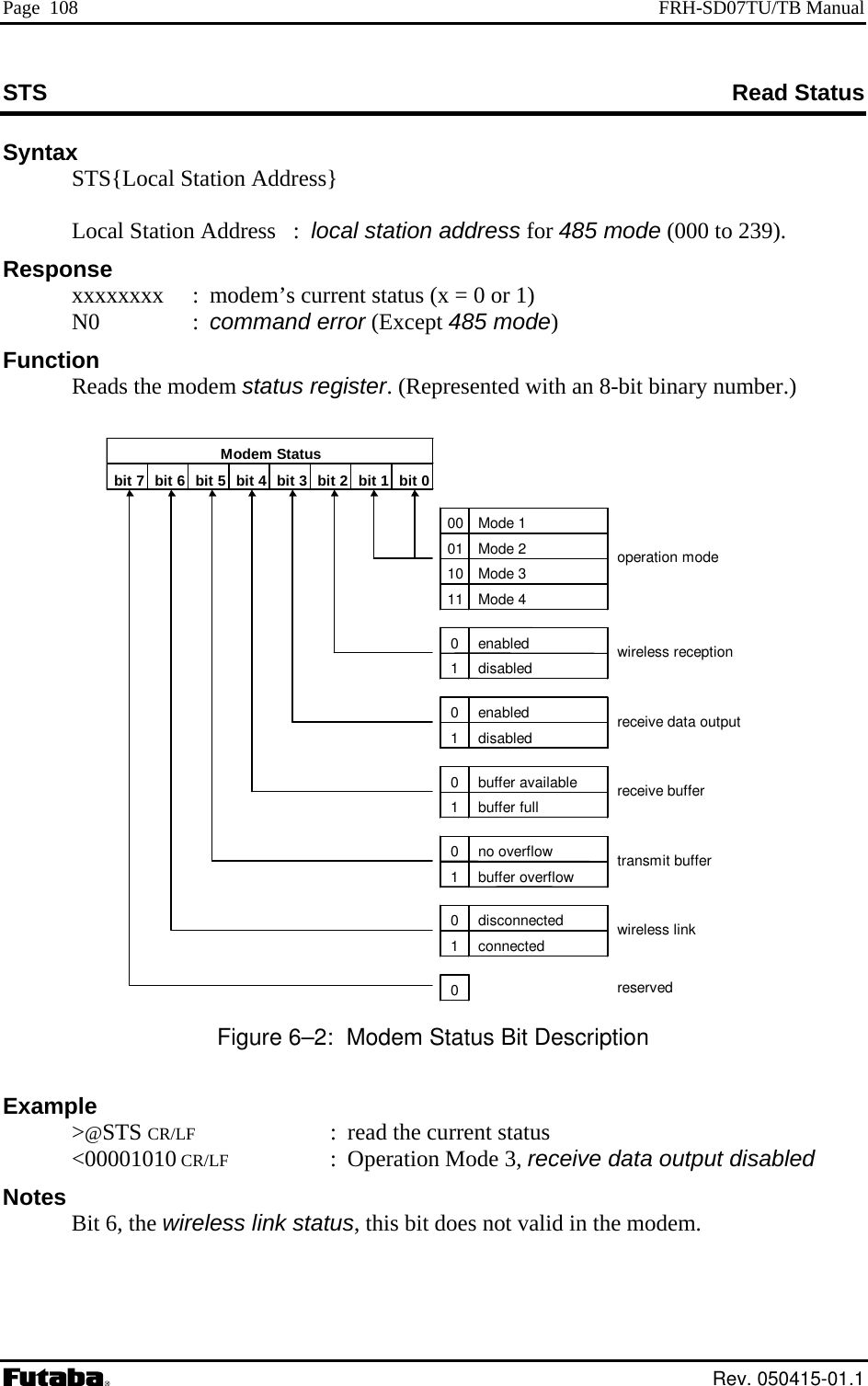
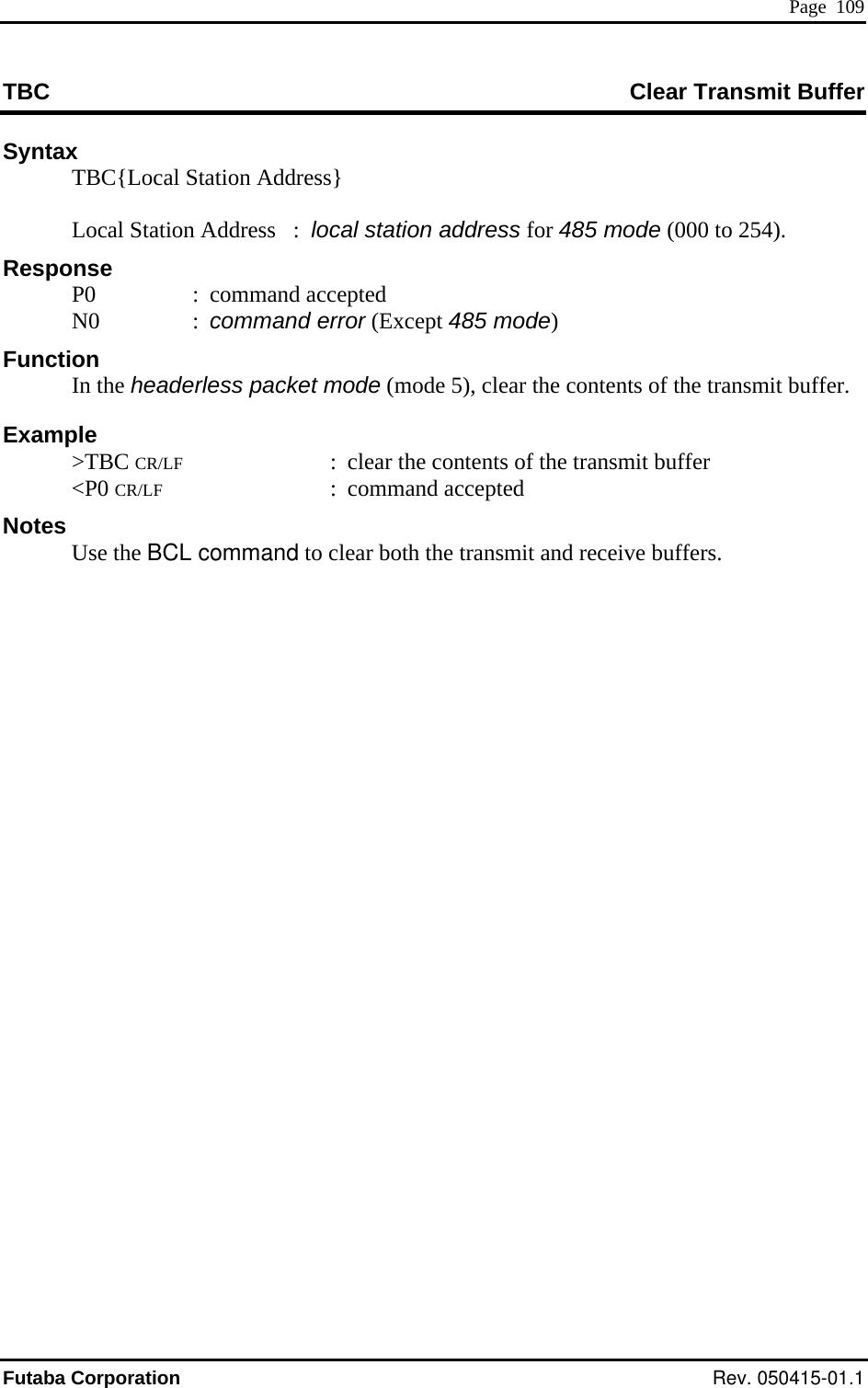
![Page 110 FRH-SD07TU/TB Manual TBN Transmit Binary Data Syntax TBN[destination address][message byte length]{Local Station Address}[message] Destination address : address of the broadcast transmission (000 to 239) e byte length : message length (001 to 255) ode (000 to 254). N0 : command error (Except 485 mode) N1 : data transmission failed -- no response from destination station N2 : data transmission failed -- destination station is in the reception disabled state N3 : data transmission failed -- destination station cannot receive because its receive buffer is full Function Transmits binary data in the packet transmission mode. Any message length between 1 to 255 bytes is accepted. The modem counts the number of message characters and transmits the message. For broadcasting messages to multiple modems, set the destination address to 255. In this case, the modem retransmits the message the number of times of the Retransmission count plus 1, and then it will return “P0”. In case the global addressing command is issued to plural modems connected by RS485 multi-dropping interface, the transmission stops when any modem outputs “P0”, “N2” or “N3” response to the RS485 line. Example >TBN002005HELLO CR/LF : transmit “HELLO” from station 001 to station 002 <P1 CR/LF : data being transmitted <P0 CR/LF : data transmission succeeded. >@TBN003004MAIL CR/LF : retransmit “MAIL” from station 001 to station 003 <P1 CR/LF : data being transmitted <N1 CR/LF : transmission failed, no response from destination station Notes Set the message length to 255 byte or less. The message length exceeding 255 will be command error. be terminated racter, others will be command There are important notes using transmit commands. Be sure to read p.158 OPERATION IMPORTANT NOTICE set 240 to 254 for global addressed destination set 255 for broadcast transmission Messag Local Station Address : local station address for 485 m Message byte : arbitrary binary data (255 or less) Response P0 : data transmission succeeded P1 : command accepted, data being transmitted byteMessage must with 2 byte (CR/LF) chaerror. In broadcast transmission, the receiving result of the destination station cannot be confirmed at the sender side.. Rev. 050415-01.1](https://usermanual.wiki/Futaba/FRH-SD07TU.User-Manual/User-Guide-535573-Page-126.png)
![Page 111 TBR ata through Repeater Transmit Binary DSyntax TBR [repeater address] [destination address] [message byte length]{Local Station Address}[message] set 240 to 254 for global addressed destination t transmission l (000 to 254). age byte : arbitrary binary data (255 or less) : data transmission succeeded command accepted, data data packet reaN1 : data transmission failed -- no response from destination station : data transmission failed -- destination station is in the reception disabled state se its receive buffer is full Function In the packet transmission mode, transmits binary data through repeater. Any message length between 1 to 255 bytes is accepted. The modem counts the number of message characters and transmits the message. For broadcasting messages to multiple modems, set the destination address to 255. In this case, the modem retransmits the message the number of times of the Retransmission count plus 1, and then it will return “P0”. In case the global addressing command is issued to plural modems connected by RS485 multi-dropping interface, the transmission stops when any modem outputs “P0”, “N2” or “N3” response to the RS485 line. Example >TBR100002005HELLO CR/LF : transmit “HELLO” from station 001 to station 002 <P1 CR/LF : data being transmitted <P2 CR/LF : data packet reached to repeater <P0 CR/LF : data transmission succeeded Notes Set the message length to 255 byte or less. The message length exceeding 255 byte will be command error. Message must be terminated with 2 byte (CR/LF) character, others will be command error. In broadcast transmission, the receiving result of the destination station cannot be confirmed at the sender side. There are important notes using transmit commands. Be sure to read p.158 OPERATION IMPORTANT NOTICE Repeater address : repeater address to pass through (000 to 239) ation address : address of destination station (000 to 239) Destin set 255 for broadcas Message byte ength : message byte length (001 to 255) Local Station Address : local station address for 485 mode MessResponse P0 P1 : being transmitted P2 : ched to repeater N0 : command error (Except 485 mode) N2 N3 : data transmission failed -- destination station cannot receive becau. Futaba Corporation Rev. 050415-01.1](https://usermanual.wiki/Futaba/FRH-SD07TU.User-Manual/User-Guide-535573-Page-127.png)
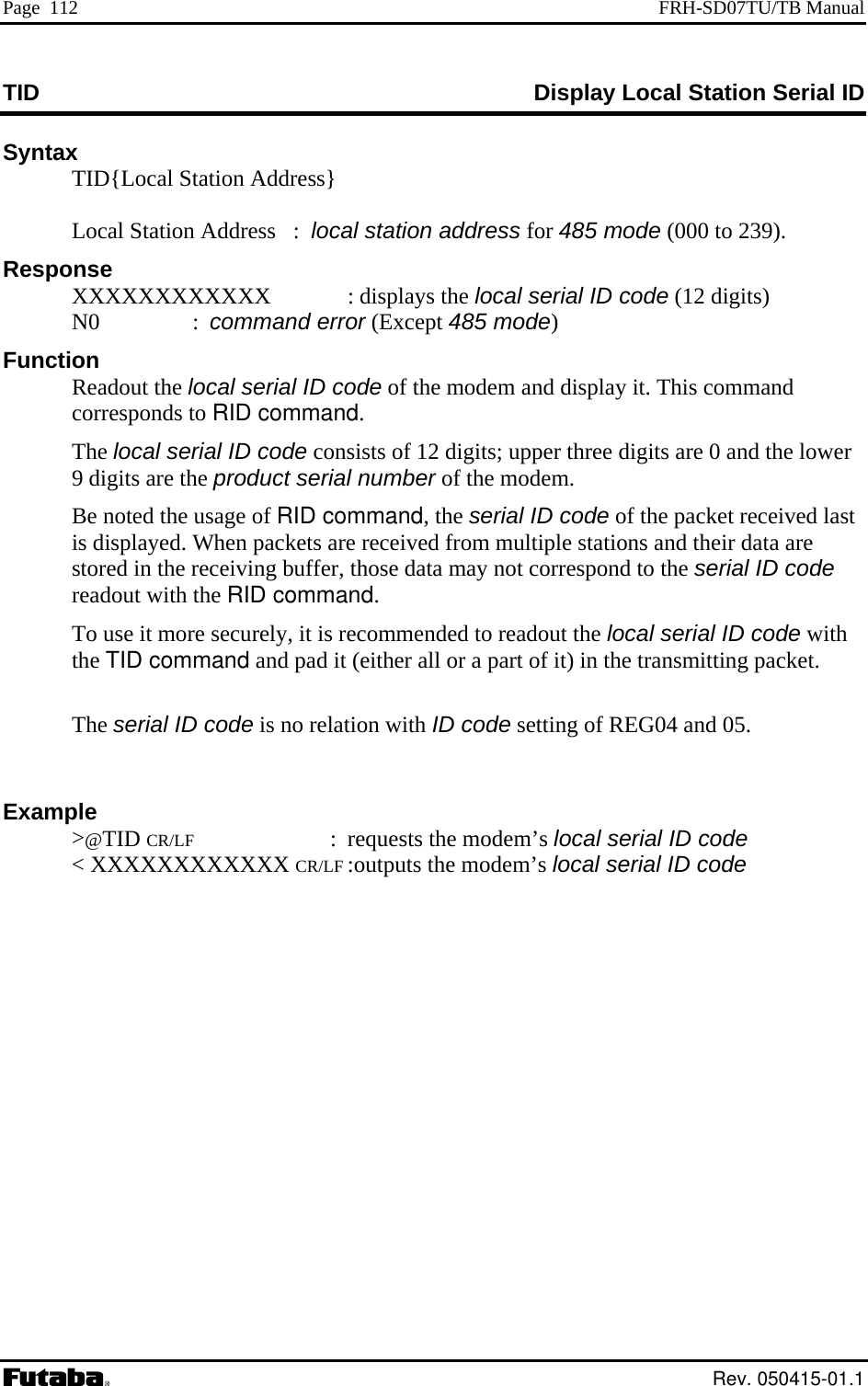
![Page 113 TXR Transmit Text Data through Repeater Syntax TXR [repeater address] [destination address]{Local Station Address}[message] repeater address destination address : address of destination station (000 to 239) set 240 to 254 for global addressed destin : address of repeater to pass through (000 to 239) ation n Address : : ata tran: command accepted, data being transmitted er ponse from the destination station station is in the reception disabled state its receive unct Transmits text data in th packet transmission mode through repeater. data 55. ted by any modem outputs Examp >@TXR100002HELLO CR/LF : transmits HELLO from station 001 to station 002 through repeater 100 peater et the message length to 255 byte or less. The message length exceeding 255 terminator (CR/LF) is contained in a message, the case, use TBR command. set 255 for broadcast transmission 000 to 254). Local Statio local station address for 485 mode ( message : any text data (255 or less) Response P0 d smission succeeded P1 P2 : data packet reached to repeat N0 : command error (Except 485 mode) N1 : data transmission failed -- no res N2 : data transmission failed -- destination N3 : data transmission failed -- destination station cannot receive becausebuffer is full. F ion e Any message length between 1 to 255 bytes is accepted. The completion ofinput is recognized by the terminator. For broadcasting messages to multiple modems, set the destination address to 2In this case, the modem retransmits the message the number of times of the Retransmission count plus 1, and then it will return “P0”. In case the global addressing command is issued to plural modems connecRS485 multi-dropping interface, the transmission stops when“P0”, “N2” or “N3” response to the RS485 line. le <P1 CR/LF : data being transmitted <P2 CR/LF : data packet reached to re <P0 CR/LF : data transmission succeeded Notes Sbyte will be command error. When the same character as themodem distinguishes it as the end of a command and ignore the subsequent data. In such a In broadcast transmission, the receiving result of the destination station cannot be confirmed at the sender side. There are important notes using transmit commands. Be sure to read p.158 OPERATION IMPORTANT NOTICE. Futaba Corporation Rev. 050415-01.1](https://usermanual.wiki/Futaba/FRH-SD07TU.User-Manual/User-Guide-535573-Page-129.png)
![Page 114 FRH-SD07TU/TB Manual TXT Transmit Text Data Syntax TXT [destination address]{Local Station Address}[message] destination address : address of destination station (000 to 239) : local station address for 485 mode (000 to 254). : data transmission succeeded d - no response from the destination station Funct ut R/LF). . etransmission count plus 1, and then it will return “P0”. ected by S485 multi-dropping interface, the transmission stops when any modem outputs response to the RS485 line. <P1 CR/LF : data being transmitted <P0 CR/LF : data transmission succeeded >@TXT003MAIL CR/LF : transmits MAIL from station 001 to station 003 <P1 CR/LF : data being transmitted <N1 CR/LF : transmission failed. no response from destination station Notes Set the message length to 255 byte or less. The message length exceeding 255 byte will be command error. When the same character as the terminator (CR/LF) is contained in a message, the modem distinguishes it as the end of a command and ignores the subsequent data. In such a case, use TBN command. In broadcast transmission, the receiving result of the destination station cannot be confirmed at the sender side. There are important notes using transmit commands. Be sure to read p.158 OPERATION IMPORTANT NOTICE set 240 to 254 for global addressed destination set 255 for broadcast transmission Local Station Address message : any text data (255 or less) Response P0 P1 : command accepted, data being transmitted N0 : command error (Except 485 mode) N1 : data transmission faileN2 : data transmission failed - destination station is in the reception disabled state N3 : data transmission failed – destination station cannot receive because its receive buffer is full. ion Transmits text data in the packet transmission mode. Any message length between 1 to 255 bytes is accepted. The completion of data inpis recognized by the terminator (CFor broadcasting messages to multiple modems, set the destination address to 255In this case, the modem will retransmit the message the number of times of the RIn case the global addressing command is issued to plural modems connR“P0”, “N2” or “N3” Example >@TXT002HELLO CR/LF : transmits HELLO from station 001 to station 002 . Rev. 050415-01.1](https://usermanual.wiki/Futaba/FRH-SD07TU.User-Manual/User-Guide-535573-Page-130.png)
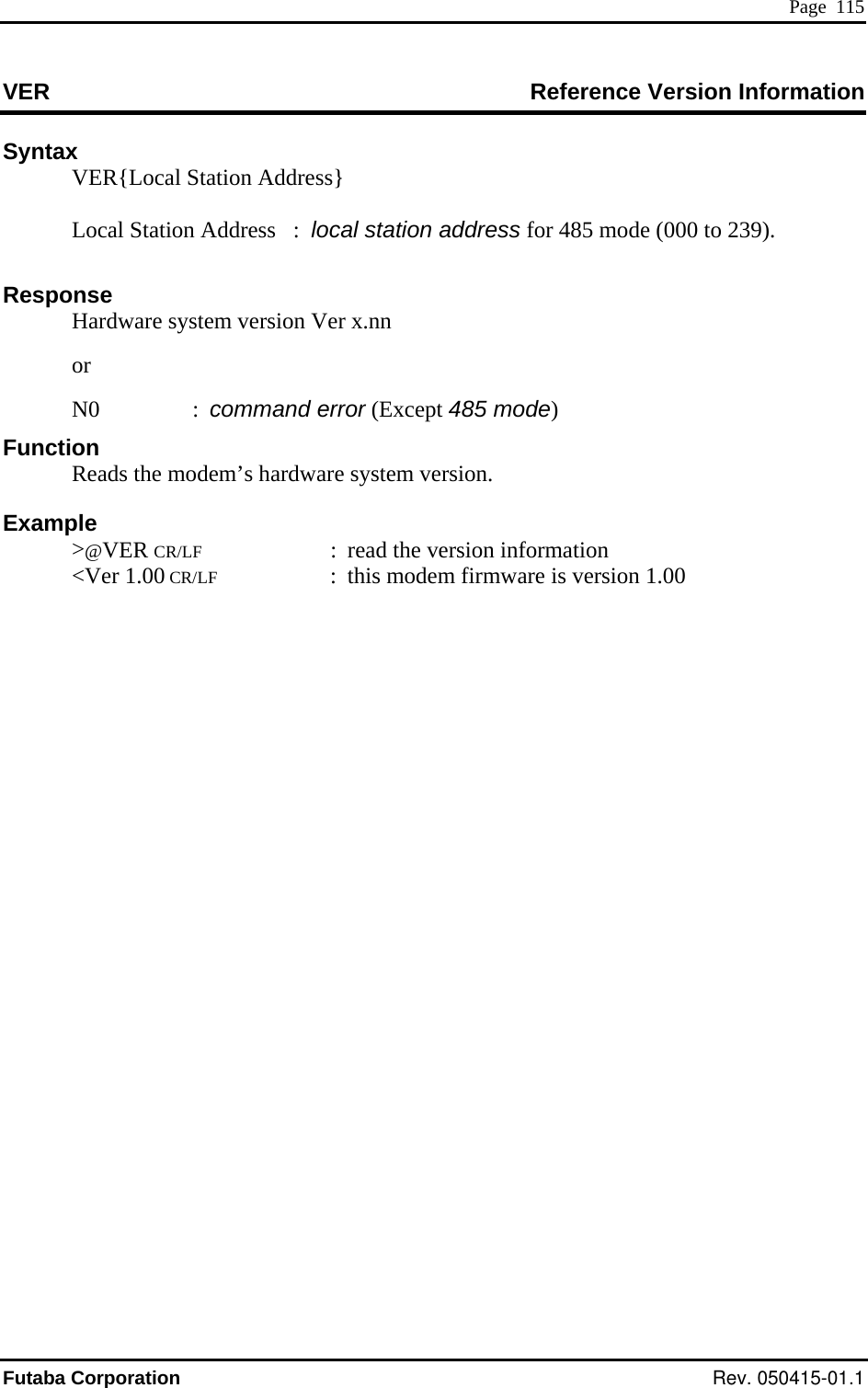
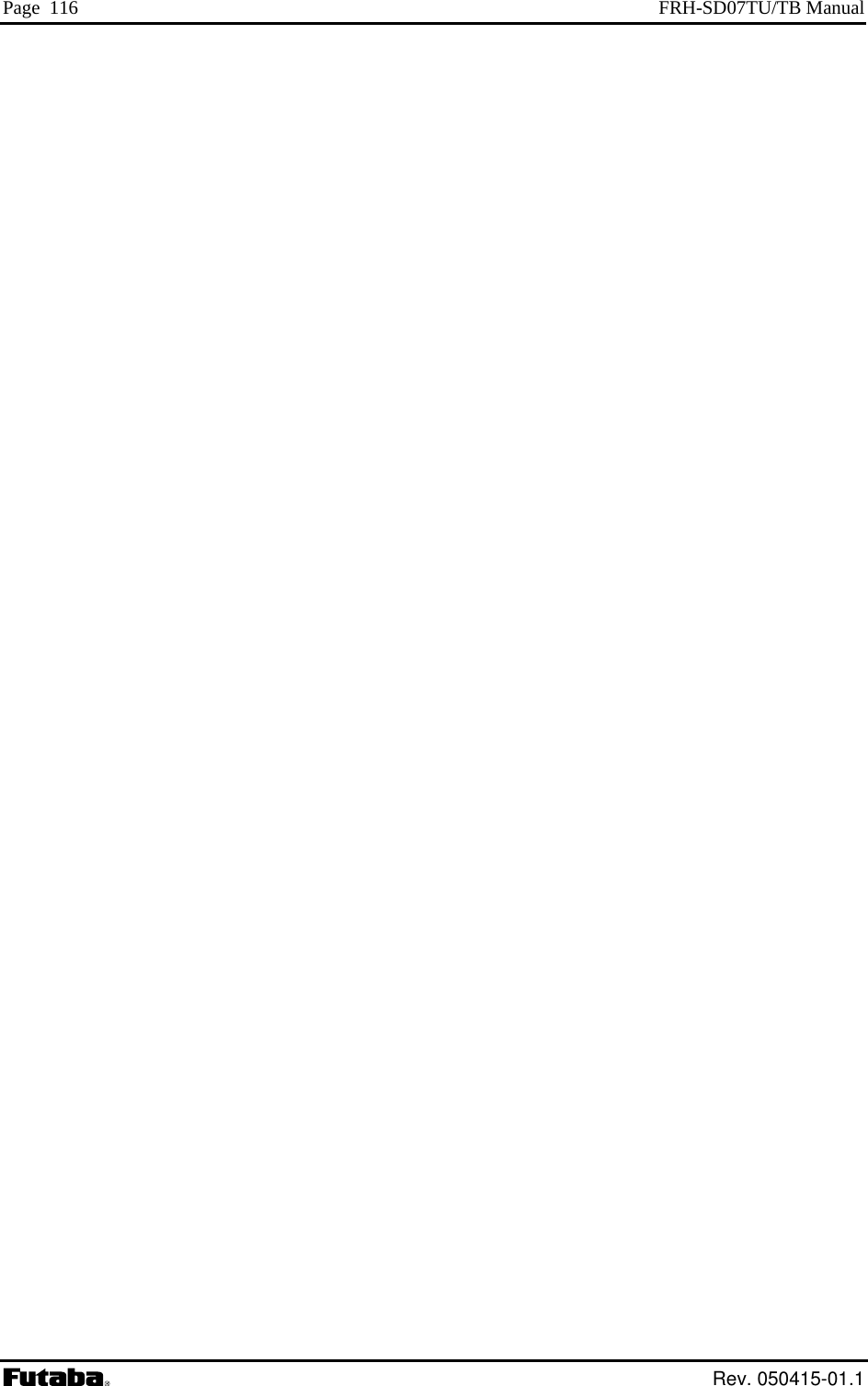
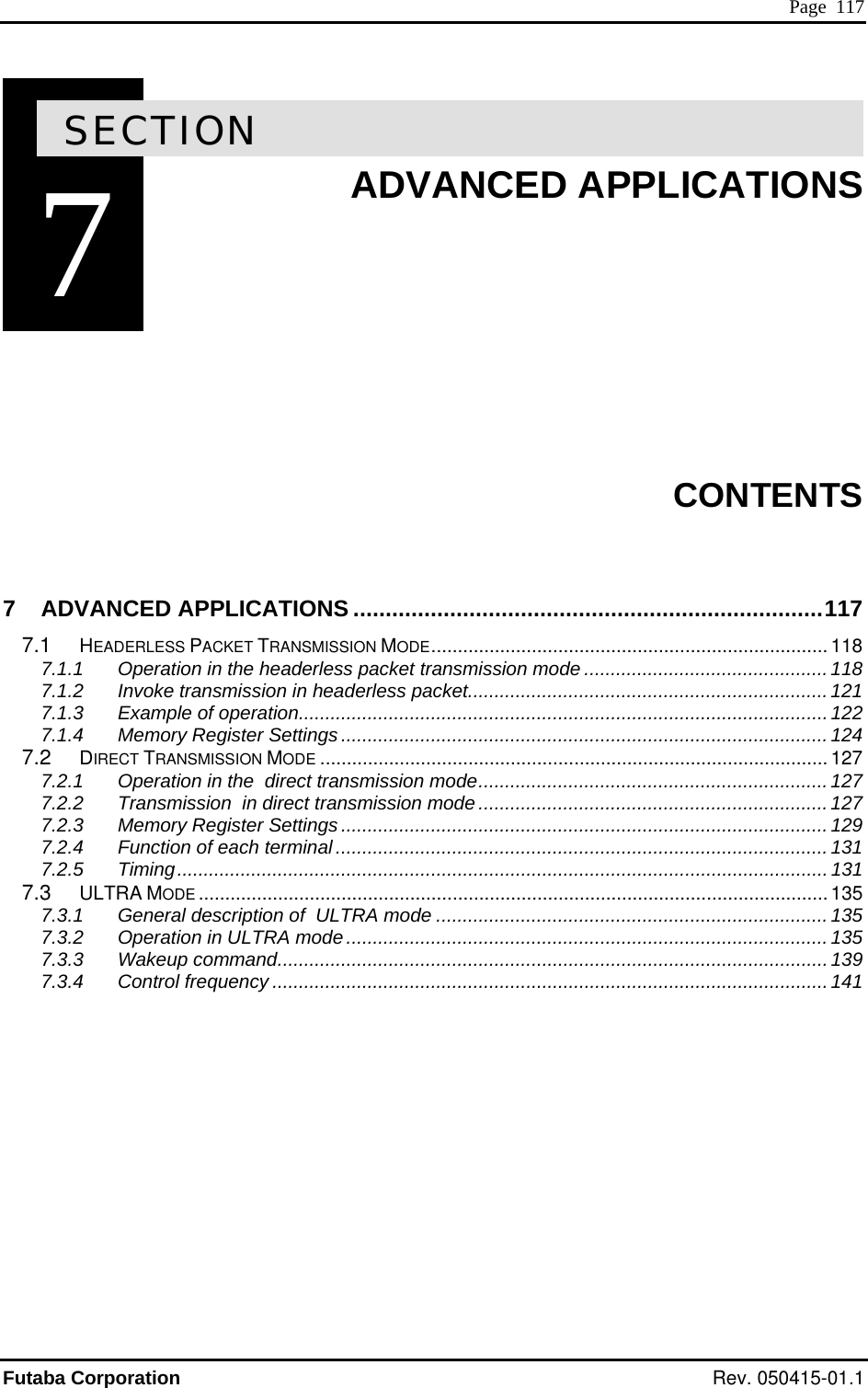
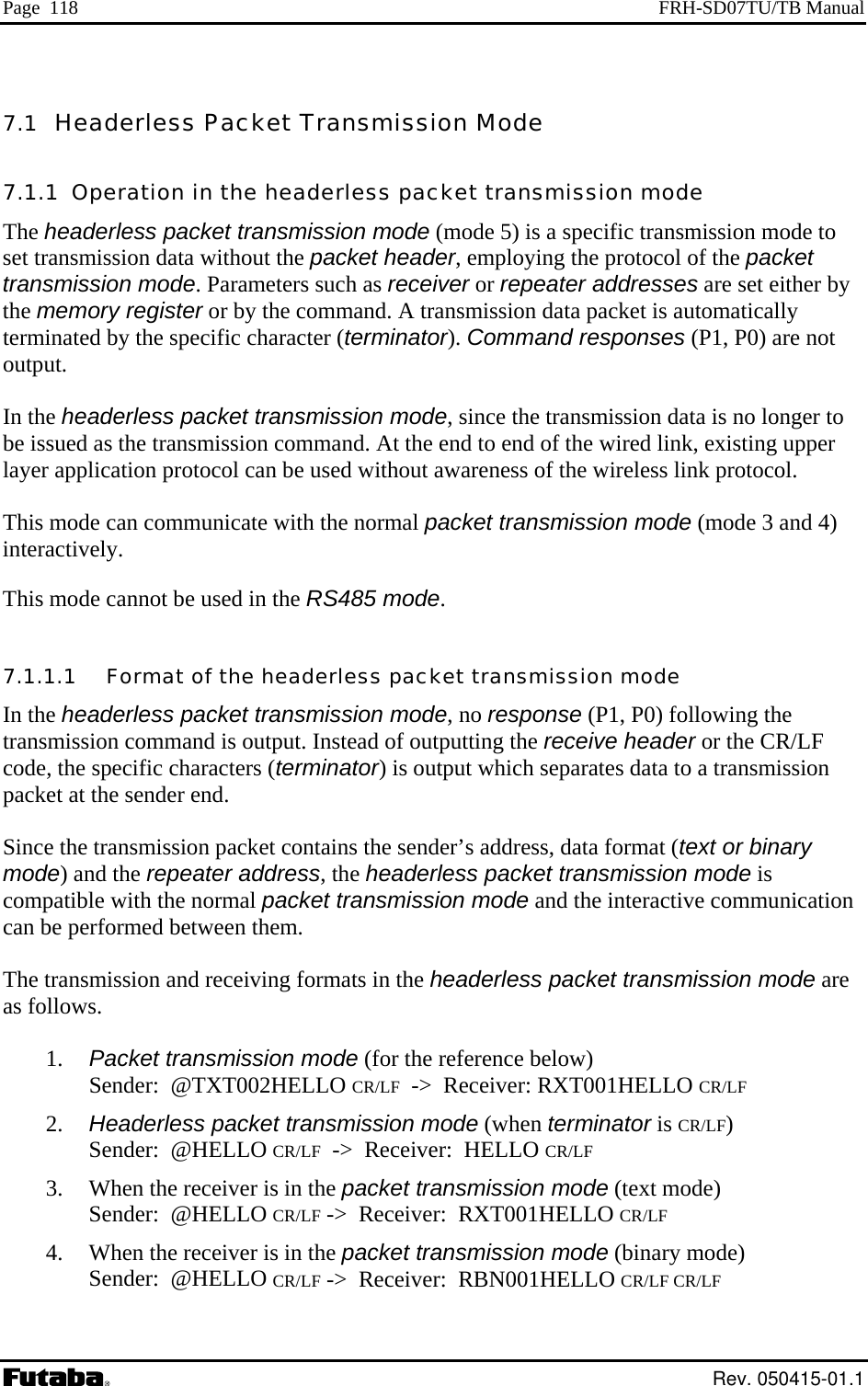
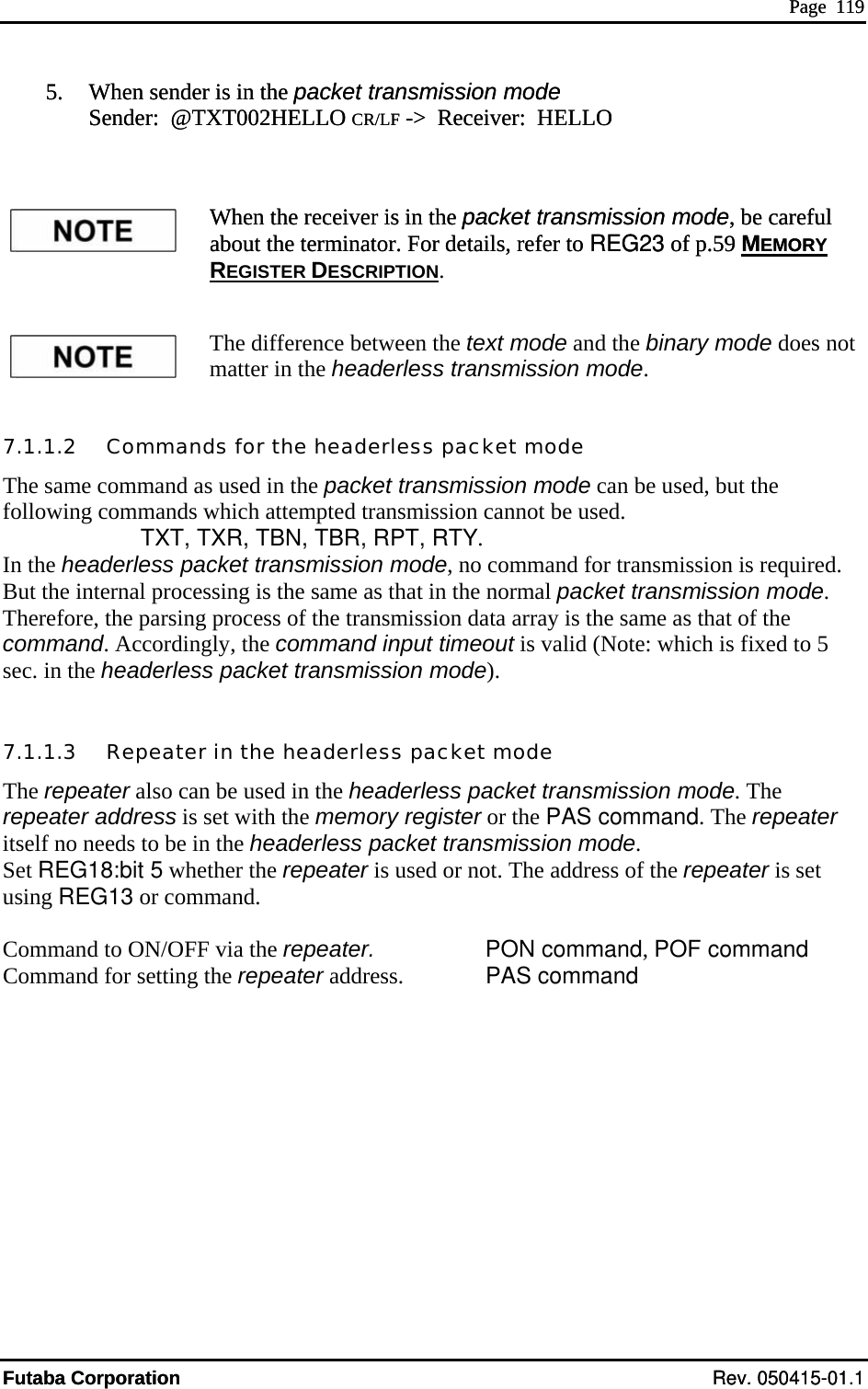
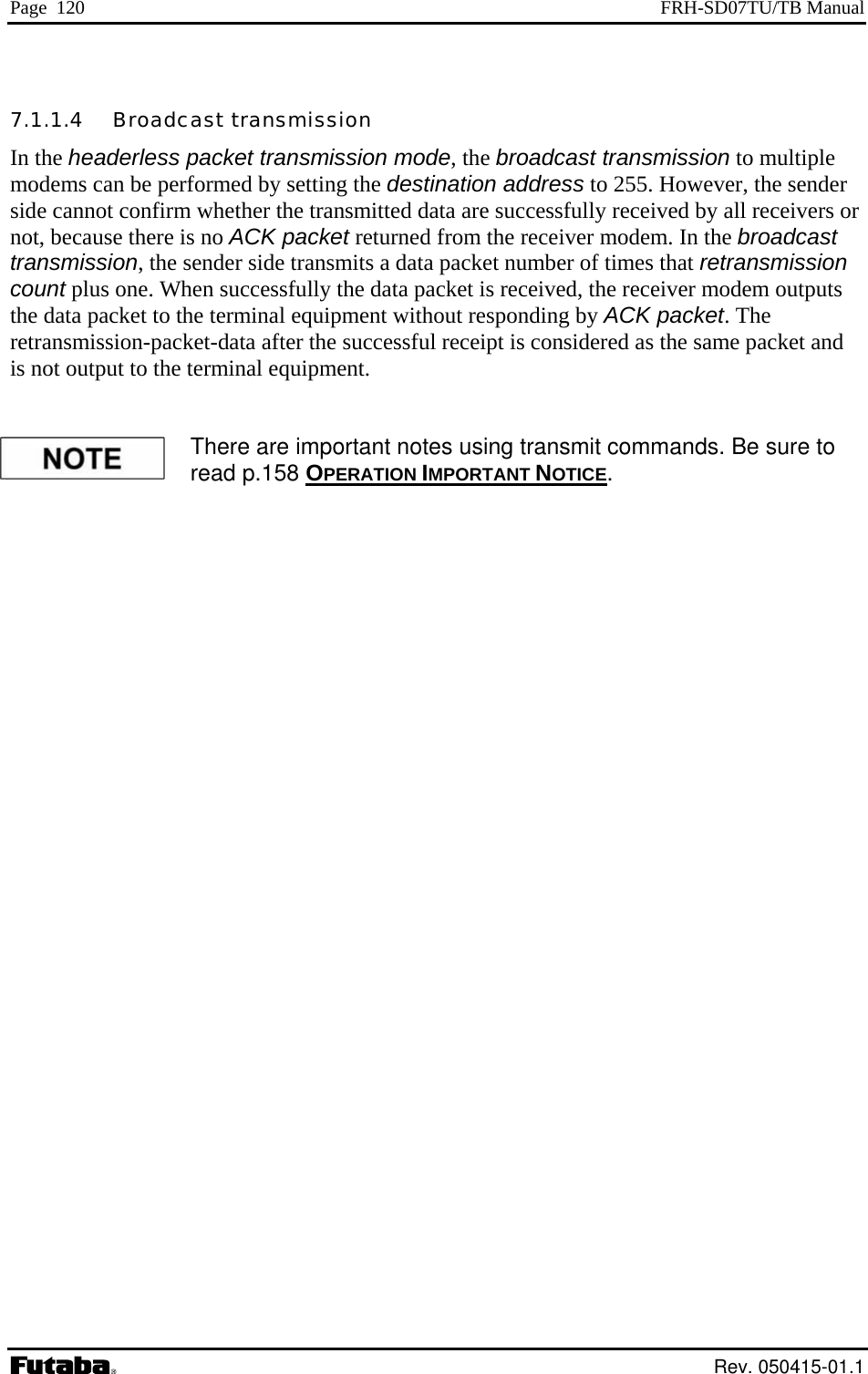
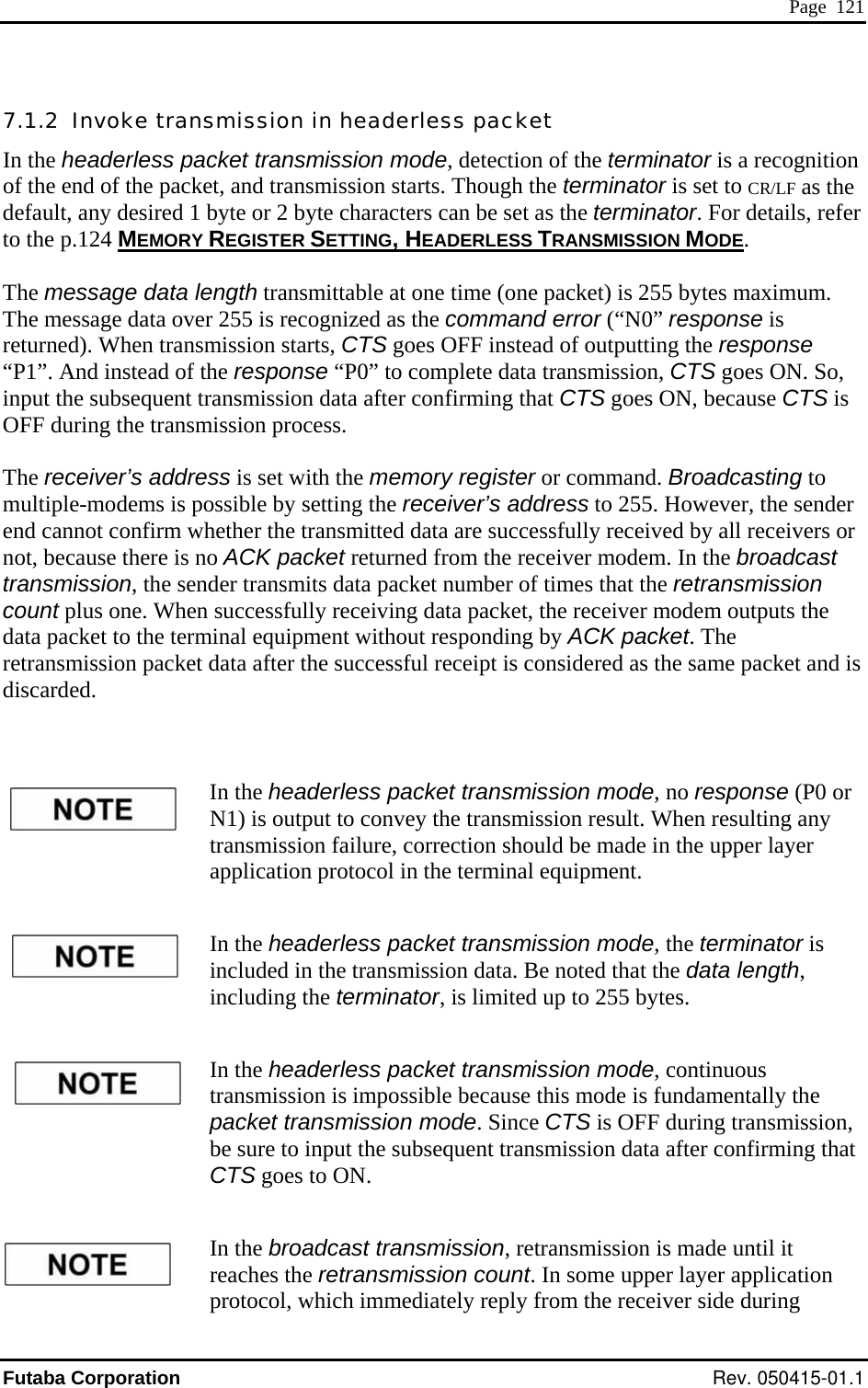
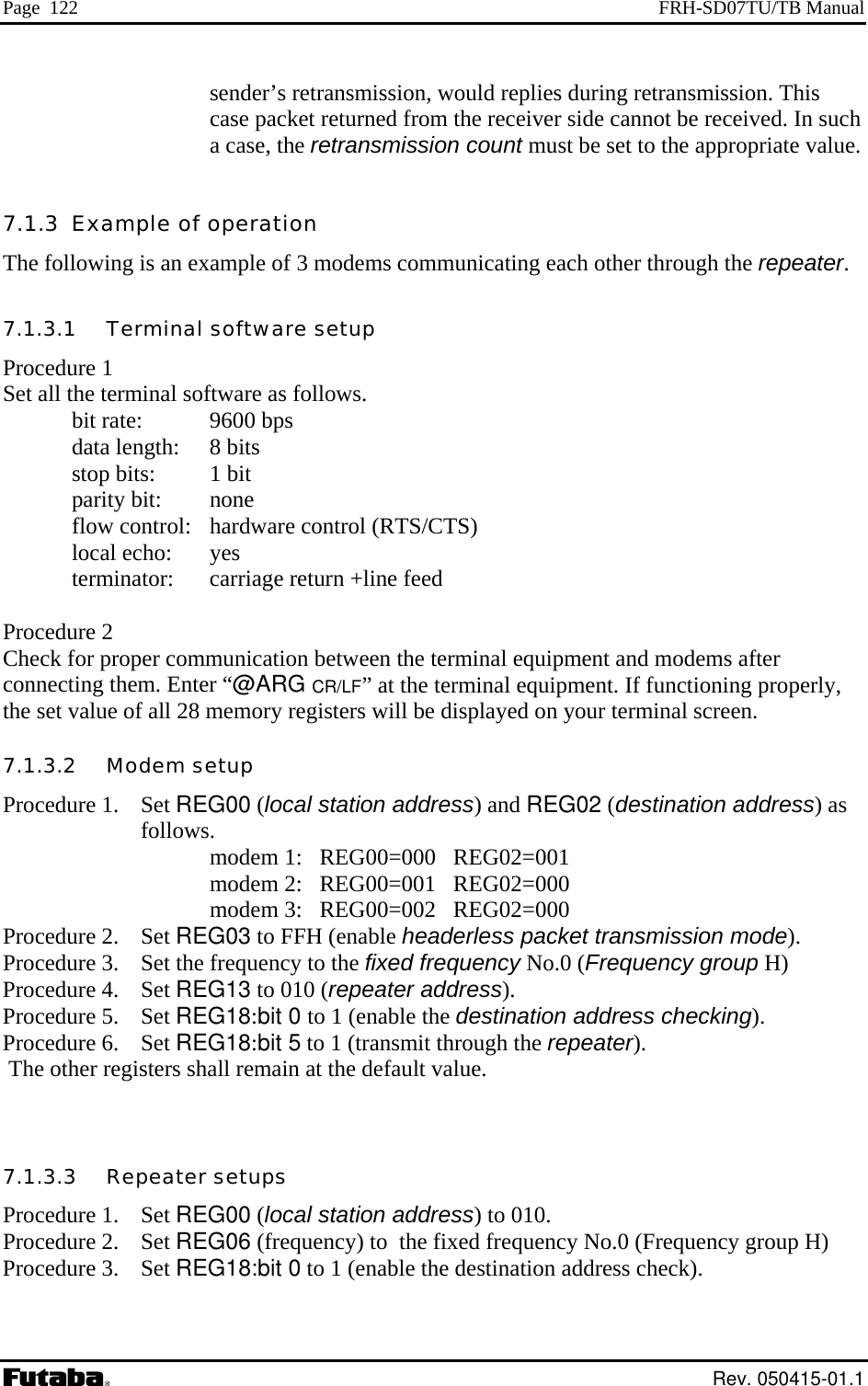
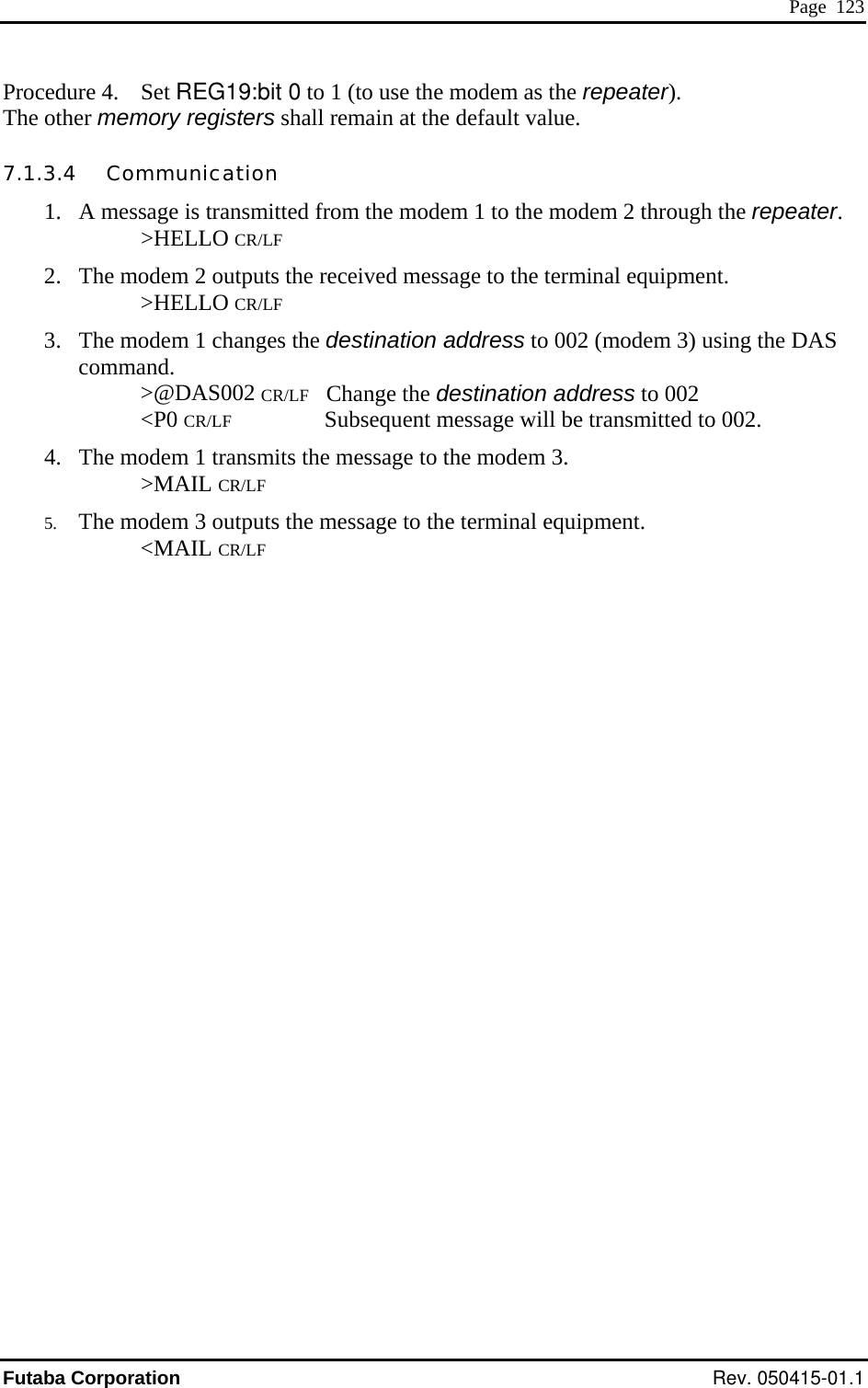
![Page 124 FRH-SD07TU/TB Manual 7.1.4 Memory RegThe basic setup is the In the headerless packet mode, the following settings should be added. ister Settings same as that of normal packet transmission mode (mode 3 and 4). REG02: Destination Address Default value: 00HSet the address of the modem to transmit data as the destination address. Setting to 000 to ission data packet to transmit to the destination address. 18) is valid, set the address of the receiving odem mand can change this destination address. Default value: F0H 239 is available (240 addresses). This value is padded to the transmWhen address checking function (REGm to this register. DAS comREG03: Operation Mode Setting Set the operation m e to the headerless packeREG13: Repeater Address Default valuod t transmission mode (FFH). e: 1EH When a repeater is used, set the repeater address to pass through. REG16: Terminator Setup 1 Default value: 32H Set an arbitrary 1 byte teofTh m in meout is fixed to 5 sec. REG17: Terminator Setup 2 Default valuerminator. In case of a 2-byte terminator, set the first byte character the terminator. e co mand put ti: 32H Set another arbitrary 1 byte terminator. In case of a 2-byte terminator, set the last of the terminator. character REG18: Communication Setting 1 [default value: 8CH] Bits 7 – 6: Reserved • The FRH-SD07TU/TB does not use this register. Keep the default value as it is. Rev. 050415-01.1](https://usermanual.wiki/Futaba/FRH-SD07TU.User-Manual/User-Guide-535573-Page-140.png)
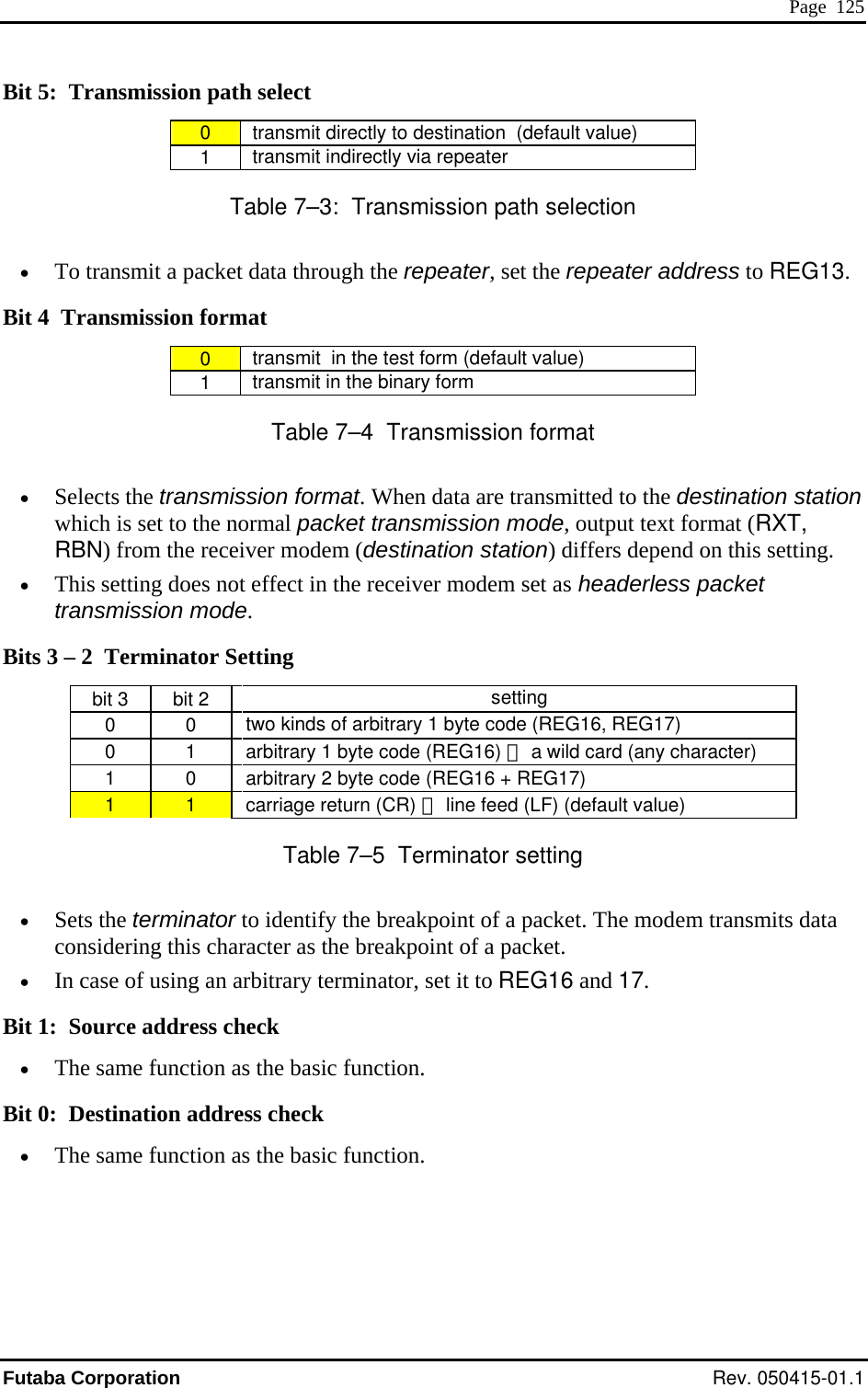
![Page 126 FRH-SD07TU/TB Manual REG23: Interface Setting 4 [default value: 00H] The same function as the basic function, except bit 4. Bit 4 : CR/LF addition/deletion 0 does not add CR/LF code to the received data (default value) 1 adds CR/LF code to the received data Table 7–6: Addition of CR/LF code (setting at the headerless packet transmission mode) • In the headerless packet transmission mode, setting is made whether the CR/LF character is added to the received data or not. • In the communication between the modems set to the headerless packet mode, this setting is invalid because the terminator is originally added to the transmit data. the modem in the normal packdition of the CR/LF terminato added. However, when a packet is received from et transmission mode, there is no ad r. In this case, set this bit to 1. Then the received packet is output with the CR/LF character is• 0 adds the CR/LF to the received data (default value) 1 does not add the CR/LF to the received data Table 7–7: Deletion of CR/LF character (setting at the packet transmission mode) mode, setting is made whether the C mode) side terminator (CR/LF character as minator (CR/LF) are output. To avoid such redundant outputs, set this bit of the modem in the normal packet transmission • In the packet transmission R/LF character is added to the received data or not. • At the receiver modem (set to the normal packet transmission mode), the sender (set to the headerless packet transmissiondefault) plus packet transmission mode termode to 1. Rev. 050415-01.1](https://usermanual.wiki/Futaba/FRH-SD07TU.User-Manual/User-Guide-535573-Page-142.png)
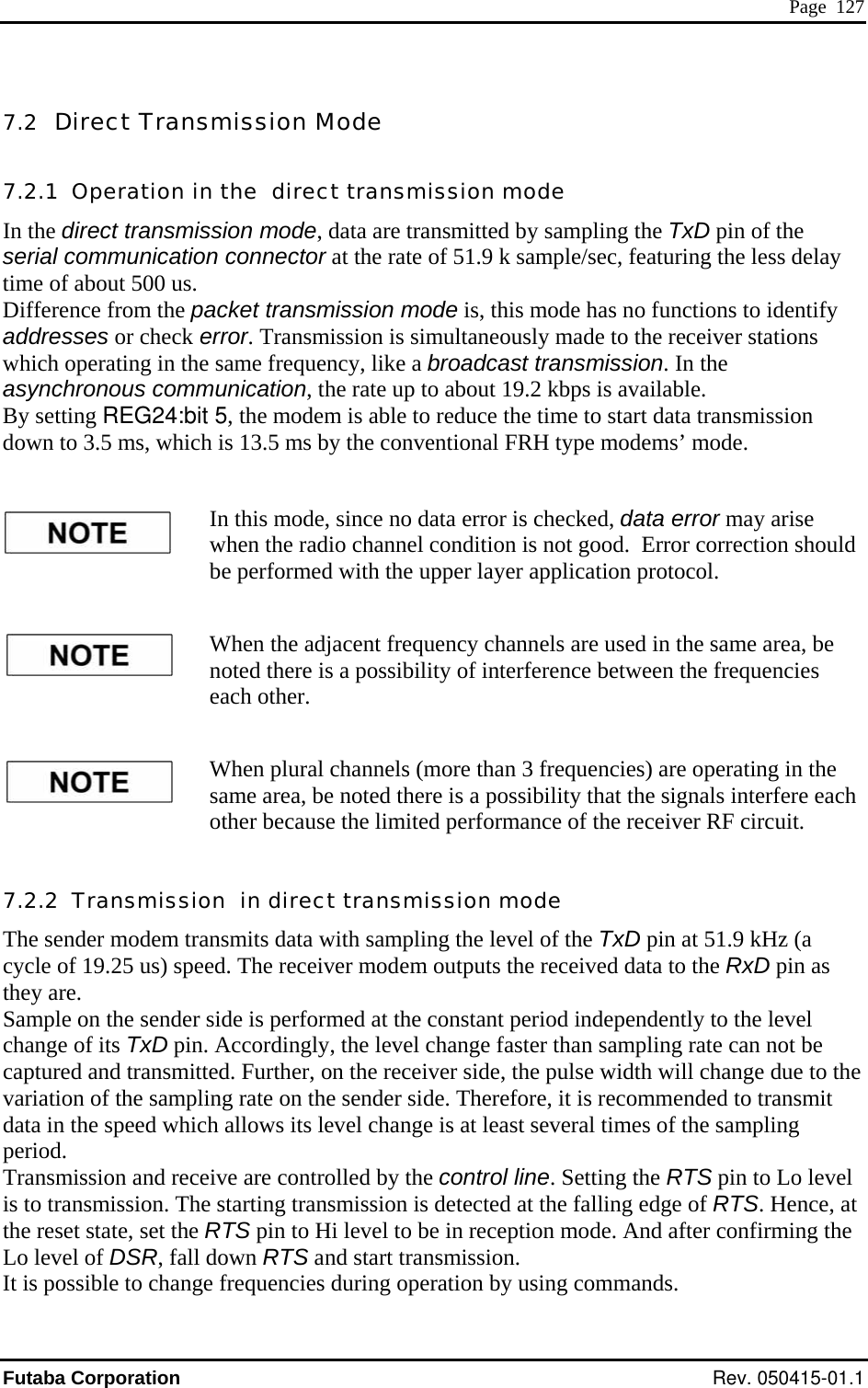
![Page 128 FRH-SD07TU/TB Manual The direct transmission mode f nput of the transmit eatures less delay time between the idata and the output of the receive data, i.e. about 500 us. Transmitting Side SD03TU, logic level is reverse that of FRH-SD07TU/TB. When FRH-SD07TU/TB transmits [1], the conventional type modem receives [0]. TxD Input Sampling Transmission Data Receiving SideReceive Data R xD Output Figure 7–1: Transmission on Direct Transmission Mode If the other end modem is the conventional type, such as FRH- Rev. 050415-01.1](https://usermanual.wiki/Futaba/FRH-SD07TU.User-Manual/User-Guide-535573-Page-144.png)
![Page 129 7.2.3 Memory Register Settings In the direct transmission mode, set the following parameters. Keep other parameters as being the factory default values. REG03: Operation Mode Setting Default value: F0HSet the operation mode to the direct transmission mode (01H). REG06: Frequency Setting Default value: A0H Set the frequency in operation. It is the same function as the basic function. Fixedfr equency mode is preferred to use in the direct transmission mode. REG19: Communi cation Setting 2 [default value: 00H]Only bit 6 is used. Use other bits than bit 6 as they are default values. Bit 6: Diversity rece• The same functioREG20: RS-232C S ] ption n as the basic function is valid. etting 1 [default value: 05H・ Set the communicthe basic function is・ Since TxD is sampled at 51.9 kHz, there is no relation between this setting and the actual H] ation parameter to be used to accept command. The same function as valid. communication speed. REG24: Special Mode Settings [default value: C0Bit 7 – 6: reserved • The direct transmission mode does not use this register. Keep the default value as it is. Bit 5: Delay time of transmission and reception (direct communication mode) 0 same delay time of the conventional type (13.5 ms, default value) 1 shorter delay time (3.5 ms) Table 7–8: Setting of delay time of transmission and reception in the direct communication mode Futaba Corporation Rev. 050415-01.1](https://usermanual.wiki/Futaba/FRH-SD07TU.User-Manual/User-Guide-535573-Page-145.png)
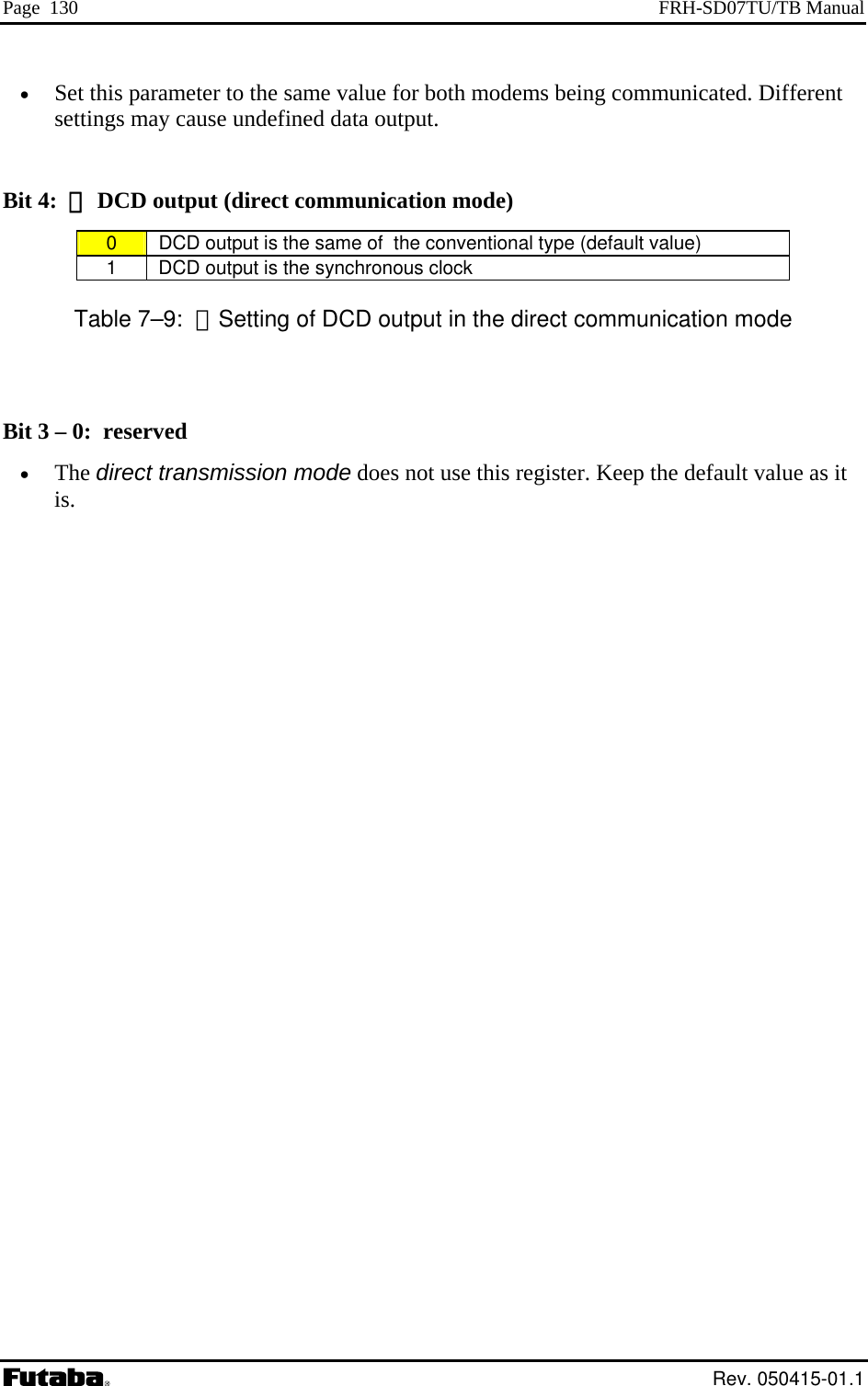
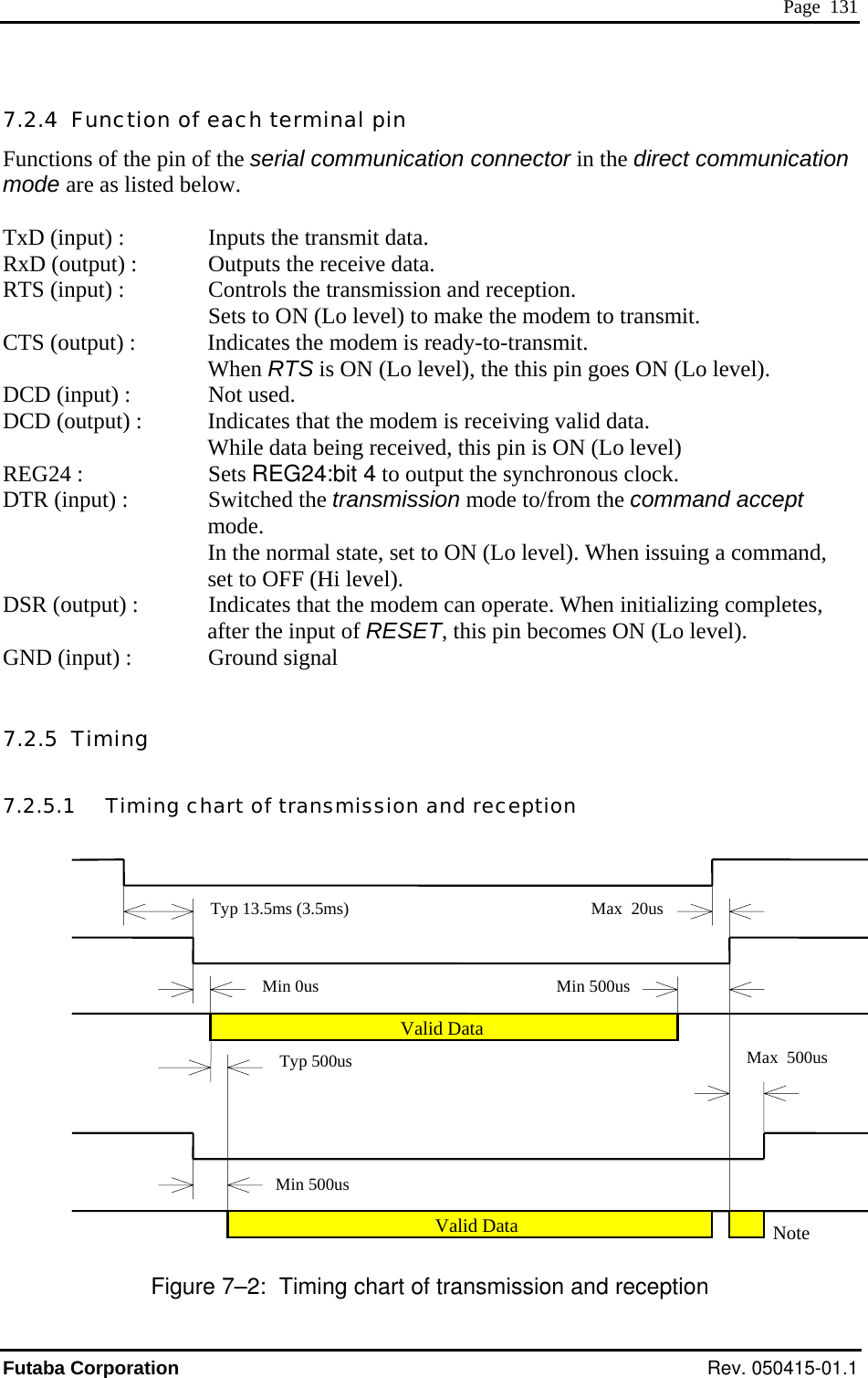
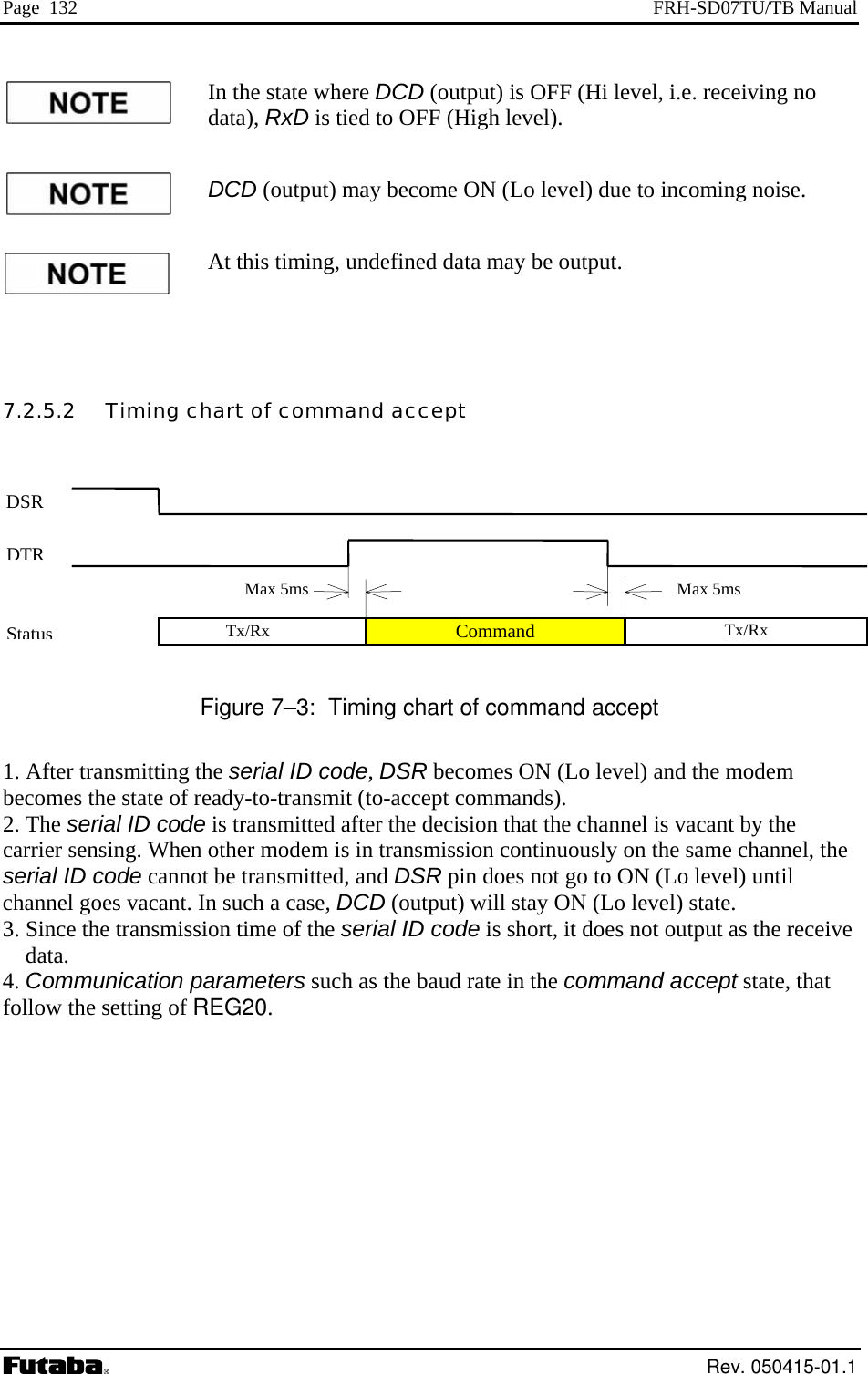
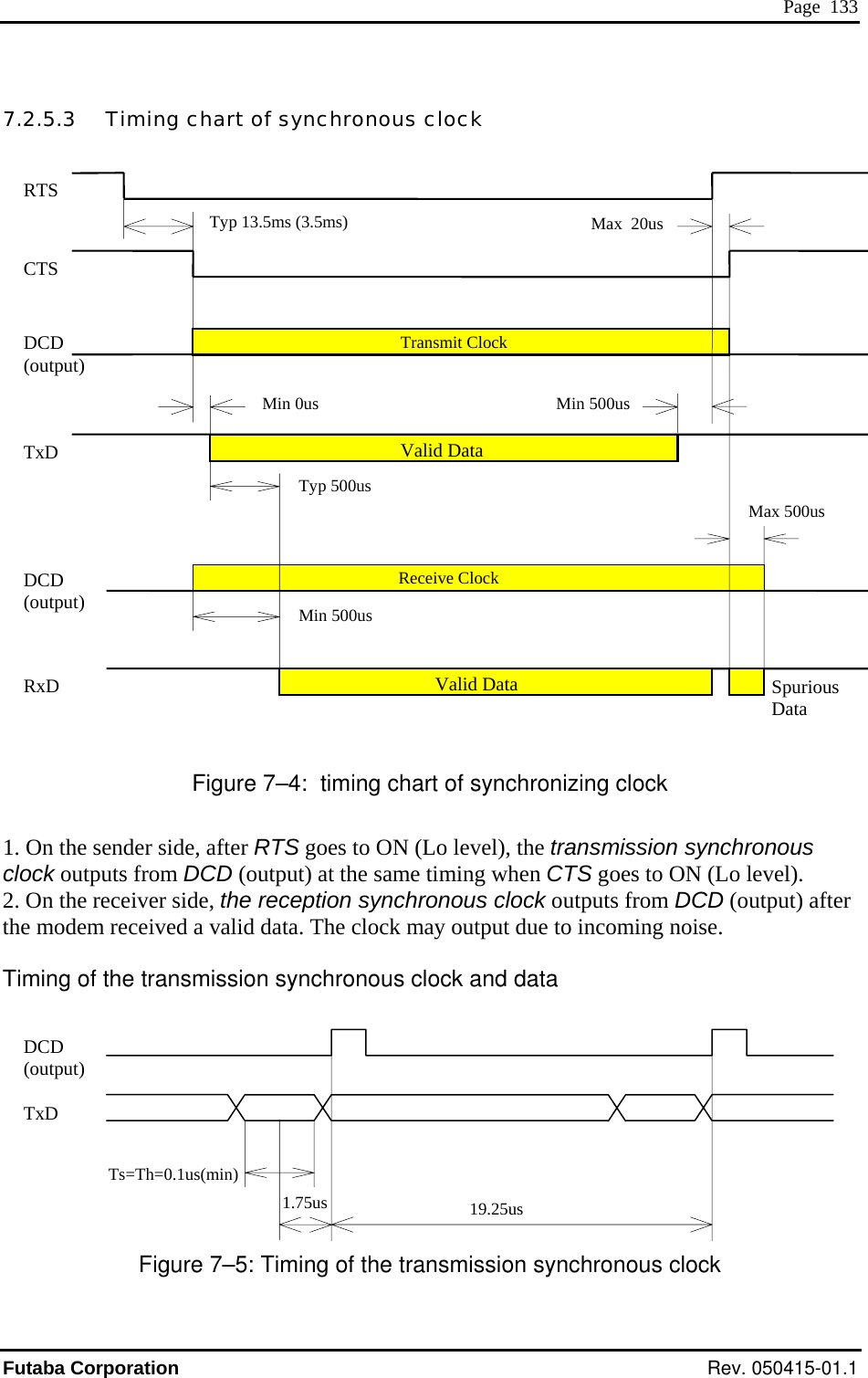
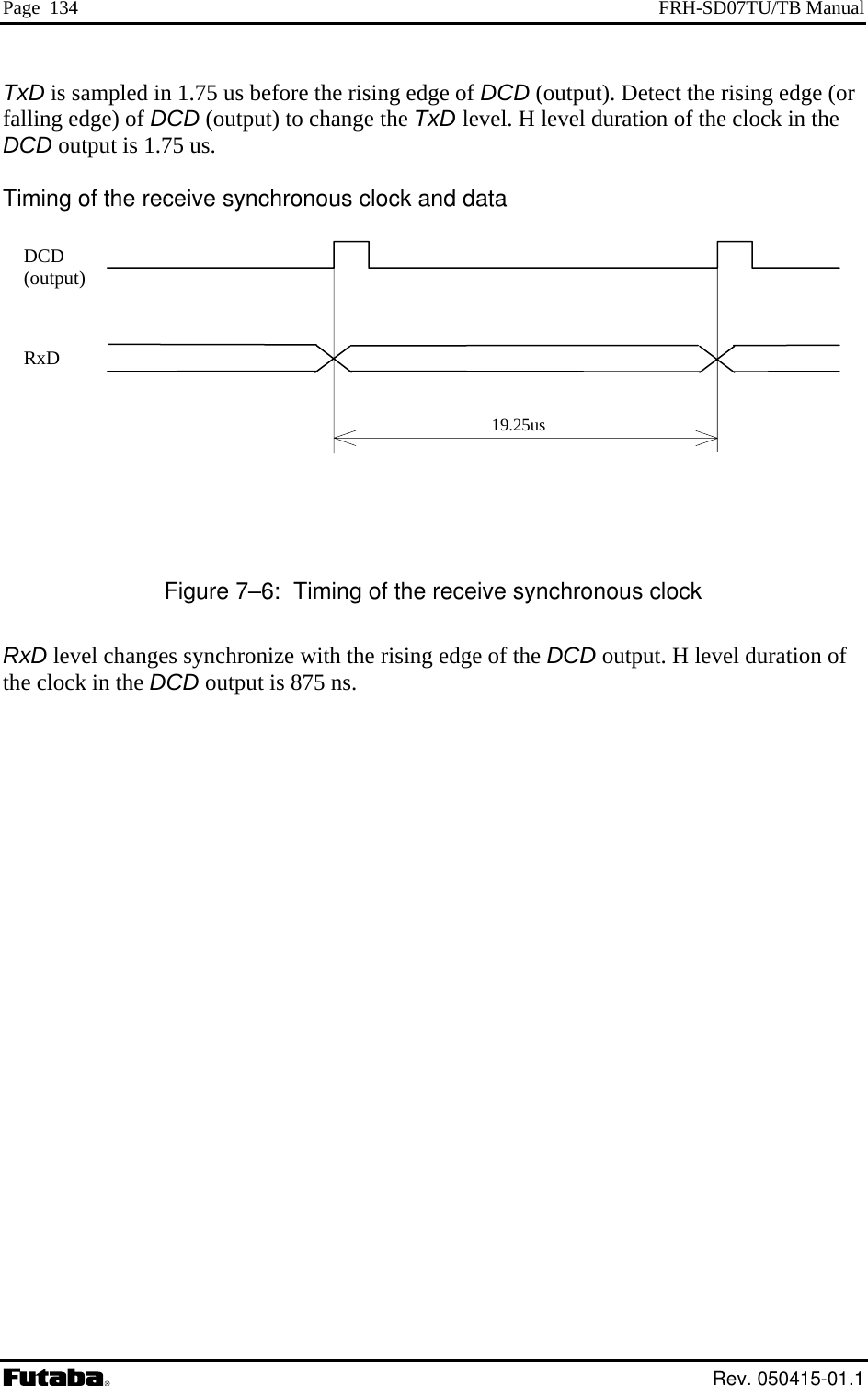
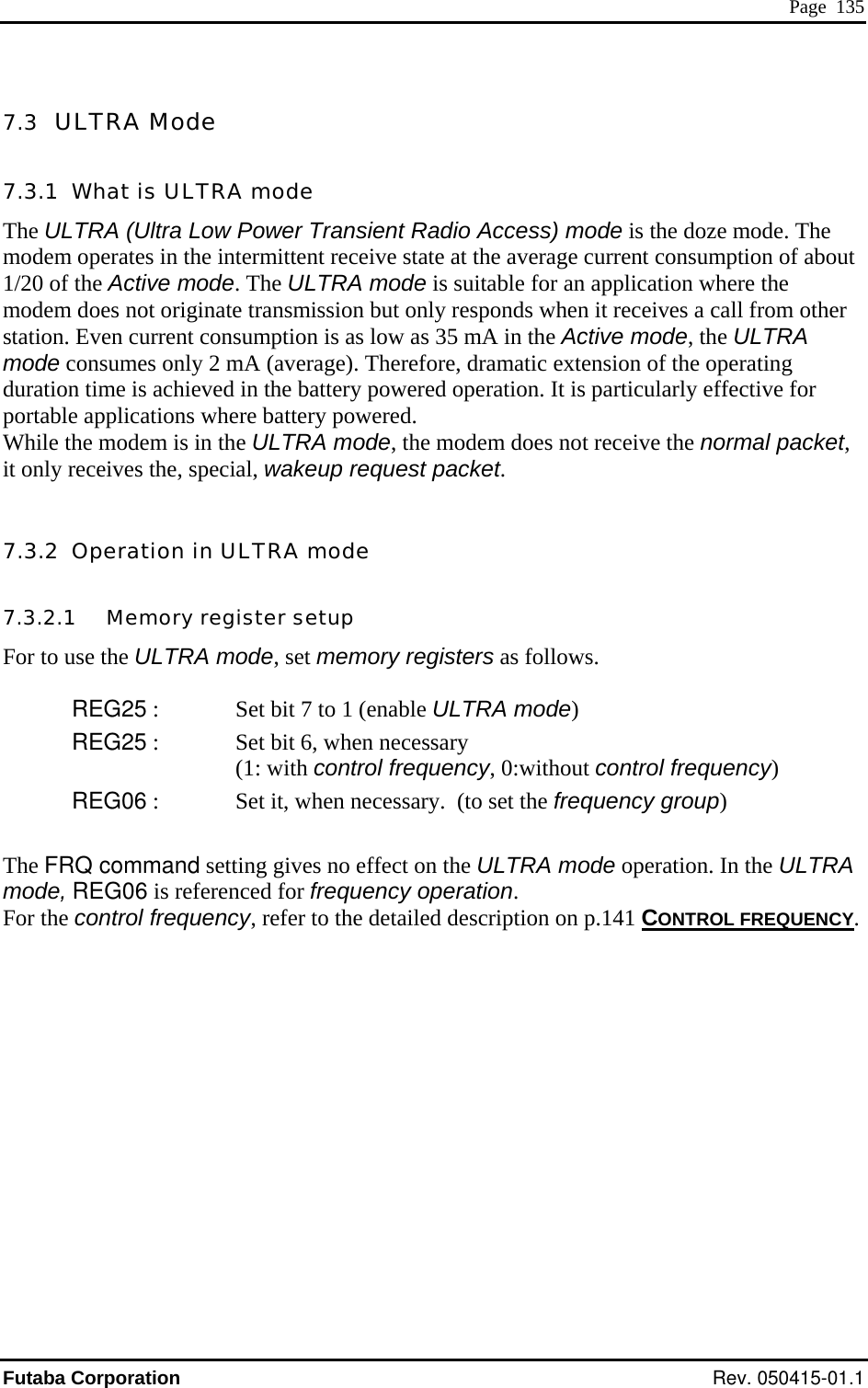
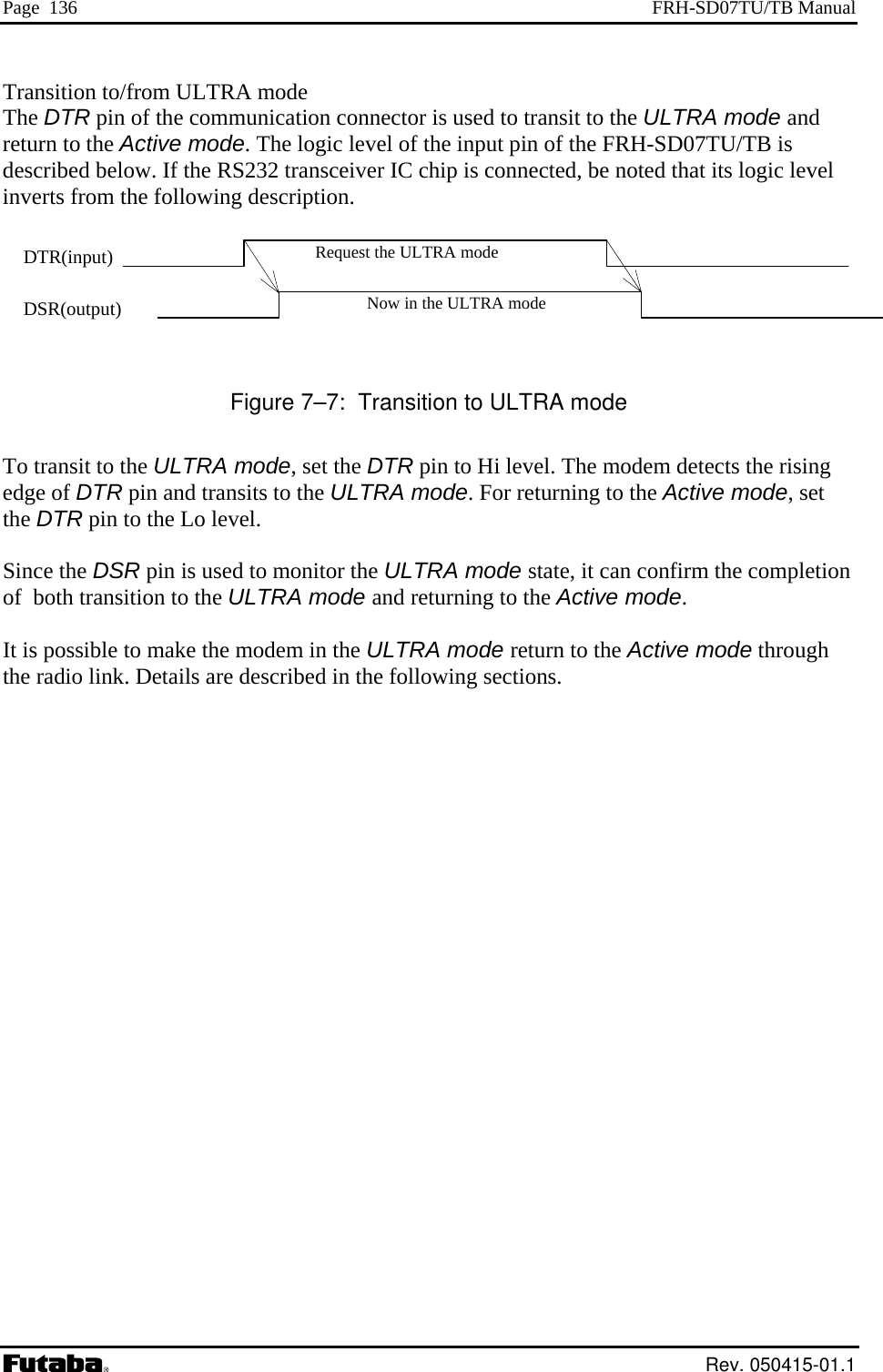
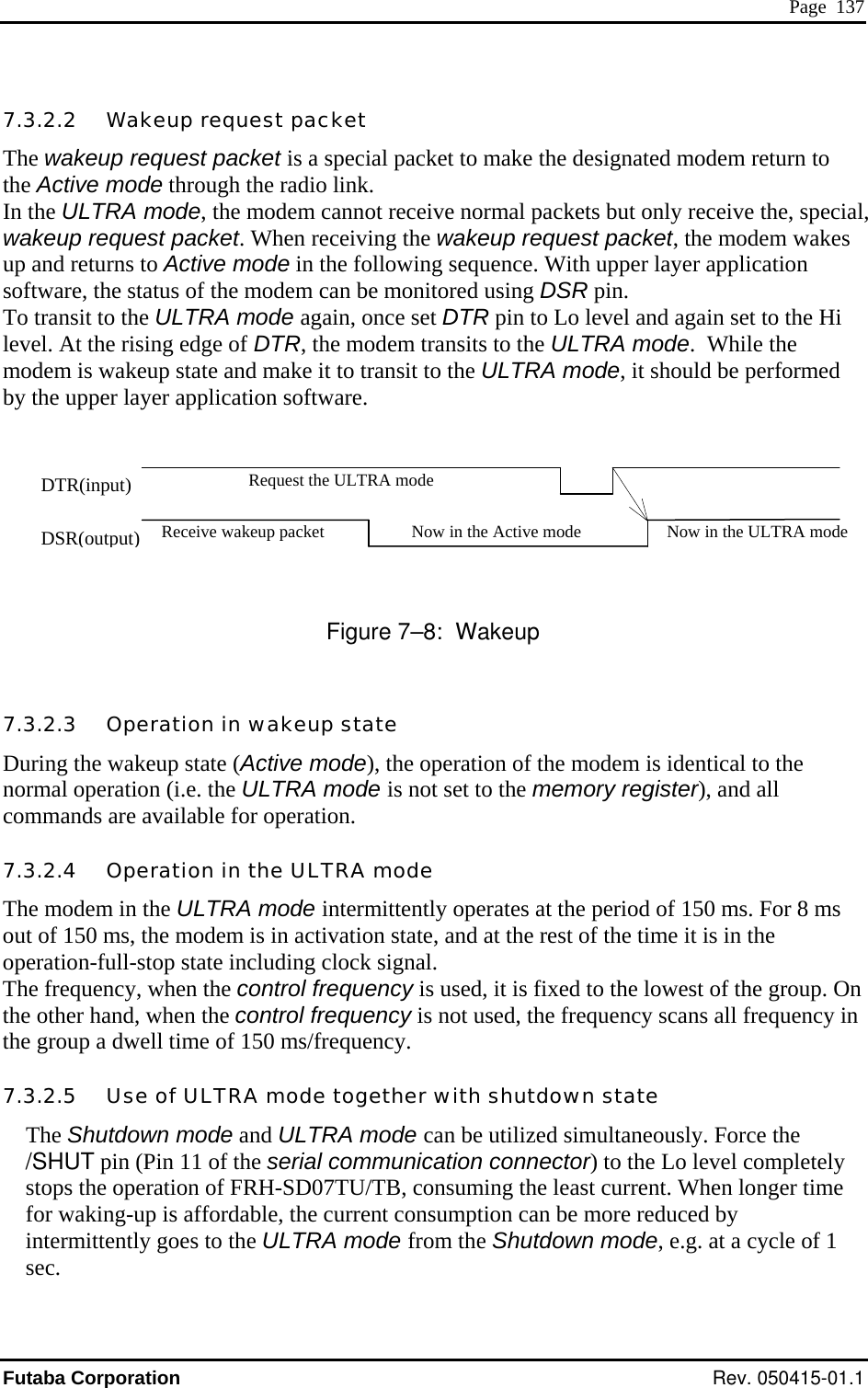
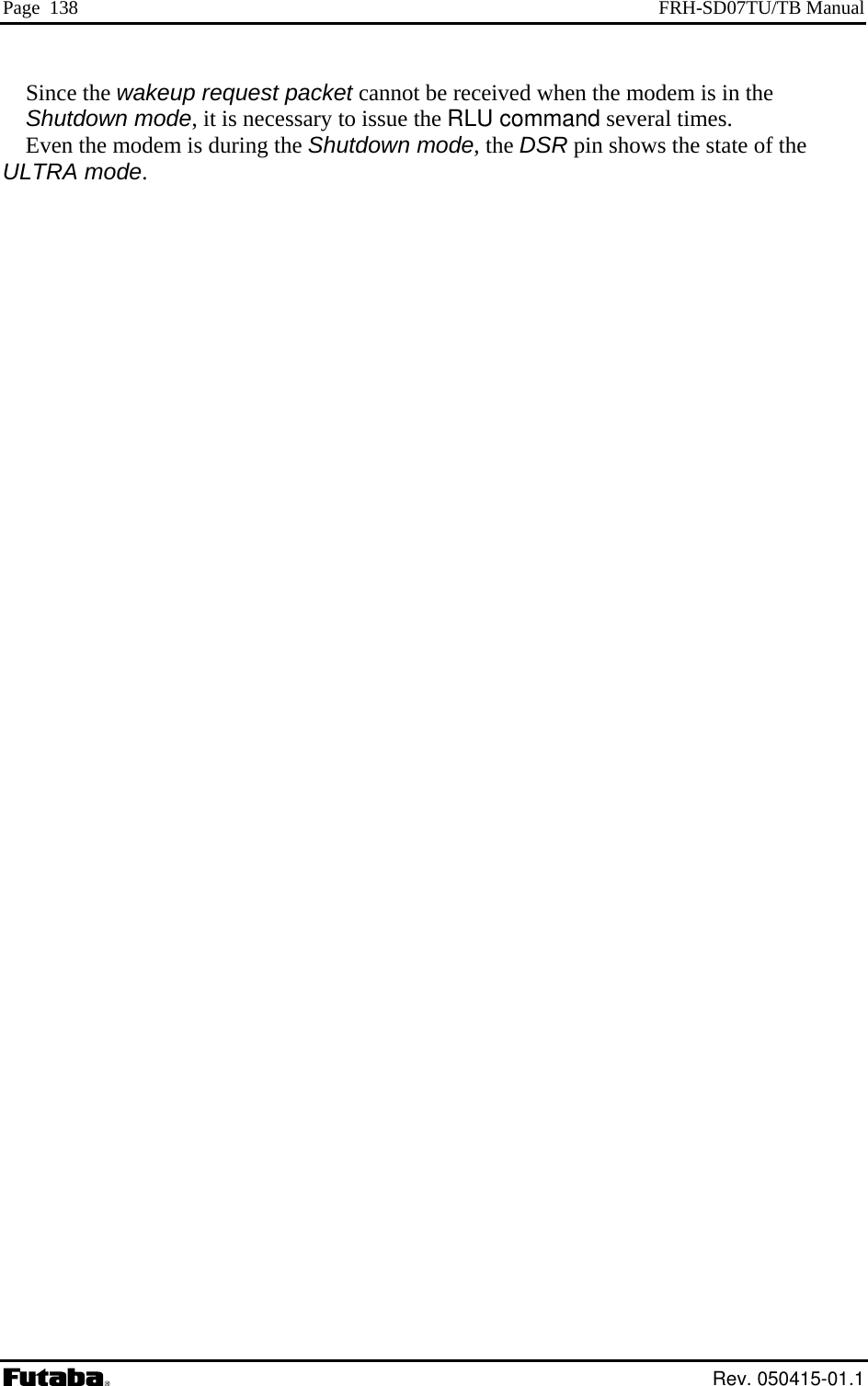
![Page 139 7.3.3 Wakeup command For these commands, refer to Chapter 6. 7.3.3.1 Direct wakeup : RLU command Transmit Command Use the RLU command to wakeup the modem in the ULTRA mode. Command format: @RLU [Destination address]CR/LF [Destination address]designates the destination (which is in the ULTRA mode) address (the set value of REG00 of the receiving station in the ULTRA mode). Broadcasting wakeup request packet (address 255) is also available. When the command is accepted, “P1” response is output and the wakeup request packet is transmitted. Wakeup ACK and response The modem in the ULTRA mode,up request packet, always checks destination address regardless of the status of REG19:bit 0. Accordingly, the modem does not wakeup unless addresses correspond to each other. t packet and being Active mode, its modem ss The sender modem receives ACK from the destination station, it outputs “P0” response nable to wakeup, ACK not received, or fore, nse when the RLU command is issued for on does not return AC tput alcarededestination station which received the wakeWhen the modem receives wakeup requesreturns ACK packet which inform the modem has been returning to Active mode, unlethe Broadcasting wakeup (destination address: 255) is designated. following the “P1” response. In case of being uwrong destination address, “N1” response will output which follows “P1” response. When REG25:bit 7 is set to be the ULTRA mode enable, the modem returns ACK to the wakeup request packet even the modem is in the wakeup state (Active mode). There“P1” response will output after the “P0” respothe destination station in the Active mode. Broadcast wakeup When 255 is designated to [destination address] field, all receiver statiK packet even these are being waken-up. So, as the command response, “P0” is ouways following “P1” output, after the defined number of retransmission count. In this se, it is not assured whether the stations returns to the Active mode or not. It is commended to issue TXT command (to attempt communication) and such to the stination station, for to confirm whether ACK packet is obtained or not from the . Futaba Corporation Rev. 050415-01.1](https://usermanual.wiki/Futaba/FRH-SD07TU.User-Manual/User-Guide-535573-Page-155.png)
![Page 140 FRH-SD07TU/TB Manual Figure 7–9: Wakeup using RLU command 7.3.3.2 Wakeup through repeater : RLR command Transmit command Use the RLR command to wakeup the modem in the ULTRA mode, through the repeater. Command format : @RLR[repeater address] [destination address]CR/LF [repeater address] designates the repeater to transmit the wakeup request. [destination address] designate the station address (the set value of REG00) to be waken-up. Broadcasting wakeup (address 255) is also available. On accepting this command, the modem returns “P1” response and starts transmitting wakeup transmission request packet to the repeater. And this packet makes the repeater to transmit the wakeup request packet to the destination(s). The transmission of wakeup request packet The sender station transmits the wakeup transmission request to the repeater, its request making the repeater to transmit the wakeup request packet to the destination(s). The wakeup transmission request is repeated to transmit at the cycle of 200 ms by the retransmission count designated by REG11 or RNO command. At the repeater, the destination address checking function set by REG18:bit 0 is valid. Accordingly, when the function is set to be valid, the repeater does not receive the wakeup transmission request unless the repeater address matches. When the repeater receives the wakeup transmission request, it transmits the wakeup request packet to the destination station designated by [destination address] for 160 ms duration. Though ACK packet is returned from the destination station, the repeater ignores it and does not return ACK packet to the sender station. Therefore, even when the single station is designated by the [destination address], the sender station cannot confirm whether the destination station wakes-up or not. It is necessary to issue TXR command (to attempt communication) and such to the destination station, for to confirm whether response is obtained or not from the destination station. Wake-up Req. packetACK Rev. 050415-01.1](https://usermanual.wiki/Futaba/FRH-SD07TU.User-Manual/User-Guide-535573-Page-156.png)
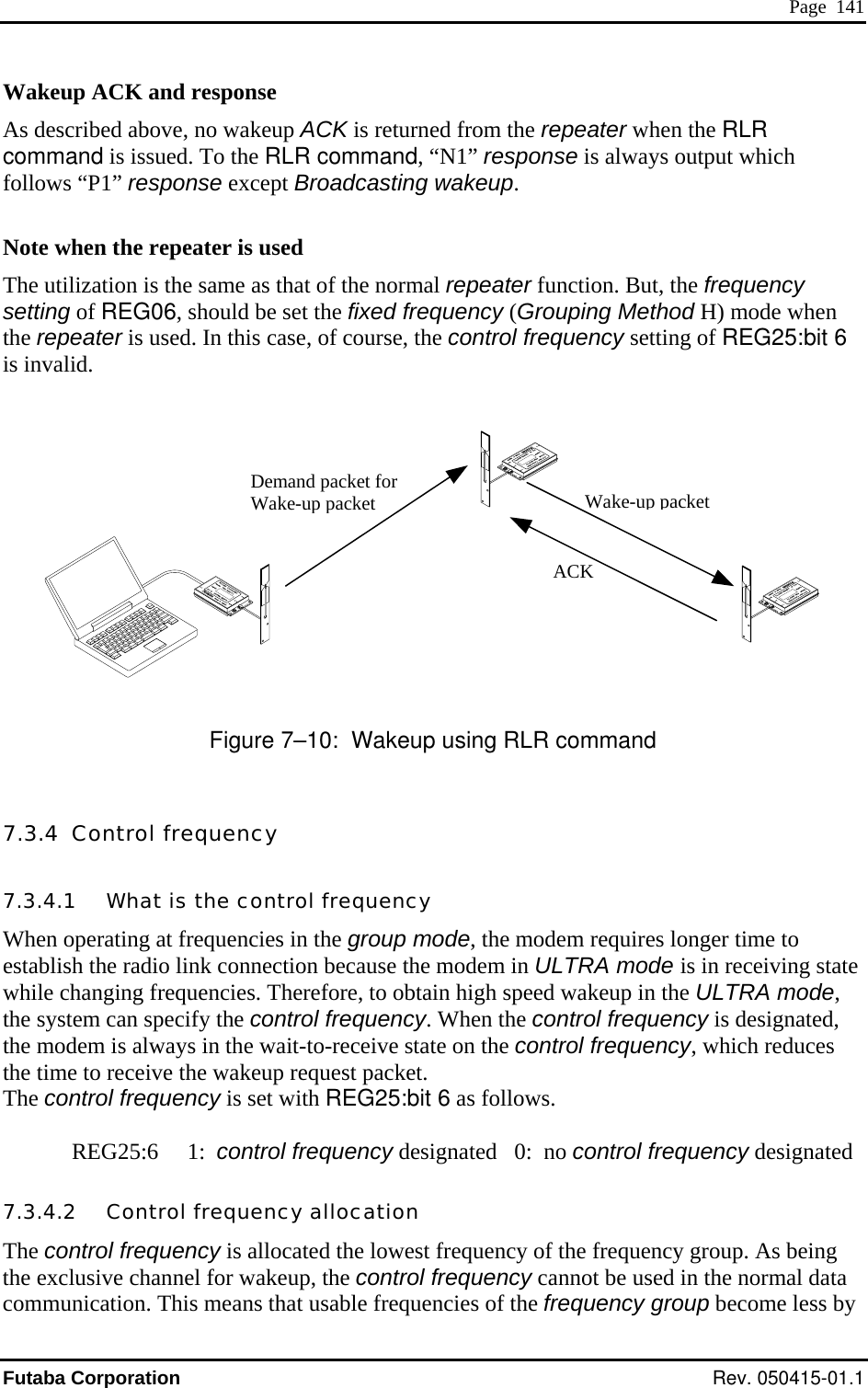
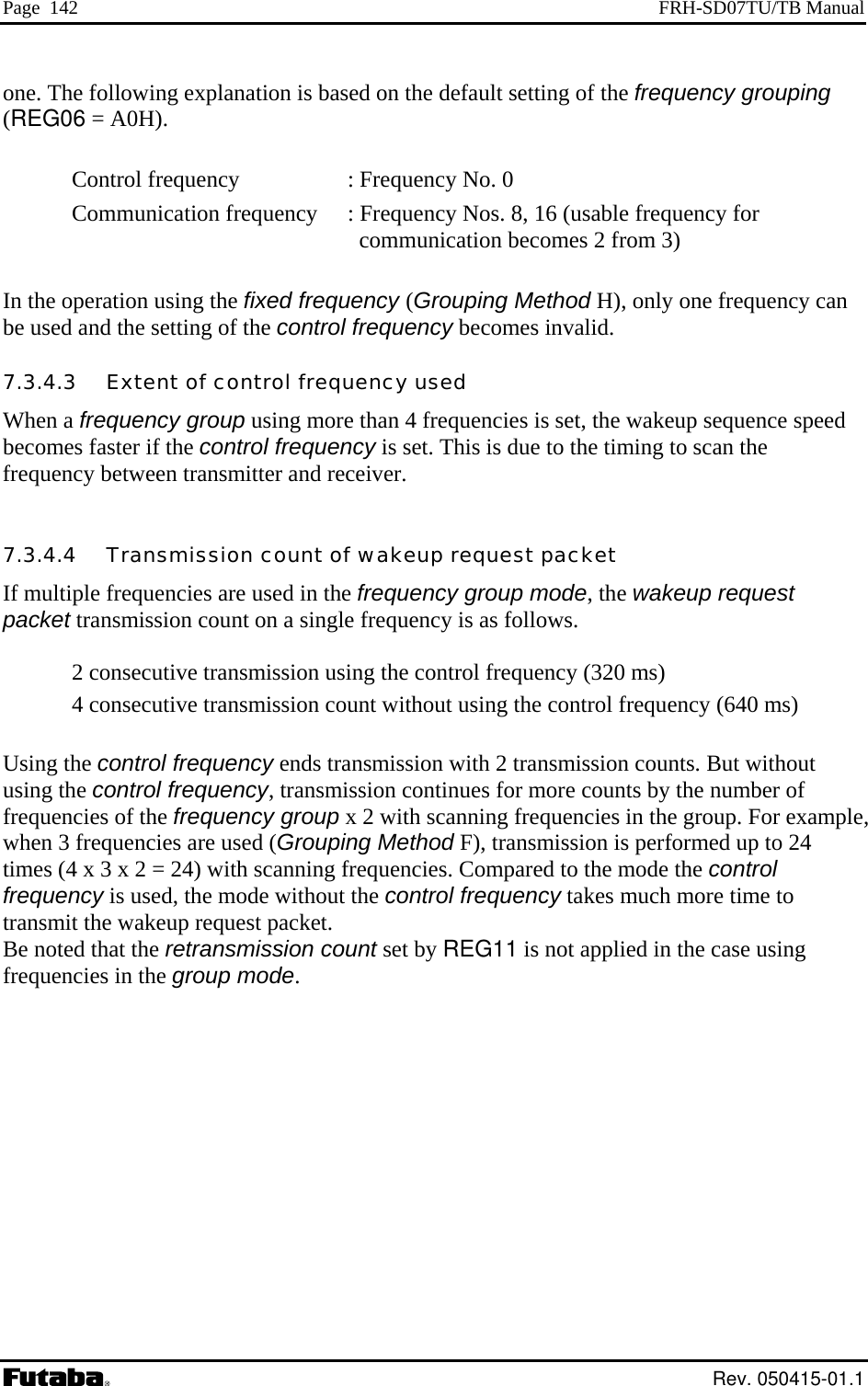
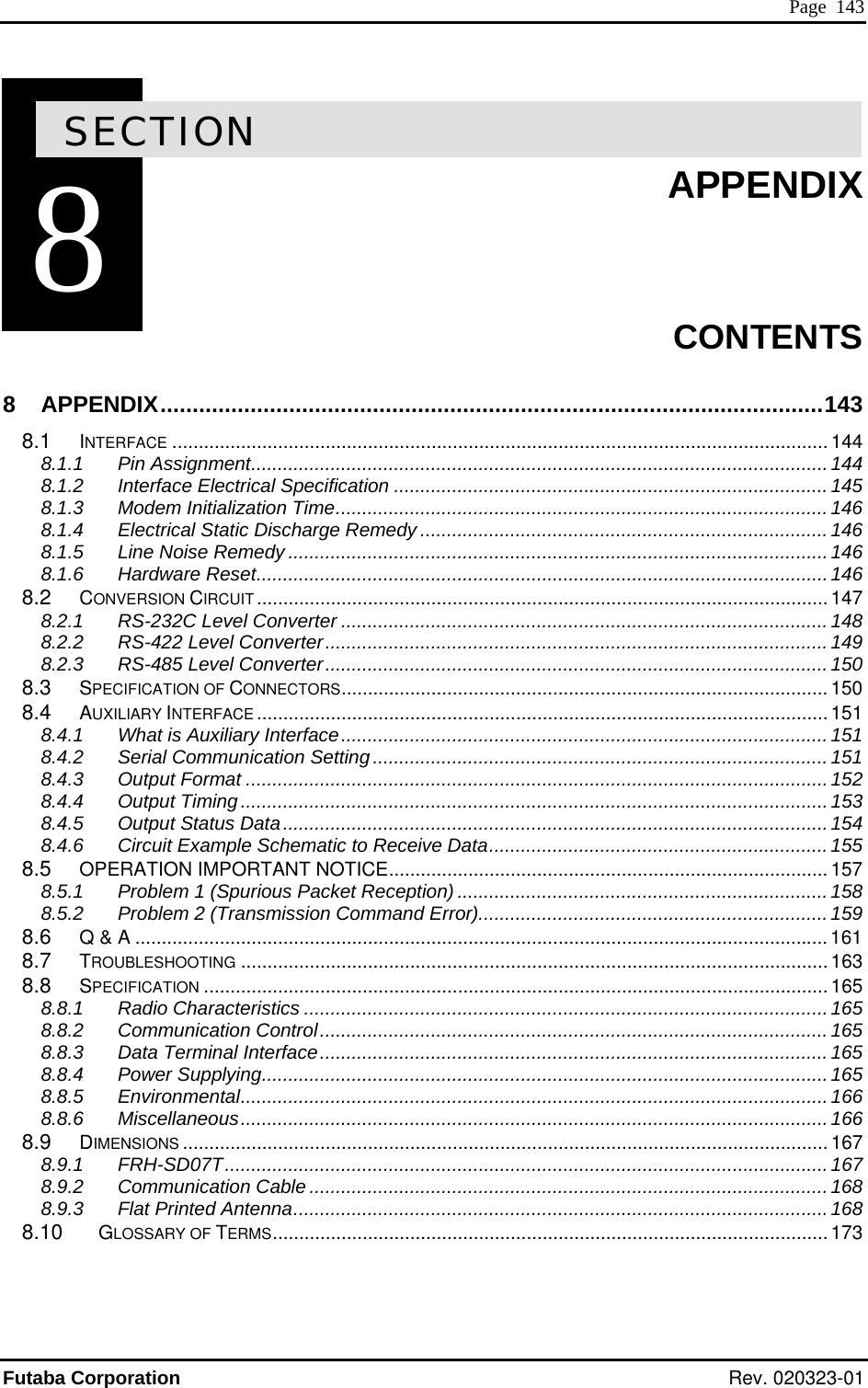
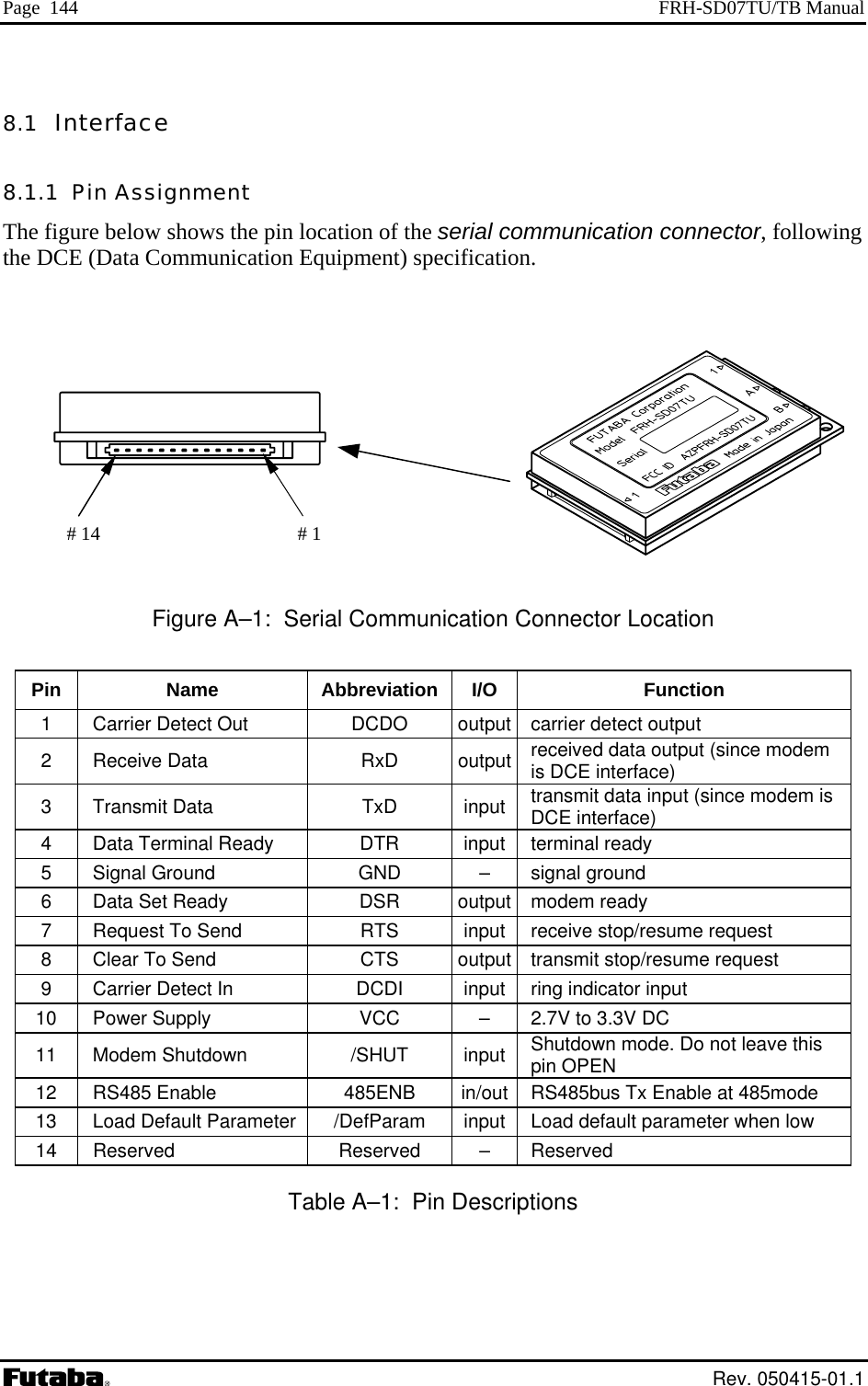
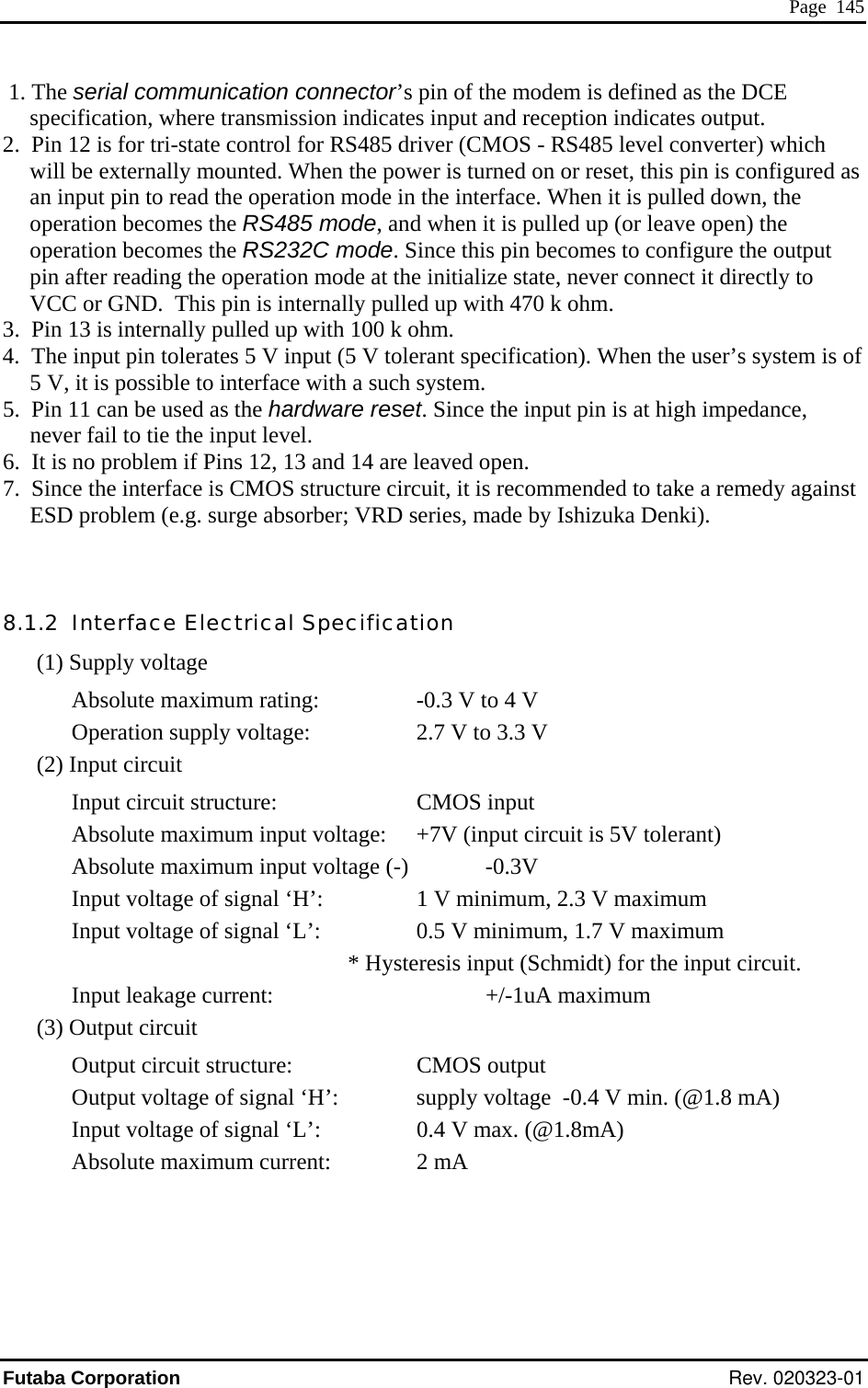
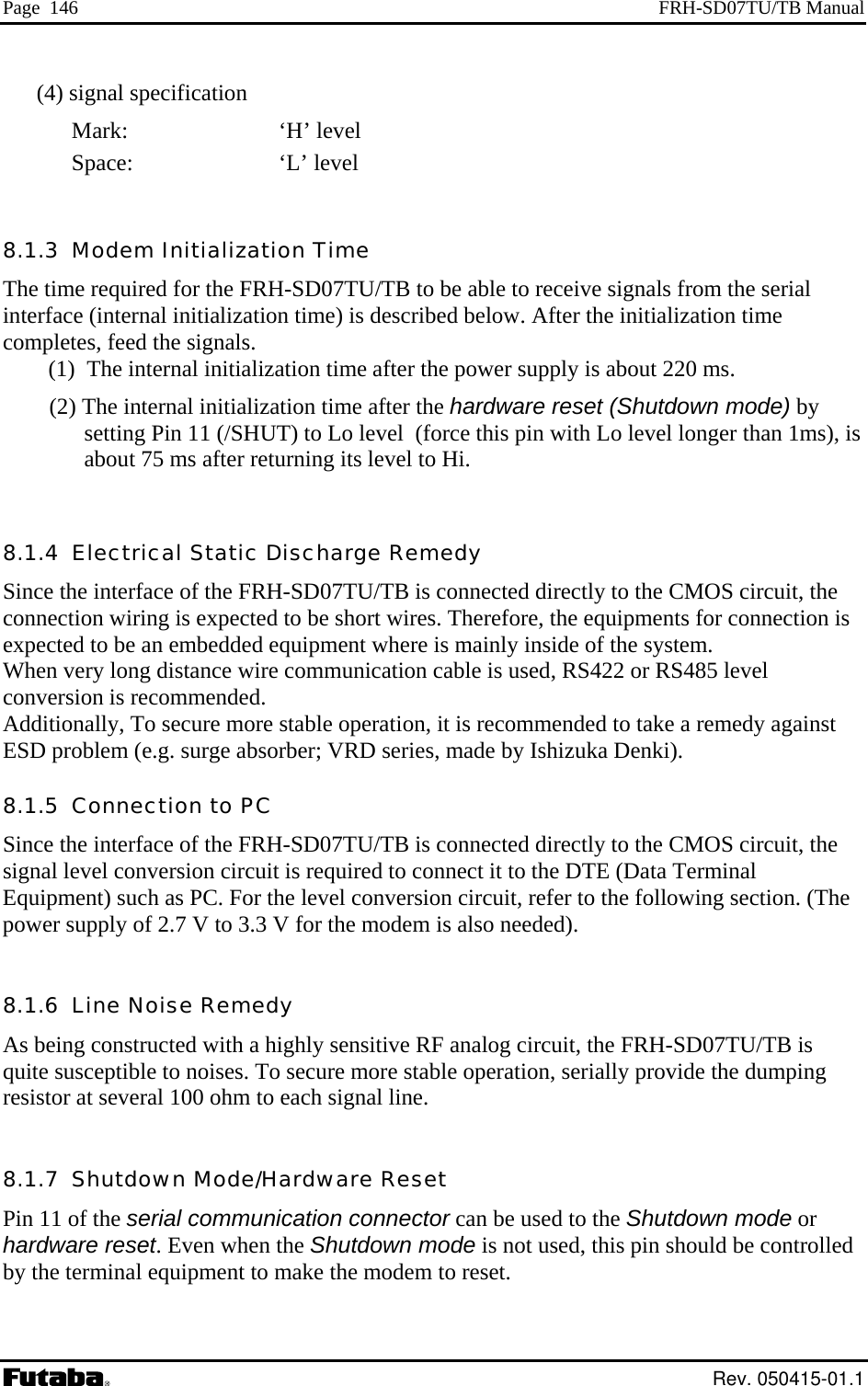
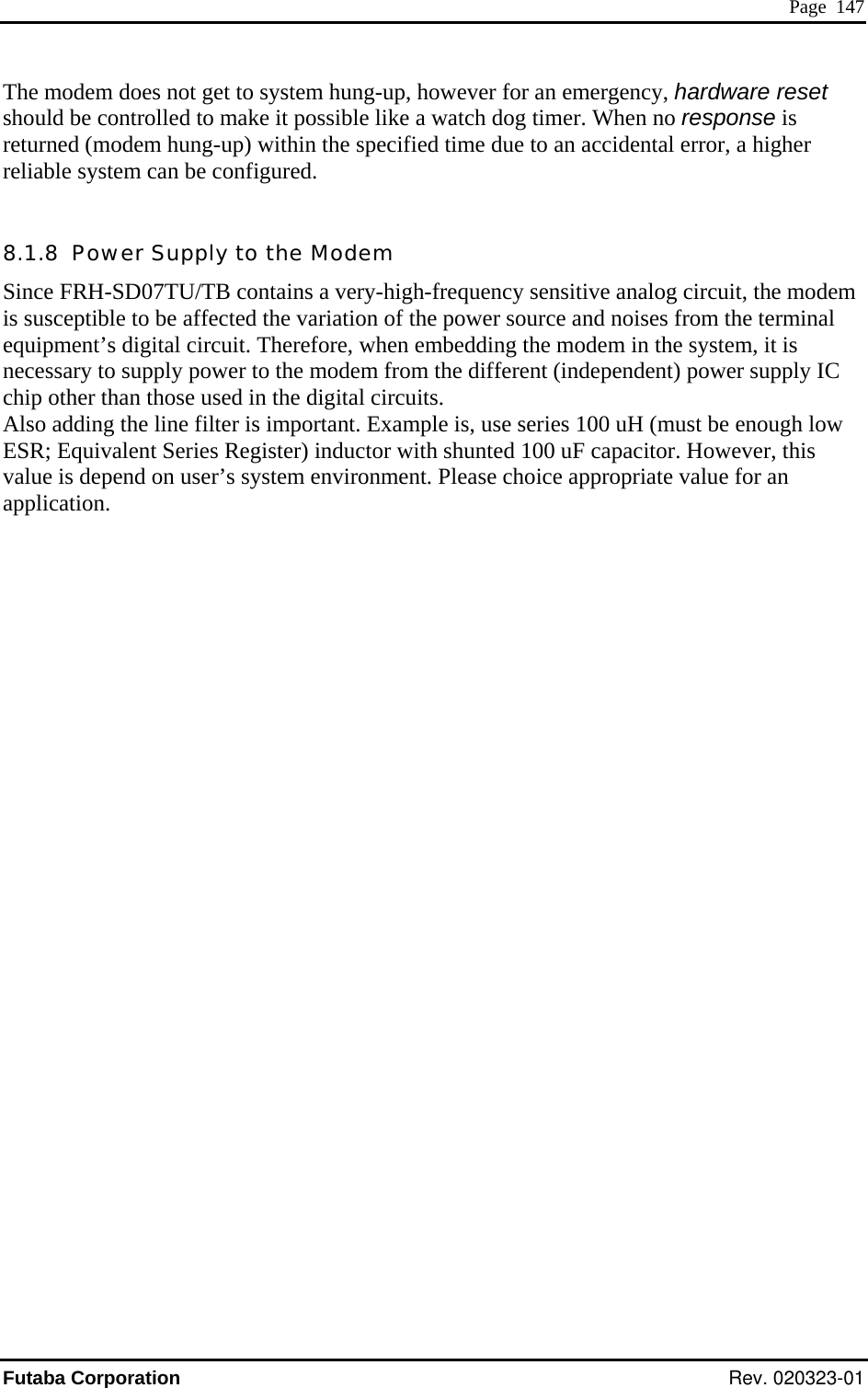
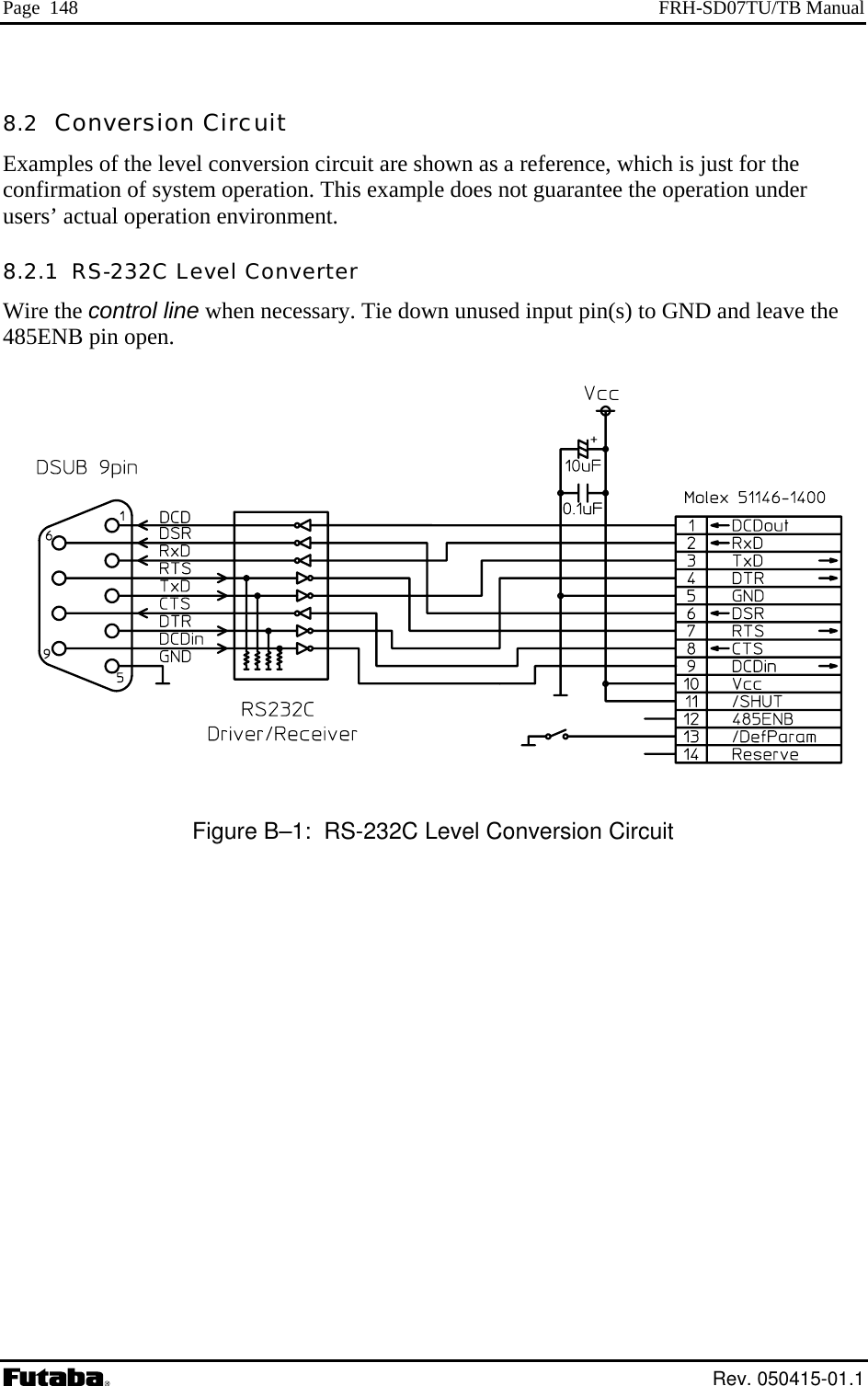
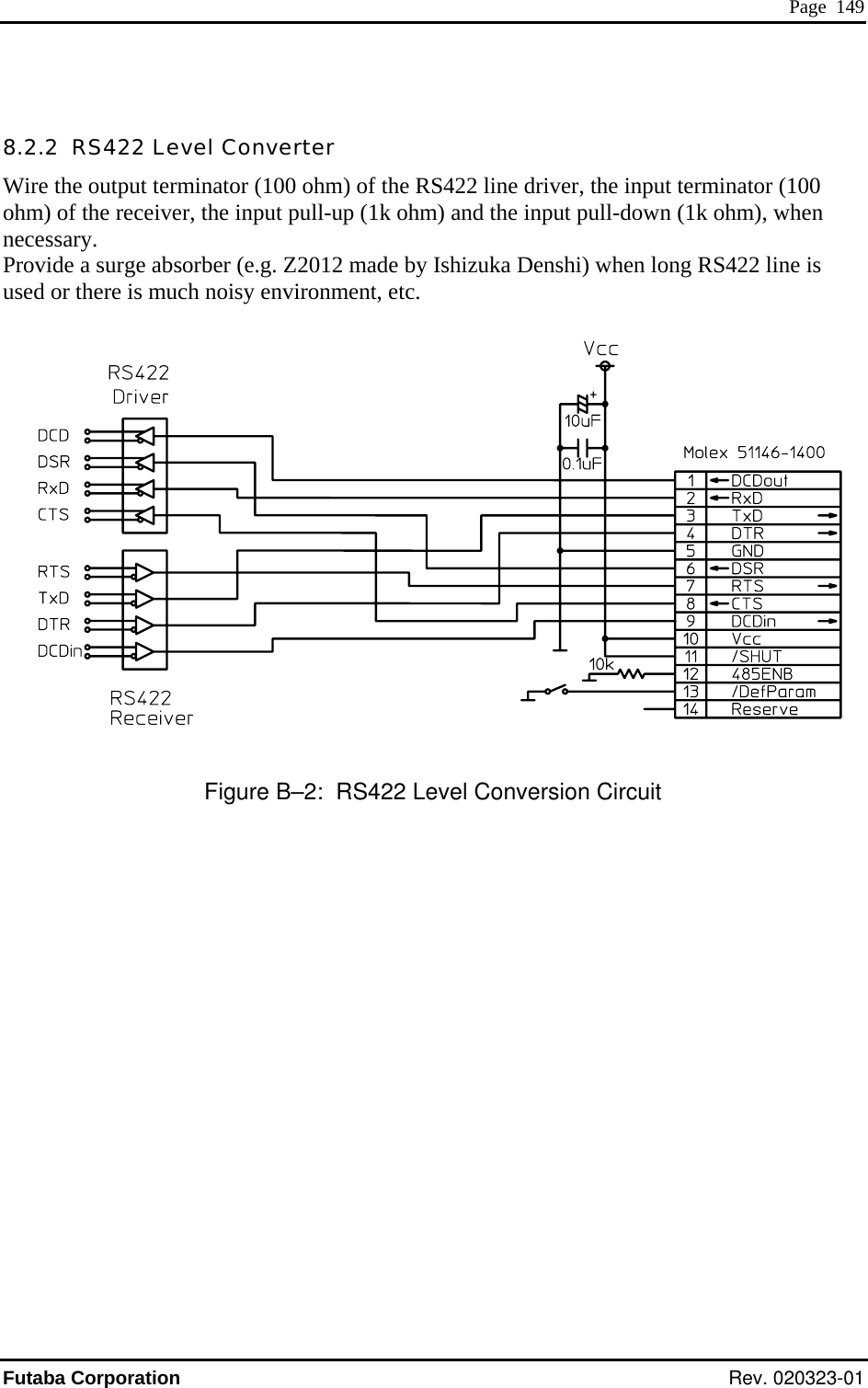
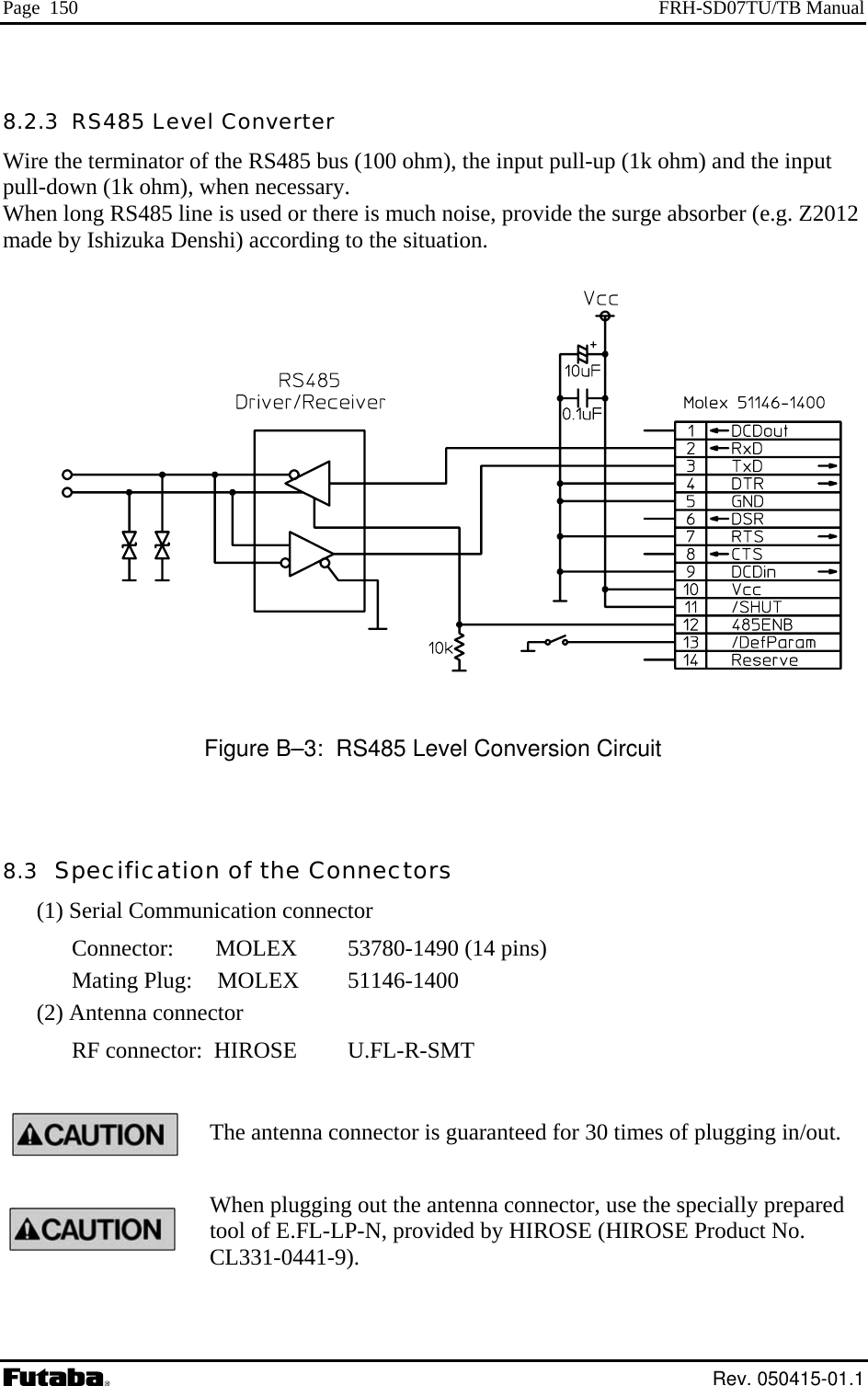
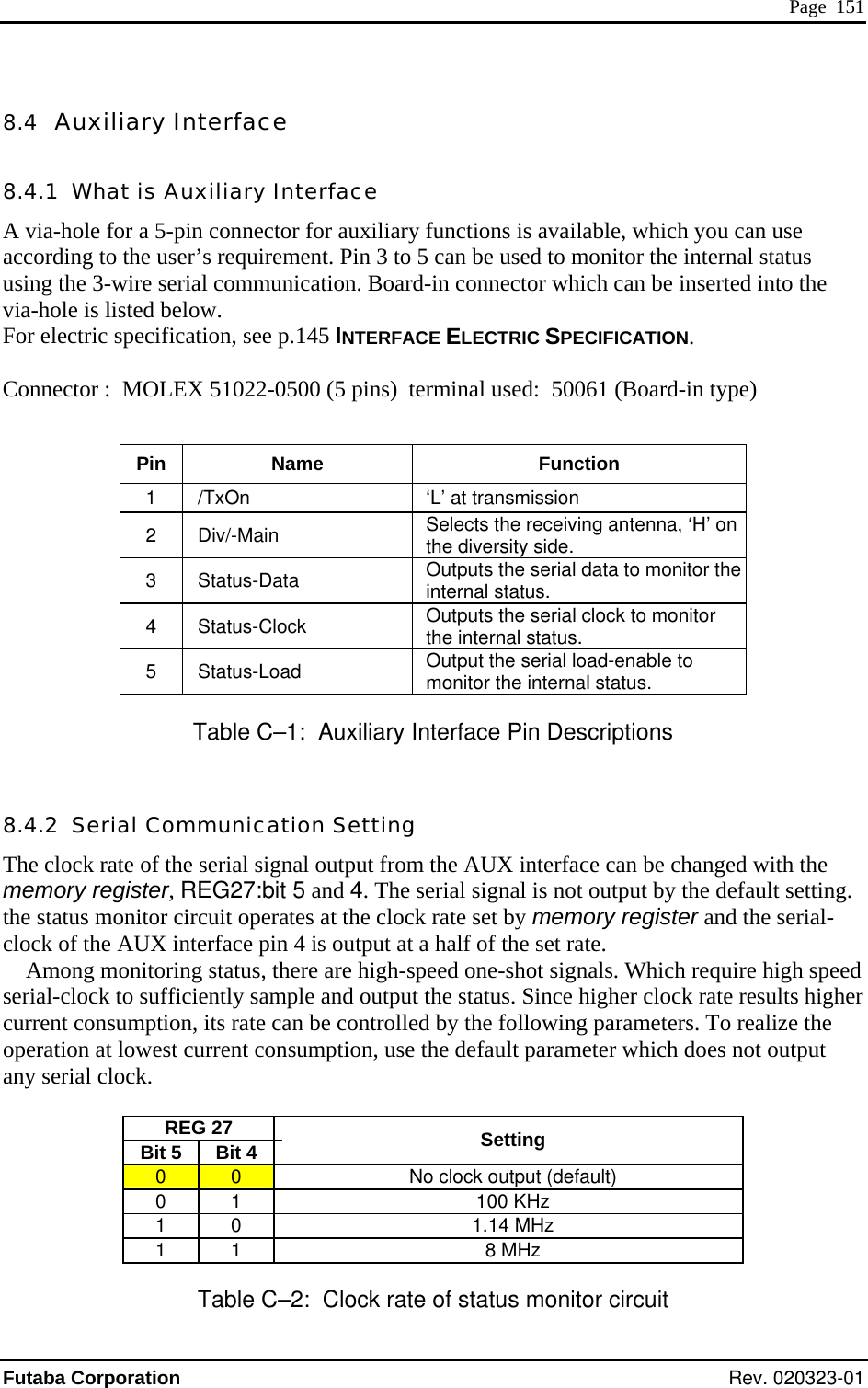
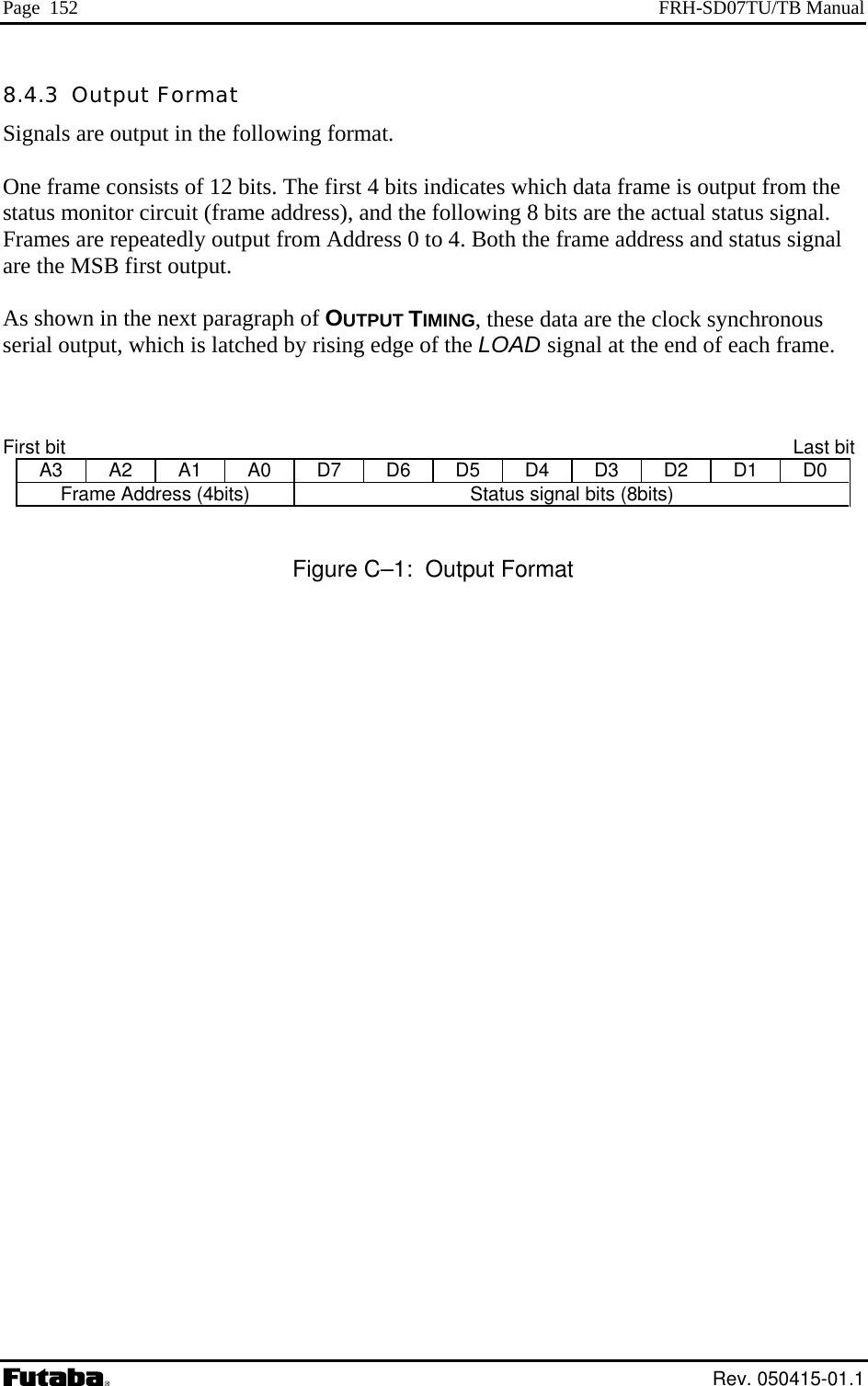
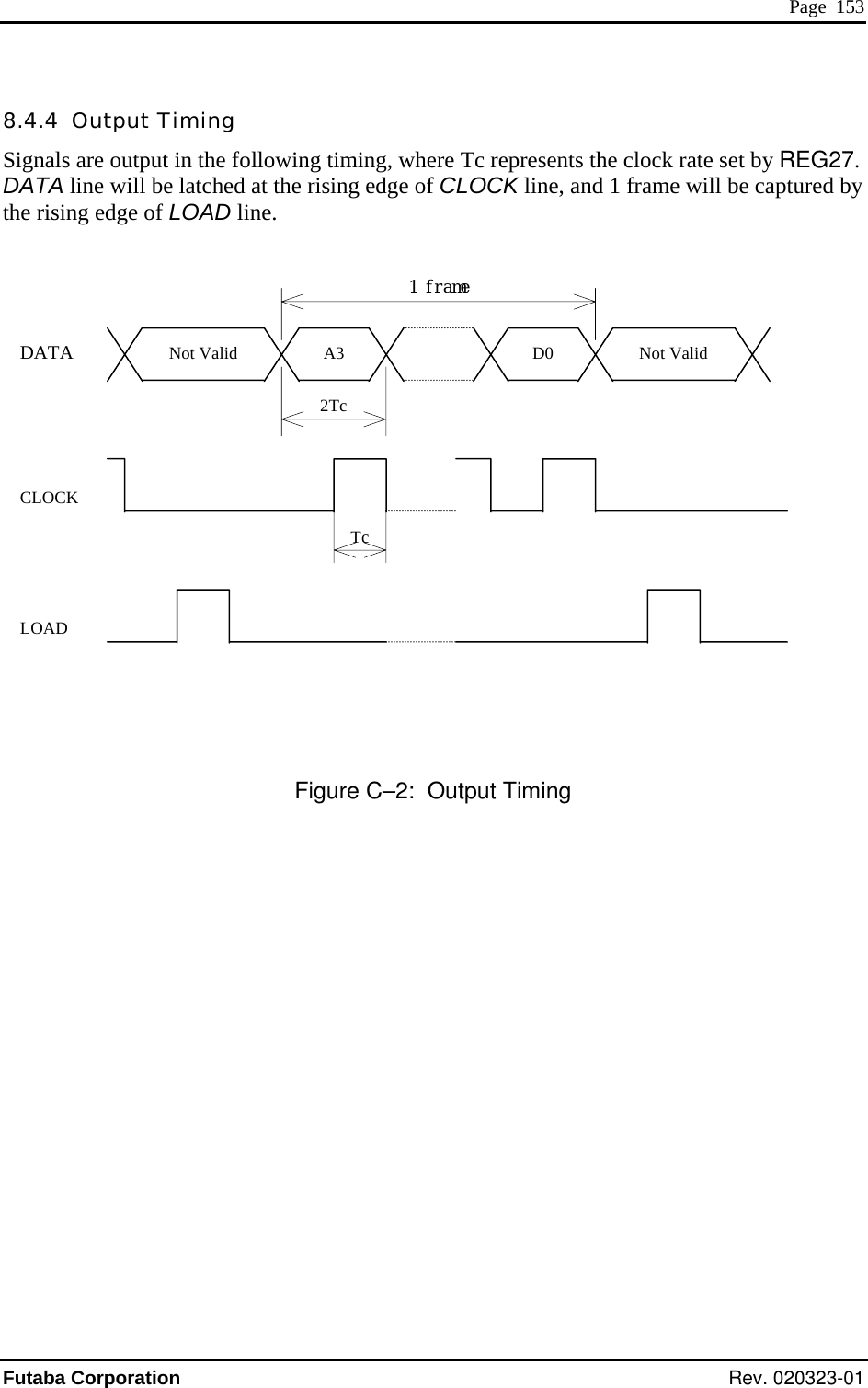
![Page 154 FRH-SD07TU/TB Manual 8.4.5 Output Status Data s are output. The status data having the following content Frame address Status signal bit number Signal name Contents Note D7 CorrelationDetect Hi while correlation is detecting D6 FrameSyncDetect Hi when frame-sync is detected, Lo when correlation is lost D5 TransparentLinkEstablished Not used D4 OperateInUltraMode Hi while operating in ULTRA mode D3 FreqChangeExecuting Hi while frequency is changing D2 OperatingTransmissionCommand Hi while transmission command is executing D1 TrxCtrlSeqIsPacketIdle Hi while no TX/RX operation is executing 0 D0 SystemErrorState Hi when system error occurred D7 ReceiveSu hen s ONccess Hi w receive uccess E D6 ReceiveMyAckSuccess hen ONHi w ACK receive success E D5 tError Hi when re ONE Receive1packe ceived but error occurred D4 DetectJabberPacket Hi while wakeup packet is receiving D3 TransmissionSequenceResultCode(2) D2 TransmissionSequenceResu 1ltCode(1) D1 TransmissionSequenceResultCode(0) Refer to note[1] D0 0 D7 RxBufferFull Hi while the receive buffer is full D6 RxBufferDataExist Hi while a data is existing in the receive buffer D5 TxBufferFull Hi while the transmission buffer is full (mode 7) D4 TxBufferDataExist Hi while operating in mode 7 D3 TxBufferOverflow Hi while the transmission buffer is overflowing (mode 7) D2 TxDataExistInTransAndFdaHdrless Hi while a data is existing in the transmission buffer 2 D1-0 0 D7 RxDteDataOutputEnable Hi while the serial port is enabled to output D6 RadioDataReceiveEnable Hi while the radio is enabled to receive D5 RsReceivedDataReceptionEnable Hi while the serial port is enabled to receive D4 OperatingFreqChannelRegister(4) D3 OperatingFreqChannelRegister(3) D2 OperatingFreqChannelRegister(2) D1 OperatingFreqChannelRegister(1) 3 D0 OperatingFreqChannelRegister(0) Frequency channel number in operating (0∼23) D7-5 0 D4 TopOperationState(4) D3 TopOperationState(3) D2 TopOperationState(2) D1 TopOperationState(1) 4 D0 TopOperationState(0) Reserved Table C–3: Status Data Note [1] Transmission Sequence Result Code (2-0) Indicates the result of the transmit commands, e.g. TBR and TXT, which last executed. Bit2: ‘H’ when packet reaches to the repeater by the transmit commands passing through the repeater. Rev. 050415-01.1](https://usermanual.wiki/Futaba/FRH-SD07TU.User-Manual/User-Guide-535573-Page-170.png)
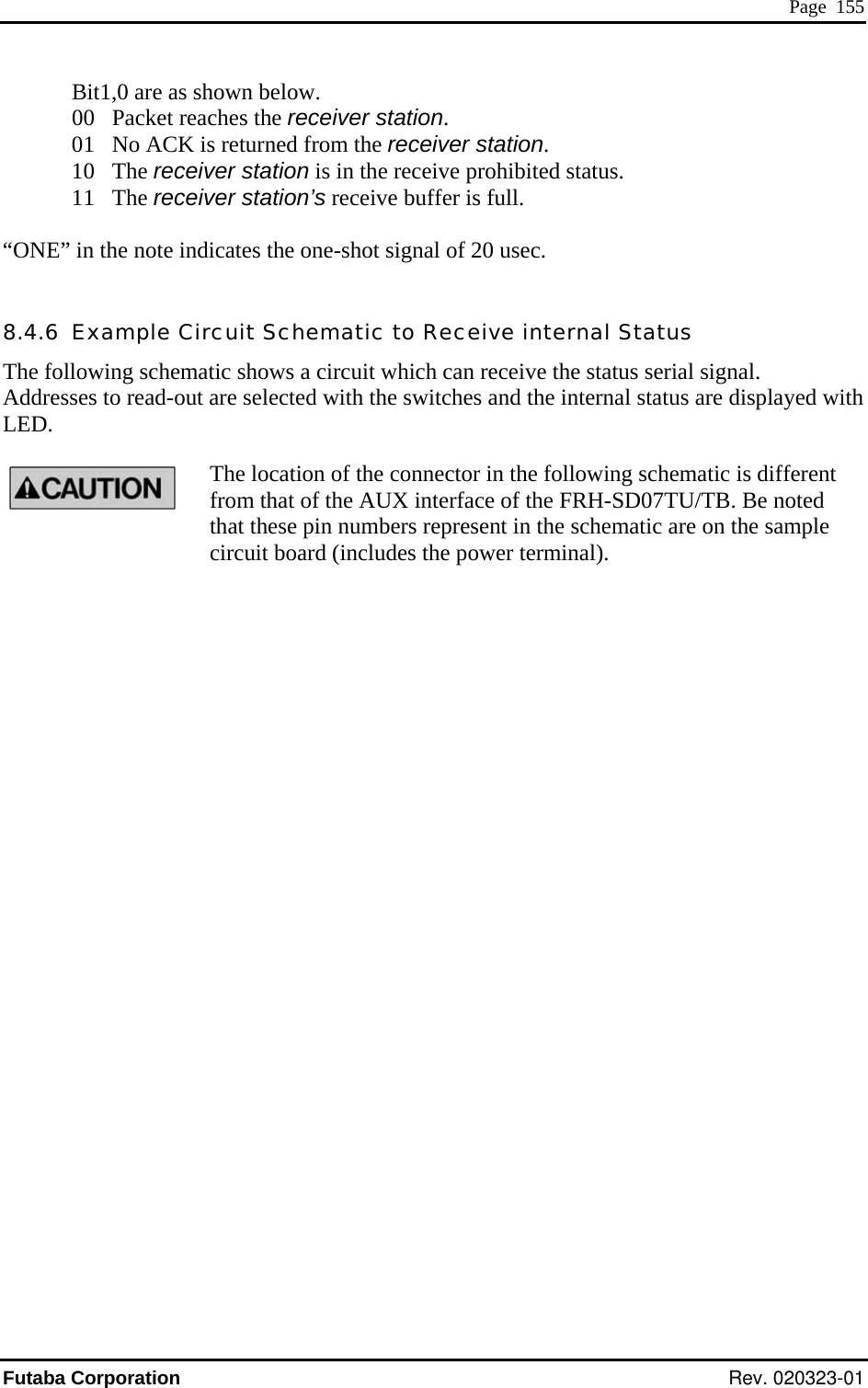
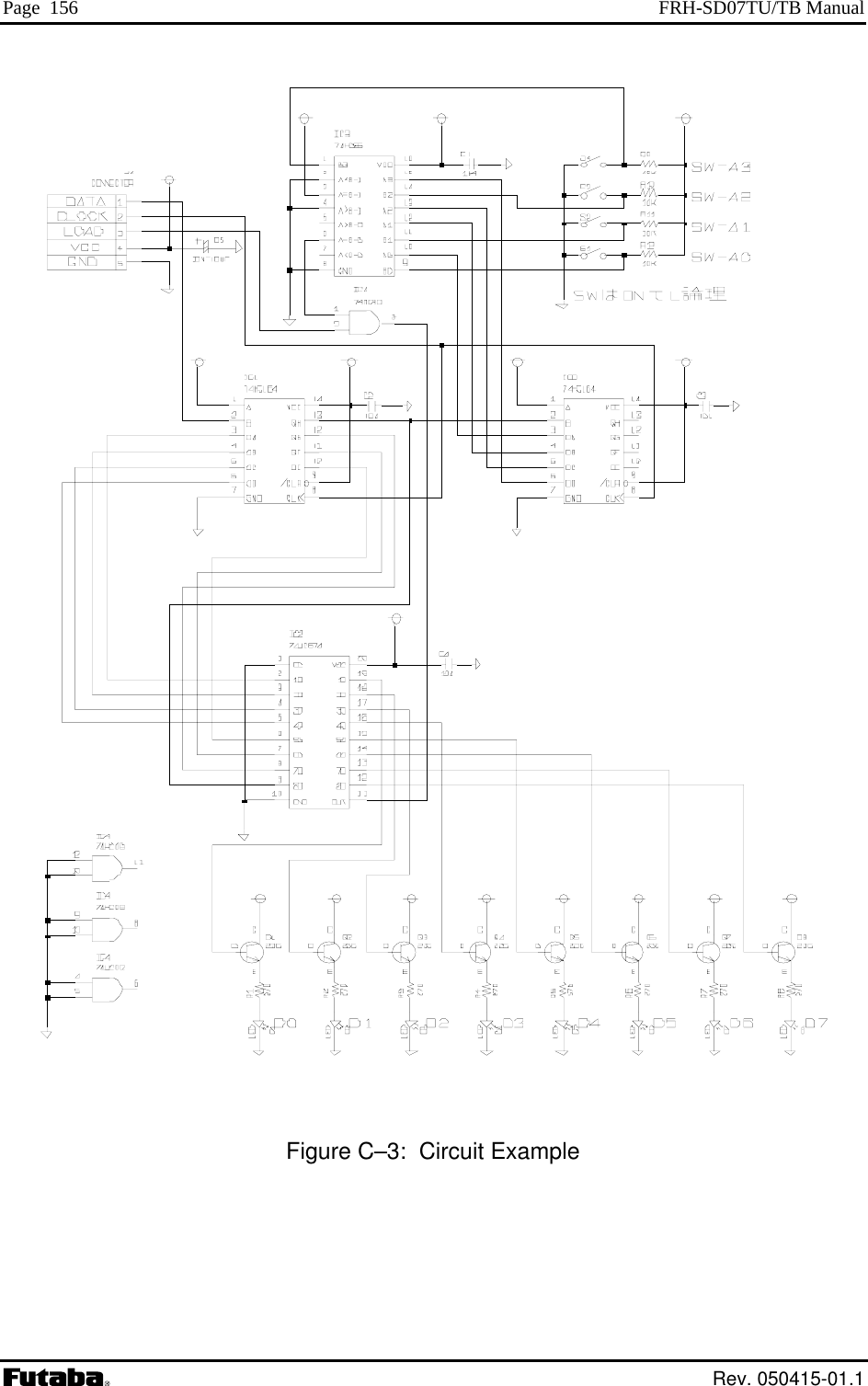
![Page 157 8.5 Pnection Futaba interference (jamming) betweehe “Interference” described here is cramble. Scramble data is made by the seed using this ID code. On the receiver side, de-scramble is performside memory register sender and receiver mBy setting this ID cod modem employs carrie can not start transmission during carrier is sensing (where other FRH modem station is in transmission) is not affected by this ID code setting. Please do not misunderstand the purpose of this ID code interference measure. 8.5.3 ID Code Setting ID code can be defined by users. FRH-SD07TU/TB modem can set from 0000H to EFFFH 16 bit code, set by upper 8 bit to REG05 and lower 8 bit to REG04. This 16 bit value should be choose as random as possible, to make good performance for this interference problem. However, still there has a possibility that the other system using same ID exists nearby, this countermeasure can not to be perfect such a situation. Please understand this measure is for to decrease the interference problem. It is important to set “random” value for ID code. But if to obtain the value is difficult to image, use below equations to define the ID code for you. Use the product serial number which randomly selected from your FRH-SD07TU/TB modems you own. Product serial number is 9 digits; divide these as [AA][BB][C][DDD][E]. REG05 = [{(AA MOD 10 ) + 11 } x BB] – 1 REG04 = DDD MOD 256 MOD is the modulo operator. [Example] If product serial number is 020809468, AA=2, BB=8, DDD=946. Therefore, REG05 = [{(2 MOD 10) + 11} x 8] –1 = 103 -> 67H REG06 = 946 MODE 256 = 178 -> B2H reventing Undesired Radio Con recommend user to set unique ID code to prevent unexpected . n individual FRH systems working in the same area8.5.1 What is Interfere Problem T8.5.2 What is ID Code ID code is 16 bit word set by REG04 and REG05. The FRH series radio transmits data with code-s ed to restore original data using the same ID code (set on the receiver ) as the seed. Therefore, communication can not be established if bothodems do not set an identical ID code. e, the interference problem can be decreased. But because of the FRHr sense function, the function that the modemFutaba Corporation Rev. 020323-01](https://usermanual.wiki/Futaba/FRH-SD07TU.User-Manual/User-Guide-535573-Page-173.png)
![Page 158 FRH-SD07TU/TB Manual 8.6 OPERATION IMPORTANT NOTICE Problems were found in the current version of FRH-SD07TU/TB (Version 1.00). Before using this product, refer to the preventive measures described below. 8.6.1 Problem 1 (Spurious Packet Transmission) 8.6.1.1 Problem Description At the final retransmission, when the sender modem transmits final packets due to transmit error, ACK packet reception is started but its reception was failed, rarely the sender modem which received ACK packet starts the repetitive “spurious packet” transmission. This spurious packet format is same as that of ACK packet. In the receiver (remote) modem, this spurious packet is recognized as the normal packet and starts receiving. And from remote modem, it returns ACK to the sender modem. Again sender modem recognize this ACK packet as a normal packet and returns ACK to the remote modem. This sequence repeats until radio communication becomes error or next transmission command (such as TXT or TBN) is issued. This problem tends to occurs in a retransmission count is set to 0. Local (address 123) Remote (address 210) Last retransmission Receive successfully ACK receive error CRLF RXT210 CRLF T123 CRLF RXT210 CRLF T123 CRLFRXT210 CRLFContinue till receive error When this problem occurs, both sender and remote modem repetitively output vacant packet ata (only header information) to the both terminal equipment. [Example] @TXT000AAA CR/LF N1 CR/LF RXT012 CR/LF (Spurious packet) The probability of this problem occurs, it becomes large, when the retransmission count (which set by RNO command or REG11) is set to small. RXT123 RX RX Data packetSpurious packet ACK ACK ACK ACKACK ACKd Rev. 050415-01.1](https://usermanual.wiki/Futaba/FRH-SD07TU.User-Manual/User-Guide-535573-Page-174.png)
![Page 159 purious packet (header information only), then discard this packet, and issue RST command or force /SHUT pin nnector to low. The operation results modem to spurious packet stops and the ode. rless packet transmission uipment it command becomes error, the command error sponse is returned. CR/LFuipment. The ontents of the “accepted, the next” transmission command data will not be transmitted. is point) 00KLMN CR/LF @RXT000ABCD CR/LF (KLMN will be output.) 8.6.1.2 Preventive countermeasure If terminal equipment (or upper layer software) detects the s(11pin) of the serial communication coreset. Once either side modem is being reset, this repetitive modem returns to normal operation m 8.6.2 Problem 2 (Transmission Command Error) 8.6.2.1 Its problem description In the mode 3 and 5 (packet transmission mode and heademode), when the TBN, TBR, TXR and TXT commands (or headerless transmission command) are issued, wrong data are output to the receiver modem’s terminal equnder the following condition. As shown in the example, when the transmre[Example 1] @TXT000AAAAAAAAA.............AAA (excessive bytes due to the input maximum of 256 byte) N0 CR/LF [Example 2] @TXT000ABCDE (becomes ‘time out’ at this point) N0 If the next transmit command is issued at this stage and this command is successfully accepted and performed, the wrong data (the contents of the last transmission-command data) are send as the radio packet and output to the receiver end terminal eqc(Refer the following example.) @TXT000ABCDE (becomes ‘time out’ at thN0 CR/LF @TXT0P1 CR/LF P0 CR/LF Futaba Corporation Rev. 020323-01](https://usermanual.wiki/Futaba/FRH-SD07TU.User-Manual/User-Guide-535573-Page-175.png)
